User Manual
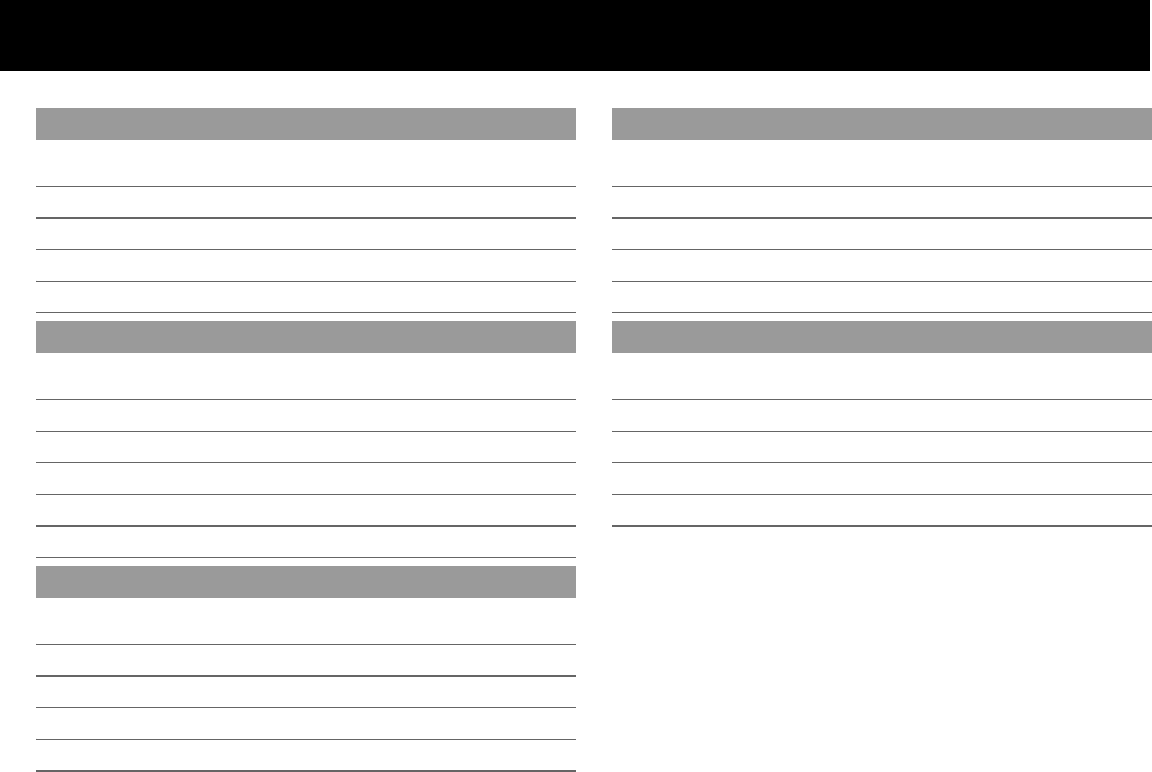
Contacts and Important Information
Use the spaces below to record important health and product information.
Name
Address
Telephone and Fax
Email Address
Name
Address
Telephone and Fax
Email Address
Name
Address
Telephone Number(s)
Policy Number
Name
Address
Telephone and Fax
Email Address
Script # Name Dose Frequency
OmniPod System Start Date: __________________________
PDM Version: 2 Serial Number: SN __________________
Emergency Services
Dial 911 (USA only; not available in all communities)
Insulet Corporation
9 Oak Park Drive • Bedford, MA 01730
Customer Support (24 hours/7days): 800-591-3455
When calling from outside the United States: 781-457-5098
Customer Support Fax: 877-467-8538
Web Site: MyOmniPod.com
Doctor
Nurse/Educator
Health Insurance
Pharmacy
Prescriptions

© 2008 Insulet Corporation. All rights reserved.
OmniPod is a registered trademark of Insulet Corporation.
U.S. Patent No. 6,740,059.
FreeStyle® is a registered trademark of Abbott Diabetes Care, Inc.

iii
Contents
Introduction. . . . . . . . . . . . . . . . . . . . . . . . . . . . . . . . . . . . . . . . . . . . . . ix
Before You Get Started . . . . . . . . . . . . . . . . . . . . . . . . . . . . . . . . . . . . . . ix
Indication. . . . . . . . . . . . . . . . . . . . . . . . . . . . . . . . . . . . . . . . . . . . . . . . . . . . . . ix
Contraindications . . . . . . . . . . . . . . . . . . . . . . . . . . . . . . . . . . . . . . . . . . . . . ix
You and your healthcare provider . . . . . . . . . . . . . . . . . . . . . . . . . . . . . x
Your Role: Safely Using the OmniPod System. . . . . . . . . . . . . . . . xi
About This User Guide. . . . . . . . . . . . . . . . . . . . . . . . . . . . . . . . . . . . . . . xi
Conventions and Terms . . . . . . . . . . . . . . . . . . . . . . . . . . . . . . . . . . . . . . . xi
Conventions and Terms (continued). . . . . . . . . . . . . . . . . . . . . . . . . . xii
Symbols . . . . . . . . . . . . . . . . . . . . . . . . . . . . . . . . . . . . . . . . . . . . . . . . . . . . . xii
1 Your New OmniPod Insulin Management System. . . . . . . 1
Insulin Delivery with the OmniPod System . . . . . . . . . . . . . . . . . . 1
How Does the OmniPod System Work? . . . . . . . . . . . . . . . . . . . . . 2
No tubing. . . . . . . . . . . . . . . . . . . . . . . . . . . . . . . . . . . . . . . . . . . . . . . . . . . . . . . 2
Automated cannula insertion. . . . . . . . . . . . . . . . . . . . . . . . . . . . . . . . . . 2
A fully-integrated design with blood glucose monitoring . . . . 2
Suggested bolus calculation . . . . . . . . . . . . . . . . . . . . . . . . . . . . . . . . . . 3
Reference food library and carb presets . . . . . . . . . . . . . . . . . . . . . . . 3
Record keeping. . . . . . . . . . . . . . . . . . . . . . . . . . . . . . . . . . . . . . . . . . . . . . . . . 3
Personalizing your System. . . . . . . . . . . . . . . . . . . . . . . . . . . . . . . . . . . . . 3
The OmniPod . . . . . . . . . . . . . . . . . . . . . . . . . . . . . . . . . . . . . . . . . . . . . . . 4
The Personal Diabetes Manager . . . . . . . . . . . . . . . . . . . . . . . . . . . . 4
Buttons that program and control the OmniPod System. . . . . 5
Primary screens . . . . . . . . . . . . . . . . . . . . . . . . . . . . . . . . . . . . . . . . . . . . . . . . 6
Safety Features. . . . . . . . . . . . . . . . . . . . . . . . . . . . . . . . . . . . . . . . . . . . . . 8
Automatic priming, safety checks, and insertion. . . . . . . . . . . . . . 8
Rapid occlusion detection. . . . . . . . . . . . . . . . . . . . . . . . . . . . . . . . . . . . . 8
Alerts and alarms . . . . . . . . . . . . . . . . . . . . . . . . . . . . . . . . . . . . . . . . . . . . . . 8
2 Getting Started . . . . . . . . . . . . . . . . . . . . . . . . . . . . . . . . . . . . . . . 9
The OmniPod Starter Kit . . . . . . . . . . . . . . . . . . . . . . . . . . . . . . . . . . . . 9
Set Up the Personal Diabetes Manager (PDM) . . . . . . . . . . . . . 10
Turn on the PDM. . . . . . . . . . . . . . . . . . . . . . . . . . . . . . . . . . . . . . . . . . . . . . 10
The OmniPod Setup Wizard. . . . . . . . . . . . . . . . . . . . . . . . . . . . . . . . 11
Set date and time . . . . . . . . . . . . . . . . . . . . . . . . . . . . . . . . . . . . . . . . . . . . . 11
Enter basal settings . . . . . . . . . . . . . . . . . . . . . . . . . . . . . . . . . . . . . . . . . . . 12
Enter blood glucose sound setting and BG goal . . . . . . . . . . . . . 12
Set the suggested bolus calculator . . . . . . . . . . . . . . . . . . . . . . . . . . 12
Enter target blood glucose value . . . . . . . . . . . . . . . . . . . . . . . . . . . . 13

Contents
iv
Enter minimum BG allowed for use in bolus calculation . . . . 13
Enter insulin-to-carbohydrate ratio . . . . . . . . . . . . . . . . . . . . . . . . . . 13
Enter correction factor . . . . . . . . . . . . . . . . . . . . . . . . . . . . . . . . . . . . . . . 14
Set reverse correction . . . . . . . . . . . . . . . . . . . . . . . . . . . . . . . . . . . . . . . . 14
Enter the duration of insulin action . . . . . . . . . . . . . . . . . . . . . . . . . . 15
Select bolus increment and enter maximum bolus . . . . . . . . . . 15
Set extended bolus doses . . . . . . . . . . . . . . . . . . . . . . . . . . . . . . . . . . . 15
Set low reservoir alert . . . . . . . . . . . . . . . . . . . . . . . . . . . . . . . . . . . . . . . . 15
Set expiration alert . . . . . . . . . . . . . . . . . . . . . . . . . . . . . . . . . . . . . . . . . . . 15
3 Understanding and Adjusting Basal Rates . . . . . . . . . . . . 17
What Is a Basal Rate? . . . . . . . . . . . . . . . . . . . . . . . . . . . . . . . . . . . . . . . 17
Personalized Basal Programs. . . . . . . . . . . . . . . . . . . . . . . . . . . . . . . 17
Create a basal program . . . . . . . . . . . . . . . . . . . . . . . . . . . . . . . . . . . . . . 18
Enable an existing basal program. . . . . . . . . . . . . . . . . . . . . . . . . . . . 20
Change, rename, copy, or delete a basal program . . . . . . . . . . . 21
Temporary Basal Rates and Presets . . . . . . . . . . . . . . . . . . . . . . . . 23
What is a temporary basal rate?. . . . . . . . . . . . . . . . . . . . . . . . . . . . . . 23
Enable a one-time temporary basal rate. . . . . . . . . . . . . . . . . . . . . 24
Cancel a one-time temporary basal rate. . . . . . . . . . . . . . . . . . . . . 25
Create a temporary basal preset . . . . . . . . . . . . . . . . . . . . . . . . . . . . . 25
Enable an existing temporary basal preset . . . . . . . . . . . . . . . . . . 26
Cancel an active temporary basal preset . . . . . . . . . . . . . . . . . . . . 27
Change, rename, or delete a temporary basal preset . . . . . . . 27
Maximum Basal Rate. . . . . . . . . . . . . . . . . . . . . . . . . . . . . . . . . . . . . . . 28
What is the maximum basal rate?. . . . . . . . . . . . . . . . . . . . . . . . . . . . 28
Change the maximum basal rate . . . . . . . . . . . . . . . . . . . . . . . . . . . . 28
4 Understanding and Delivering Bolus Doses . . . . . . . . . . . 29
What Is a Bolus? . . . . . . . . . . . . . . . . . . . . . . . . . . . . . . . . . . . . . . . . . . . . 29
Bolus Dose Options . . . . . . . . . . . . . . . . . . . . . . . . . . . . . . . . . . . . . . . . 30
Suggested Bolus Calculator . . . . . . . . . . . . . . . . . . . . . . . . . . . . . . . . 30
How a suggested bolus is calculated. . . . . . . . . . . . . . . . . . . . . . . . . 30
Deliver a Normal Bolus . . . . . . . . . . . . . . . . . . . . . . . . . . . . . . . . . . . . . 31
Deliver a bolus when suggested bolus calculator is On . . . . . 31
Deliver a bolus manually (suggested bolus calc is Off) . . . . . . 34
Deliver an Extended Bolus. . . . . . . . . . . . . . . . . . . . . . . . . . . . . . . . . . 34
Deliver an extended bolus instead of a normal bolus . . . . . . . 34
Cancel Active Boluses . . . . . . . . . . . . . . . . . . . . . . . . . . . . . . . . . . . . . . 36
Replace an Extended Bolus. . . . . . . . . . . . . . . . . . . . . . . . . . . . . . . . . 37
Bolus Presets . . . . . . . . . . . . . . . . . . . . . . . . . . . . . . . . . . . . . . . . . . . . . . . 38
Create a bolus preset . . . . . . . . . . . . . . . . . . . . . . . . . . . . . . . . . . . . . . . . 38
Enable an existing bolus preset . . . . . . . . . . . . . . . . . . . . . . . . . . . . . . 39
Change, rename, or delete a bolus preset. . . . . . . . . . . . . . . . . . . . 39
Cancel an active bolus preset. . . . . . . . . . . . . . . . . . . . . . . . . . . . . . . . . 40
Carb Presets . . . . . . . . . . . . . . . . . . . . . . . . . . . . . . . . . . . . . . . . . . . . . . . . 40
Create a carb preset. . . . . . . . . . . . . . . . . . . . . . . . . . . . . . . . . . . . . . . . . . . 40
Change or edit a carb preset . . . . . . . . . . . . . . . . . . . . . . . . . . . . . . . . . 41
Delete a carb preset . . . . . . . . . . . . . . . . . . . . . . . . . . . . . . . . . . . . . . . . . . 42
Reference Food Library . . . . . . . . . . . . . . . . . . . . . . . . . . . . . . . . . . . . . 43
Access the reference food library. . . . . . . . . . . . . . . . . . . . . . . . . . . . . 43

Contents
v
5 Using the OmniPod. . . . . . . . . . . . . . . . . . . . . . . . . . . . . . . . . . . 44
The OmniPod Change Process . . . . . . . . . . . . . . . . . . . . . . . . . . . . . 44
Gather equipment and supplies . . . . . . . . . . . . . . . . . . . . . . . . . . . . . 45
Deactivate the current OmniPod . . . . . . . . . . . . . . . . . . . . . . . . . . . . 45
Fill a new OmniPod. . . . . . . . . . . . . . . . . . . . . . . . . . . . . . . . . . . . . . . . . . . 47
Select the infusion site . . . . . . . . . . . . . . . . . . . . . . . . . . . . . . . . . . . . . . . 50
Prepare the infusion site. . . . . . . . . . . . . . . . . . . . . . . . . . . . . . . . . . . . . . 51
Apply the new OmniPod. . . . . . . . . . . . . . . . . . . . . . . . . . . . . . . . . . . . . 52
Insert cannula and begin insulin delivery. . . . . . . . . . . . . . . . . . . . 53
Check Pod Status. . . . . . . . . . . . . . . . . . . . . . . . . . . . . . . . . . . . . . . . . . . 55
Suspend Insulin Delivery . . . . . . . . . . . . . . . . . . . . . . . . . . . . . . . . . . . 56
Resume Insulin Delivery. . . . . . . . . . . . . . . . . . . . . . . . . . . . . . . . . . . . 57
Avoid Infusion Site Infections. . . . . . . . . . . . . . . . . . . . . . . . . . . . . . . 57
Get the Most From Your Pod . . . . . . . . . . . . . . . . . . . . . . . . . . . . . . . 58
Avoid extreme temperatures . . . . . . . . . . . . . . . . . . . . . . . . . . . . . . . . 58
Water and your OmniPod . . . . . . . . . . . . . . . . . . . . . . . . . . . . . . . . . . . . 58
Safe storage. . . . . . . . . . . . . . . . . . . . . . . . . . . . . . . . . . . . . . . . . . . . . . . . . . 58
6 Using the Personal Diabetes Manager . . . . . . . . . . . . . . . . 59
The Status Screens . . . . . . . . . . . . . . . . . . . . . . . . . . . . . . . . . . . . . . . . . 59
Insulin gauge and display. . . . . . . . . . . . . . . . . . . . . . . . . . . . . . . . . . . . 60
PDM settings . . . . . . . . . . . . . . . . . . . . . . . . . . . . . . . . . . . . . . . . . . . . . . . . 60
The System Setup Menu . . . . . . . . . . . . . . . . . . . . . . . . . . . . . . . . . . . 61
Reset the Date or Time . . . . . . . . . . . . . . . . . . . . . . . . . . . . . . . . . . . . . 61
Reset the time . . . . . . . . . . . . . . . . . . . . . . . . . . . . . . . . . . . . . . . . . . . . . . . . 61
Reset the date. . . . . . . . . . . . . . . . . . . . . . . . . . . . . . . . . . . . . . . . . . . . . . . . . 62
Change Bolus and Basal Settings. . . . . . . . . . . . . . . . . . . . . . . . . . . 62
Bolus calcs . . . . . . . . . . . . . . . . . . . . . . . . . . . . . . . . . . . . . . . . . . . . . . . . . . . 63
Ratios/factors/targets. . . . . . . . . . . . . . . . . . . . . . . . . . . . . . . . . . . . . . . . . 65
Temp basal. . . . . . . . . . . . . . . . . . . . . . . . . . . . . . . . . . . . . . . . . . . . . . . . . . . . 66
Extended. . . . . . . . . . . . . . . . . . . . . . . . . . . . . . . . . . . . . . . . . . . . . . . . . . . . . . 66
Bolus increment . . . . . . . . . . . . . . . . . . . . . . . . . . . . . . . . . . . . . . . . . . . . . . 66
Max bolus . . . . . . . . . . . . . . . . . . . . . . . . . . . . . . . . . . . . . . . . . . . . . . . . . . . . . 66
Max basal rate. . . . . . . . . . . . . . . . . . . . . . . . . . . . . . . . . . . . . . . . . . . . . . . . . 66
Alerts and Reminders . . . . . . . . . . . . . . . . . . . . . . . . . . . . . . . . . . . . . . 67
Set alerts and reminders. . . . . . . . . . . . . . . . . . . . . . . . . . . . . . . . . . . . . . 68
Change Blood Glucose Meter Settings . . . . . . . . . . . . . . . . . . . . . 70
Change BG limit goal or BG sound . . . . . . . . . . . . . . . . . . . . . . . . . . . 70
Manage the Blood Glucose Tags List . . . . . . . . . . . . . . . . . . . . . . . . . 71
Customize the Personal Diabetes Manager . . . . . . . . . . . . . . . . 72
Set PDM options. . . . . . . . . . . . . . . . . . . . . . . . . . . . . . . . . . . . . . . . . . . . . . 72
Set Diagnostic Functions. . . . . . . . . . . . . . . . . . . . . . . . . . . . . . . . . . . 73
Diagnostic options. . . . . . . . . . . . . . . . . . . . . . . . . . . . . . . . . . . . . . . . . . . . 74
Set a Vibration Alert. . . . . . . . . . . . . . . . . . . . . . . . . . . . . . . . . . . . . . . . 75
Get the Most from Your PDM . . . . . . . . . . . . . . . . . . . . . . . . . . . . . . 75
Keep it handy . . . . . . . . . . . . . . . . . . . . . . . . . . . . . . . . . . . . . . . . . . . . . . . . . 75
Communicating with the Pod. . . . . . . . . . . . . . . . . . . . . . . . . . . . . . . . 75
Water and your PDM. . . . . . . . . . . . . . . . . . . . . . . . . . . . . . . . . . . . . . . . . . 75
Avoid extreme temperatures. . . . . . . . . . . . . . . . . . . . . . . . . . . . . . . . . 76
Electrical interference. . . . . . . . . . . . . . . . . . . . . . . . . . . . . . . . . . . . . . . . . 76

Contents
vi
7 Checking Your Blood Glucose. . . . . . . . . . . . . . . . . . . . . . . . . 77
The Built-in FreeStyle® Blood Glucose Meter . . . . . . . . . . . . . . . 77
The FreeStyle® Blood Glucose Test Strips. . . . . . . . . . . . . . . . . . . 78
Important test strip information . . . . . . . . . . . . . . . . . . . . . . . . . . . . . 78
The FreeStyle® Control Solution. . . . . . . . . . . . . . . . . . . . . . . . . . . . 79
When to perform a control solution test. . . . . . . . . . . . . . . . . . . . . 79
Check that the meter and test strips are working . . . . . . . . . . . 79
Control solution expiration date . . . . . . . . . . . . . . . . . . . . . . . . . . . . . 79
Ensure accurate control solution results . . . . . . . . . . . . . . . . . . . . . 79
Out-of-range control solution results. . . . . . . . . . . . . . . . . . . . . . . . 80
Performing a Control Solution Test . . . . . . . . . . . . . . . . . . . . . . . . 81
Performing a Blood Glucose Test. . . . . . . . . . . . . . . . . . . . . . . . . . . 85
Prepare the lancing device. . . . . . . . . . . . . . . . . . . . . . . . . . . . . . . . . . . 86
Insert the blood glucose test strip . . . . . . . . . . . . . . . . . . . . . . . . . . . 87
Set the blood glucose test strip code . . . . . . . . . . . . . . . . . . . . . . . . 88
Lance your finger . . . . . . . . . . . . . . . . . . . . . . . . . . . . . . . . . . . . . . . . . . . . 89
Lance your forearm, upper arm, hand, thigh, or calf. . . . . . . . . 90
Fill the blood glucose test strip with blood . . . . . . . . . . . . . . . . . . 91
Wait for the reading . . . . . . . . . . . . . . . . . . . . . . . . . . . . . . . . . . . . . . . . . . 92
Remove the lancet . . . . . . . . . . . . . . . . . . . . . . . . . . . . . . . . . . . . . . . . . . . 94
Blood Glucose Results and the Suggested Bolus Calculator 94
Entering Blood Glucose Readings Manually. . . . . . . . . . . . . . . . 95
Editing Tags. . . . . . . . . . . . . . . . . . . . . . . . . . . . . . . . . . . . . . . . . . . . . . . . 95
Low and High Blood Glucose Readings . . . . . . . . . . . . . . . . . . . . 97
Low readings . . . . . . . . . . . . . . . . . . . . . . . . . . . . . . . . . . . . . . . . . . . . . . . . . 97
High readings. . . . . . . . . . . . . . . . . . . . . . . . . . . . . . . . . . . . . . . . . . . . . . . . . 97
Important Health-Related Information . . . . . . . . . . . . . . . . . . . . . 98
8 Understanding Your Records . . . . . . . . . . . . . . . . . . . . . . . . . 99
Record Keeping . . . . . . . . . . . . . . . . . . . . . . . . . . . . . . . . . . . . . . . . . . . . 99
Special symbols in record screens . . . . . . . . . . . . . . . . . . . . . . . . . . . 99
Insulin Delivery Records . . . . . . . . . . . . . . . . . . . . . . . . . . . . . . . . . . 100
View insulin delivery records . . . . . . . . . . . . . . . . . . . . . . . . . . . . . . . . 100
Blood Glucose Records . . . . . . . . . . . . . . . . . . . . . . . . . . . . . . . . . . . 102
View single-day trends . . . . . . . . . . . . . . . . . . . . . . . . . . . . . . . . . . . . . . 102
View multiple-day trends. . . . . . . . . . . . . . . . . . . . . . . . . . . . . . . . . . . . 103
Alarm Records. . . . . . . . . . . . . . . . . . . . . . . . . . . . . . . . . . . . . . . . . . . . 104
Carbohydrate Records. . . . . . . . . . . . . . . . . . . . . . . . . . . . . . . . . . . . 104
All Records . . . . . . . . . . . . . . . . . . . . . . . . . . . . . . . . . . . . . . . . . . . . . . . 105
User Information/Support. . . . . . . . . . . . . . . . . . . . . . . . . . . . . . . . 105
Add or change user information . . . . . . . . . . . . . . . . . . . . . . . . . . . . 106
9 Living with Diabetes. . . . . . . . . . . . . . . . . . . . . . . . . . . . . . . . . 107
Your Role: Safely Using the OmniPod System. . . . . . . . . . . . . 107
Daily Diabetes Management Activities . . . . . . . . . . . . . . . . . . . 108
Check your blood glucose frequently. . . . . . . . . . . . . . . . . . . . . . . 108
Inspect the infusion site daily. . . . . . . . . . . . . . . . . . . . . . . . . . . . . . . . 108
Prepare for Emergencies. . . . . . . . . . . . . . . . . . . . . . . . . . . . . . . . . . 109
Water and Your OmniPod . . . . . . . . . . . . . . . . . . . . . . . . . . . . . . . . 109
Traveling and Vacationing . . . . . . . . . . . . . . . . . . . . . . . . . . . . . . . . 110
Plan for changing time zones . . . . . . . . . . . . . . . . . . . . . . . . . . . . . . . 110

Contents
vii
Take enough supplies . . . . . . . . . . . . . . . . . . . . . . . . . . . . . . . . . . . . . . . 110
Minimize airport security delays . . . . . . . . . . . . . . . . . . . . . . . . . . . 111
Keep supplies accessible . . . . . . . . . . . . . . . . . . . . . . . . . . . . . . . . . . . . 111
Avoid Lows, Highs, and DKA. . . . . . . . . . . . . . . . . . . . . . . . . . . . . . . 112
General precautions. . . . . . . . . . . . . . . . . . . . . . . . . . . . . . . . . . . . . . . . . 112
Hypoglycemia (low blood glucose). . . . . . . . . . . . . . . . . . . . . . . . . 112
Hyperglycemia (high blood glucose) . . . . . . . . . . . . . . . . . . . . . . . 116
Diabetic ketoacidosis (DKA). . . . . . . . . . . . . . . . . . . . . . . . . . . . . . . . . 120
Handling Special Situations . . . . . . . . . . . . . . . . . . . . . . . . . . . . . . . 121
Sick days . . . . . . . . . . . . . . . . . . . . . . . . . . . . . . . . . . . . . . . . . . . . . . . . . . . . . 121
Exercising, playing sports, or working hard. . . . . . . . . . . . . . . . . 121
X-rays, MRIs, and CT scans. . . . . . . . . . . . . . . . . . . . . . . . . . . . . . . . . . . 122
Surgery or hospitalization. . . . . . . . . . . . . . . . . . . . . . . . . . . . . . . . . . . 122
10 Errors, Advisories, and Hazard Alarms . . . . . . . . . . . . . . . 123
Safety Checks . . . . . . . . . . . . . . . . . . . . . . . . . . . . . . . . . . . . . . . . . . . . . 123
Blood Glucose Meter Error Messages. . . . . . . . . . . . . . . . . . . . . . 123
Advisory Alarms . . . . . . . . . . . . . . . . . . . . . . . . . . . . . . . . . . . . . . . . . . . 126
Hazard Alarms. . . . . . . . . . . . . . . . . . . . . . . . . . . . . . . . . . . . . . . . . . . . . 128
11 Communication Failures. . . . . . . . . . . . . . . . . . . . . . . . . . . . . 132
The Communication Process . . . . . . . . . . . . . . . . . . . . . . . . . . . . . . 132
Failure During Pod Activation or Operation . . . . . . . . . . . . . . . 132
Failure During Pod Deactivation. . . . . . . . . . . . . . . . . . . . . . . . . . . 134
Failure During Request for Status. . . . . . . . . . . . . . . . . . . . . . . . . . 135
Failure During Bolus Cancellation . . . . . . . . . . . . . . . . . . . . . . . . . 136
Failure During a Hazard Alarm . . . . . . . . . . . . . . . . . . . . . . . . . . . . 138
Appendices . . . . . . . . . . . . . . . . . . . . . . . . . . . . . . . . . . . . . . . . . . . . 139
OmniPod Care and Maintenance . . . . . . . . . . . . . . . . . . . . . . . . . 139
Storage. . . . . . . . . . . . . . . . . . . . . . . . . . . . . . . . . . . . . . . . . . . . . . . . . . . . . . . 139
Cleaning . . . . . . . . . . . . . . . . . . . . . . . . . . . . . . . . . . . . . . . . . . . . . . . . . . . . . 139
Personal Diabetes Manager Care and Maintenance. . . . . . . 139
Storage. . . . . . . . . . . . . . . . . . . . . . . . . . . . . . . . . . . . . . . . . . . . . . . . . . . . . . . 139
Cleaning . . . . . . . . . . . . . . . . . . . . . . . . . . . . . . . . . . . . . . . . . . . . . . . . . . . . . 140
Replacing batteries . . . . . . . . . . . . . . . . . . . . . . . . . . . . . . . . . . . . . . . . . . 140
If the PDM becomes submerged in water . . . . . . . . . . . . . . . . . . 141
If you drop the PDM . . . . . . . . . . . . . . . . . . . . . . . . . . . . . . . . . . . . . . . . . 142
Storage and Supplies . . . . . . . . . . . . . . . . . . . . . . . . . . . . . . . . . . . . . 142
Storage. . . . . . . . . . . . . . . . . . . . . . . . . . . . . . . . . . . . . . . . . . . . . . . . . . . . . . . 142
Ordering supplies. . . . . . . . . . . . . . . . . . . . . . . . . . . . . . . . . . . . . . . . . . . . 142
Suggested Bolus Calculator Examples and Guidelines . . . . 143
Meal bolus calculation. . . . . . . . . . . . . . . . . . . . . . . . . . . . . . . . . . . . . . . 143
Insulin-on-board (IOB) calculation. . . . . . . . . . . . . . . . . . . . . . . . . . . 143
Examples of suggested bolus calculations. . . . . . . . . . . . . . . . . . 144
Calculator guidelines . . . . . . . . . . . . . . . . . . . . . . . . . . . . . . . . . . . . . . . . 145
OmniPod System Options and Settings. . . . . . . . . . . . . . . . . . . 147
OmniPod Specifications. . . . . . . . . . . . . . . . . . . . . . . . . . . . . . . . . . . 148
Personal Diabetes Manager Specifications. . . . . . . . . . . . . . . . 149
Blood Glucose Meter Specifications. . . . . . . . . . . . . . . . . . . . . . . 149
OmniPod System Label Symbols. . . . . . . . . . . . . . . . . . . . . . . . . . 150

Contents
viii
Personal Diabetes Manager Icons. . . . . . . . . . . . . . . . . . . . . . . . . 150
OmniPod System Federal Communications
Commission (FCC) Notice Concerning Interference. . . . . . . 151
Electromagnetic Compatibility . . . . . . . . . . . . . . . . . . . . . . . . . . . 152
Customer Bill of Rights. . . . . . . . . . . . . . . . . . . . . . . . . . . . . . . . . . . . 156
Mission Statement . . . . . . . . . . . . . . . . . . . . . . . . . . . . . . . . . . . . . . . . . . 156
Scope of Services. . . . . . . . . . . . . . . . . . . . . . . . . . . . . . . . . . . . . . . . . . . . 156
Compliance. . . . . . . . . . . . . . . . . . . . . . . . . . . . . . . . . . . . . . . . . . . . . . . . . . 156
Supply Shipment. . . . . . . . . . . . . . . . . . . . . . . . . . . . . . . . . . . . . . . . . . . . 156
Inquiries . . . . . . . . . . . . . . . . . . . . . . . . . . . . . . . . . . . . . . . . . . . . . . . . . . . . . 156
Customer’s Bill of Rights and Responsibilities. . . . . . . . . . . . . . . 156
Limited Warranty for the Personal Diabetes Manager . . . . 158
HIPAA Privacy Notice . . . . . . . . . . . . . . . . . . . . . . . . . . . . . . . . . . . . . 159
Uses and Disclosures of Medical Information. . . . . . . . . . . . . . . 159
Your Rights. . . . . . . . . . . . . . . . . . . . . . . . . . . . . . . . . . . . . . . . . . . . . . . . . . . 162
Our Duties . . . . . . . . . . . . . . . . . . . . . . . . . . . . . . . . . . . . . . . . . . . . . . . . . . . 164
What To Do If You Have a Problem or Question. . . . . . . . . . . . . 164
Helpful Resources. . . . . . . . . . . . . . . . . . . . . . . . . . . . . . . . . . . . . . . . 165
Glossary. . . . . . . . . . . . . . . . . . . . . . . . . . . . . . . . . . . . . . . . . . . . . . . . 166
Index. . . . . . . . . . . . . . . . . . . . . . . . . . . . . . . . . . . . . . . . . . . . . . . . . . . 172
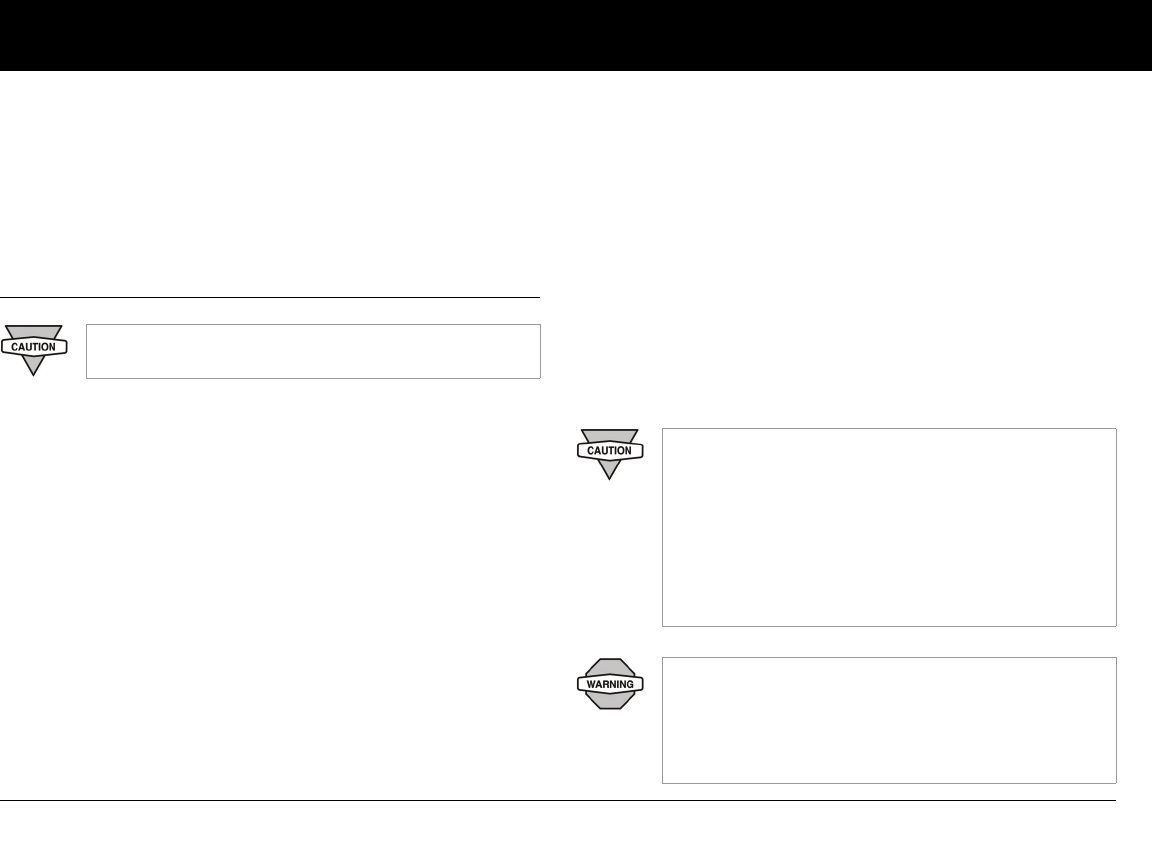
ix
Introduction
■ Before You Get Started
Indication
The OmniPod Insulin Management System is intended for sub-
cutaneous (below the skin) delivery of insulin at set and variable
rates for the management of diabetes mellitus in persons requir-
ing insulin and for the quantitative measurement of glucose in
fresh whole capillary blood (in vitro).
Contraindications
Insulin pump therapy is NOT recommended for people who are
either:
• Unable to perform at least four (4) blood glucose tests per day
• Unable to maintain contact with their healthcare provider
• Unable to use the System according to instructions
Do not use the integrated FreeStyle® Blood Glucose Monitoring
System for:
• Testing on newborns
• Testing arterial blood
• Diagnosing diabetes
US Federal law restricts this device to sale by or on
the order of a physician.
This User Guide is intended for use only with the
PDM2. To learn which version of the PDM you have,
turn it over. On the battery door label, you will see
“PDM2” if this is the correct User Guide. If you do not
see “PDM2,” please call Customer Support immedi-
ately to receive the correct User Guide: 800-591-3455.
When calling from outside the United States: 781-
457-5098.
If you are unable to use the System according to
instructions, you may be putting your health and
safety at risk. Talk with your healthcare provider if
you have questions or concerns about using the
System properly.
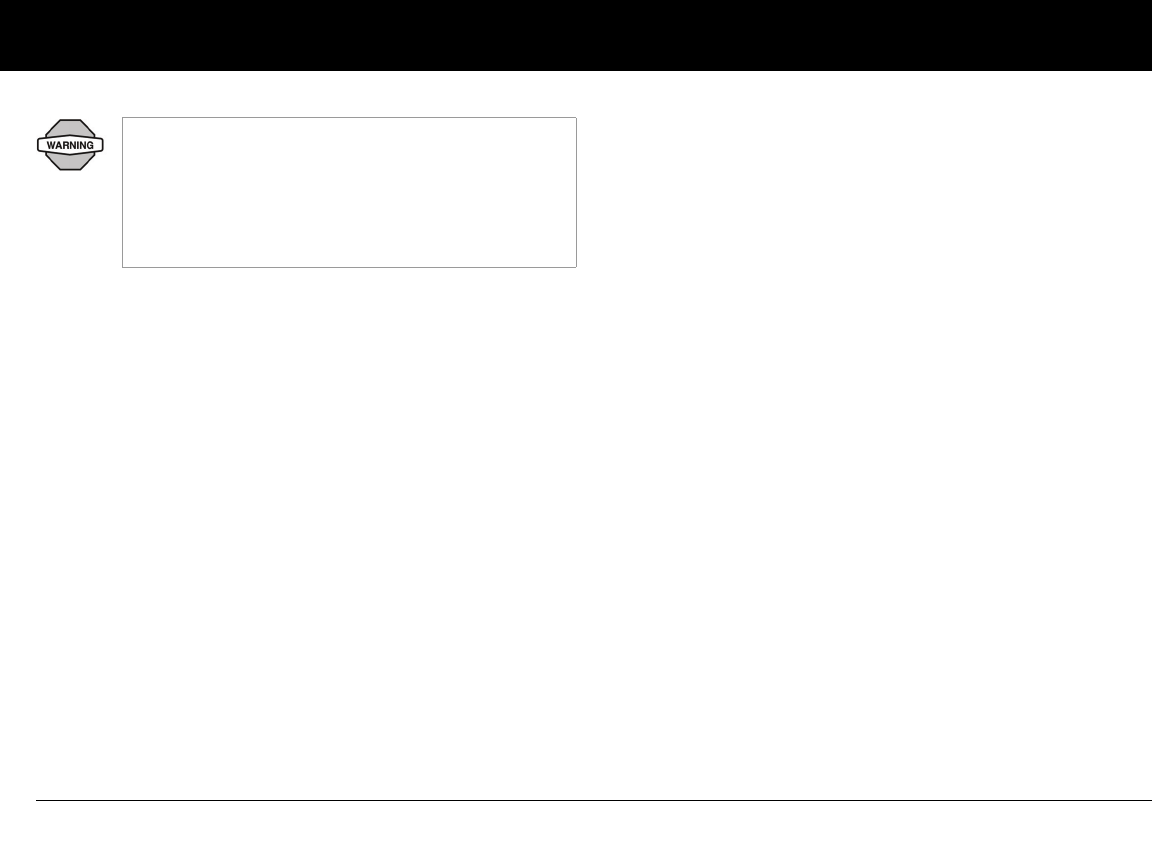
Introduction
x
You and your healthcare provider
Work with your healthcare provider to establish diabetes man-
agement guidelines and settings that best fit your needs. These
may include:
Insulin-to-Carbohydrate Ratio: Number of grams of carbohy-
drate covered by one unit of insulin. For example, if your insulin-
to-carbohydrate ratio is 1:15, then you need to deliver one unit of
insulin to cover every fifteen grams of carbohydrate you eat.
Correction or Sensitivity Factor: How much one unit of insulin
will lower blood glucose. For example, if your sensitivity factor is
50, one unit of insulin will lower your blood glucose by 50 mg/dL.
Target Blood Glucose Value: The blood glucose level you want
to achieve. For example, you may want to keep your blood glu-
cose close to 100 mg/dL.
Duration of insulin action: The length of time that insulin
remains active and available in your body after a bolus.
Your individual needs influence the initial settings you and your
healthcare provider will enter into the Personal Diabetes
Manager (PDM) during setup (see Chapter 2, Getting Started).
Your healthcare provider must help you enter these initial set-
tings. Soon you will enter and change your own settings with
confidence and ease. The OmniPod System is more user-friendly
than most electronic devices you use every day. In fact, technol-
ogy is what makes the OmniPod System so easy to use.
Your healthcare provider is a valuable resource. You will rely on
him or her for a lot of critical information about your OmniPod
System, especially during the first few weeks and months. When
you have questions about diabetes management after starting
on the OmniPod System, do not hesitate to talk with your health-
care provider. For nonmedical emergencies or for technical
questions about your OmniPod System setup or operation, you
can call Insulet Corporation 24 hours a day, 7 days a week at:
Customer Support (24 hours/7 days): 800-591-3455
When calling from outside the United States: 781-457-5098
Customer Support Fax: 877-467-8538
Web site: www.MyOmniPod.com
This User Guide is periodically updated. Visit MyOmniPod.com
to see the most recent version and to find other helpful
information.
Please read all the instructions provided in this User
Guide and practice the blood glucose testing proce-
dures before using the System. Monitor your blood
glucose with the guidance of your healthcare pro-
vider. Undetected hyperglycemia or hypoglycemia
can result without proper monitoring.
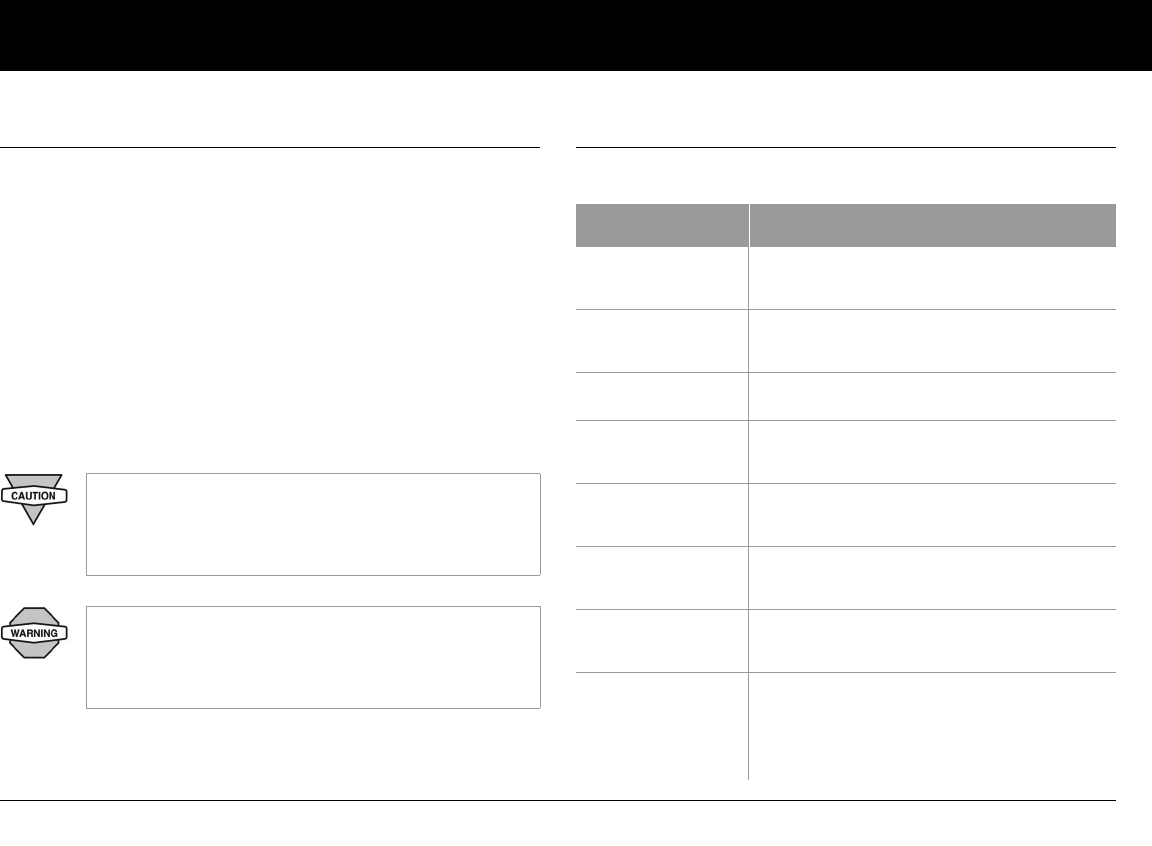
Introduction
xi
■ Your Role: Safely Using the OmniPod System
Your healthcare provider will give you all the tools and training
you need to be successful with the OmniPod Insulin Manage-
ment System. However, in the end, your success depends on
YOU. You must become actively involved in your own diabetes
management to enjoy the outstanding control, freedom, and
flexibility that is possible with the OmniPod System.
Being actively involved means:
• Frequently monitoring blood glucose levels
• Learning how to operate your OmniPod System and practic-
ing proper techniques
• Visiting your healthcare provider
■ About This User Guide
Conventions and Terms
If you are having symptoms that are not consistent
with your blood glucose test and you have followed
all instructions described in this User Guide, call your
healthcare professional.
Do NOT attempt to use the OmniPod Insulin
Management System before you receive training
from your healthcare provider. Inadequate training
could put your health and safety at risk.
Convention/Term Meaning
Bold Names of buttons, soft keys, menus, and
screens are in bold.
Italics Words in italics are defined in the
Glossary at the end of this User Guide.
Press Press and release a button or soft key.
Hold Keep pressing a button until its function is
complete.
Menu A list of options on the PDM. Options allow
you to perform tasks.
Screen Displays programming, operating, and
alarm/alert information.
Button A physical button on the PDM, such as the
Home/Power button.
Icon An image on the PDM screen that indi-
cates a menu option or item of informa-
tion. A table of screen icons appears in the
Appendices.
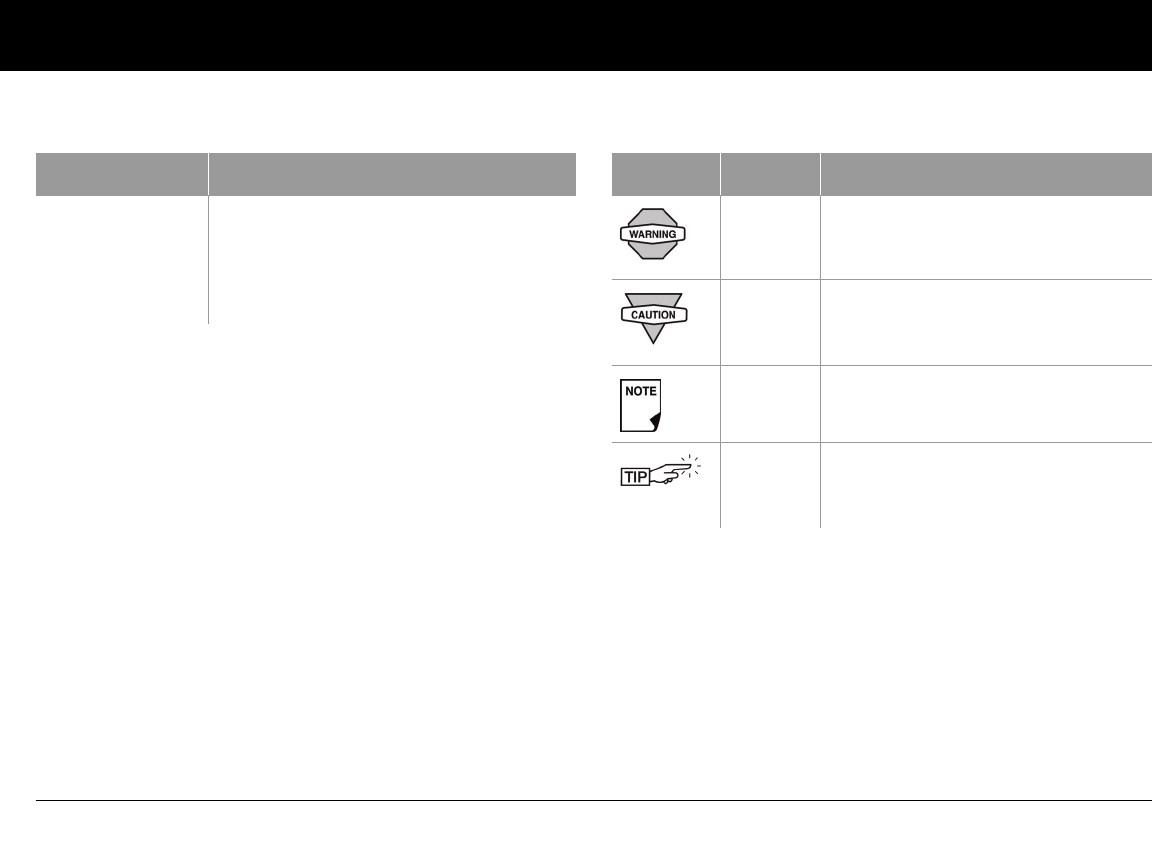
Introduction
xii
Conventions and Terms (continued) Symbols
Convention/Term Meaning
Soft keys A row of three unlabeled buttons on the
PDM whose label or function appears on
the screen directly above the button. The
label changes depending on the task you
are performing.
Symbol Term Meaning
Warning Describes potential serious adverse
reactions, or indicates conditions that
could cause death or serious injury.
Caution Indicates conditions that could cause
minor or moderate injury to you or
damage to the device.
Note Provides helpful information.
Tip Offers a suggestion for successful use
of the OmniPod Insulin Management
System.
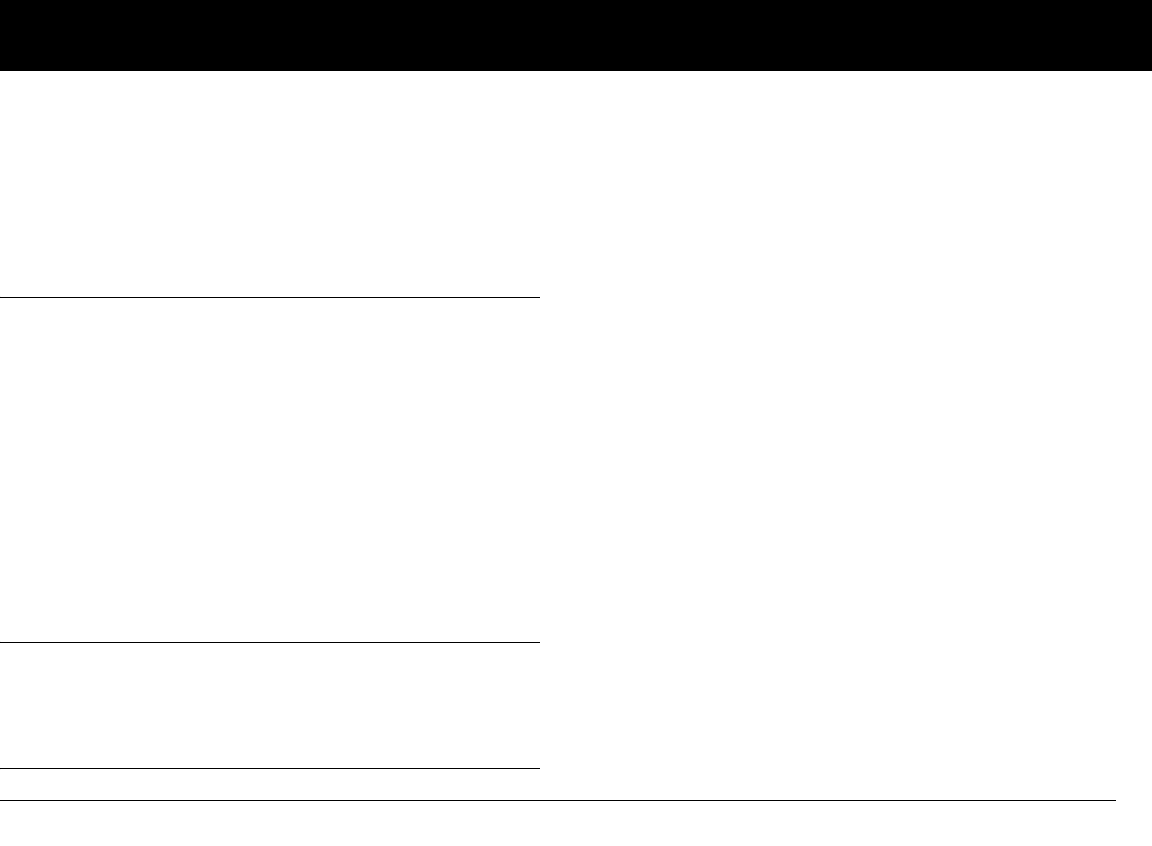
1
CHAPTER 1
Your New OmniPod Insulin Management System
■ Insulin Delivery with the OmniPod System
The OmniPod Insulin Management System is an innovative
continuous insulin delivery system that provides all the proven
benefits of continuous subcutaneous insulin infusion (CSII) therapy
in a way no conventional insulin pump can. The System’s innova-
tive design and features allows you to live your life—and
manage your diabetes—with unprecedented freedom, comfort,
convenience, and ease.
The long-term health benefits of better blood glucose control
are well known. Maintaining near-normal blood glucose levels
can help you live a longer, healthier life with fewer diabetes-
related complications. The OmniPod System also has many prac-
tical, everyday benefits, including convenience, freedom,
flexibility, and ease of use.
Continuous insulin delivery most closely mimics the insulin
release of a healthy pancreas. Since the landmark 10-year
Diabetes Control and Complications Trial (DCCT), the long-
term health benefits of maintaining near-normal blood
glucose levels have been widely recognized.
Continuous insulin delivery at preset rates eliminates the need
for injections and the interruptions that come with them. In addi-
tion, with the OmniPod System, insulin delivery can be changed
with the press of a button to adapt to snacks or unexpected
changes in daily routine. The OmniPod System is a great option
for people with diabetes who require insulin.
The OmniPod System works much like the pancreas of a person
without diabetes by delivering insulin in two ways:
• A small, constant, background supply of insulin (called a basal
rate) is delivered automatically at a programmed rate, all day
and night.
• An extra dose of insulin (called a bolus) can be delivered
when you need it to match the carbohydrates in a meal or
snack or to correct a high blood glucose.

Your New OmniPod Insulin Management System
2
1
■ How Does the OmniPod System Work?
The OmniPod is a small, lightweight, self-adhesive insulin Pod
that you fill with insulin and wear directly on your body for up to
three days, then replace. The OmniPod delivers precise, personal-
ized doses of insulin into your body through a small flexible tube
(called a cannula), based on instructions that you program into
its wireless companion, the Personal Diabetes Manager. The can-
nula is inserted only once with each OmniPod.
The Personal Diabetes Manager (PDM) is a wireless, handheld
device that:
• Programs the OmniPod with your personalized insulin-
delivery instructions
• Wirelessly monitors the OmniPod’s operation
• Incorporates a FreeStyle® blood glucose meter
With just two parts, you’ll enjoy all the functionality and benefits
of continuous insulin delivery and blood glucose monitoring.
Plus you’ll enjoy the safety, convenience, and freedom of:
No tubing
There is no tubing connecting the OmniPod to the PDM. You
wear the OmniPod comfortably and discreetly under your
clothes. You can carry the PDM separately in a backpack, brief-
case, or purse. With the OmniPod Insulin Management System,
you don’t have to worry about snagging, tangling, or feeling
tethered by tubing.
Automated cannula insertion
With the OmniPod System, you don’t have to insert the infusion
set manually or carry around a separate inserter. You simply press
a button on the PDM and the OmniPod’s automated insertion
system safely and consistently inserts the cannula beneath the
skin, virtually pain free.1 It then begins delivering insulin accord-
ing to your programmed basal rate.
A fully-integrated design with blood glucose monitoring
With a fully integrated two-part design, there’s no need to carry
separate infusion sets, reservoirs, or inserters. It’s all integrated
into the OmniPod. With the PDM, you can check your blood glu-
cose level using FreeStyle® blood glucose test strips, but without
the hassle of carrying a separate blood glucose meter.
If you prefer to use another blood glucose meter, you can enter
the readings manually into the PDM.
1. Data on file at Insulet Corporation.
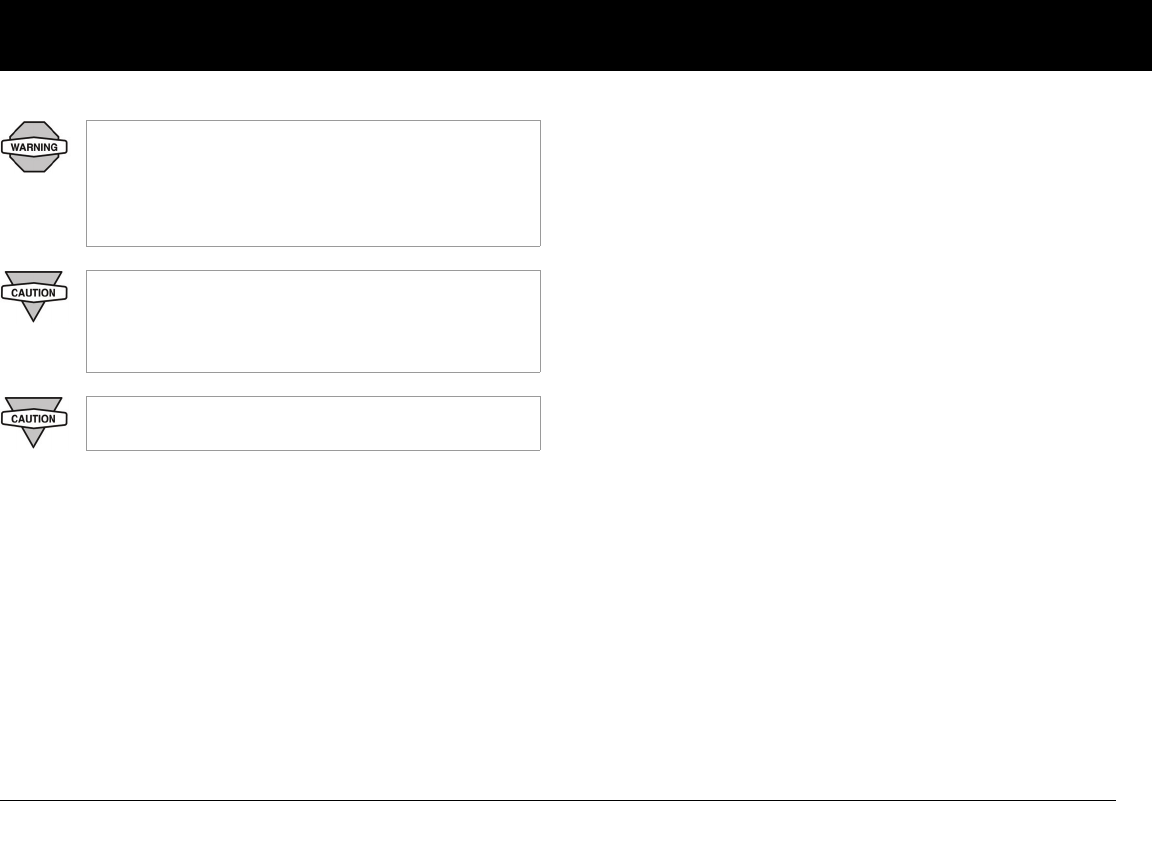
Your New OmniPod Insulin Management System
3
1
Suggested bolus calculation
Calculating bolus doses has never been easier. After you check
your blood glucose, enter the carbs for your snack or meal. Based
on your individual settings, the System displays a suggested
bolus dose. You can accept the suggestion, change it, or cancel it.
Reference food library and carb presets
To make carbohydrate counting easier, the OmniPod System
includes a reference food library. You can look up the carbs and
other values for many standard food items. Foods are organized
alphabetically and by category.
You can also enter your own favorite foods, snacks, or entire
meals as “carb presets.” Presets contain the grams of carbohy-
drate in the food item or meal. Next time you eat this same food,
you don’t have to count the carbs; just select your carb preset
and the System does the calculating for you. The System stores
up to 36 carb presets.
Record keeping
Another convenient part of the OmniPod System is record keep-
ing. Paper charts are useful, but sometimes they can be
inconvenient to carry or use. The data storage system in the
Personal Diabetes Manager (PDM) displays up to 90 days’ worth
of information. This includes blood glucose readings, basal rates
and bolus doses, carbohydrates, and alarms.
Personalizing your System
You can personalize your OmniPod System in other ways, too:
• Enter and name basal programs
• Name and save temporary basal presets
• Add your own customized reminders
• Enter your name, phone number, doctor’s names and
numbers, and other emergency information
We recommend that you test on your fingers if you
are checking for hypoglycemia (low blood glucose)
or if you suffer from hypoglycemia unawareness.
Blood from the fingertips may show changes in
blood glucose sooner than blood from other sites.
Only use FreeStyle® test strips and FreeStyle® control
solution with the OmniPod System. Using other
brands of test strips and control solutions with the
OmniPod System can produce inaccurate results.
Blood glucose monitoring should be done with the
guidance of a healthcare professional.
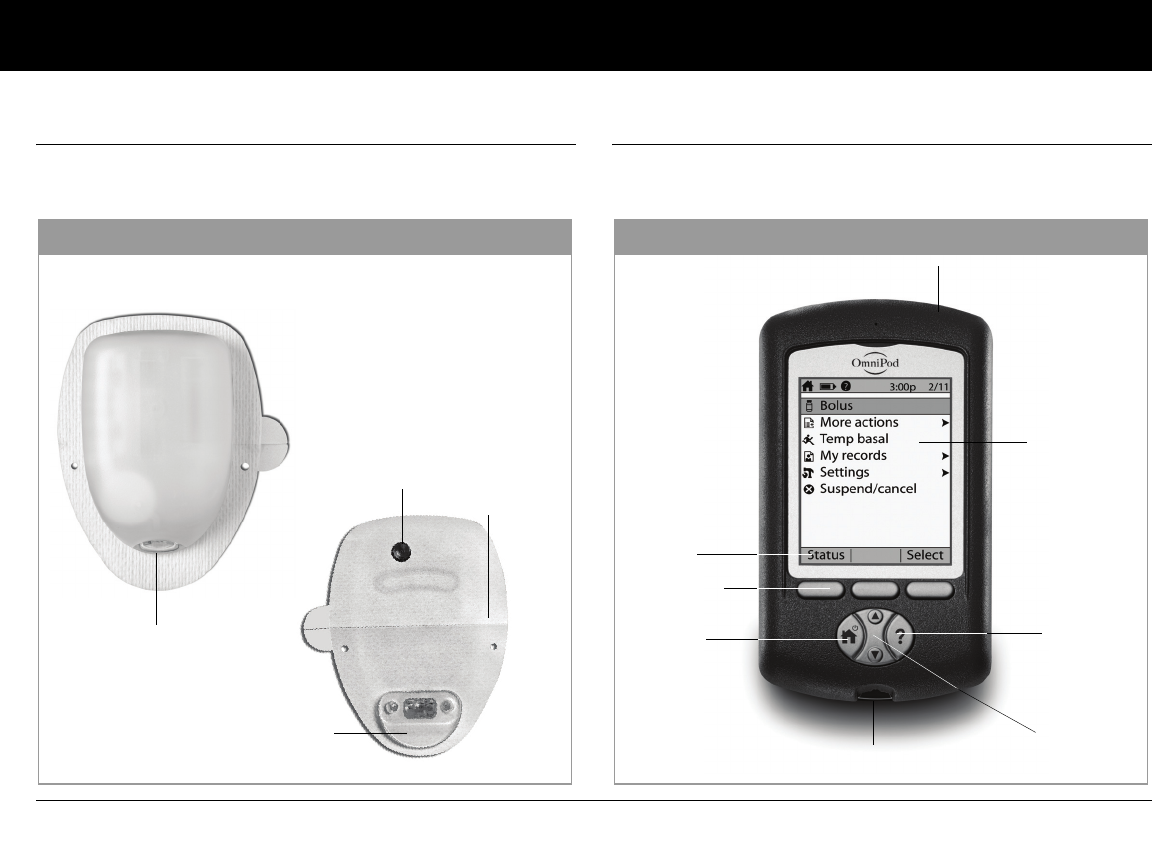
Your New OmniPod Insulin Management System
4
1
■ The OmniPod
The OmniPod (Figure 1-1) is applied to your skin with an
adhesive backing, similar to a Band-Aid®.
■ The Personal Diabetes Manager
All OmniPod operations are programmed and controlled through
the palm-sized Personal Diabetes Manager (PDM; Figure 1-2).
Top
Bottom
Needle cap
Viewing window
Fill port
Figure 1-1
Adhesive
backing
Figure 1-2
Up/Down
Controller
User Info/
Support
LCD Screen
Soft Key
Label
Soft Keys
Home/
Power
USB Port
Test Strip Port
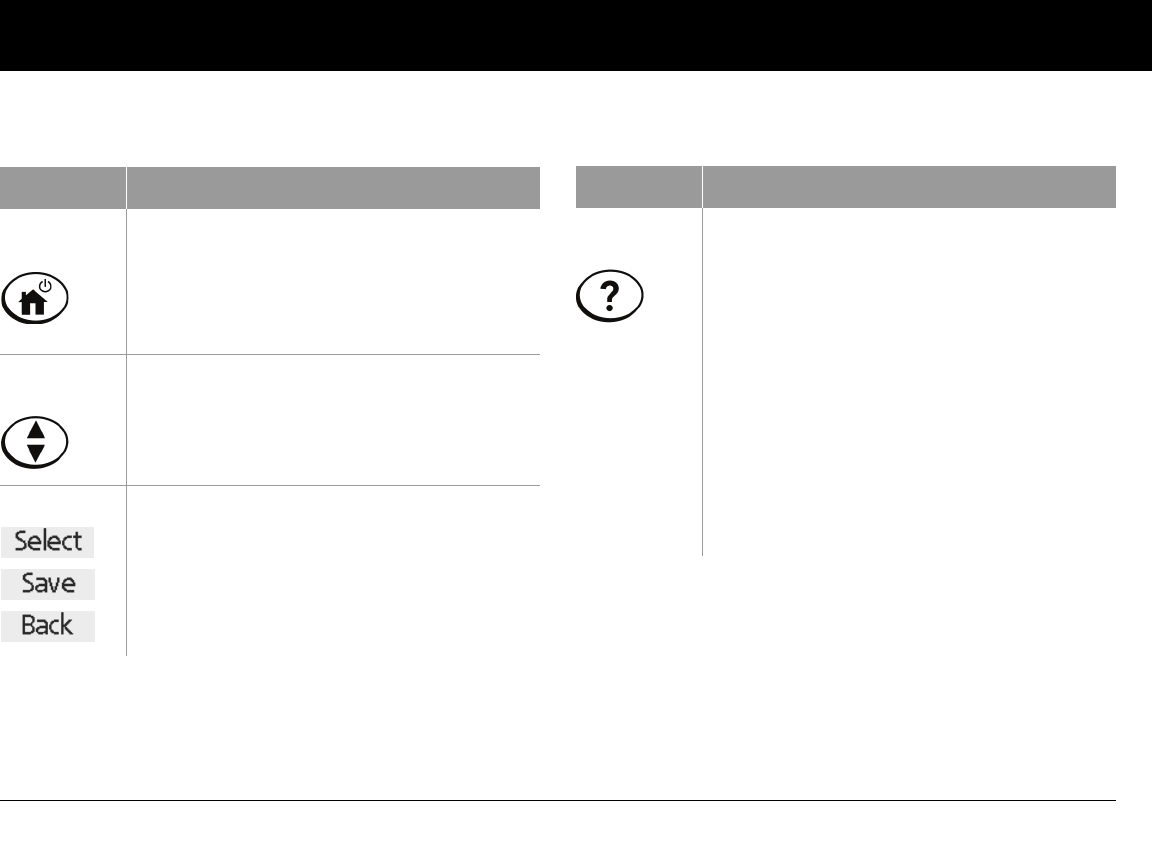
Your New OmniPod Insulin Management System
5
1
Buttons that program and control the OmniPod System
Button Action
Home/
Power Pressing and holding turns the PDM on and
off. When the PDM is on, pressing this button
displays the Home screen, from which you
can choose a menu item or view the Status
screens (shown later in this chapter).
Up/Down
Controller Pressing scrolls through a list of available menu
options or numbers, so you can pick the one
you want. Holding the button scrolls faster.
Soft Keys Soft key labels and functions depend on the
menu or screen you are viewing. The label
appears on the screen directly above the phys-
ical button you press. Select, Save, and Back
are just three examples of the soft key labels
on your PDM.
Button Action
User Info/
Support Pressing opens a User Info/Support screen
that displays additional information about the
current screen you are viewing. The User Info/
Support icon appears when additional infor-
mation can be viewed. It may be displayed at
the top of the screen, to the right of an event
detail (such as a suggested bolus), or to the
right of a record item ( such as a BG history
record). (See “Personal Diabetes Manager
Icons” in the Appendices.)
In addition, pressing and holding this button
for 2 seconds enables a “bright mode” on the
PDM screen.
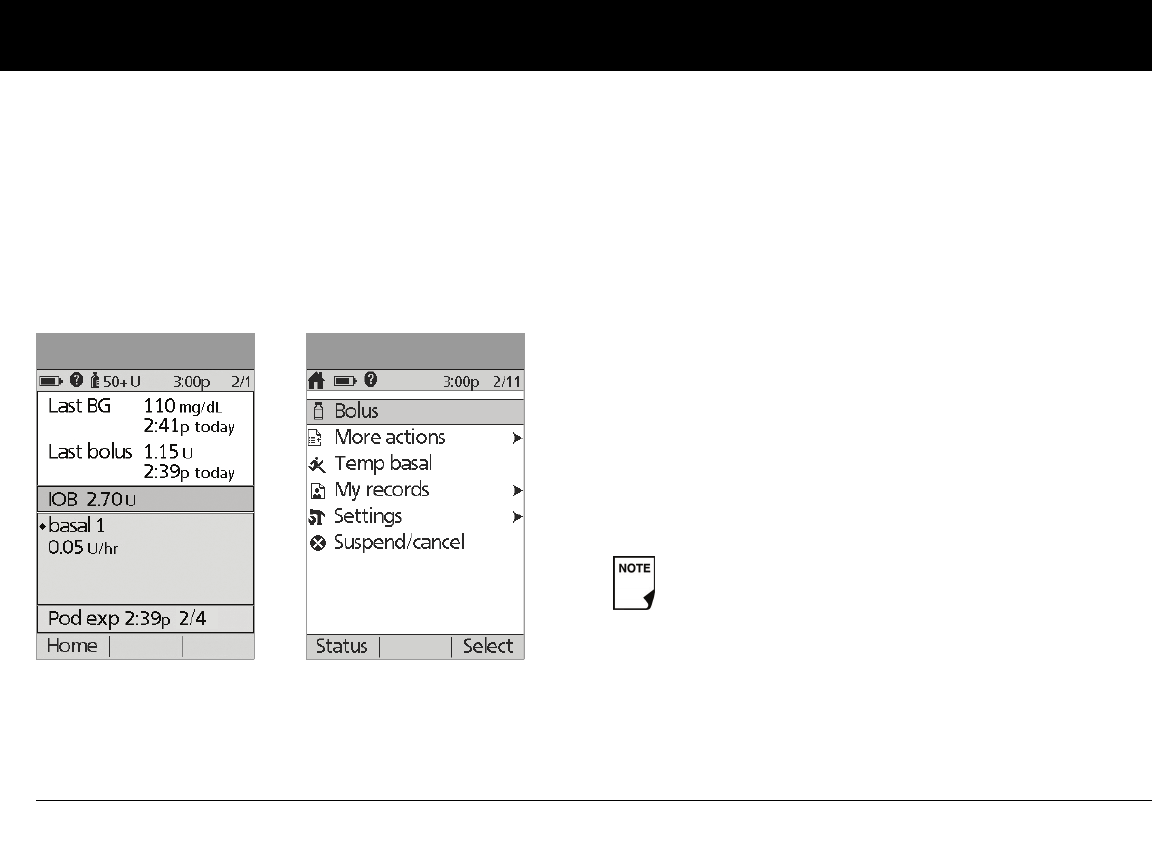
Your New OmniPod Insulin Management System
6
1
Primary screens
Messages on the screen either:
• Tell you how the System is operating
• List menu choices
• Explain how to perform certain tasks
The System’s primary screens are the Status screen (Figure 1-3)
and the Home screen (Figure 1-4).
Status screen
Lists the System’s current operating status.
From top to bottom, the Status screen displays:
• Time, date, and result of last blood glucose checked or
entered manually
• Time, date, and total amount of last bolus delivered
• Amount of insulin on board, if suggested bolus calculator is in
use
• Name and rate of active basal program or temp basal
program
• “Ext bolus,” the amount of insulin, and the delivery time
remaining if an extended bolus is being delivered
• “INSULIN SUSPENDED” if insulin delivery has been
suspended
• Time and date when the Pod will expire
Figure 1-3 Figure 1-4
If an OmniPod has not yet been activated (as during Pod
changes), the screen displays “No active Pod. Would you
like to activate a Pod now?” (See Chapter 5, Using the
OmniPod, for details on activating a Pod.)
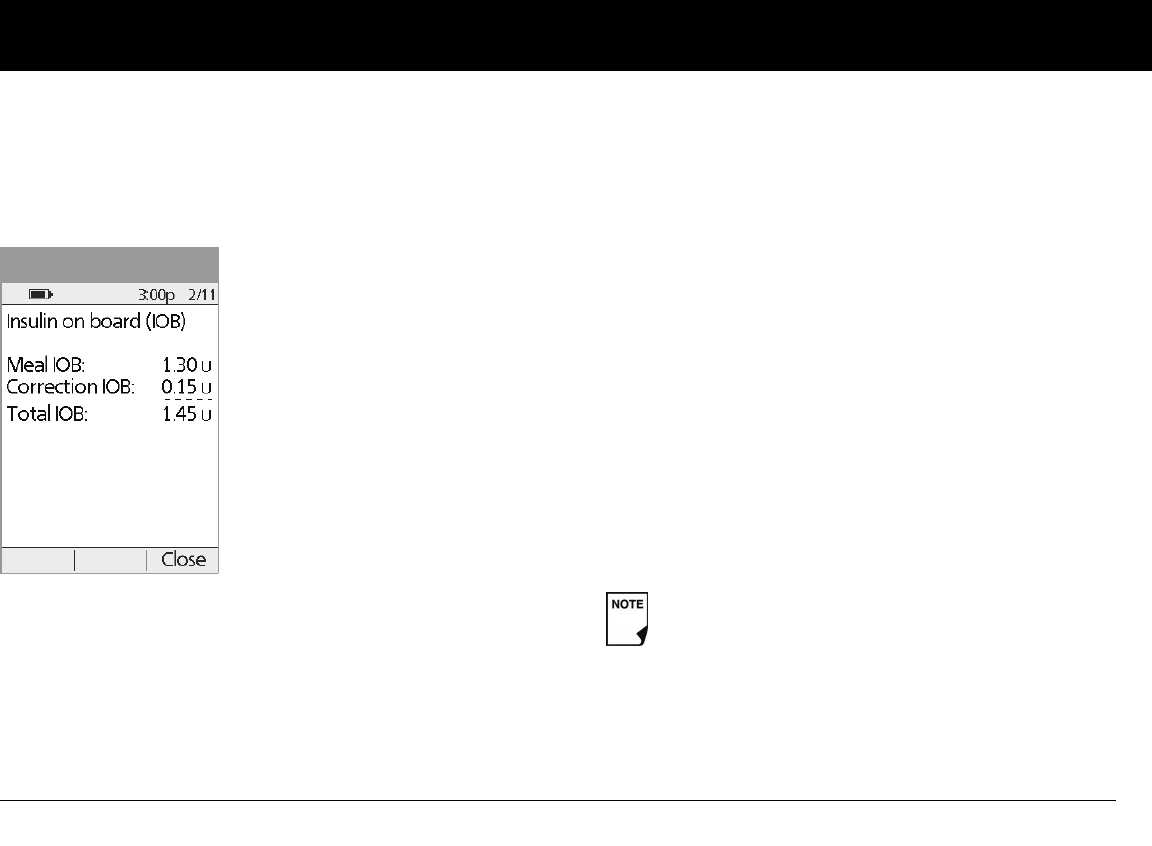
Your New OmniPod Insulin Management System
7
1
Status support screen
From the Status screen, press the User Info/Support button to
see details about the current insulin on board (IOB) in your body
(Figure 1-5).
Home screen
Lists all the major menus (Figure 1-4 on previous page).
•Bolus menu to deliver bolus doses
•More actions menu to change the Pod, manually enter
blood glucose readings, assign and edit tags for BG readings
that are less than 2 hours old, and view the food library.
•Temp basal menu to deliver temporary basal rates (This
submenu does not appear if Temp basal is turned Off in
Settings.)
•My records menu to review insulin delivery, blood glucose
history, alarm history, carb history, and personal user informa-
tion
•Settings menu to edit, enter, and name basal programs,
temp basal, carbohydrate, and bolus presets, and to custom-
ize System settings
•Suspend menu to suspend, cancel, or resume insulin
delivery programs
Figure 1-5
You can go to the Status screen at any time by
pressing Status from the Home screen.
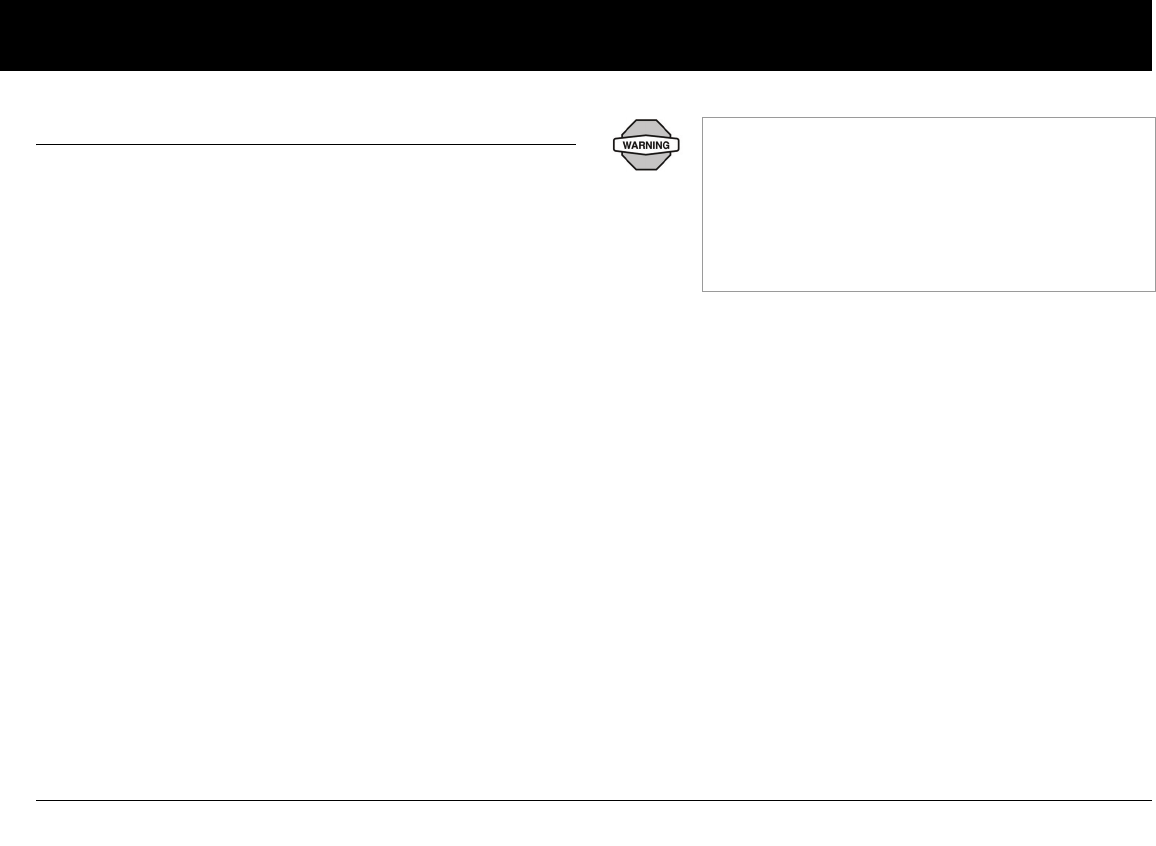
Your New OmniPod Insulin Management System
8
1
■ Safety Features
The OmniPod System’s state-of-the-art design includes the latest
safety technology. Its built-in safety features include:
Automatic priming, safety checks, and insertion
Every time a new OmniPod is activated, the System automati-
cally primes and performs a safety check on the Pod, then inserts
and primes the cannula (see Chapter 5, Using the OmniPod).
Microprocessor technology makes it possible to complete thou-
sands of safety checks in only a few seconds.
The OmniPod System also performs safety checks on the PDM.
If it detects any problems in the PDM or the OmniPod—or in
communication between them—it informs you with beeps and
on-screen messages.
Rapid occlusion detection
An occlusion is a blockage or interruption in insulin delivery. If
the OmniPod System detects an occlusion, it sounds a hazard
alarm and prompts you to deactivate and change your Pod (see
Chapter 10, Errors, Advisories, and Hazard Alarms).
Alerts and alarms
For your safety, the OmniPod System provides a range of alerts
and alarms to tell you that your attention is needed, or to warn
you of hazardous situations.
See Chapter 6, Using the Personal Diabetes Manager, for a
description of alerts and reminders and how to set them. See
Chapter 10, Errors, Advisories, and Hazard Alarms, for a list of
safety alarms built into the OmniPod System and how to
respond to them.
An occlusion may result from a blockage, Pod mal-
function, or from using old or inactive insulin. If
insulin delivery is interrupted by an occlusion, check
your blood glucose level and follow the treatment
guidelines established by your healthcare provider.
Hyperglycemia could result if appropriate actions
are not taken.
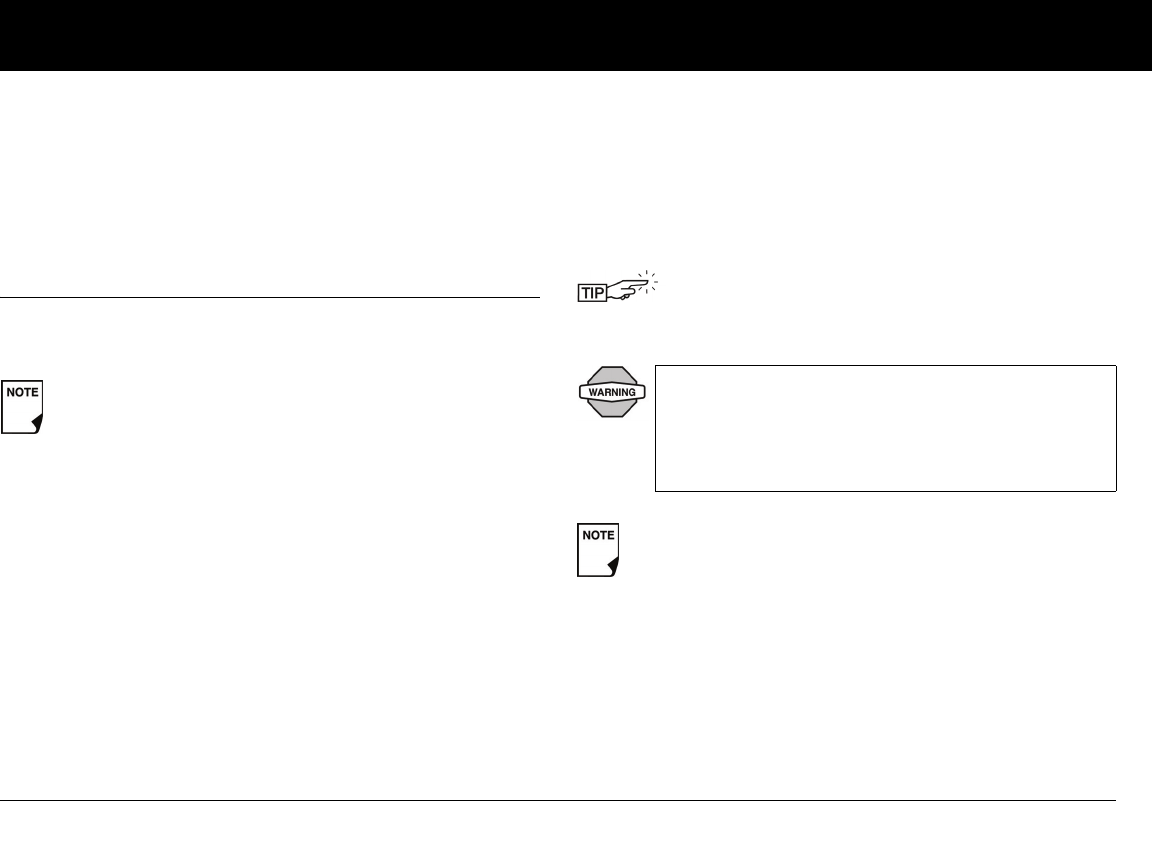
9
CHAPTER 2
Getting Started
■ The OmniPod Starter Kit
Your Starter Kit contains everything you need to begin using the
OmniPod System.
If you are a first-time OmniPod System user, you need to meet
with your healthcare provider for training and System setup
before using it. To get a head start on learning about your new
OmniPod System, review this User Guide and the Interactive
Training CD before your first training session. If you have a basic
understanding of the System in advance, you will get more out
of your training sessions.
After you unpack the Starter Kit, use the “Contents” list to make
sure you have everything. Then complete the warranty card and
promptly mail it to us. Returning the card allows us to contact
you with important product updates or warranty information.
Please refer to the Starter Kit for a complete list of
package contents.
You can also complete the warranty form online at
MyOmniPod.com/warranty.
Do NOT use the OmniPod Insulin Management
System until you have been trained by your healthcare
provider. He or she will initialize the System based on
your individual needs. Inadequate training or improper
setup could put your health and safety at risk.
Prepare and keep an emergency kit with you at all times
to quickly respond to any diabetes emergency. For
details, see Chapter 9, Living with Diabetes.
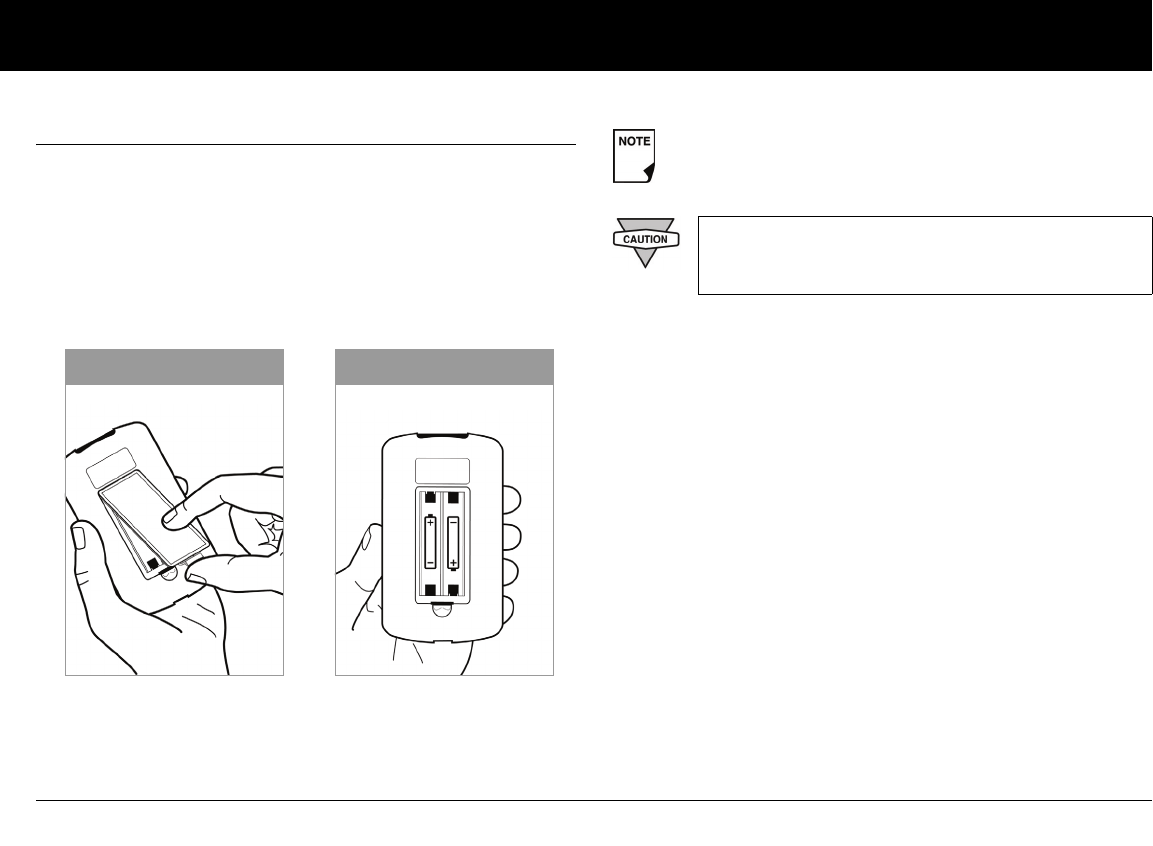
Getting Started
10
2
■ Set Up the Personal Diabetes Manager (PDM)
Chapter 6 describes the PDM options in detail. The instructions
in this chapter are simplified to help you get started.
Turn on the PDM
1. Open the battery compartment on the back of the PDM
by pushing the compartment latch and lifting upward
(Figure 2-1). No special tools are necessary.
2. Insert two (2) new AAA alkaline batteries into the compart-
ment.
3. Replace the battery door.
4. Turn the PDM face-up. The PDM has begun to power on
automatically.
Figure 2-1 Figure 2-2
The diagram inside the compartment shows you which
direction to insert the batteries (Figure 2-2).
Do not use any other type of batteries than AAA
alkaline batteries to power the PDM. Never use old
or used batteries; the PDM may not work properly.
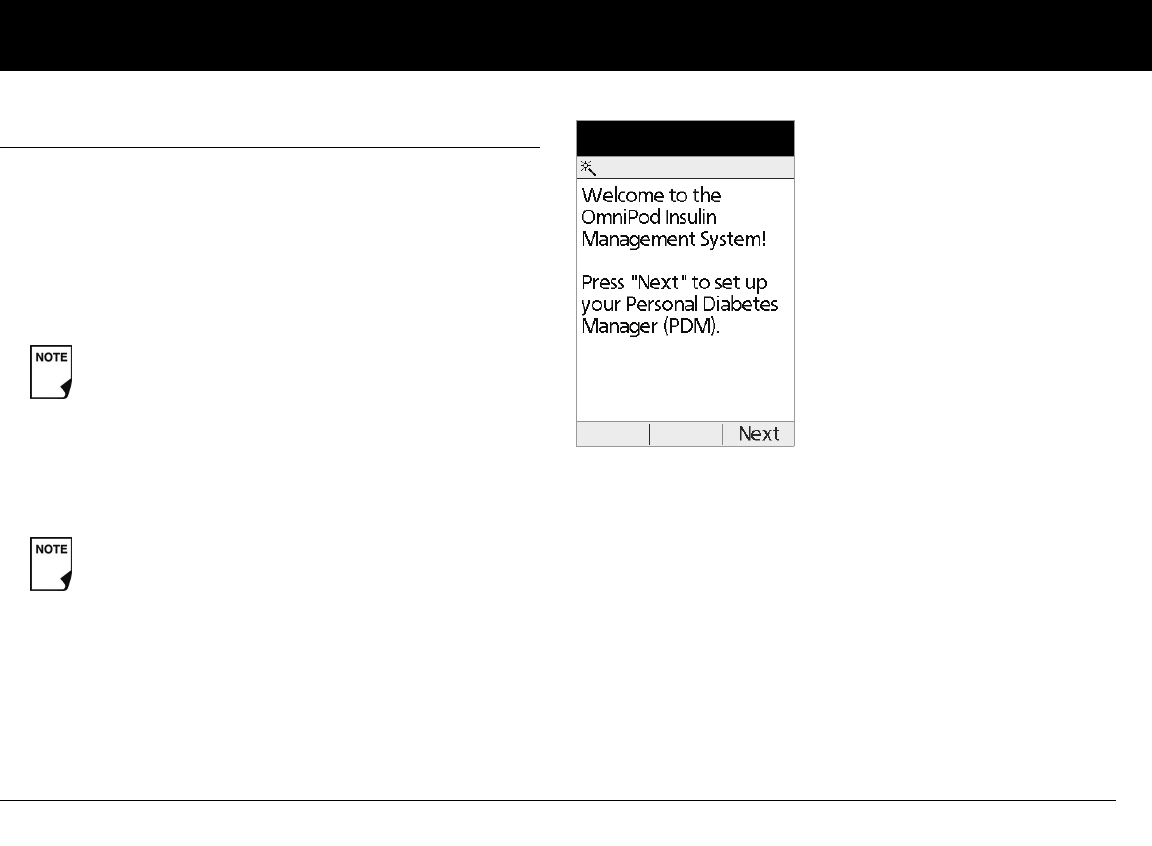
Getting Started
11
2
■ The OmniPod Setup Wizard
The first time you turn on the Personal Diabetes Manager, the
Setup Wizard comes on automatically. Although setup is easy
with the Wizard, if you are a first-time user, your healthcare pro-
vider must guide you through the process. Setup takes only a
few minutes and is easy to do:
• Use the Up/Down Controller buttons to increase or
decrease a number or to move up or down a list.
• Press the soft key labeled Next, Select, Done, or Save to con-
tinue to the next screen.
• Press Back to return to the previous screen.
The Wizard’s Welcome screen (Figure 2-3) gets you started. Press
Next to begin setting up your PDM.
Set date and time
1. Use the Up/Down Controller buttons to increase or
decrease the time. (If you prefer a 24-hour clock, press 12/
24hr.) Then press Next.
2. Enter the current year, then press Next.
3. Choose the current month, then press Next.
4. Enter the current day, then press Next.
5. Choose the date format you prefer, then press Next.
Initial settings are “---” [blank] for target blood glucose
value, insulin-to-carbohydrate ratio, correction factor,
and duration of insulin action.
You can adjust these settings later as your needs
change or you fine-tune your OmniPod System. See
“OmniPod System Options and Settings” in the
Appendices.
Figure 2-3
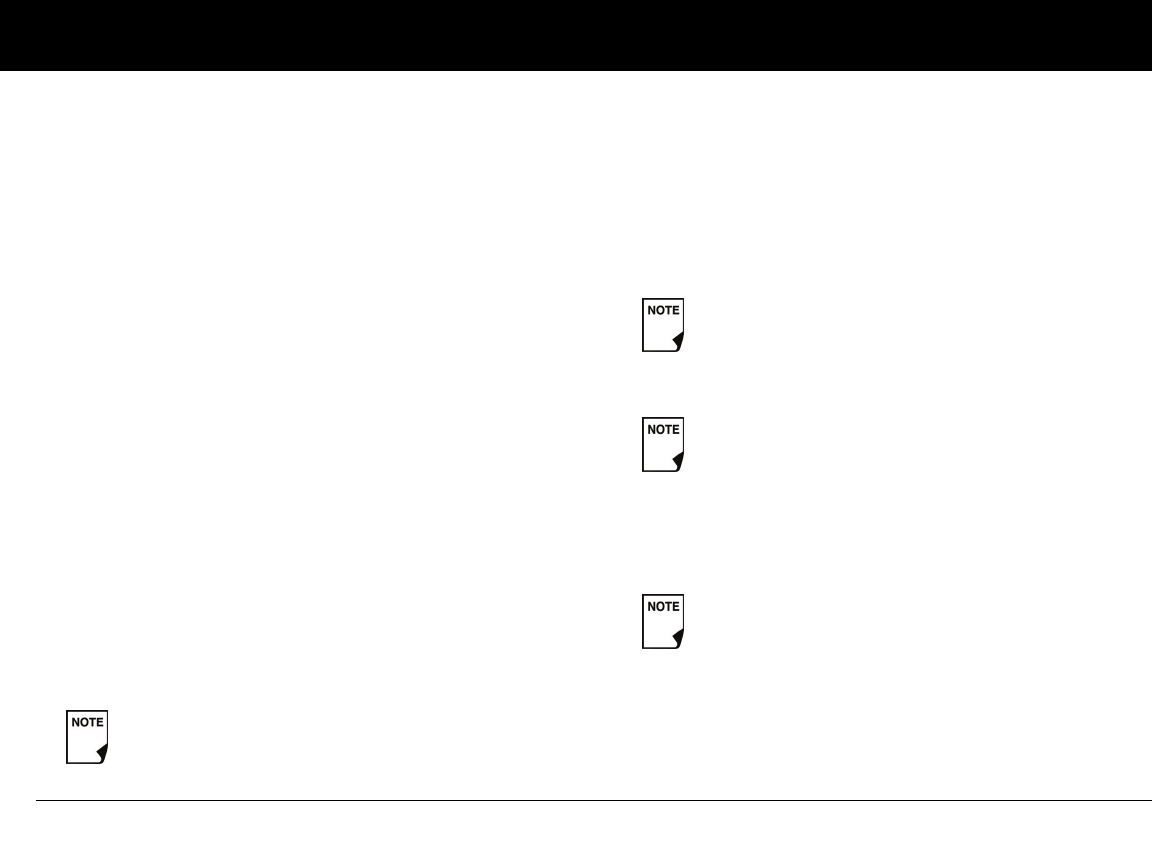
Getting Started
12
2
Enter basal settings
1. Choose a maximum basal rate, then press Next. (The default
maximum basal rate is 3 U/hr.)
2. Choose the initial basal rate to use, then press Next.
The initial basal program created with the Setup Wizard is
named basal 1. You can change the name in the Settings >
Basal programs menu (see Chapter 3, Understanding and
Adjusting Basal Rates).
3. Press Done to confirm the basal program shown on the
screen. To add more basal segments to the program, or to
change the rate shown, see Chapter 3, Understanding and
Adjusting Basal Rates.
4. To see the basal program as a list, press List. To return to the
graphic view, press Graph.
5. Press Save to accept the basal program you have set.
6. Choose a temporary basal feature, then press Next. Choose
% to show temporary basal rates as a percent increase or
decrease of your current basal rate. Choose U/hr to show
temporary basal rates in units per hour. Or choose Off to turn
off the temporary basal feature. For details about setting tem-
porary basals, see Chapter 3, Understanding and Adjusting
Basal Rates.
Enter blood glucose sound setting and BG goal
1. To set the sound for the blood glucose meter, choose On or
Off, then press Next.
2. Use the Up/Down Controller buttons to enter the lower
limit for your blood glucose (BG) goal, then press Next.
3. Enter the upper limit for your BG goal, then press Next.
4. Press Save to accept the BG goal.
Set the suggested bolus calculator
1. To set the suggested bolus calculator feature, choose On or
Off, then press Next.
You can add up to 7 basal programs and set 24
segments per program
The lower and upper BG limits are only used when
viewing BG History (see Chapter 8, Record Keeping).
Check with your healthcare provider before adjusting
these settings.
If the suggested bolus calculator is set to On, perform
the following steps. If set to Off, you will be prompted
to “Select bolus increment” and “Enter maximum
bolus.”

Getting Started
13
2
Enter target blood glucose value
1. Use the Up/Down Controller buttons to enter a target blood
glucose (BG) value, then press Next.
2. Use the Up/Down Controller buttons to enter the “correct
above” value or correction threshold (the BG value above
which you want the PDM to suggest a correction bolus), then
press Next.
3. To save the target BG value, press Done. To change these set-
tings, select the segment you wish to change and press Edit.
You can define up to 4 target BG time segments. To enter
additional segments, choose [add new], then:
a. Press New.
b. Enter a start time for the target BG segment, then press
Enter.
c. Enter an end time for the target BG segment, then press
Next.
d. Enter a target blood glucose value, then press Next.
e. Use the Up/Down Controller buttons to enter the “cor-
rect above” value or correction threshold (the BG value
above which you want the PDM to suggest a correction
bolus), then press Next.
f. When you have finished entering segments, press Done.
4. To see the segments as a list, press List. To return to the
graphic view, press Graph.
5. Press Save to accept the target BG profile you have set.
Enter minimum BG allowed for use in bolus calculation
1. Use the Up/Down Controller buttons to enter a minimum
blood glucose value, below which the System will not calcu-
late a suggested bolus. The values are in 1 mg/dL increments
and range from 50 to 70 mg/dL.
2. Press Next.
Enter insulin-to-carbohydrate ratio
1. Use the Up/Down Controller buttons to enter your insulin-
to-carbohydrate ratio, then press Next. (Insulin-to-carbohy-
drate ratio is the number of carbs covered by 1 unit of insulin.)
If the suggested bolus calculator is On, a correction
bolus will be suggested only when your BG is above
the value shown in brackets on the screen.
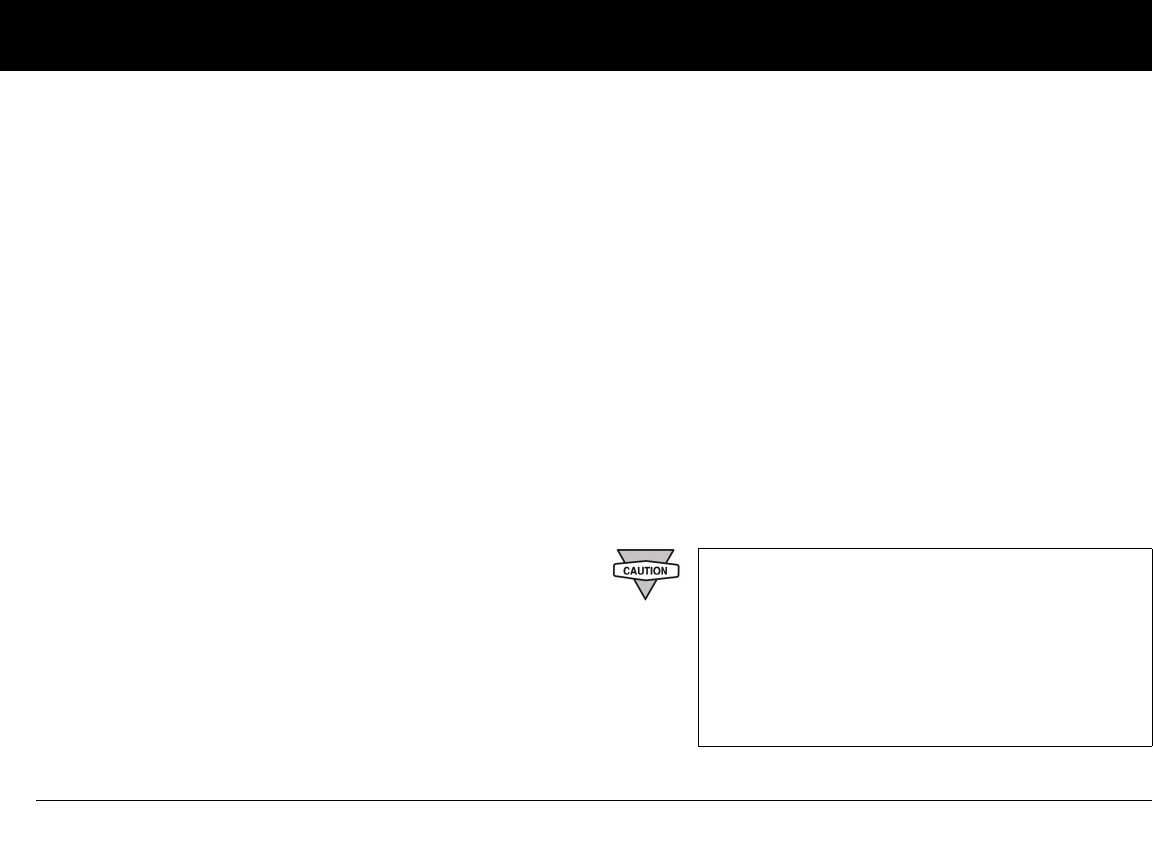
Getting Started
14
2
2. To save the ratio, press Done. To change the ratio, select the
segment you wish to change and press Edit.
You can define up to 4 insulin-to-carbohydrate time seg-
ments. To enter additional ratios, choose [add new], then:
a. Press New.
b. Enter a start time for the segment, then press Next.
c. Enter an end time for the segment, then press Next.
d. Enter the insulin-to-carb ratio for the new time segment,
then press Next.
e. To save the new ratio, press Done.
3. To see the ratios as a list, press List. To return to the graphic
view, press Graph.
4. Press Save to accept the ratios you have set.
Enter correction factor
1. Use the Up/Down Controller buttons to enter how much
one unit of insulin decreases your blood glucose, then press
Next.
2. To save the correction factor, press Done. To change the
factor, select the segment you wish to change and press Edit.
You can define correction factors for up to 4 time segments.
To enter additional correction factors, choose [add new],
then:
a. Press New.
b. Enter a start time for the segment, then press Next.
c. Enter an end time for the segment, then press Next.
d. Enter the correction factor, then press Next.
e. To save the new correction factor segment, press Done.
3. To see the factors as a list, press List. To return to the graphic
view, press Graph.
4. Press Save to accept the correction factors you have set.
Set reverse correction
1. To set reverse correction, use the Up/Down Controller
buttons to choose On or Off, then press Next.
If you enter carbs and reverse corrections are On, the
System will subtract insulin from the suggested meal
bolus to compensate for a low blood glucose (below
the BG target you set). With reverse correction Off,
the System will not subtract insulin from the sug-
gested meal bolus dose due to a low BG. Follow your
healthcare provider’s recommendation to set
reverse correction On or Off.
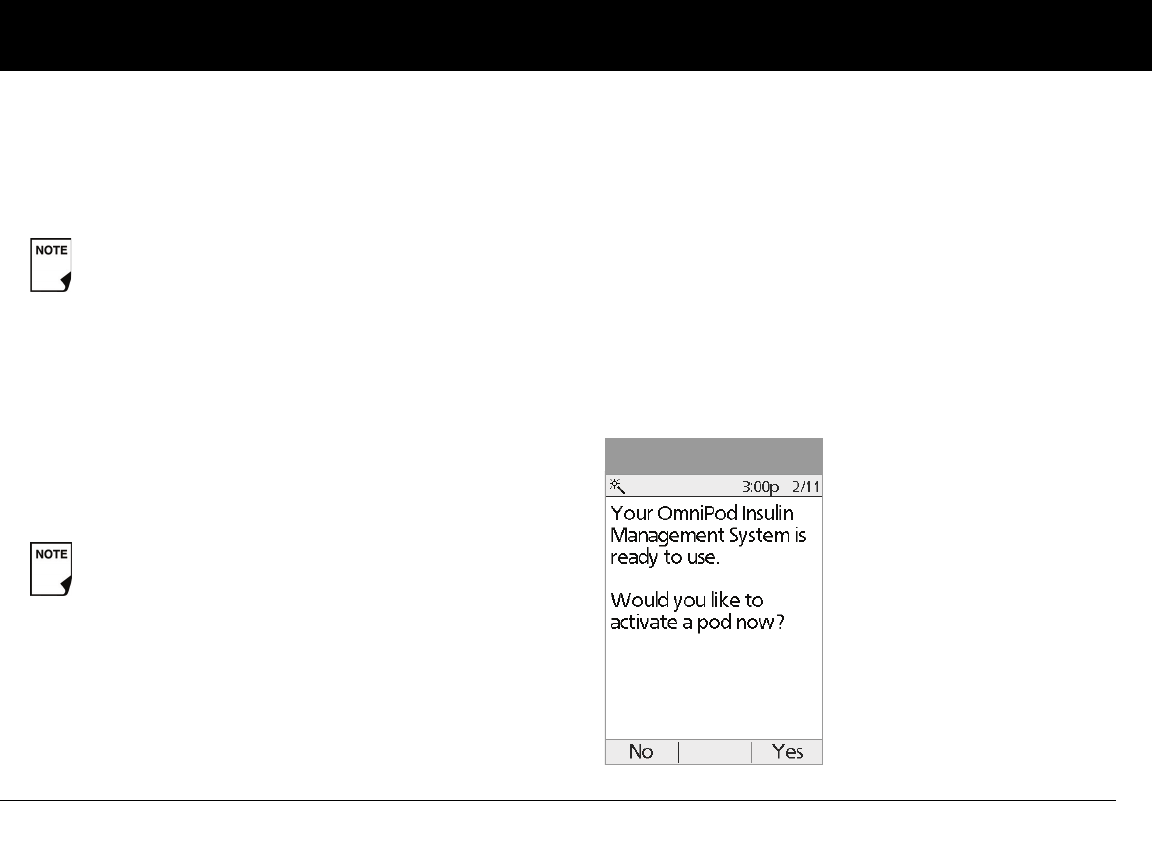
Getting Started
15
2
Enter the duration of insulin action
1. Use the Up/Down Controller buttons to enter the duration
of insulin action (how long insulin lasts in your body), then
press Next.
Select bolus increment and enter maximum bolus
1. Choose a bolus increment (how much each press of the
Up/Down Controller buttons will increase or decrease a
bolus amount)—either 0.05, 0.10, 0.50, or 1.00 units of insu-
lin—then press Next.
2. Choose the maximum bolus you can give at one time, then
press Next.
Set extended bolus doses
1. To set the units for an extended bolus dose, choose % for per-
cent of the total bolus, or choose Units for units of insulin. To
turn off the extended bolus feature, choose Off. Then press
Next.
Set low reservoir alert
1. Choose the level of insulin in the reservoir at which the
PDM should give you an alarm. Choose from 10 to 50 units
in 5-unit increments, then press Next.
Set expiration alert
1. Choose the number of hours before a Pod expires when the
PDM should give you an alert, then press Next. The values are
in 1-hour increments and range from 1 to 24 hours. (The
default is 4 hours.)
The PDM now asks whether you want to activate a Pod
(Figure 2-4).
The duration-of-insulin-action setting is used to
calculate the amount of insulin on board (IOB) from a
previous correction bolus or meal bolus, when you
use the suggested bolus calculator.
The maximum bolus default is 10 units. Check with
your healthcare provider before adjusting these
settings.
Figure 2-4
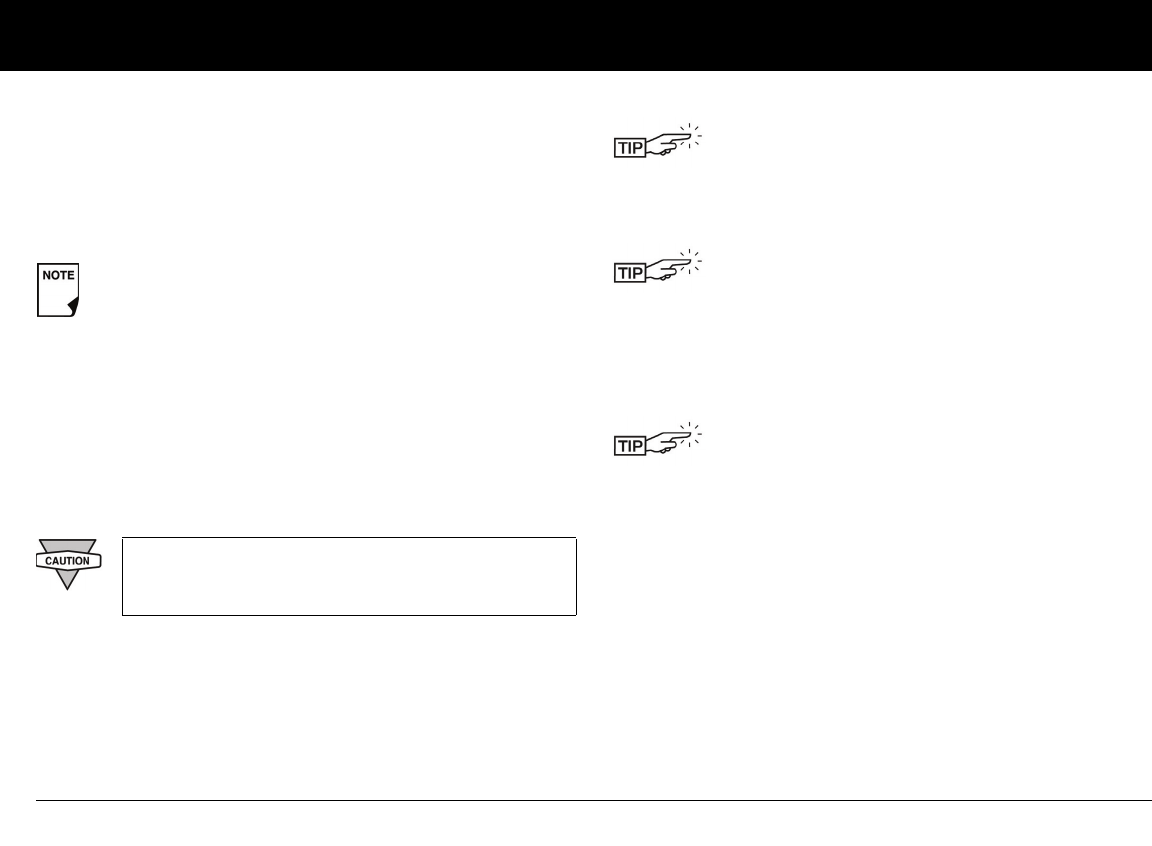
Getting Started
16
2
• Press Ye s if you are ready to activate a new OmniPod. See
Chapter 5, Using the OmniPod, to learn how to activate a
new Pod.
• Press No if you do not want to activate a Pod at this time.
The PDM displays the Home screen.
Your healthcare provider will help you fill and apply your first
OmniPod. The process is easy because on-screen messages walk
you through every step. Please refer to Chapter 5, Using the
OmniPod, for detailed instructions.
You can press and hold the Power button to turn off the
PDM at any time during setup. Otherwise, it turns off
automatically after 5 minutes. If you do not complete the
entire setup within 60 minutes, when you turn on the
PDM again you will return to the beginning of the Setup
Wizard.
If you ever need to return the PDM for repair or
replacement, contact your healthcare provider for
instructions on going back to treatment by injections.
You may want to adjust the PDM screen time-out
and backlight time-out. For more information on
how to do this, see Chapter 6, Using the Personal
Diabetes Manager.
Use the form at the end of this User Guide to write
down all your settings from the Setup Wizard. You
can also attach a copy of the CSII orders that you
used during your training session. If you ever need
to reset your PDM, having these settings handy will
make setup very easy.
Resources for OmniPod users are available from the
Customer Support tab on our Web site:
MyOmniPod.com/support/resources
Among these resources are an online copy of this
User Guide and the My OmniPod System Information
form, which you will also find at the end of this
guide.
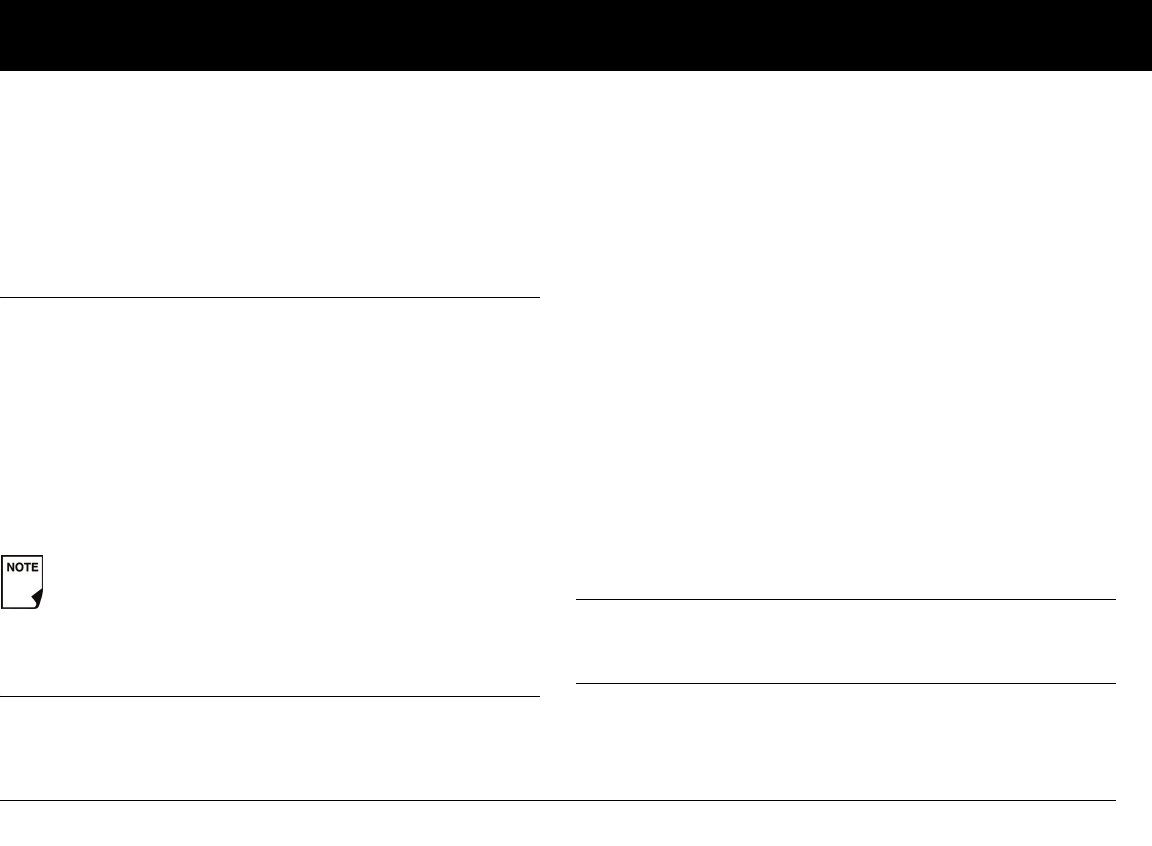
17
CHAPTER 3
Understanding and Adjusting Basal Rates
■ What Is a Basal Rate?
A basal rate is a small base or background amount of insulin that
is delivered, at a preset rate, continuously for a specified period of
time.
Even without eating, our bodies need a small, constant supply of
insulin for normal daily living. In people without diabetes, the
pancreas continuously delivers this basal insulin. For people
using the OmniPod Insulin Management System, the OmniPod
mimics a healthy pancreas by delivering insulin at the rate that
you’ve programmed into the Personal Diabetes Manager (PDM).
■ Personalized Basal Programs
Insulin needs vary throughout the day. Therefore, most people
set their basal rates to deliver slightly more or less insulin at
certain times. For example, one person may need to deliver a
higher rate of insulin during the early morning and a lower rate
during the late evening. A basal program describes the amount
of insulin to be delivered during an entire 24-hour period.
A basal program contains at least one basal rate for the 24-hour
period, but for most people it will be broken into several time
segments, or basal segments, each delivering a different rate of
insulin. A sample basal program with three basal segments
might be:
Approximately 50% of a person’s total daily insulin dose
typically comes from basal insulin delivery; the remain-
ing 50% typically comes from bolus doses (see Chapter 4,
Understanding and Delivering Bolus Doses).
12:00 am–8:00 am 0.60U/hr Between 12:00 am (midnight)
and 8:00 am, the Pod delivers
0.60 units of insulin per hour.
8:00 am–3:00 pm 0.80U/hr Between 8:00 am and 3:00 pm,
the Pod delivers 0.80 units of
insulin per hour.
3:00 pm–12:00 am 0.70U/hr Between 3:00 pm and 12:00 am
(midnight), the Pod delivers 0.70
units of insulin per hour.
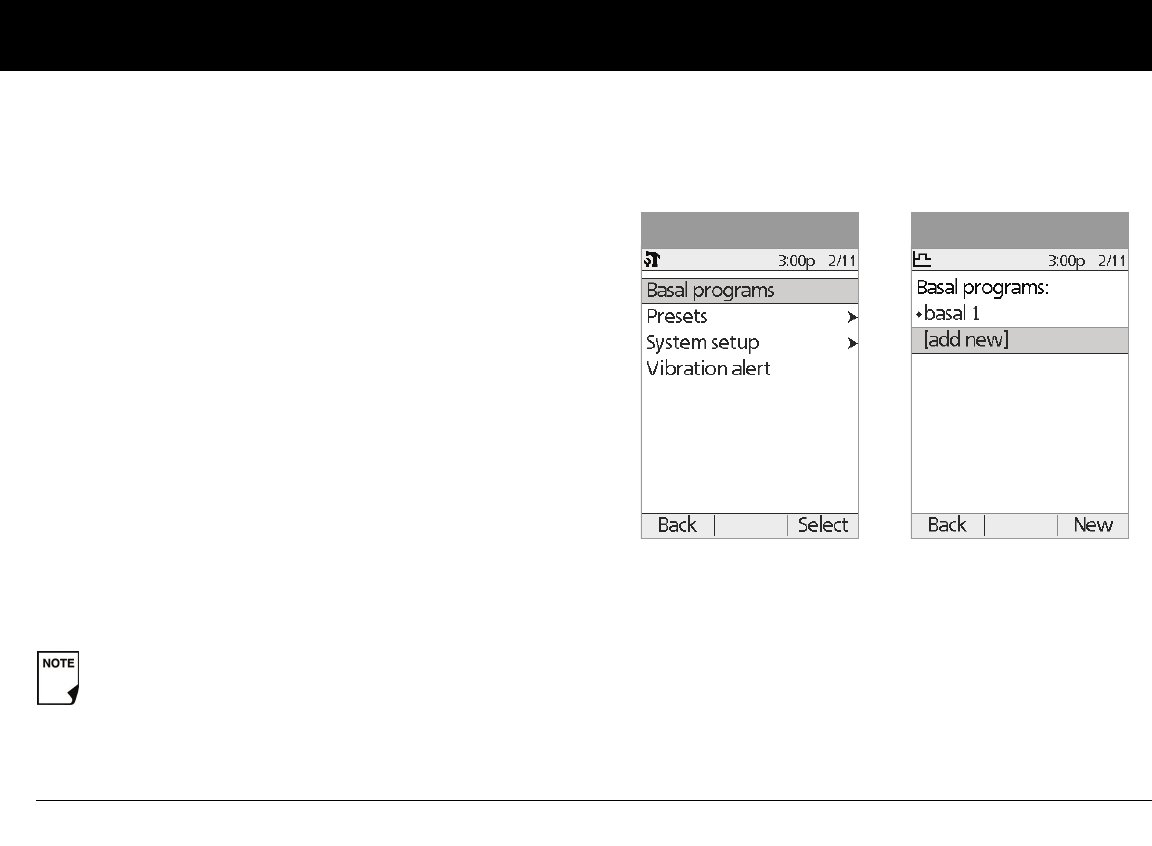
Understanding and Adjusting Basal Rates
18
3
In addition to normal daily changes, insulin needs can vary with
different routines or days of the week. For example, regular
school or workday routines may differ from weekend routines,
and insulin needs may differ, too. With your healthcare provider,
you will decide on the basal rates that best match your lifestyle
and insulin needs. You will enter at least one basal program (your
Basal 1 program) into your PDM during the setup process (see
Chapter 2, Getting Started). You can add other programs later as
you fine-tune your System settings or when your needs change.
You can also create temporary basal presets to use on occasions
when you need to adjust your basal rate for a short period of
time. See “Temporary Basal Rates and Presets” later in this
chapter.
Create a basal program
The Personal Diabetes Manager can store up to 7 different basal
programs. Each program can contain 24 rates, programmed in
half-hour increments. Once you enter a basal program into the
PDM, you only need to press a few buttons to pick the program
you want. The OmniPod continues to deliver insulin at those
rates until you change that program or switch to another one.
1. On the Home screen, use the Up/Down Controller buttons
to choose Settings; then press Select.
2. Choose Basal programs (Figure 3-1), then press Select.
3. Choose [add new] (Figure 3-2), then press New.
4. To use the default naming system, simply press Next. The
default naming system automatically assigns program
names in numerical order, such as basal 1, basal 2, basal 3.
If you want to give a different name to the program:
a. Press the Up/Down Controller buttons to scroll through
the list of characters. An up-and-down-arrow symbol on
the screen indicates the character you are changing.
Check with your healthcare provider before adjusting
these settings.
Figure 3-1 Figure 3-2
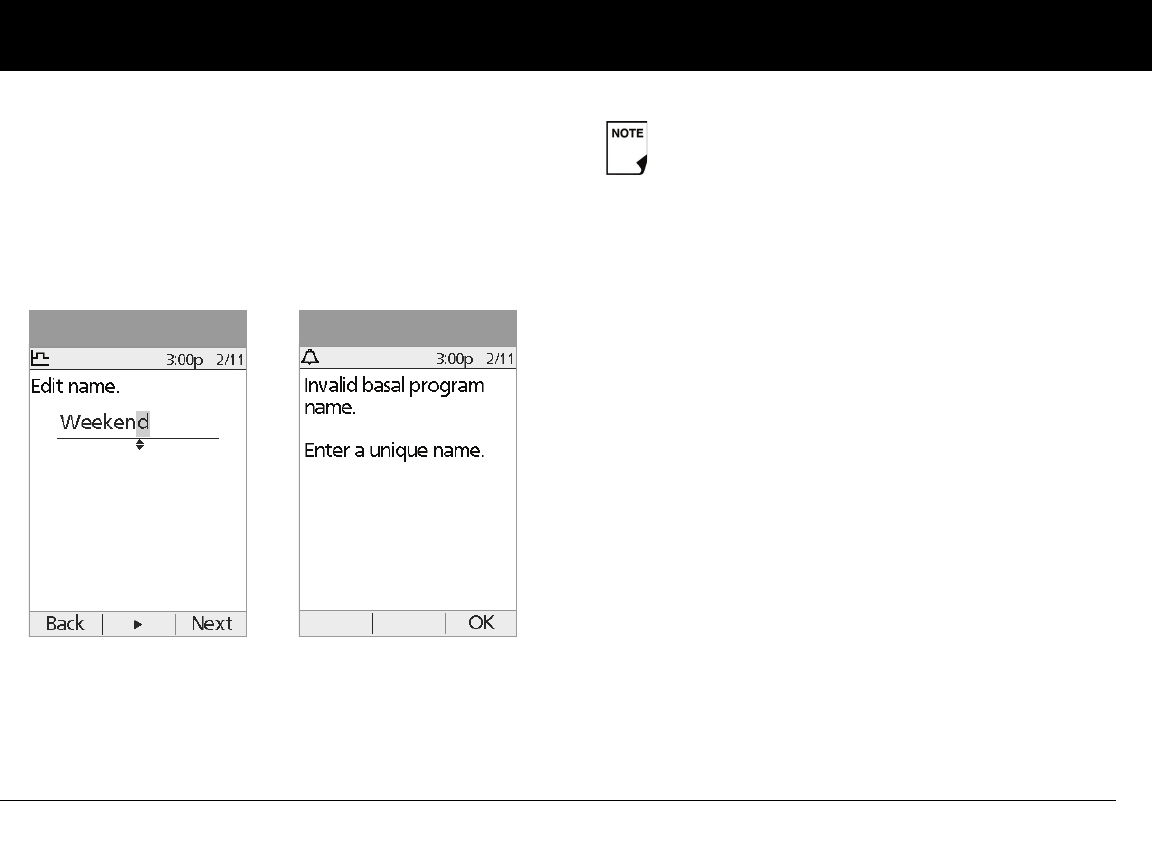
Understanding and Adjusting Basal Rates
19
3
b. Press the middle soft key (labeled with the right arrow) to
move the underscore to the next character.
c. Enter each character one at a time. For example, if your
weekend schedule is different from your weekday sched-
ule, you might enter W, e, e, k, e, n, d (Figure 3-3). (A blank
character or space is the first and last option in the scroll-
ing menu.)
d. Press Next.
5. Enter the rate, in U/hr, for the first basal segment (from 0.05 to
the maximum you entered during setup), then press Next.
6. Review the list showing your new basal program.
To use the same basal rate for the entire 24-hour program,
press Done and continue with step 7.
Or, to add basal segments and rates (for example, a higher
basal rate between 8:00 am and 3:00 pm):
a. Choose an existing basal segment, then press Edit.
Or, choose [add new], then press New.
b. Enter the start time (for example, 8:00 am), then press
Next. Basal segments are in 30-minute increments.
c. Enter the end time (for example, 3:00 pm), then press
Next.
d. Enter the rate for the new basal segment (for example,
0.80U/hr), then press Next.
Figure 3-3 Figure 3-4
As a safety feature, the words “Invalid basal program
name” (Figure 3-4) appear if the name you entered
does not have at least one character or if the name is
being used for another basal program. Capitals and
lowercase letters are considered the same. Press OK
to return to the previous screen and enter a different
name.
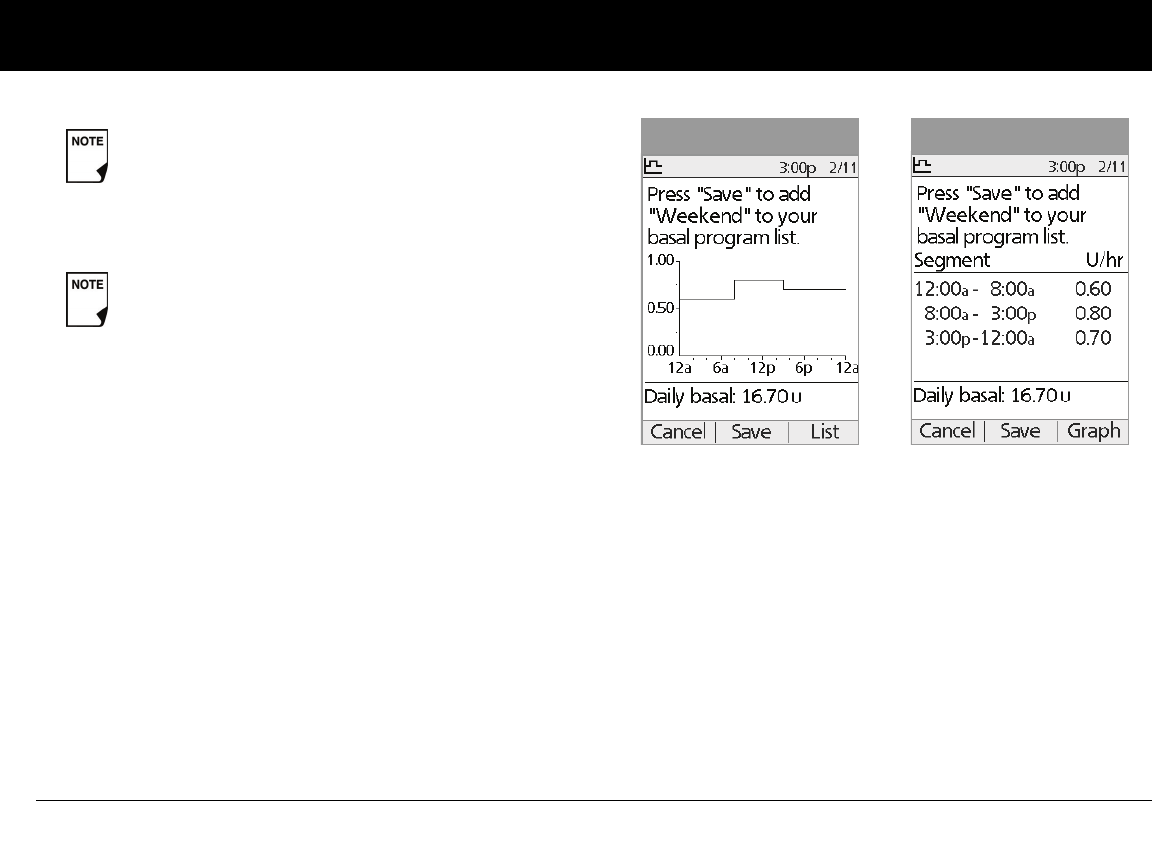
Understanding and Adjusting Basal Rates
20
3
e. Repeat steps a–d for each new segment and rate you
want, then press Done.
7. Review the graph of the new basal program (Figure 3-5).
8. To see the program as a list, press List (Figure 3-6). To see the
graph again, press Graph.
The total daily basal that will be delivered is shown at the
bottom of each “Basal programs” graph and list.
9. To add the program to the PDM’s memory, press Save.
Repeat steps 1 through 9 above for each basal program (up to 7)
you want to create.
Enable an existing basal program
1. On the Home screen, use the Up/Down Controller buttons
to choose Settings; then press Select.
2. Choose Basal programs, then press Select.
Basal rates outside the changed segment do not
change.
Press and hold the Power button to turn the screen
back on. In some cases, if it has been less than 5
minutes since the screen timed out, pressing the
Power button returns you to the same screen you
were using. If it has been longer than 5 minutes, the
PDM brings you to the Status screen.
Figure 3-5 Figure 3-6
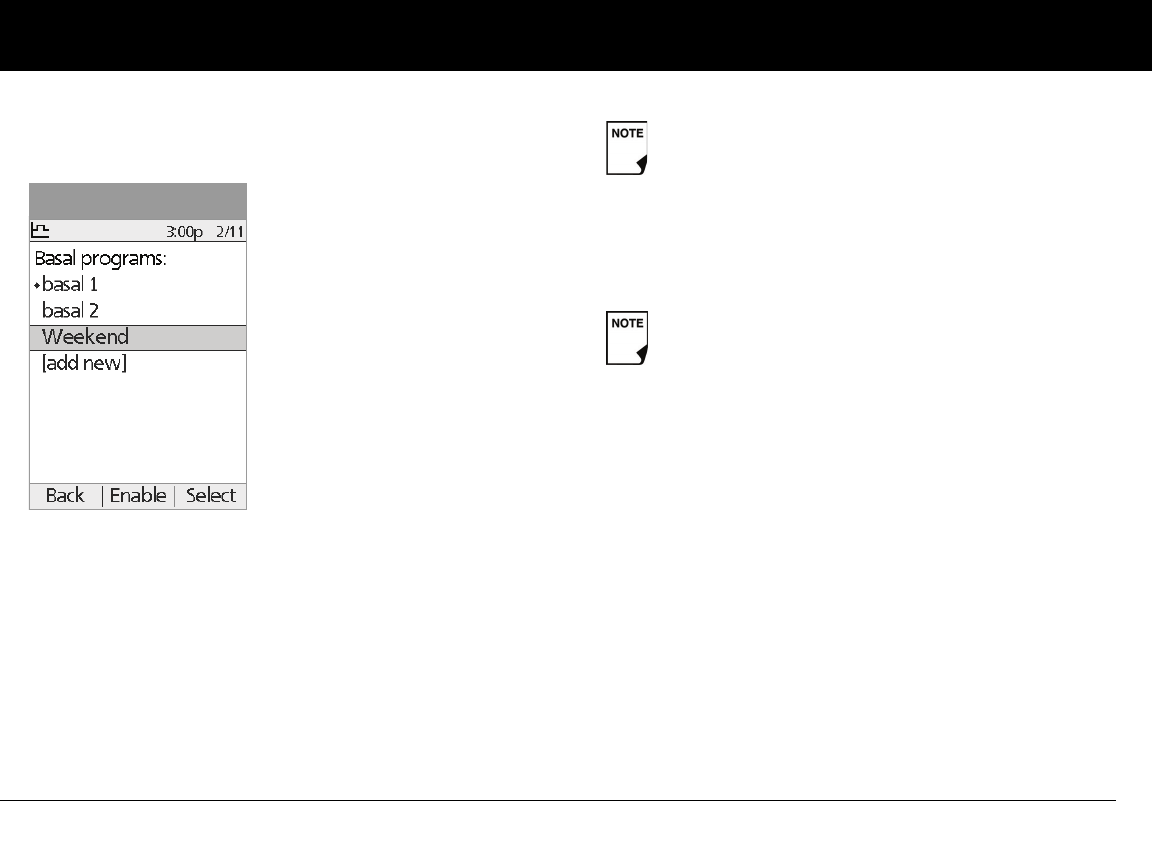
Understanding and Adjusting Basal Rates
21
3
3. Choose the program you want from the list (Figure 3-7), then
press Enable.
4. Press Enable again to start the selected basal program. If a
Pod is active, the PDM beeps to indicate that the chosen
basal program is running.
Change, rename, copy, or delete a basal program
1. On the Home screen, use the Up/Down Controller buttons
to choose Settings; then press Select.
2. Choose Basal programs, then press Select.
3. Choose a program from the list, then press Select.
To view the segments of the basal program
1. Choose View, then press Select (Figure 3-8).
Figure 3-7
A diamond icon (♦) appears next to the program that
is active. You cannot select the active program to
enable it, because it is already running.
As a safety feature, you cannot enable a new basal
program while a temporary basal preset is in process
(see “Temporary Basal Rates and Presets” later in this
chapter); you must first cancel the active temporary
basal preset.
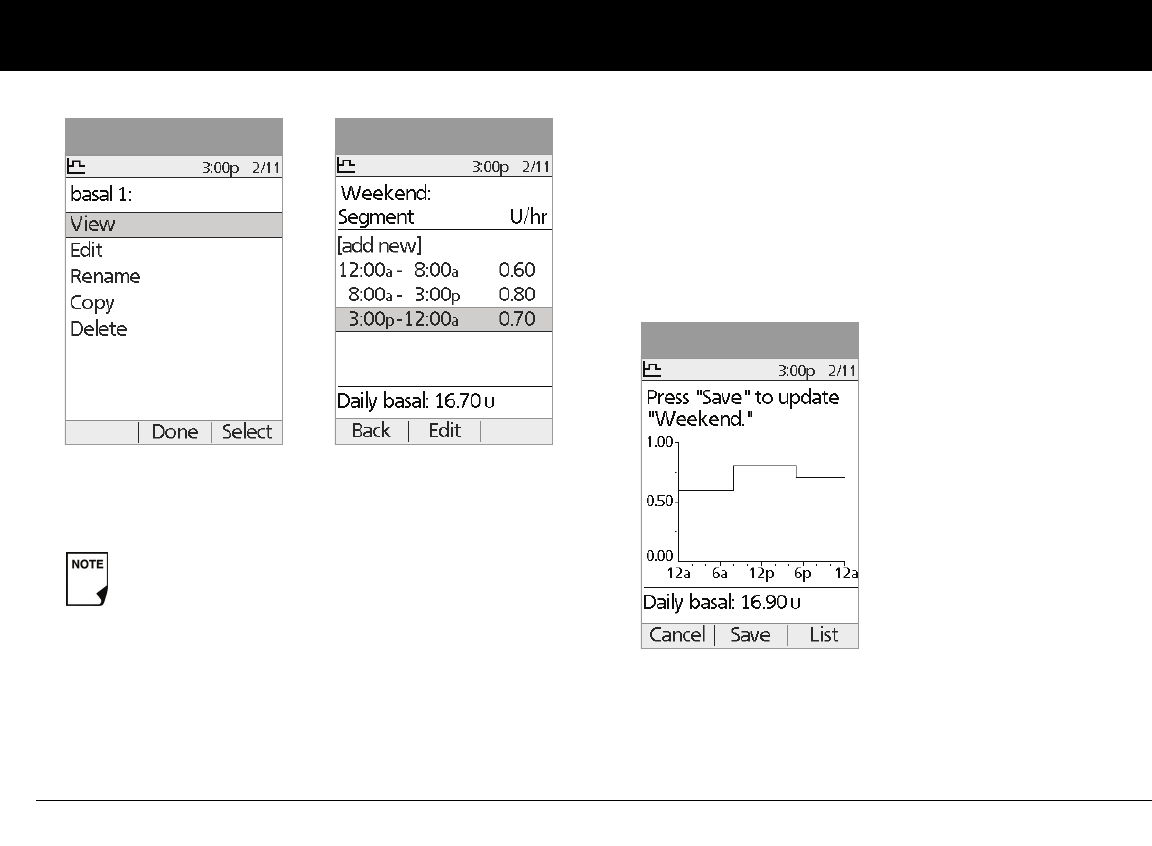
Understanding and Adjusting Basal Rates
22
3
To edit or add a segment or rate in the basal program
1. Choose Edit, then press Select.
2. Choose the segment to change, then press Edit (Figure 3-9).
Or, choose [add new], then press New.
3. Enter a start time for the segment you want to change, then
press Next.
4. Enter an end time for this segment, then press Next.
5. Enter a basal rate for the new segment, then press Enter.
6. To save the newly entered segment into the basal program,
press Save (Figure 3-10). If you want to make additional edits,
repeat steps 2–5.
7. To see the program as a list, press List. To see the graph again,
press Graph.
As a safety feature, you must suspend insulin delivery
before editing an active basal program (see Chapter
5, Using the OmniPod.) Remember to resume deliv-
ery after the edits are made.
Figure 3-8 Figure 3-9
Figure 3-10
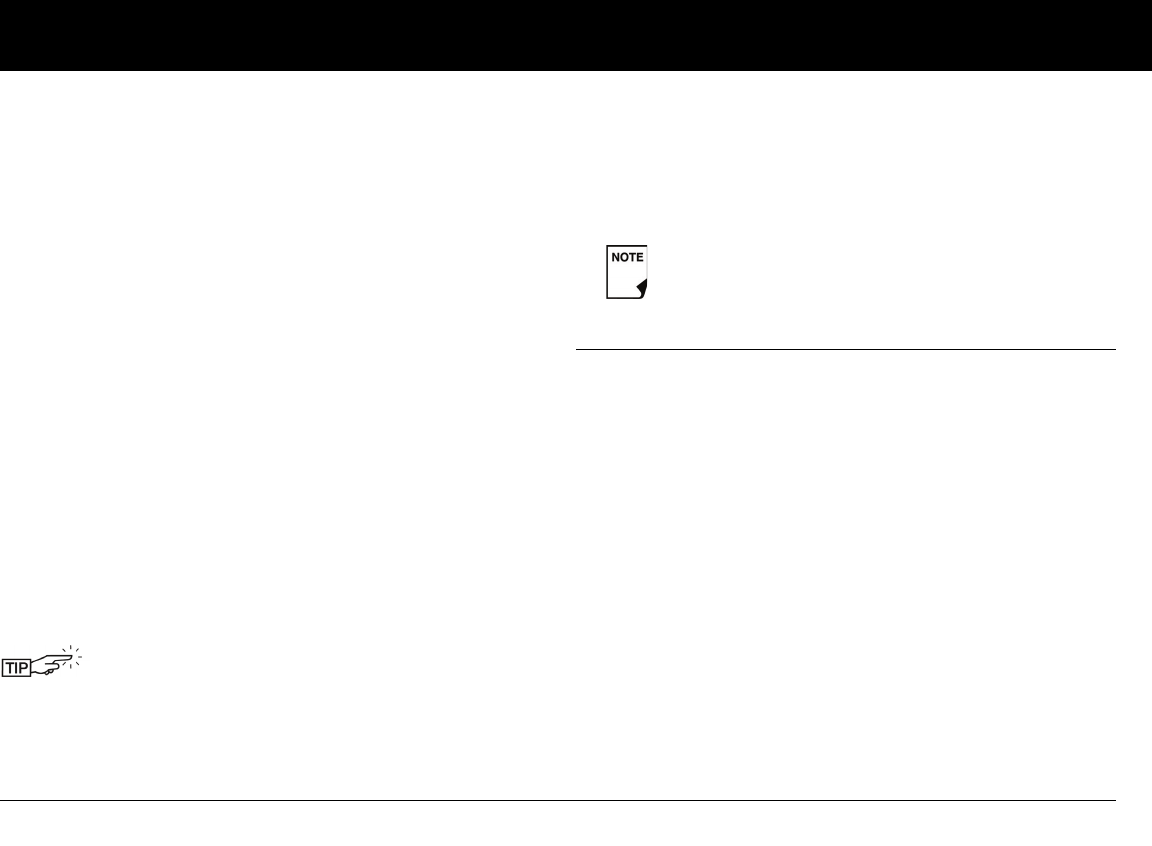
Understanding and Adjusting Basal Rates
23
3
To rename a basal program
1. After choosing a program from the list, choose Rename, then
press Select.
2. Press the Up/Down Controller buttons to enter the charac-
ters that spell out the new name you want. Press the middle
soft key (labeled with the right arrow) to move the under-
score to the next character, then press Save.
To copy a basal program
1. After choosing a program from the list, choose Copy, then
press Select.
2. Press the Up/Down Controller buttons to enter the charac-
ters that spell out the name you want for the copied file. Press
the middle soft key (labeled with the right arrow) to move the
underscore to the next character, then press Next.
3. To use the same basal program for the entire 24-hour period,
press Save.
To edit or add segments to the newly copied basal program, fol-
low the steps under “To edit or add a segment or rate in the basal
program” earlier in this chapter.
To delete a basal program
1. After choosing a program from the list, choose Delete and
then press Select.
2. Press Delete to permanently delete the program.
■ Temporary Basal Rates and Presets
What is a temporary basal rate?
A temporary basal rate lets you adjust your basal rate for a pre-
determined period of time.
On occasion, you may need to change the active basal rate for
only a short time. For example, if you are going cross-country
skiing for several hours, you may want to lower the basal rate
during and after you exercise. This is called a “one-time tempo-
rary basal rate.”
Some temporary changes are easy to predict and respond to.
They happen routinely and you may know from experience how
they affect your insulin needs. For example, you might take the
same exercise class twice a week for a few weeks or months, or
Instead of suspending, changing, and then resuming
the active basal program, try this: Copy the active
program, rename it, make the changes, save it, then
enable it.
As a safety feature, you cannot delete the active basal
program.
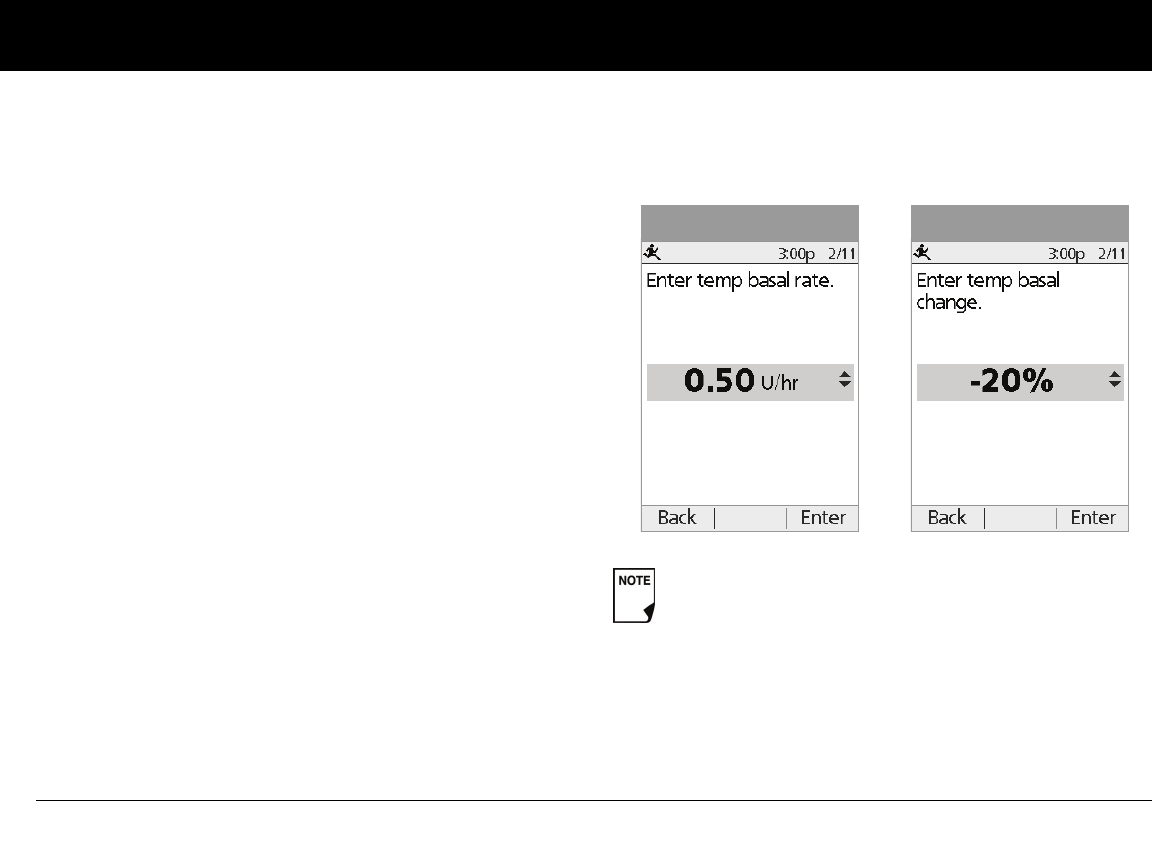
Understanding and Adjusting Basal Rates
24
3
join a summer soccer league. For women, a monthly hormonal
change that affects blood glucose is an example of predictable
change. To easily handle predictable, short-term changes, you
can “preset” a temporary basal rate, so it is ready whenever you
need it. The PDM can remember up to 7 temporary basal presets.
You can set a temporary basal rate for a duration of 30 minutes to
12 hours. Once the time limit is reached, the PDM returns to the
active basal program.
When using units per hour, the OmniPod System allows you to
set temporary basal rates from 0.0 U/hr, up to your max basal
rate. When using percent rate, you can set temporary basal rates
from -100% to +95% of your active rate, as long as the temporary
rate is less than or equal to your max basal rate.
See the sections below on creating, enabling, canceling, and
changing temporary basal presets.
Enable a one-time temporary basal rate
1. On the Home screen, use the Up/Down Controller buttons
to choose Temp basal; then press Select.
2. If you have created temp basal presets, choose [enter manu-
ally] from the list, then press Select.
If you have not created any temp basal presets, the PDM skips
this step.
3. Enter the temporary basal rate in either units per hour (Figure
3-11) or percent change (Figure 3-12), depending on how
you chose to show the rates; then press Enter.
4. Enter the duration for the temporary rate, then press Enter.
5. Press Confirm to start the temporary basal rate shown on the
screen. The Pod beeps to indicate that the temporary basal
rate is running.
During initial setup, you and your healthcare provider
either turned Off temporary basal rates or chose to
show the rates as % or U/hr. To change this setting, see
Chapter 6, Using the Personal Diabetes Manager.
Figure 3-11 Figure 3-12
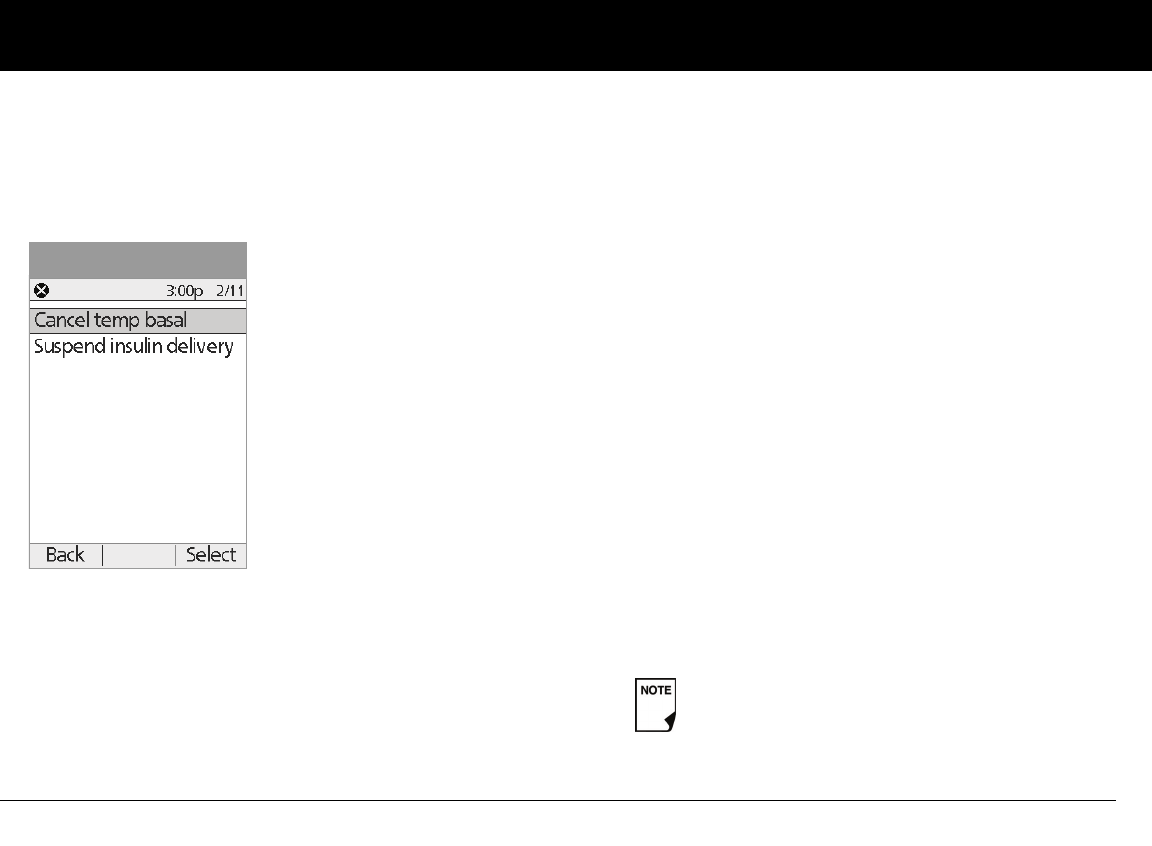
Understanding and Adjusting Basal Rates
25
3
Cancel a one-time temporary basal rate
1. On the Home screen, use the Up/Down Controller buttons
to choose Suspend/cancel; then press Select.
2. Choose Cancel temp basal (Figure 3-13), then press Select.
3. Press Confirm to cancel the temporary basal shown on the
screen.
Create a temporary basal preset
1. On the Home screen, use the Up/Down Controller buttons
to choose Settings; then press Select.
2. Choose Presets, then press Select.
3. Choose Temp basal presets, then press Select.
4. Choose [add new], then press New.
5. To use the OmniPod System’s default naming system, simply
press Next. The default naming system automatically assigns
program names in numerical order, such as temp basal 1,
temp basal 2, temp basal 3.
Or, to give a different name to the program:
a. Press the Up/Down Controller buttons to scroll through
the list of characters. An up-and-down-arrow symbol on
the screen indicates the character you are changing.
b. Press the middle soft key to move the underscore to the
next character.
c. Enter each character one at a time. For example, if you
take an aerobics class two nights a week, you might enter
A, e, r, o, b, i, c, s (Figure 3-14). (A blank character or space is
the first and last option in the scrolling menu.)
Figure 3-13
Capitals and lowercase letters are considered the
same.
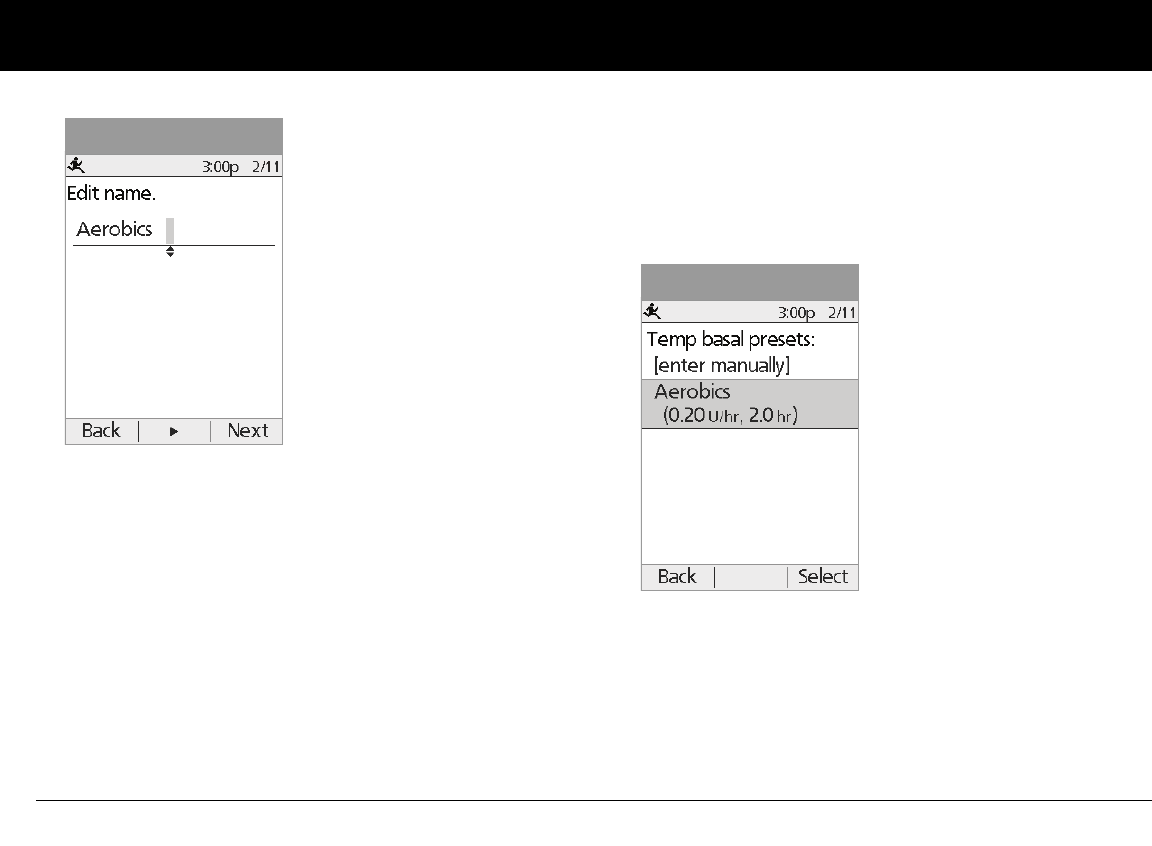
Understanding and Adjusting Basal Rates
26
3
d. Press Next.
6. Enter the new temporary basal rate (or percent change), then
press Next.
7. Enter the duration of the temporary basal rate, from 0.5 hours
to 12 hours, then press Next.
8. Review the temporary basal name, rate, and duration, then
press Save to accept it.
Enable an existing temporary basal preset
1. On the Home screen, use the Up/Down Controller buttons
to choose Temp basal; then press Select.
2. Choose the temporary basal preset you want to use from the
list (Figure 3-15), then press Select.
3. If you want, change the duration for the temporary rate, in
half-hour increments, then press Enter.
4. Press Confirm to begin the temporary basal rate shown on
the screen. The Pod beeps to indicate that the chosen tempo-
rary basal preset is running.
Figure 3-14
Figure 3-15
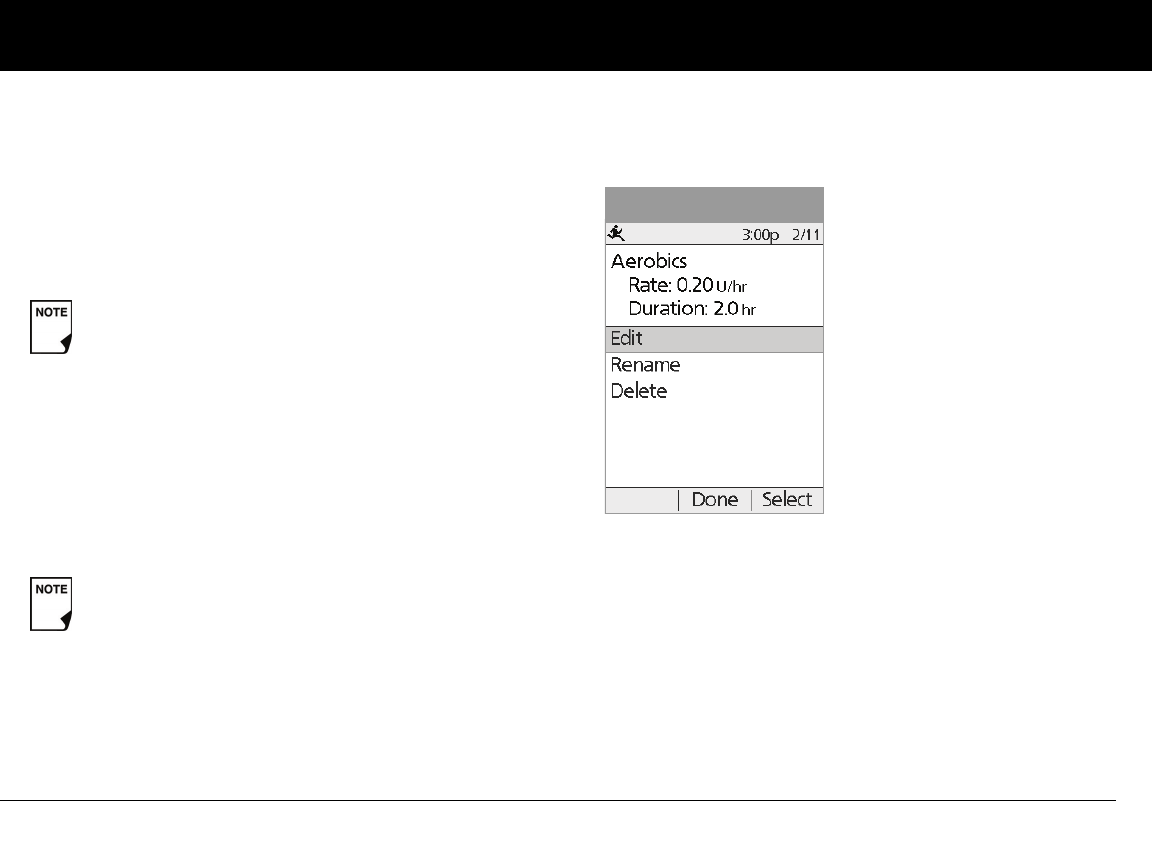
Understanding and Adjusting Basal Rates
27
3
Cancel an active temporary basal preset
1. On the Home screen, use the Up/Down Controller buttons
to choose Suspend/cancel; then press Select.
2. Choose Cancel temp basal, then press Select.
3. Press Confirm to cancel the actively running temporary basal
preset.
Change, rename, or delete a temporary basal preset
1. On the Home screen, use the Up/Down Controller buttons
to choose Settings; then press Select.
2. Choose Presets, then press Select.
3. Choose Temp basal presets, then press Select.
4. Choose a temporary preset from the list, then press Edit.
5. Follow the steps below.
To change a temporary basal preset
1. Choose Edit, then press Select (Figure 3-16).
2. Enter a new rate (or new percent change), for the preset, then
press Next.
3. Enter a new duration for the preset, then press Save.
4. Press Done.
If you suspend insulin delivery while a temp basal is
running, the temp basal will be cancelled when you
resume.
You cannot edit, change, or delete a temporary basal
preset that is actively running.
Figure 3-16

Understanding and Adjusting Basal Rates
28
3
To rename a temporary basal preset
1. Choose Rename, then press Select.
2. Press the Up/Down Controller buttons to enter the charac-
ters that spell out the name you want; then press Save.
3. Press Done.
To delete a temporary basal preset
1. Choose Delete, then press Select.
2. Press Delete to permanently delete the preset.
■ Maximum Basal Rate
What is the maximum basal rate?
The maximum basal rate is a safety feature that limits the basal
rate (U/hr) that the OmniPod can deliver. Once you enter it into
the PDM memory, the maximum applies to both regular basal
programs and temporary basal rates.
You and your healthcare provider will enter an initial maximum
basal rate into your PDM during the setup process (see Chapter
2, Getting Started). You can change it later as you fine-tune your
System settings or when your needs change.
Change the maximum basal rate
1. On the Home screen, use the Up/Down Controller buttons
to choose Settings; then press Select.
2. Choose System setup, then press Select.
3. Choose Bolus/basal/calcs, then press Select.
4. Choose Max basal, then press Select.
5. Enter a new maximum basal rate, then press Enter.
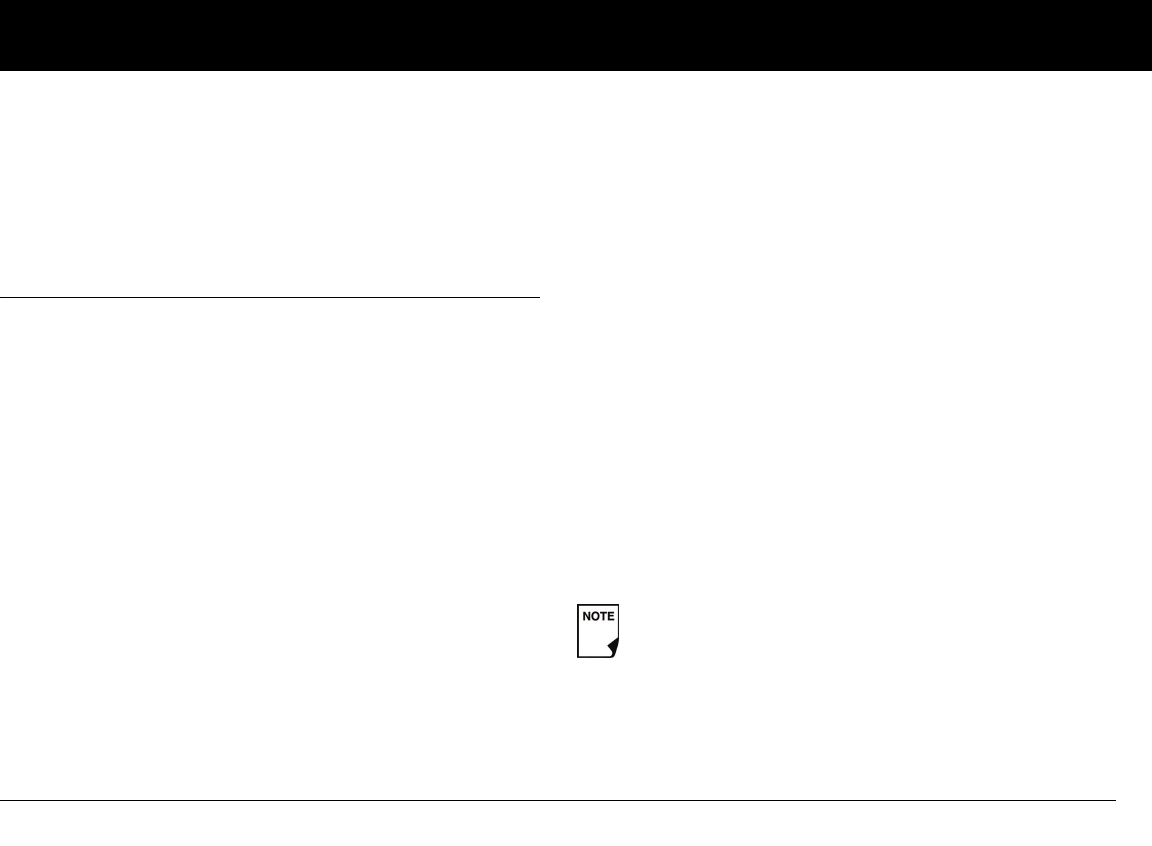
29
CHAPTER 4
Understanding and Delivering Bolus Doses
■ What Is a Bolus?
A bolus is an extra dose of insulin, delivered when needed to:
•Match the carbohydrates (sugar content) in a meal or snack—
also known as a meal bolus
•Lower blood glucose when it gets too high—also known as a
correction bolus
This extra dose is in addition to the basal rate delivered through-
out the day and night (see Chapter 3, Understanding and
Adjusting Basal Rates).
The size of a bolus dose depends on the factors current at the
time you deliver the bolus:
•Your blood glucose level
•Your insulin-to-carbohydrate ratio
•Your correction factor
• Your target blood glucose
• The amount of insulin on board (active insulin) from previous
meal and correction boluses
•Your correction threshold, the BG level above which you
would like to take insulin to reduce an elevated blood
glucose
•Your activity level
• The type and amount of food you eat
With the OmniPod System, it is easy to adapt to any situation.
With just a few button presses, you can adjust to unexpected or
changing insulin needs.
During setup, you entered bolus dose settings in the PDM (see
Chapter 2, Getting Started). You can adjust these settings as you
fine-tune your System or when your needs change (see Chapter
6, Using the Personal Diabetes Manager).
Check with your healthcare provider before you adjust
these settings.
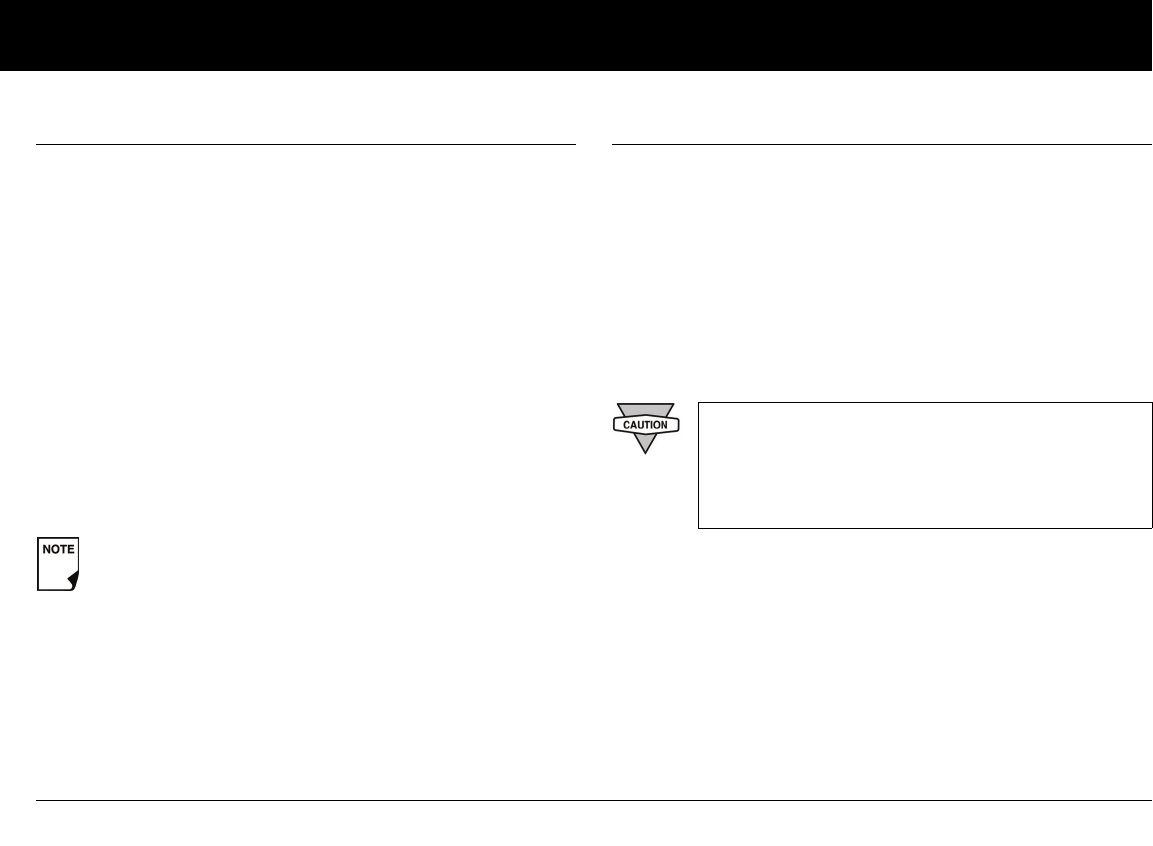
Understanding and Delivering Bolus Doses
30
4
■ Bolus Dose Options
So that you can fully enjoy freedom and flexibility in your life, the
OmniPod System offers the following bolus dose options:
Suggested bolus calculator: When you want the System to
calculate your suggested bolus, based on your personal settings,
your current blood glucose, the amount of insulin still active in
your body from previous boluses, and the grams of carbohy-
drate (“carbs” for short) you are about to eat
Normal bolus: When you need a dose of insulin right away, to
cover a meal or snack you are about to eat or to reduce a high
blood glucose level
Extended bolus: When you are eating high-fat or high-protein
foods (which take longer to digest and are slower to affect blood
glucose) or when you are eating for an extended period (for
example, at a party or during a holiday meal)
■ Suggested Bolus Calculator
The suggested bolus calculator lets the OmniPod System recom-
mend your bolus based on your personal settings. To review or
adjust these settings—including turning the suggested bolus
calculator On or Off—see Chapter 6, Using the Personal Diabe-
tes Manager.
If the suggested bolus calculator is turned On, the System
automatically calculates a bolus dose. If the suggested bolus
calculator is turned Off, you must enter a bolus amount
manually.
How a suggested bolus is calculated
The suggested bolus calculator estimates the suggested amount
for each bolus portion based on your personal settings and
inputs.
The bolus features in the OmniPod System are designed
for flexibility and convenience. You can easily transition
from a normal to an extended bolus with just a few
button presses.
The suggested bolus calculator will display a sug-
gested bolus dose based on the settings you have
programmed into the PDM. Check with your health-
care provider before using this feature or adjusting
these settings.
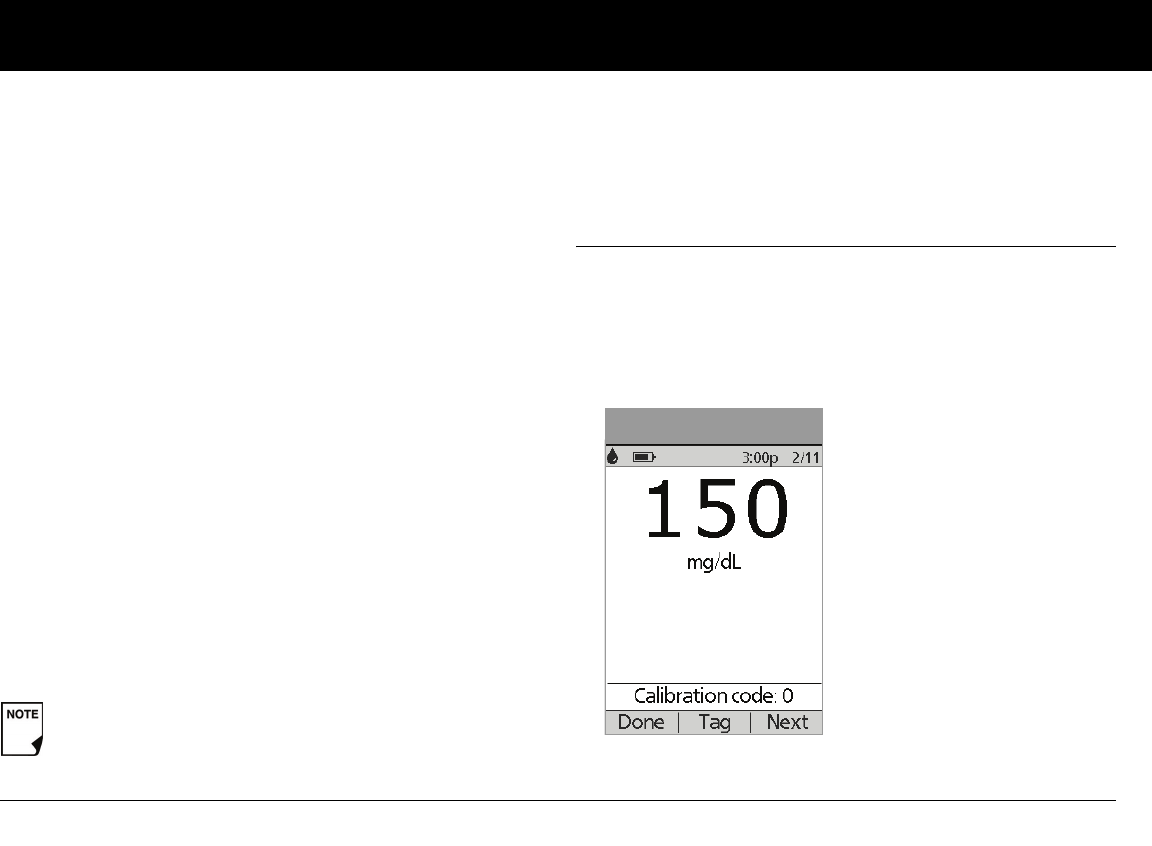
Understanding and Delivering Bolus Doses
31
4
The settings used to calculate a suggested bolus are:
•target BG
• insulin-to-carbohydrate (IC) ratio
• correction factor (CF)
• duration of insulin action
The inputs used to calculate a suggested bolus are:
• current BG
•carbs entered
• insulin on board (IOB)
A suggested bolus can have a correction bolus only, a meal bolus
only, or both.
Correction bolus: The correction bolus, as the name suggests,
“corrects” for a blood glucose (BG) level above your target BG
level.
Meal bolus: The meal bolus provides insulin for the carbohy-
drates you enter into the System.
Insulin on board (IOB): IOB is the amount of insulin still working
in your body from previous boluses. The amount of time insulin
remains “on board” or “active” depends on what you set for your
duration of insulin action.
For formulas for each element of the suggested bolus calcula-
tion, detailed examples, and additional guidelines of how the
suggested bolus calculator works, see the Appendices.
■ Deliver a Normal Bolus
Deliver a bolus when suggested bolus calculator is On
1. After you check your blood glucose, the PDM displays the
results (Figure 4-1; see the end of Chapter 7, Checking Your
Blood Glucose). Press Next.
The OmniPod System can only subtract insulin on board
from a suggested bolus when the current BG is known.
Figure 4-1
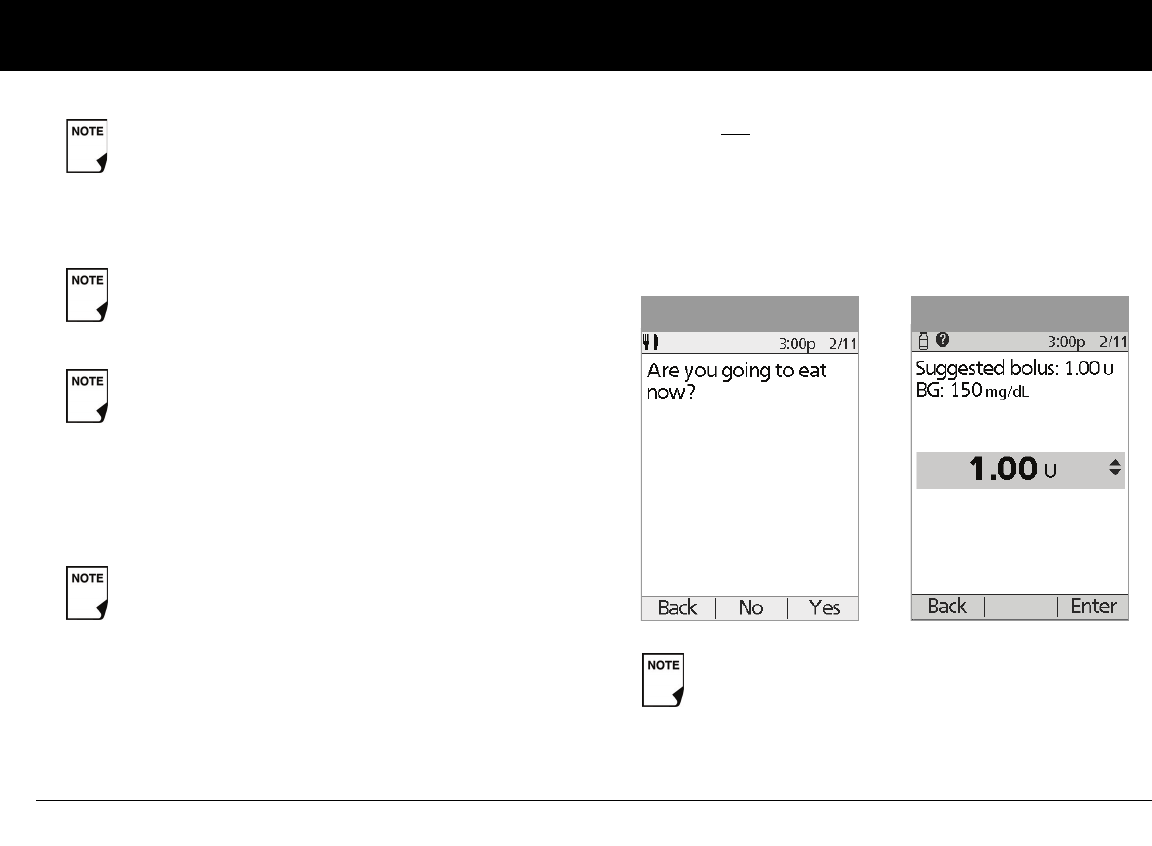
Understanding and Delivering Bolus Doses
32
4
2. If you are not going to eat now, press No (Figure 4-2). The
Suggested Bolus screen appears (Figure 4-3). Press Enter to
accept the suggested bolus.
Or, if you wish, press the Up/Down Controller buttons to
increase or decrease the suggested bolus. Then press Enter
to accept the bolus.
A blood glucose value is current for up to 10 minutes
after it is tested. So you can wait up to 10 minutes,
restart the bolus process, and not have to retest your
blood glucose in order to include it in the suggested
bolus calculator.
When your blood glucose result reads “HIGH” or
“LOW,” the suggested bolus calculator will be
disabled.
If you use a separate blood glucose meter—not the
Personal Diabetes Manager (PDM)—you will need to
enter your blood glucose manually. On the Home
screen, choose Bolus, then press Select. Use the Up/
Down Controller buttons to enter your current BG
value, then press Yes if you want this value to be used
by the suggested bolus calculator.
You can also enter a BG manually by choosing the
More actions menu, then choosing Add BG Read-
ing. See the end of Chapter 7, Checking Your Blood
Glucose. In the Suggested Bolus screen, “adjusted for IOB”
appears only when IOB is a factor in the calculation.
Figure 4-2 Figure 4-3
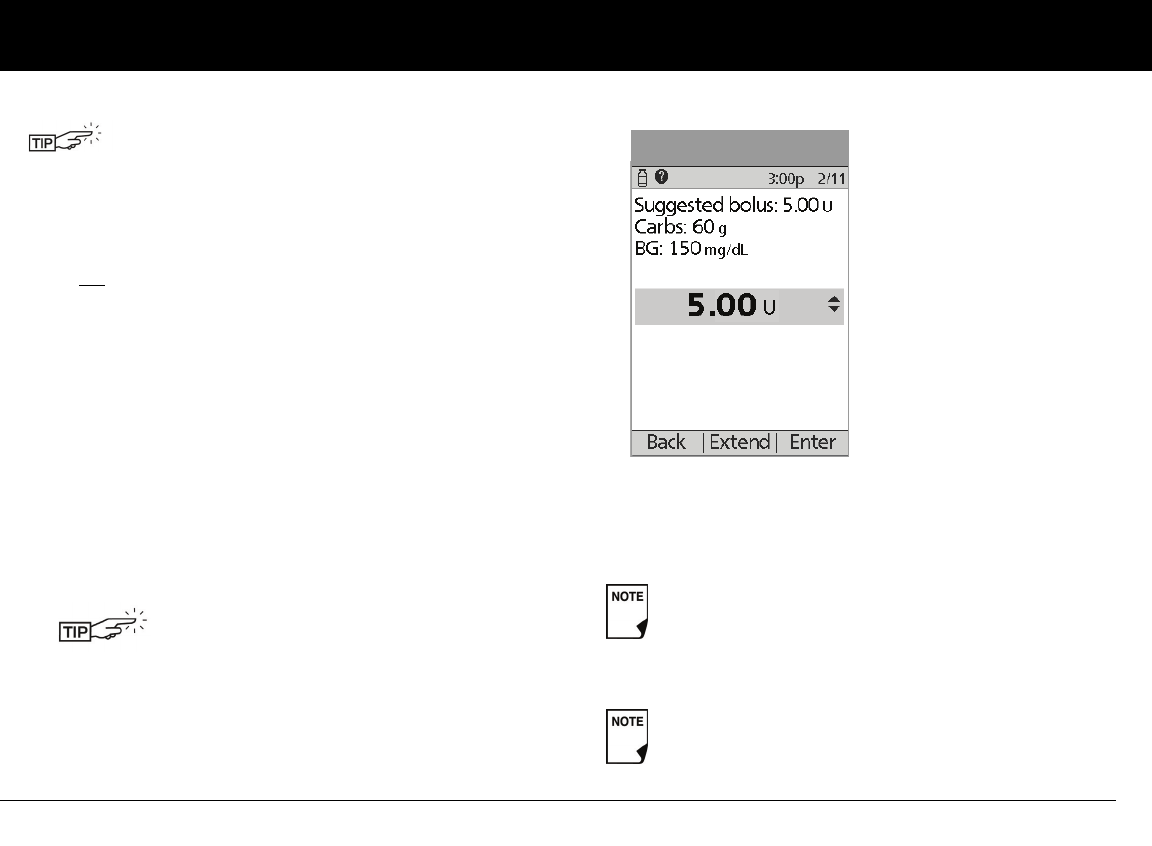
Understanding and Delivering Bolus Doses
33
4
3. If you are going to eat now:
a. Press Yes (Figure 4-2 on previous page), enter the number
of carbohydrates you are about to eat, then press Enter.
If you’ve previously entered a carb preset, then either:
• Use the Up/Down Controller buttons to choose
[enter manually], then press Select. Enter the num-
ber of carbohydrates that you are going to eat, then
press Enter.
• Use the Up/Down Controller buttons to choose
favorites, snacks, or meals. From there, select a carb
preset you have previously entered (see “Carb Presets”
later in this chapter), then press Select.
b. Press Enter to accept the suggested bolus (Figure 4-4).
Or press the User Info/Support button to view calculation
information used for this suggested bolus. Press Close to
return to the Suggested Bolus screen, then press Enter.
To view detailed information about the calcula-
tions used for this suggested bolus, press the User
Info/Support button and scroll through the infor-
mation screens. Press Close to return to the
Suggested Bolus screen.
The OmniPod System includes a reference
food library. For more information, see
“Reference Food Library” at the end of this
chapter.
If the reverse correction feature is turned On and if
your blood glucose level is below your target, the
System subtracts a correction amount from the meal
portion of the bolus.
If the reverse correction setting is turned Off, the
System does not subtract anything for a blood glu-
cose level below your target.
Figure 4-4
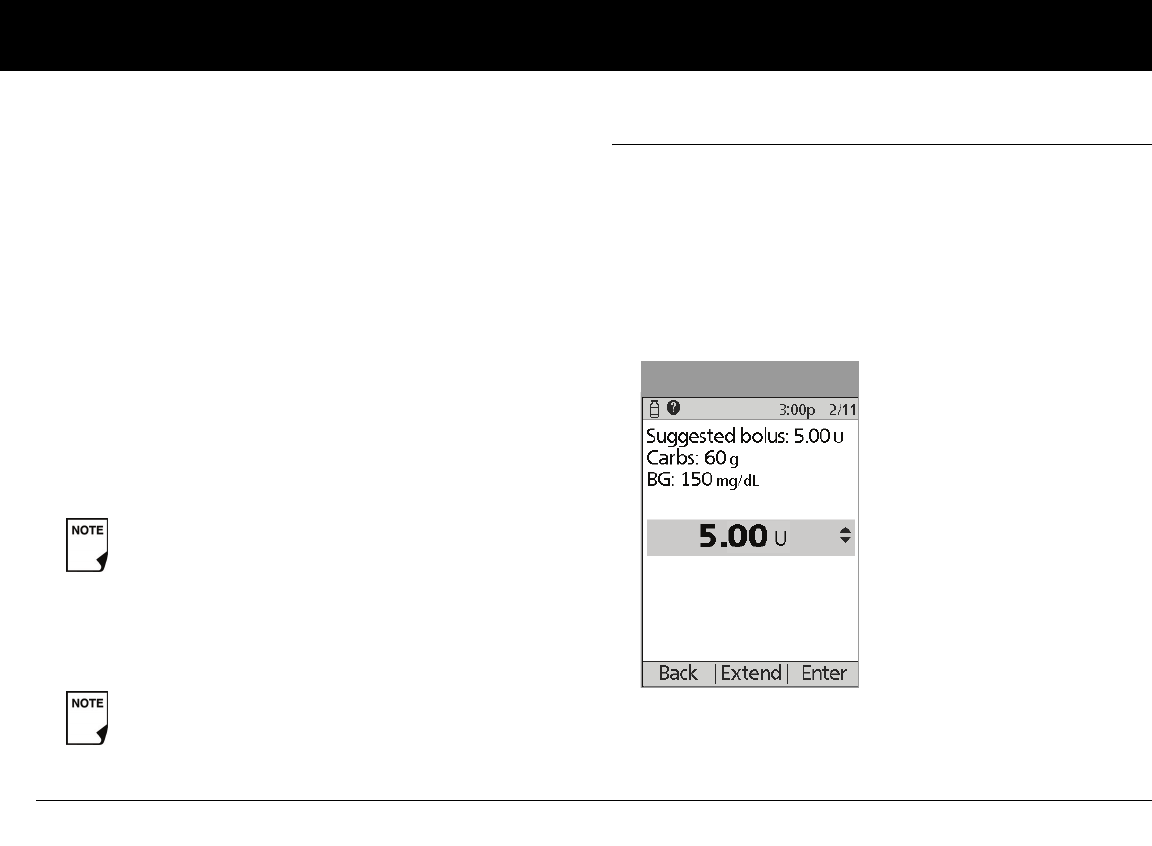
Understanding and Delivering Bolus Doses
34
4
4. If you have set the blood glucose reminder option to On and
you want to add a reminder:
c. Press Yes.
d. Enter the time for the reminder, then press OK.
5. Press Confirm to begin the bolus delivery.
Deliver a bolus manually (suggested bolus calc is Off)
1. On the Home screen, use the Up/Down Controller buttons
to choose Bolus; then press Select.
2. Enter the number of units you want to deliver, then press
Enter.
3. If the blood glucose reminders feature is turned On, you can
now set a blood glucose reminder.
4. Press Confirm to begin the bolus delivery.
■ Deliver an Extended Bolus
The extended bolus feature lets the OmniPod System deliver
some (or no) insulin now and the remainder over a period of
time you choose.
Deliver an extended bolus instead of a normal bolus
1. After you get your suggested bolus, press Extend instead of
Enter (see Figure 4-5).
As a safety feature, the OmniPod System only allows
you to give a bolus at or below the maximum bolus
dose you have set. See Chapter 6, Using the Personal
Diabetes Manager, for information on resetting your
maximum bolus dose. Consult your healthcare pro-
vider before changing this setting.
Once a Pod is activated and communicates with the
PDM, it can only receive commands from that PDM,
not from any other.
Figure 4-5
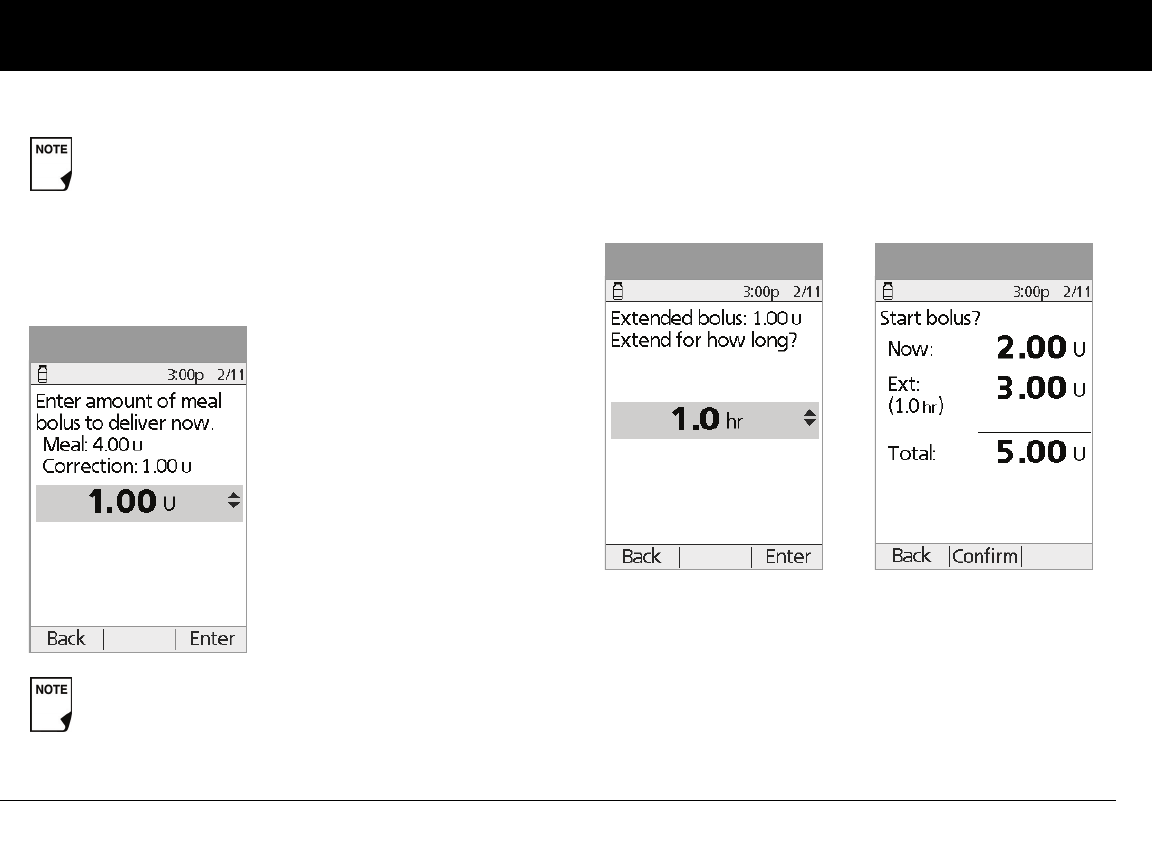
Understanding and Delivering Bolus Doses
35
4
2. Enter the units of insulin or percentage of the bolus that you
want to take immediately (Figure 4-6), then press Enter.
3. Enter the time (up to 8 hours, in 30-minute increments) over
which to deliver the remainder of the bolus, then press Enter
(Figure 4-7). In Figure 4-8 you can see a detail of the extended
bolus.
4. If the blood glucose reminders feature is turned On, you
can now set a blood glucose reminder.
5. Press Confirm to begin the bolus delivery.
If you have set the Extended bolus option to Off,
the PDM will not display the Extend soft key. For
information on turning this feature on and off, see
Chapter 6, Using the Personal Diabetes Manager.
To learn how to set extended boluses in percentages
or units, see Chapter 6, Using the Personal Diabetes
Manager.
Figure 4-6
Figure 4-7 Figure 4-8
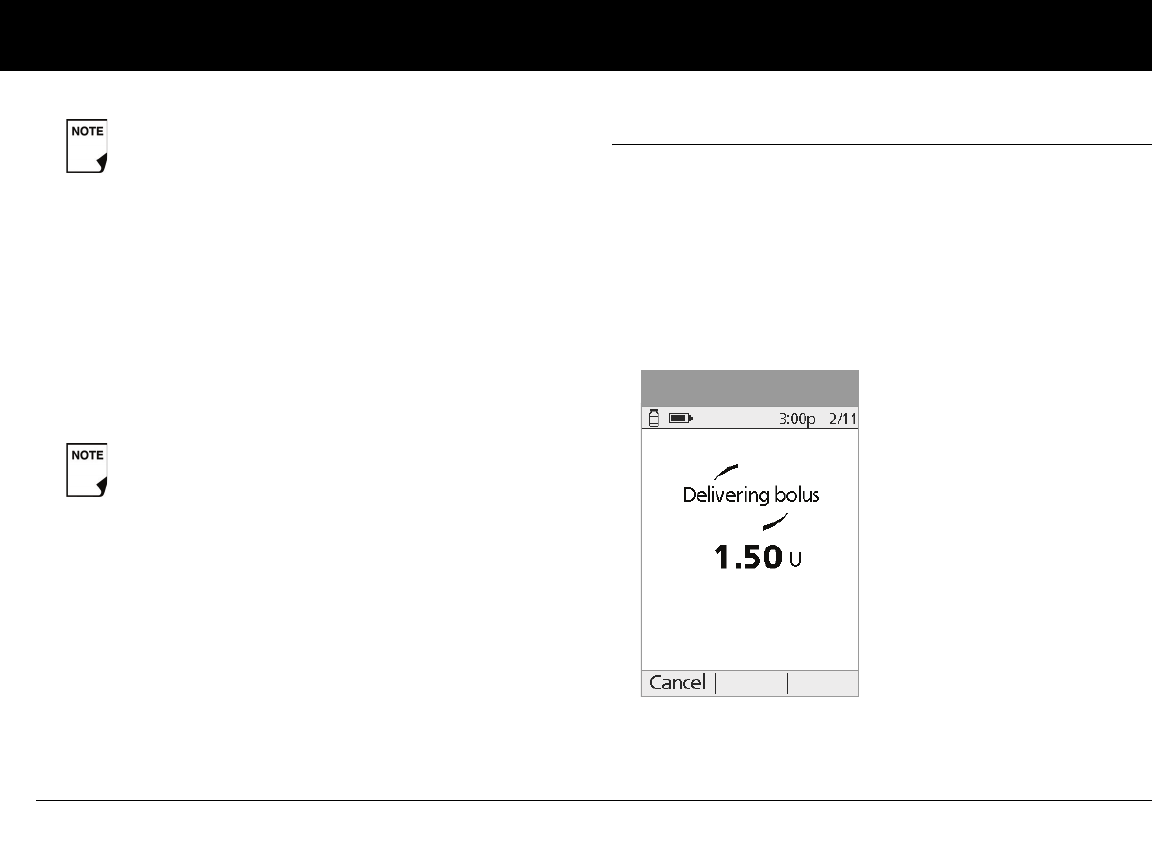
Understanding and Delivering Bolus Doses
36
4
■ Cancel Active Boluses
The OmniPod System is extremely flexible, so you can use it to
respond to your changing insulin needs. It is easy to cancel an
active bolus (one that is currently being delivered), even after
insulin delivery has started.
1. Press and hold the Power button to turn on the PDM, if it is
not already on. An on-screen message appears as long as a
normal bolus is being delivered (Figure 4-9).
As a safety feature, the correction bolus is always
delivered first and cannot be extended. Only the
meal bolus can be extended. For example:
Total bolus = 5 units
Correction bolus 1 unit
Meal bolus 4 units
Deliver now = 2 units
100% of correction bolus 1 unit
25% of meal bolus 1 unit
Extend = 3 units
75% of meal portion 3 units
As a safety feature, you cannot deliver two extended
boluses at the same time. You can, however, cancel
the first extended bolus and replace it with another
(see “Replace an Extended Bolus” on page 37). And
you can deliver a normal bolus while an extended
bolus is being delivered.
Figure 4-9
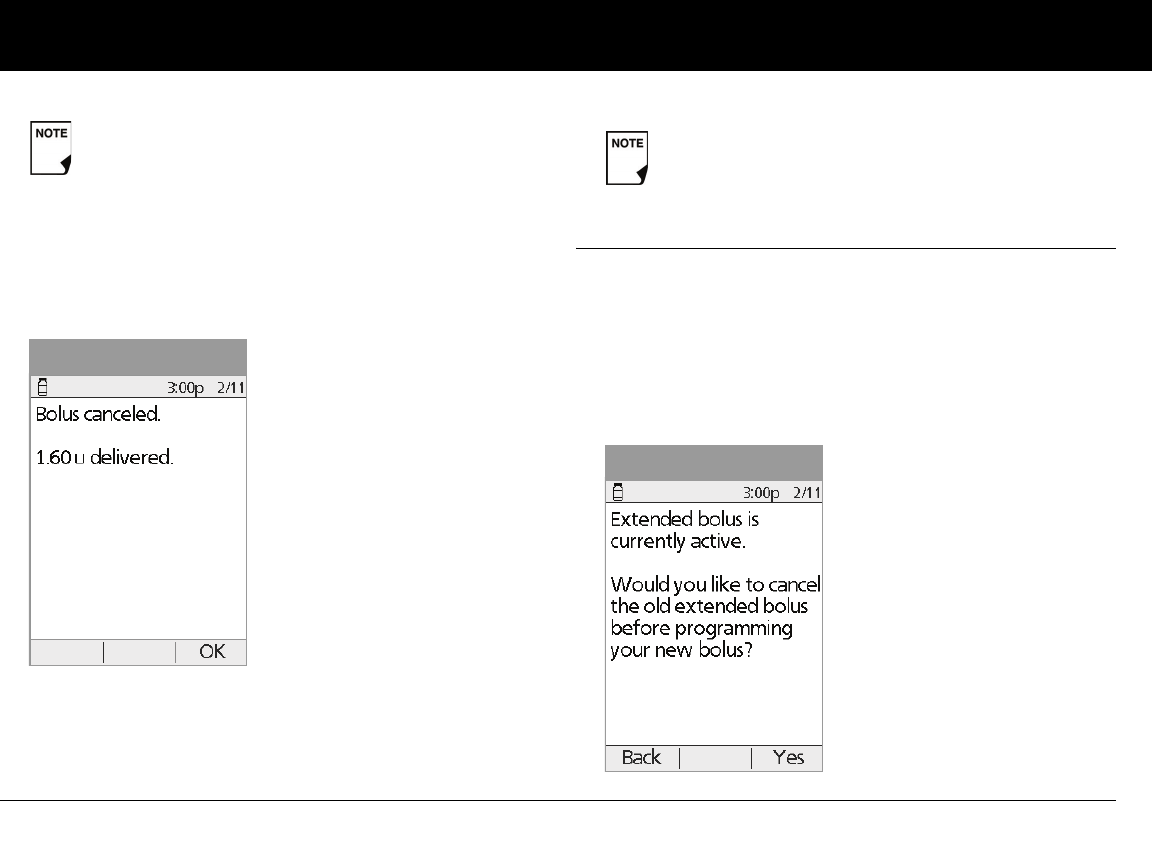
Understanding and Delivering Bolus Doses
37
4
2. Press Cancel.
The Pod beeps to confirm the bolus is canceled. An on-screen
message tells you how much insulin was delivered before
you canceled the bolus (Figure 4-10).
3. Press OK to return to the Status screen.
■ Replace an Extended Bolus
You can replace one extended bolus with another. The System
tells you how much of the first bolus has not yet been delivered.
1. After you see your suggested bolus, press Extend instead of
Enter (see Figure 4-5 on page 34).
2. Press Yes to cancel the active extended bolus (Figure 4-11).
Or press Back to return to the Suggested Meal Bolus screen.
If the bolus has already been completely delivered,
the “Delivering bolus” message and Cancel do not
appear, but the Status screen does appear.
Figure 4-10
If your suggested bolus contains both a correction
bolus and a meal bolus, the correction bolus is always
delivered first.
Figure 4-11
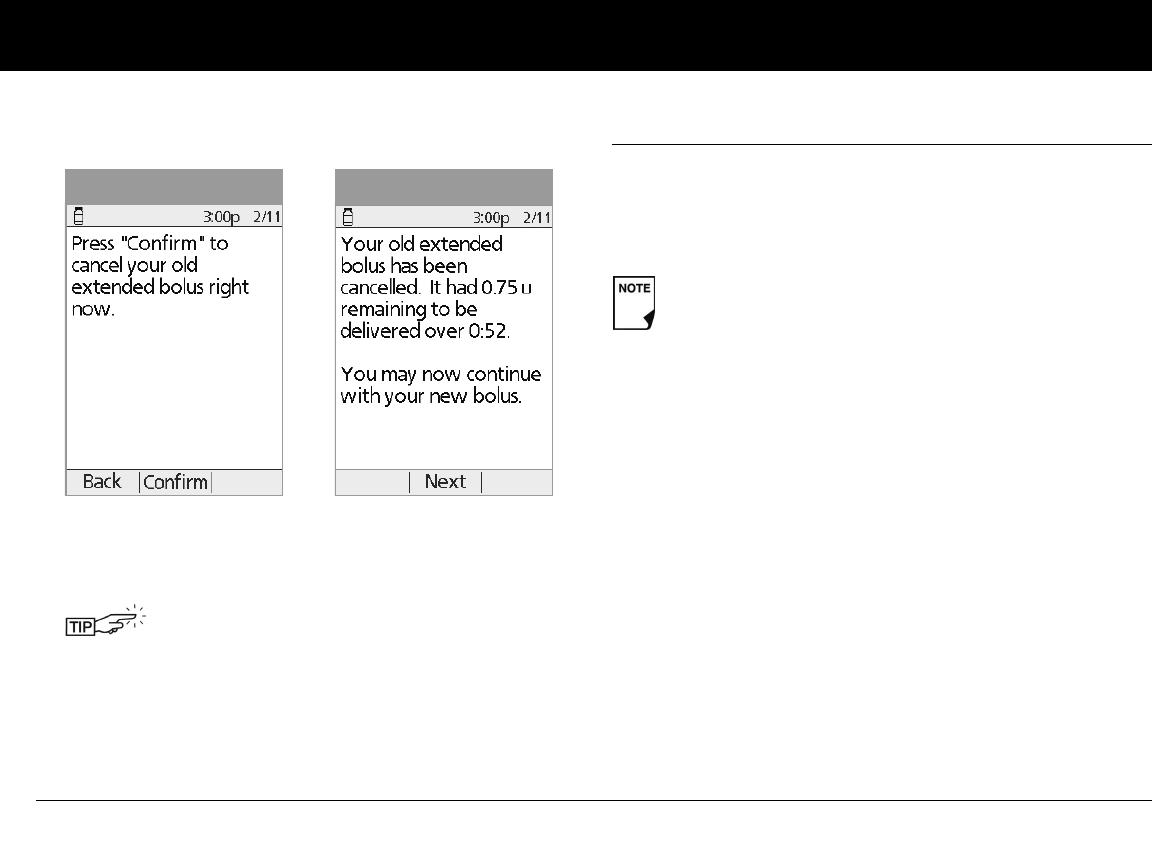
Understanding and Delivering Bolus Doses
38
4
3. Press Confirm (Figure 4-12).
4. The screen displays the amount of the old extended bolus
that remained to be delivered (Figure 4-13). Press Next to
return to the Suggested Meal Bolus screen.
■ Bolus Presets
Bolus presets are bolus amounts that you program for frequent
use. For example, if you often take the same bolus at lunchtime,
you can create a bolus preset for that amount and name it
“Lunch.”
Create a bolus preset
1. On the Home screen use the Up/Down Controller buttons
to choose Settings; then press Select.
2. Choose Presets, then press Select.
3. Choose Bolus presets, then press Select.
4. Choose [add new], then press New.
5. To use the OmniPod System’s default naming system, simply
press Next. The default naming system automatically assigns
program names in numerical order, such as bolus 1, bolus 2,
bolus 3.
You can add what remained of the old extended
bolus to the new one.
Figure 4-12 Figure 4-13
Bolus presets are available only when the suggested
bolus calculator feature is turned Off. (If the suggested
bolus calculator is turned On, you can still use carb pre-
sets. See “Carb Presets” on page 40.)
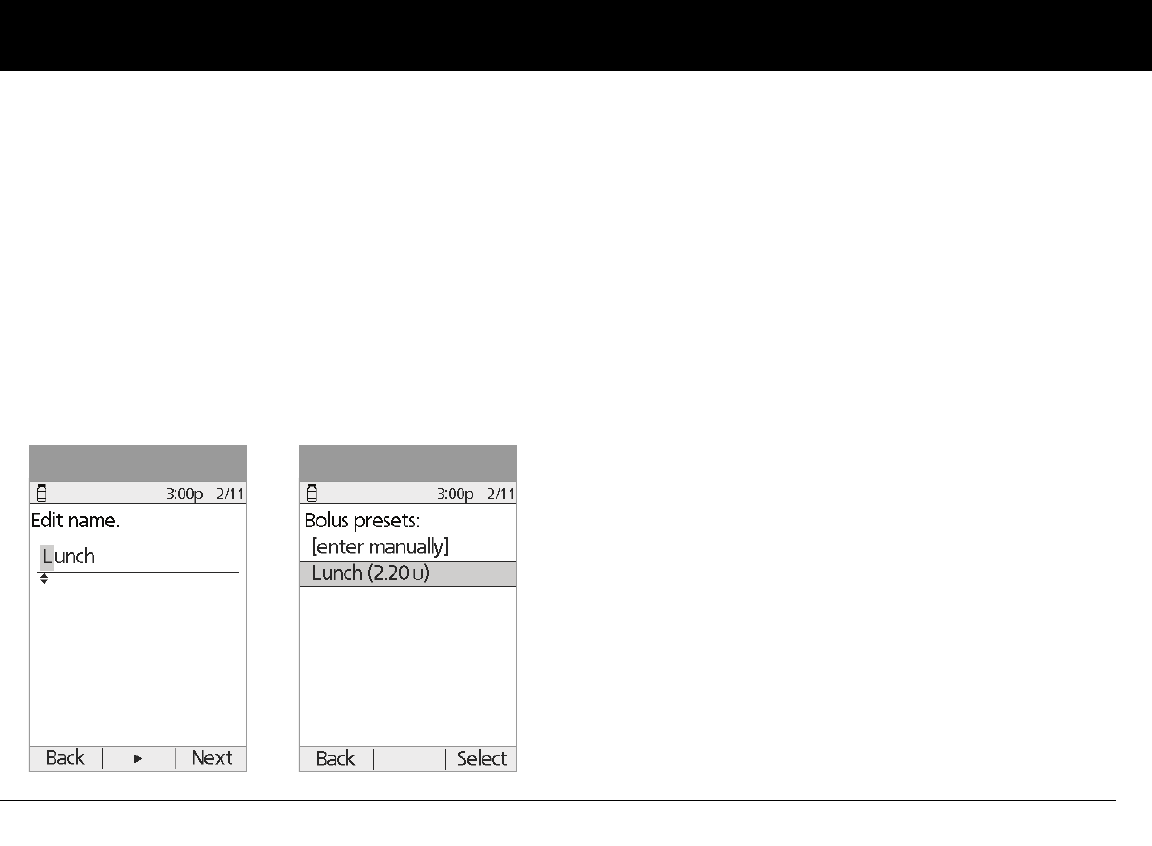
Understanding and Delivering Bolus Doses
39
4
Or, to give a different name to the program:
a. Press the Up/Down Controller buttons to enter the char-
acters that spell the name you want. An up- and down-
arrow symbol on the screen indicates which character
you are changing.
b. Press the middle soft key (labeled with the right arrow) to
move the underscore to the next character.
c. Enter each character one at a time. For example, if you
frequently take the same bolus at lunchtime, you might
enter L, u, n, c, h (Figure 4-14).
d. Press Next.
6. Enter the new bolus preset amount, up to the maximum
bolus you entered during setup; then press Next.
7. Review the bolus preset name and amount; press Save to
accept it.
Enable an existing bolus preset
1. On the Home screen, use the Up/Down Controller buttons
to choose Bolus; then press Select.
2. Choose the bolus preset you want to use from the list (Figure
4-15), then press Select.
3. Press Enter to confirm the bolus preset amount, or, if neces-
sary, use the Up/Down Controller buttons to adjust the
bolus amount.
4. Press Confirm to deliver the bolus shown on the screen.
Change, rename, or delete a bolus preset
1. On the Home screen, use the Up/Down Controller buttons
to choose Settings; then press Select.
2. Choose Presets, then press Select.
3. Choose Bolus presets, then press Select.
4. Choose a preset from the list, then press Edit.
Change a bolus preset
1. Choose Edit, then press Select.
2. Enter a new insulin amount for the bolus, then press Save.
Figure 4-14 Figure 4-15

Understanding and Delivering Bolus Doses
40
4
Rename a bolus preset
1. Choose Rename, then press Select.
2. Press the Up/Down Controller buttons to enter the charac-
ters that spell out the name you want; then press Next.
Delete a bolus preset
1. Choose Delete and then press Select.
2. Press Delete to permanently delete the preset.
Cancel an active bolus preset
1. Press and hold the Power button to turn on the PDM, if it is
not already on. An on-screen message appears as long as a
bolus is being delivered.
2. Press Cancel.
The Pod beeps to confirm the bolus is canceled. An on-screen
message tells you how much insulin was delivered before
you canceled the bolus.
3. Press OK to return to the Status screen.
For more details, see “Cancel Active Boluses” earlier in this
chapter.
■ Carb Presets
Carb presets are favorite food items, snacks, or meals that you eat
frequently. After you enter these items, you can quickly select
one when entering carbs during the suggested bolus calculator
process.
Create a carb preset
1. On the Home screen, use the Up/Down Controller buttons
to choose Settings; then press Select.
2. Choose Presets, then press Select.
3. Choose Carb presets, then press Select.
4. Choose the category for this carb preset: Favorites, Snacks,
or Meals, then press Select.
5. Choose [add new], then press New.
6. To use the OmniPod System’s default naming system, simply
press Next. The default naming system automatically assigns
program names in numerical order, such as carb preset 1,
carb preset 2, carb preset 3.
Or, to give a different name to the program:
a. Press the Up/Down Controller buttons to enter the char-
acters that spell the name you want. An up-and-down-
arrow symbol on the screen indicates the character you
are changing.
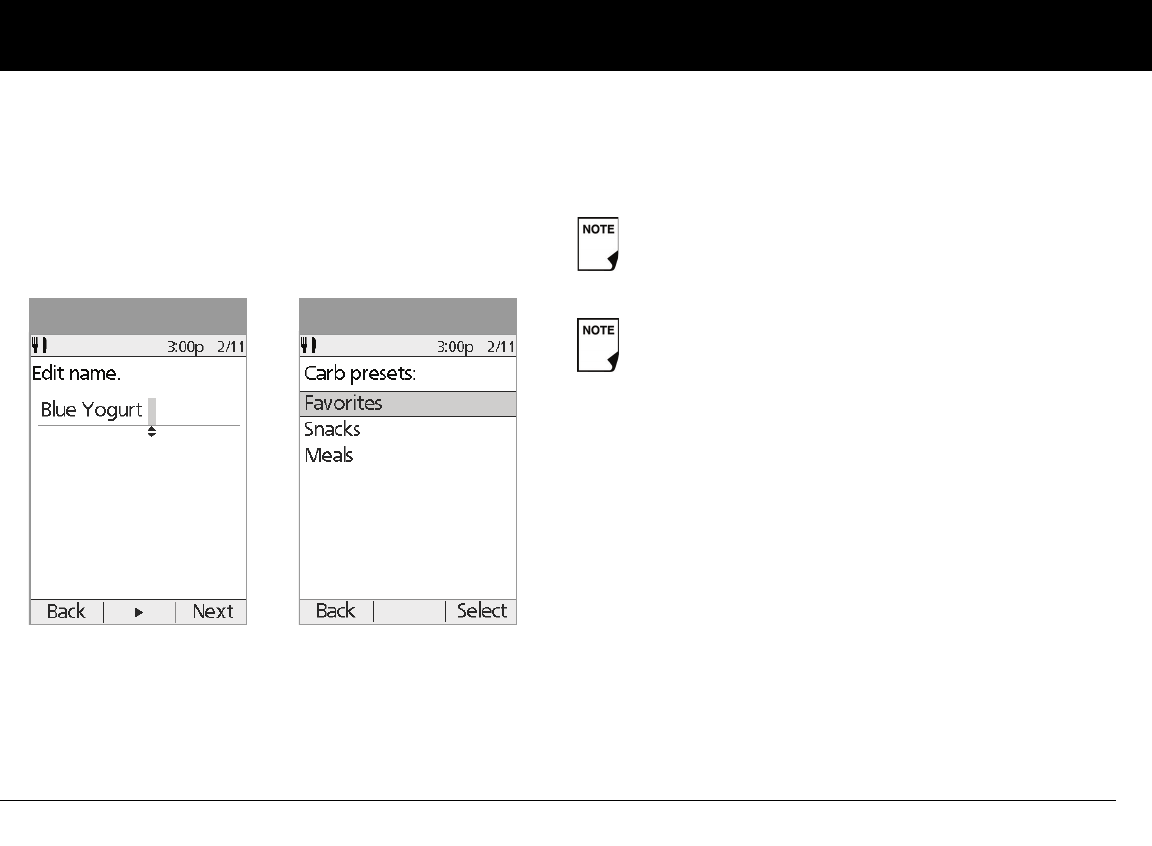
Understanding and Delivering Bolus Doses
41
4
b. Press the middle soft key (the right arrow) to move the
underscore to the next character.
c. Enter each character one at a time. For example, if you
frequently eat a breakfast of plain low-fat yogurt with
blueberries, sweetener, and cinnamon, you might enter
B, l, u, e, [space], Y, o, g, u, r, t (Figure 4-16).
d. Press Next.
7. Enter the grams of carbohydrate in the meal, then press Next.
8. If you want, enter the grams of fiber, fat, and protein in the
meal, and the total calories. Press Next after each entry.
9. Press Save to add the preset to the category.
Change or edit a carb preset
1. On the Home screen, use the Up/Down Controller buttons
to choose Settings; then press Select.
2. Choose Presets, then press Select.
3. Choose Carb presets, then press Select.
4. Choose the category of the preset you want to change, then
press Select (Figure 4-17).
Figure 4-16 Figure 4-17
These additional units are not required. If you prefer not
to enter them, simply press Next repeatedly to step
through the screens.
If you do include grams of fiber in step 8 above, the
suggested bolus calculator uses carbs minus fiber. Alter-
natively, in step 7, you can enter the total of carbs minus
fiber yourself. Your healthcare provider can best advise
you how to make this entry.
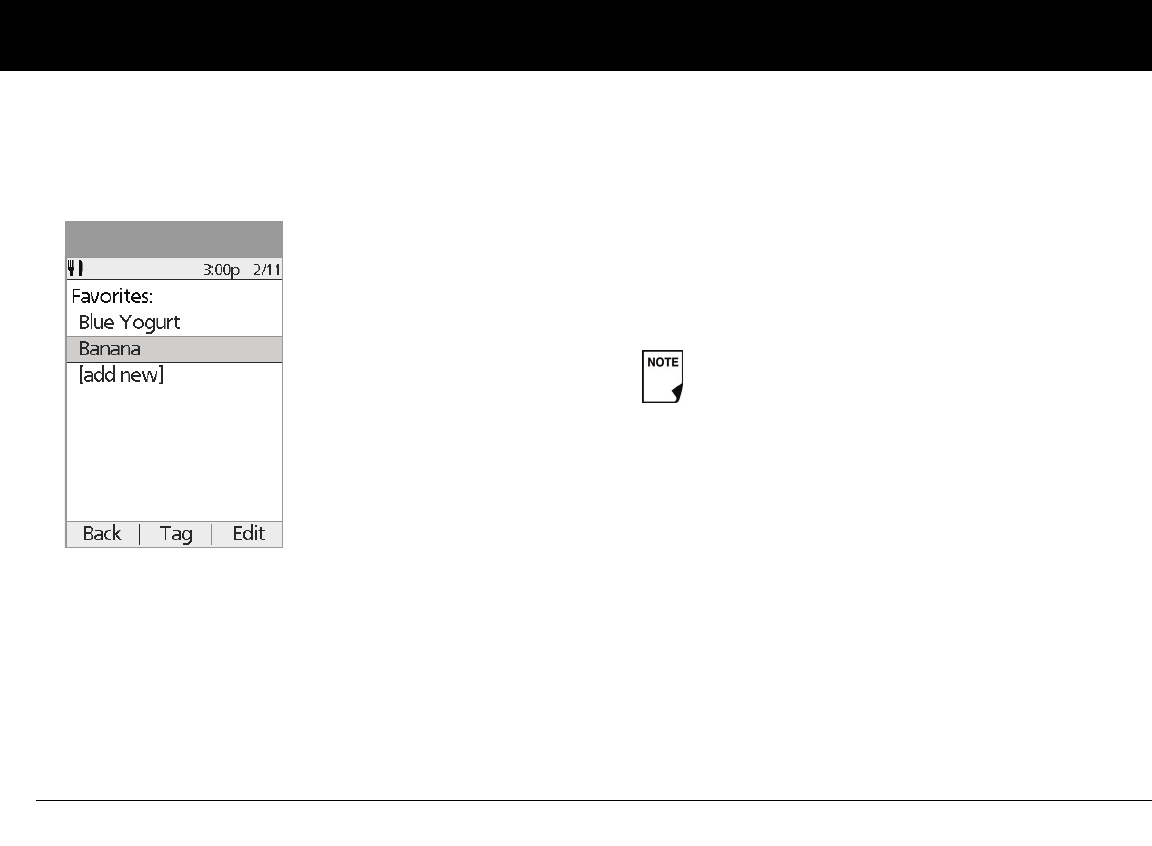
Understanding and Delivering Bolus Doses
42
4
To change the category for a carb preset
1. Choose the carb preset you want to move to another cate-
gory, then press Tag (Figure 4-18).
2. Choose a new category, then press Select.
To edit a carb preset
1. Choose the carb preset you want to change, then press Edit.
2. Press Edit again on the next screen.
3. To rename the carb preset, press the Up/Down Controller
buttons to enter the characters that spell out the name you
want, then press Next.
To “erase” characters, press either Up or Down until you reach
the end of the characters, which is a blank.
4. Enter the grams of carbohydrate in the meal, then press Next.
5. If you want, enter the grams of fiber, fat, and protein in the
meal, and the total calories. Press Next after each entry.
6. Press Save to update the preset.
Delete a carb preset
1. On the Home screen, use the Up/Down Controller buttons
to choose Settings; then press Select.
2. Choose Presets, then press Select.
3. Choose Carb presets, then press Select.
4. Choose the category of the preset you want to change, then
press Select.
5. Choose the carb preset you want to delete, then press Edit.
6. Press Delete.
7. Press Delete again to permanently delete the preset.
Figure 4-18
These additional units are not required. If you prefer
not to enter them, simply press Next repeatedly to
step through the screens.
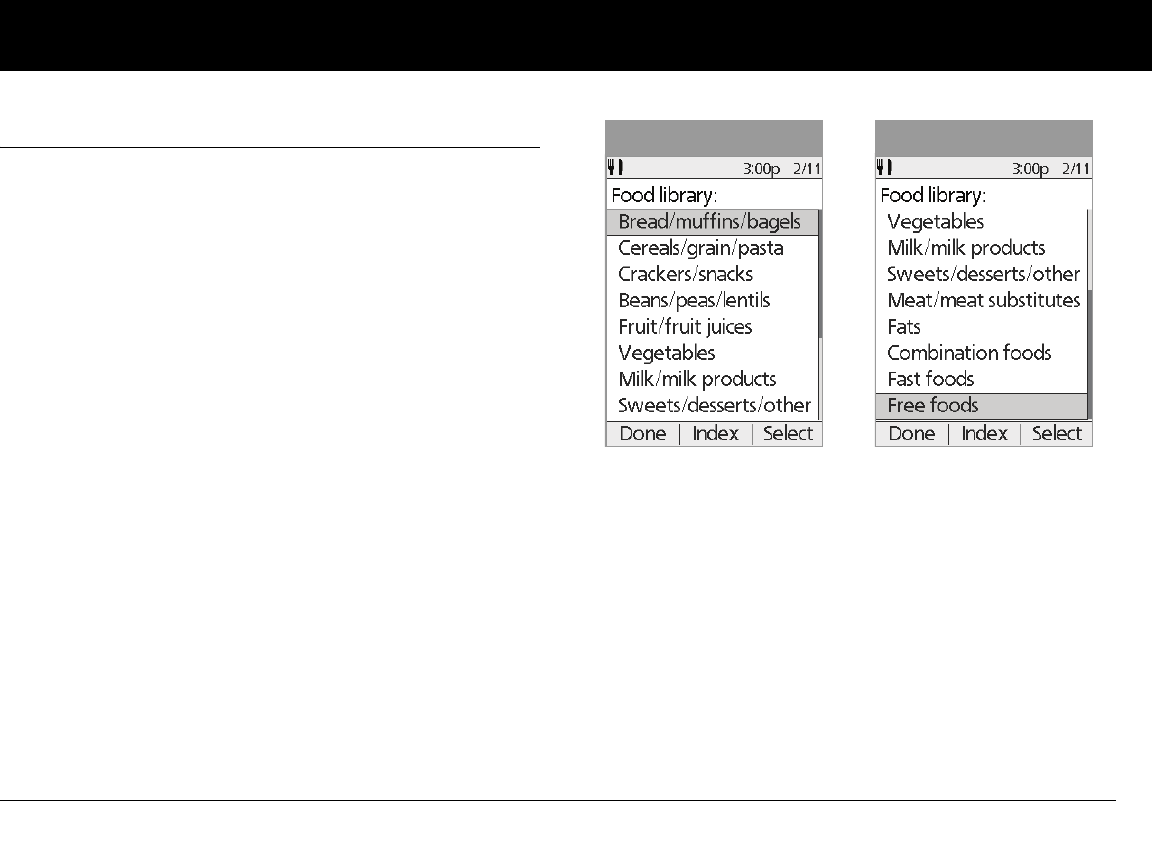
Understanding and Delivering Bolus Doses
43
4
■ Reference Food Library
The OmniPod System includes a reference library of over 1,000
common food items. The library shows each item’s carbohydrate,
fat, protein, fiber, and calories for a single portion. You can use
this information to determine the carbs for a meal or snack you
are going to eat. You can also use it to help you create carb pre-
sets for your favorite meals.
The items in the food library are derived from the USDA data-
base, USDA National Nutrient Database for Standard Reference,
Release 16, published by the U.S. Department of Agriculture,
Agricultural Research Service, in 2004.
Access the reference food library
1. On the Home screen, use the Up/Down Controller buttons
to choose More actions; then press Select.
2. Choose View food library, then press Select.
The screen displays a list of main food categories (Figure 4-
19a and Figure 4-19b).
3. To choose directly from the food categories, use the Up/
Down Controller buttons to choose a main category, then
press Select. Choose a subcategory, then press Select.
Choose a food item from the subcategory, then press View.
4. To choose from an alphabetical list of foods, press Index.
Enter the first letter of the food item, then press Select.
Choose a food item from the alphabetical list, then press
View.
The screen displays the food item’s:
•Name
•Serving size
• Grams of carbohydrate, fiber, fat, and protein
•Total calories
5. Press OK to return to the list of main food categories.
Figure 4-19a Figure 4-19b
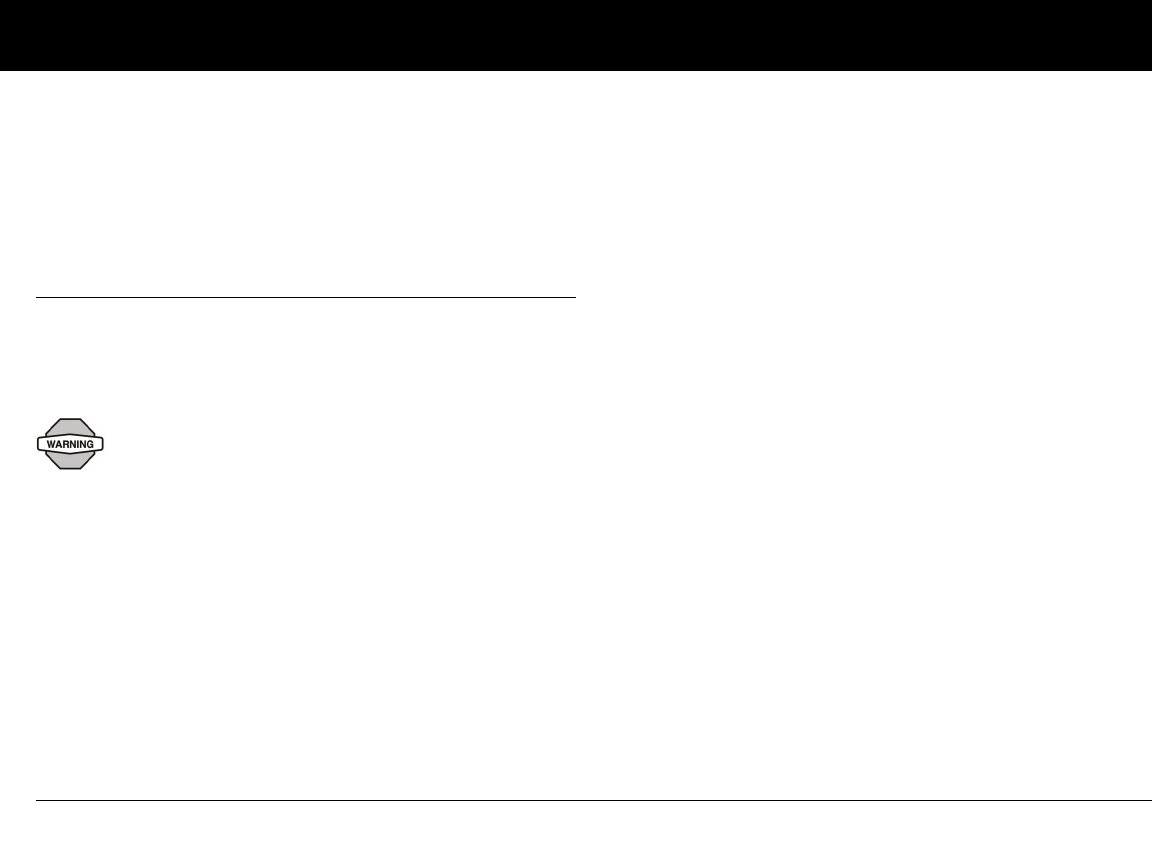
44
CHAPTER 5
Using the OmniPod
■ The OmniPod Change Process
You should replace the OmniPod at least once every 48–72 hours
(2–3 days), or as instructed by your healthcare provider. You can
also choose to have the PDM alert you when it is time to replace
the Pod (see Chapter 6, Using the Personal Diabetes Manager).
WARNINGS!
• Do NOT apply or use an OmniPod if its sterile packaging is
open or damaged, as this may increase the risk of infection.
OmniPods are sterile unless packaging has been opened or
damaged.
• Do NOT apply or use an OmniPod if it is damaged in any way.
A damaged Pod may not work properly.
• To minimize the possibility of site infection, do NOT apply an
OmniPod without first using aseptic technique. This means to:
• Wash your hands.
• Clean the insulin vial with an alcohol prep swab.
• Clean the infusion site with soap and water.
• Keep sterile materials away from any possible germs.
• Do NOT use the OmniPod if you are sensitive to or have
allergies to acrylic adhesives or have fragile or easily dam-
aged skin.
• Check often to make sure the OmniPod and soft cannula are
securely attached and in place. A loose or dislodged cannula
may interrupt insulin delivery.
• Do NOT apply a new OmniPod until you have deactivated
and removed the old Pod. A Pod that has not been
deactivated properly may continue to deliver insulin as
programmed, putting you at risk of overinfusion and possible
hypoglycemia.
• Because insulin Pods use only rapid-acting insulin, users are
at increased risk for developing hyperglycemia (high blood
glucose) if insulin delivery is interrupted. If it is untreated,
severe hyperglycemia can quickly lead to diabetic ketoacido-
sis (DKA). DKA can cause breathing difficulties, shock, coma,
or death. If insulin delivery is interrupted for any reason, you
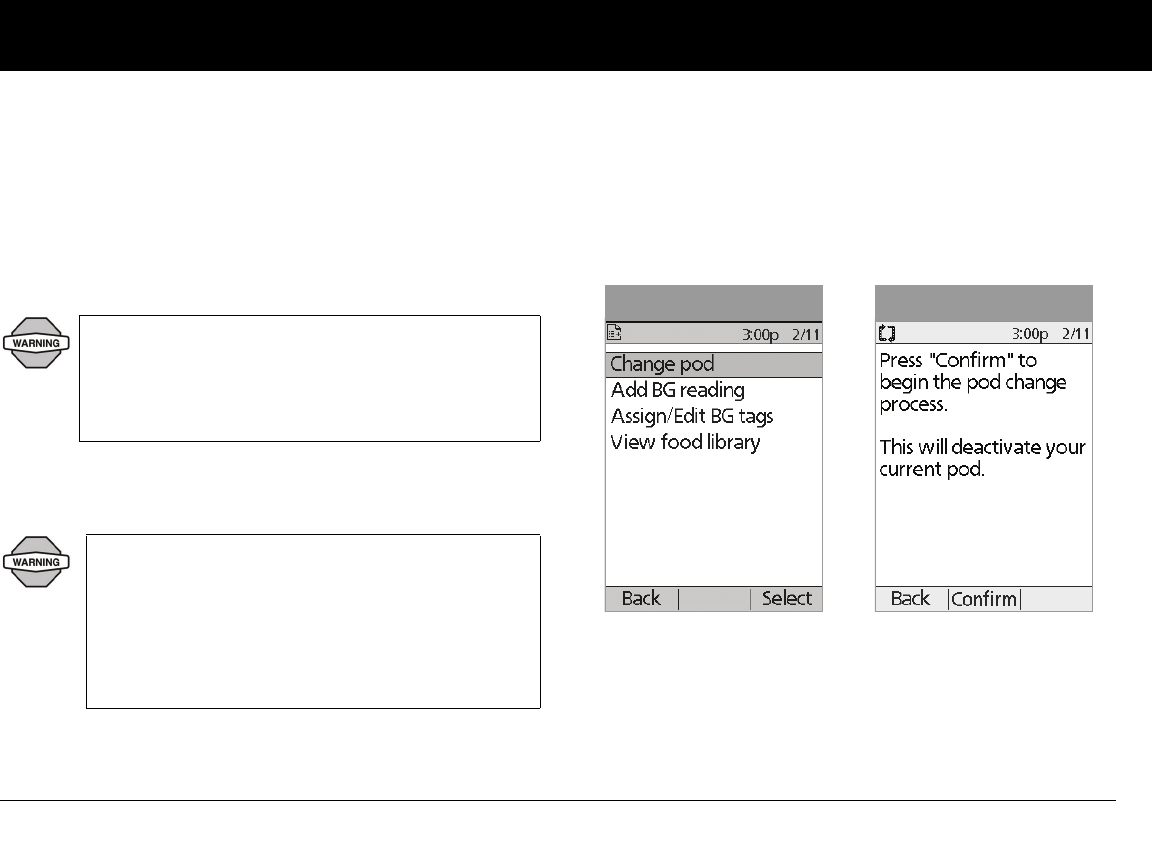
Using the OmniPod
45
5
may need to replace the missing insulin—usually with an injec-
tion of rapid-acting insulin. Ask your healthcare provider for
instructions on handling interrupted insulin delivery.
Gather equipment and supplies
Gather the following before you begin:
• Vial of rapid-acting U-100 insulin
• An unopened OmniPod
• Alcohol prep swab
Deactivate the current OmniPod
1. On the Home screen, use the Up/Down Controller buttons
to choose More actions, then press Select.
2. Choose Change Pod (Figure 5-1), then press Select.
3. Press Confirm (Figure 5-2) to deactivate the current Pod.
Use ONLY rapid-acting U-100 insulin with the
OmniPod. NEVER use insulin that is cloudy; it may be
old or inactive. Failure to use rapid-acting U-100 insu-
lin, or using insulin that is old or inactive, may lead to
hyperglycemia or diabetic ketoacidosis (DKA).
If you are a first-time OmniPod System user, your
healthcare provider will guide you through the steps
for initializing and applying your first Pod. Do NOT
attempt to apply or use an OmniPod until you have
been trained by your healthcare provider. Use of the
System with inadequate training or improper setup
could put your health and safety at risk.
Figure 5-1 Figure 5-2
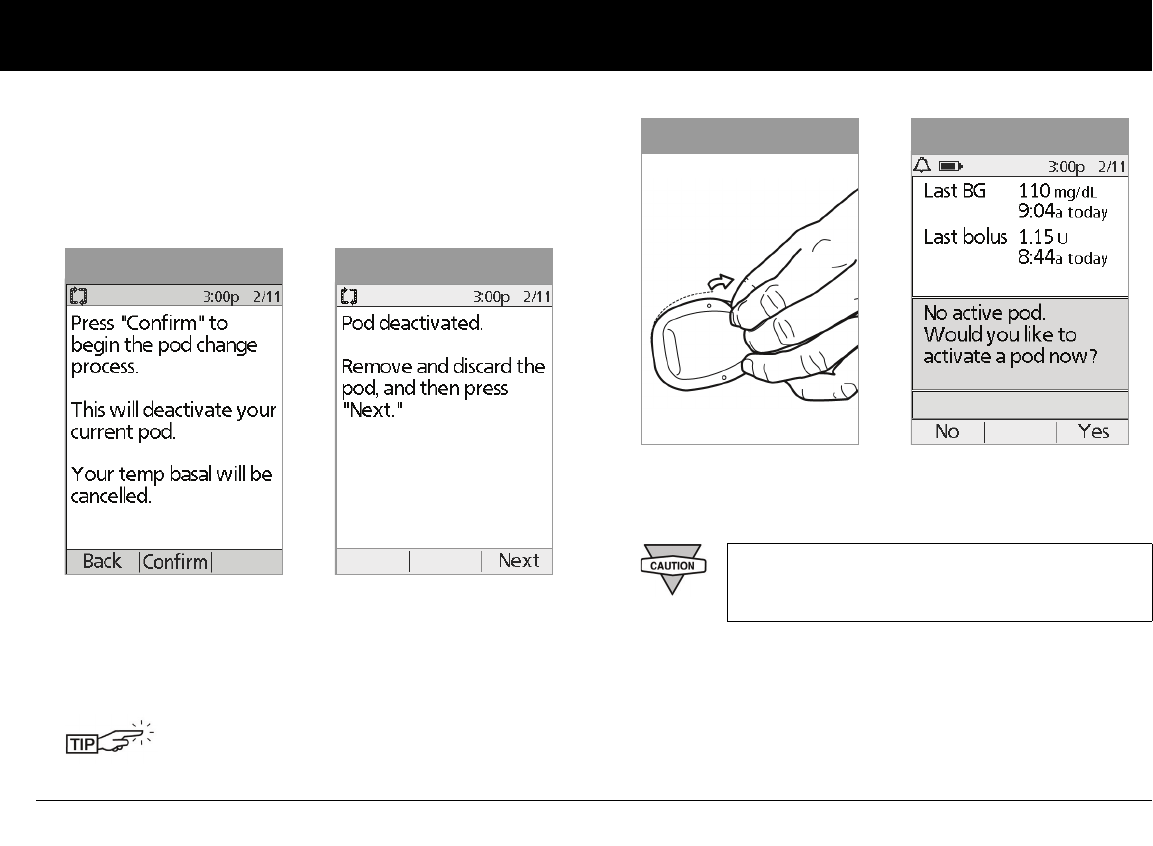
Using the OmniPod
46
5
4. If an extended bolus or temporary basal or both are actively
running, you will see the message in Figure 5-3. Press Con-
firm to accept the cancellation.
Or press Back to return to the More actions menu.
5. After you press Confirm, you will see the message in
Figure 5-4. To remove the old Pod:
a. Gently lift the edges of the adhesive tape from your skin
and remove the entire Pod (Figure 5-5).
b. Use soap and water to remove any adhesive that remains
on the skin or, if necessary, use an adhesive remover.
c. Discard the used Pod according to local waste disposal
regulations.
6. After removing the old Pod, press Next (Figure 5-4).
7. Press Yes to fill a new Pod (Figure 5-6).
Removing the Pod slowly will help to avoid
possible skin irritation.
Figure 5-3 Figure 5-4
Check the infusion site for signs of infection.
See “Avoid Infusion Site Infections” later in this
chapter.
Figure 5-5 Figure 5-6
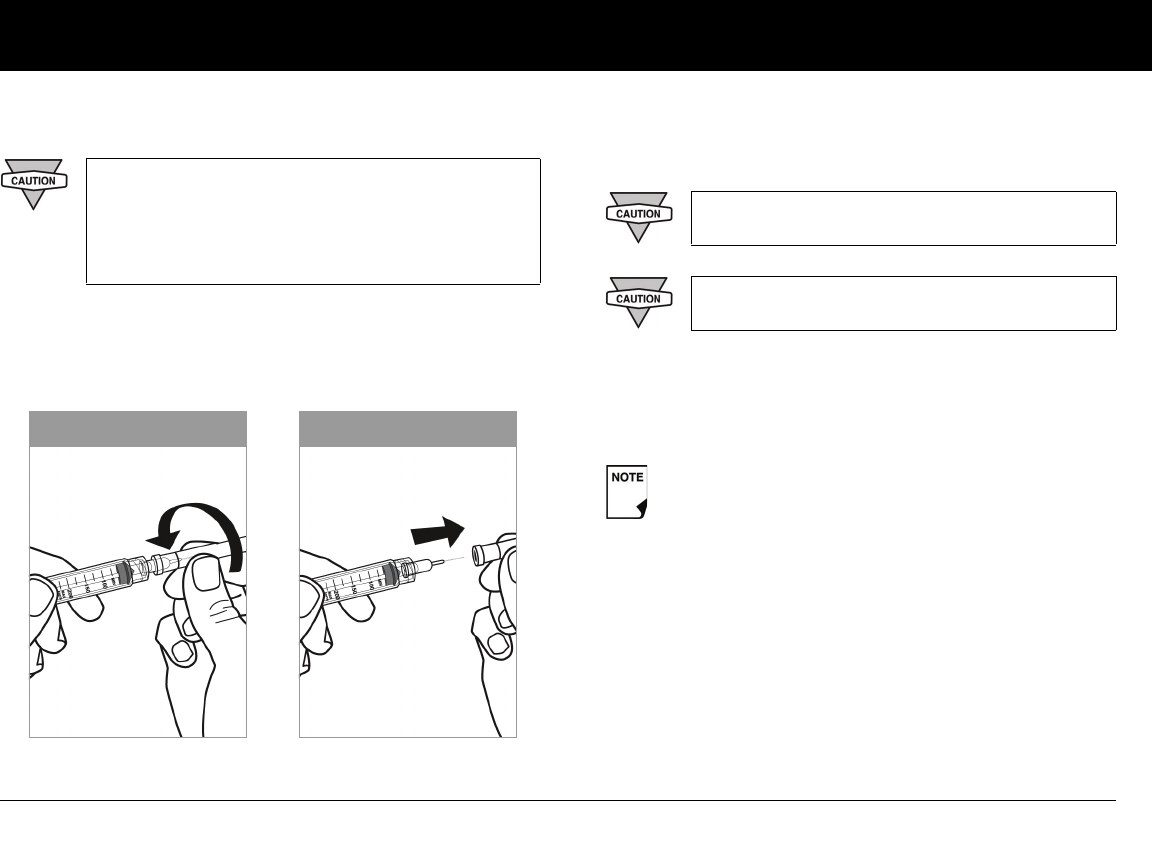
Using the OmniPod
47
5
Fill a new OmniPod
1. Use an alcohol prep swab to clean the top of the insulin vial,
then discard the prep swab.
2. Securely twist the fill needle onto the syringe (Figure 5-7).
3. Pull outward to remove the protective cap from the needle
(Figure 5-8). Save the cap; you will need it later.
4. Determine the amount of insulin you need to insert into the
Pod. For example, if you will use this Pod for 72 hours, you
need enough insulin to last you 72 hours. Your healthcare
provider will help you determine the correct amount.
5. Draw air into the syringe up to the amount of insulin you
want.
6. Insert the needle into the insulin vial and inject the air. This
makes it easier to withdraw insulin from the vial.
Before filling an OmniPod with insulin, ensure that
the Pod is above 50° Fahrenheit. If the Pod has been
exposed to temperatures below 50°, then allow the
Pod to be brought back to room temperature before
filling it with insulin.
Figure 5-7 Figure 5-8
Use care after removing the needle cap and
exposing the fill needle.
Only use room temperature insulin when filling
the OmniPod.
The Pod requires a minimum of 85 units of insulin to
begin operation.
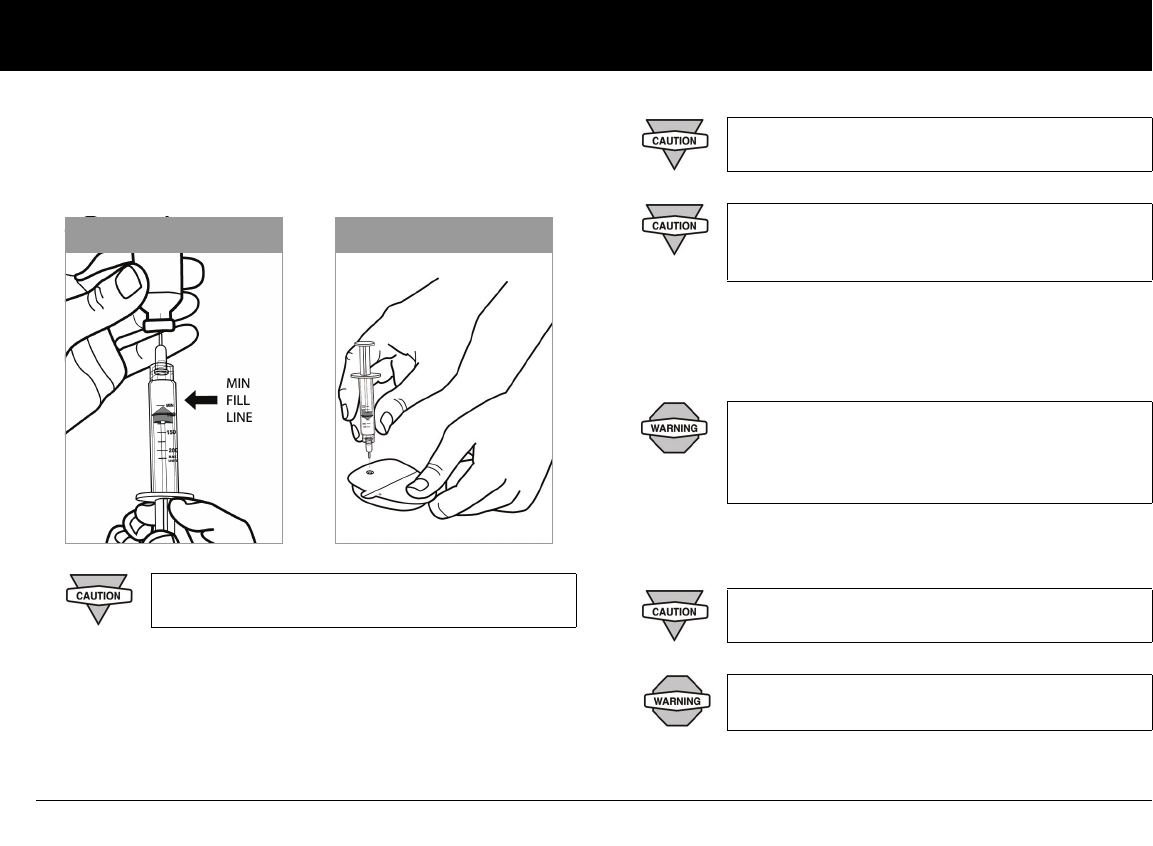
Using the OmniPod
48
5
7. Turn the vial and syringe upside down. Withdraw insulin from
the vial into the syringe, expelling any air bubbles. Fill at least
to the MIN (minimum) fill line (Figure 5-9).
8. Remove the needle from the vial and insert it straight down
into the insulin fill port on the underside of the Pod
(Figure 5-10).
9. Depress the syringe plunger to completely empty the insulin
into the Pod. The Pod will beep, indicating that the System is
ready to proceed to the next step.
10. Remove the needle from the insulin fill port. The port is self-
sealing; insulin will not leak after the needle is removed.
Avoid using insulin from more than one vial,
which may introduce air into the syringe.
Figure 5-9 Figure 5-10
To ensure proper fill, do not insert fill syringe at an
angle into the fill port.
Do not use any other type of needle or filling
device besides the syringe provided with each
Pod.
NEVER use a Pod if you hear a crackling noise or
feel resistance when you depress the plunger.
These conditions can result in underdelivery of
insulin.
Do not insert the fill syringe into the fill port more
than once.
NEVER inject air into the fill port. Doing so may
result in unintended or interrupted insulin delivery.
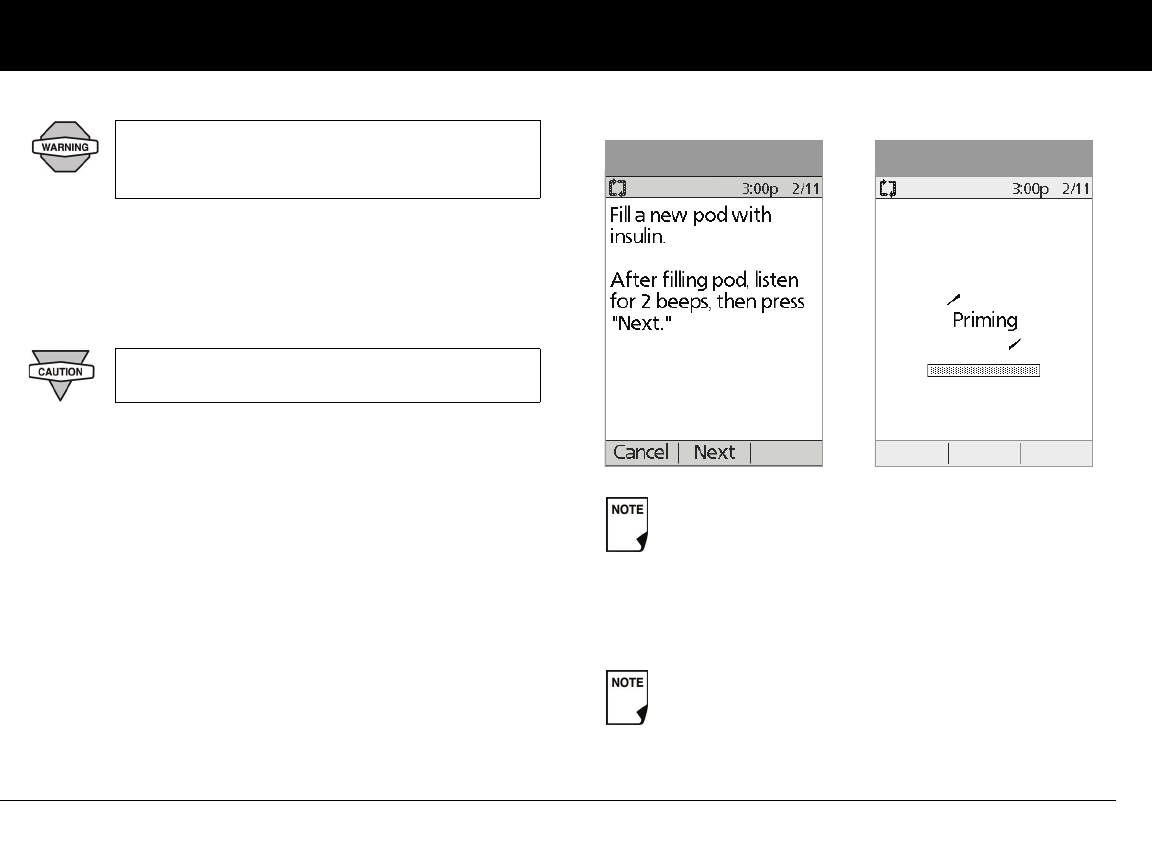
Using the OmniPod
49
5
11. Place the protective cap back on the needle and remove the
needle from the syringe.
12. Place the capped needle in a sharps container. Dispose of
used needles according to local waste disposal regulations.
13. After you fill the OmniPod, the Pod will beep twice. After you
hear the beeps, press Next (Figure 5-11).
The Pod will only beep if you have filled it with at least 85 units
of insulin.
If you have filled the Pod with more than 85 units and still do
not hear the 2 beeps, call Customer Support, 800-591-3455
(from outside the United States, 781-457-5098).
14. The System performs a series of safety checks and automati-
cally primes the Pod (Figure 5-12). Once complete, the PDM
beeps, letting you know that the priming and safety checks
were successful.
NEVER inject insulin (or anything else) into the fill
port while the Pod is on your body. Doing so may
result in unintended or interrupted insulin delivery.
The fill syringe is intended for single use only and
should be used only with the OmniPod System.
After filling the Pod with insulin, you should complete
the Pod-change process within 60 minutes. As a
reminder that the Pod has been filled, it will beep
every 5 minutes to indicate that time is passing. If you
do not set up the Pod within 60 minutes, you must
deactivate and discard it.
Once a Pod is activated and communicates with the
PDM, it can only receive commands from that PDM,
not from any other.
Figure 5-11 Figure 5-12
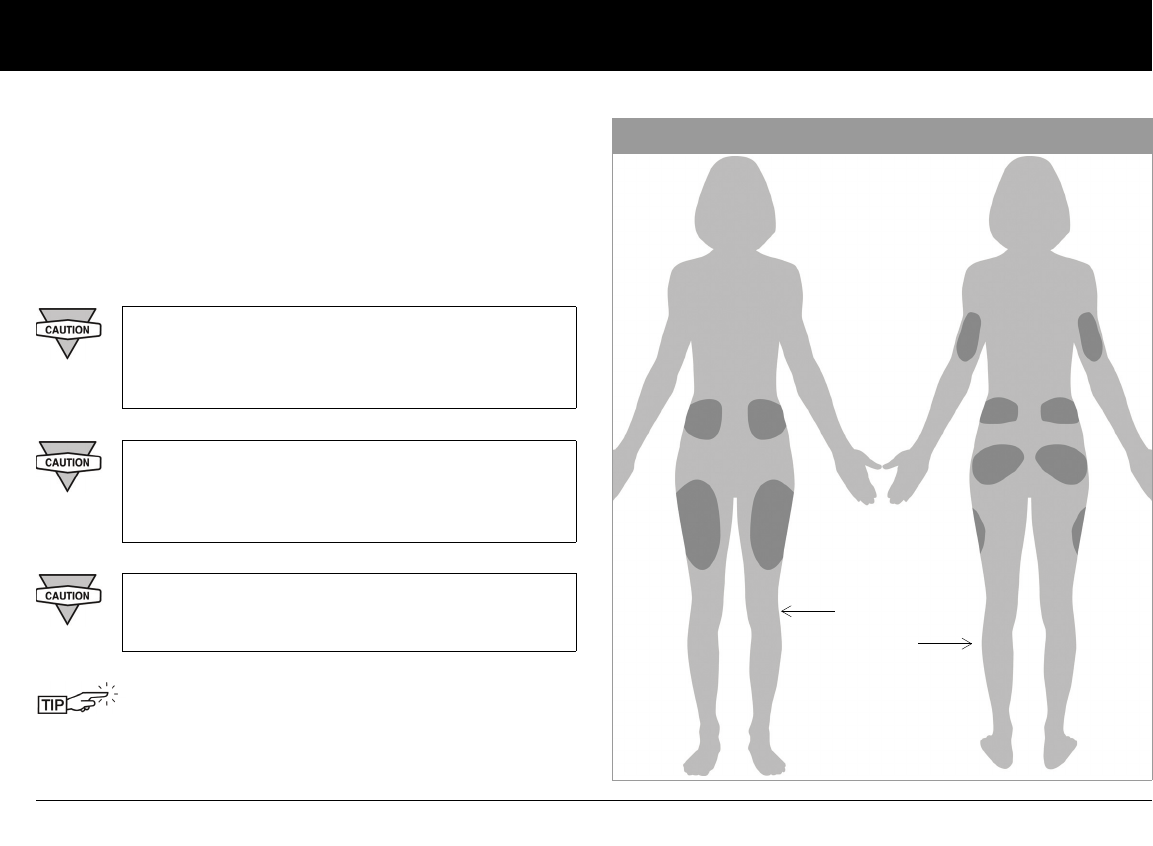
Using the OmniPod
50
5
Select the infusion site
Before applying a new Pod, you must first select an appropriate
infusion site. Due to ease of access and viewing, the abdomen is
often used. Your healthcare provider may suggest other poten-
tial sites that, like the abdomen, typically have a layer of fatty
tissue, such as the hip, back of upper arm, upper thigh, or lower
back (Figure 5-13, and Figure 5-14 on the following page).
Avoid sites where belts, waistbands, or tight clothing
may rub against, disturb, or dislodge the Pod. Also
avoid sites where the Pod will be affected by folds of
skin.
Change the site each time you apply a new Pod. A
new infusion site should be at least 1" away from the
last site. (Using the same location repeatedly may
reduce insulin absorption.)
Do NOT apply the Pod within 2" of your navel or over
a mole or scar, where insulin absorption may be
reduced.
To help avoid condensation from occurring in the
viewing window, make sure both your Pod and your
insulin are at room temperature.
Figure 5-13
Front
Back
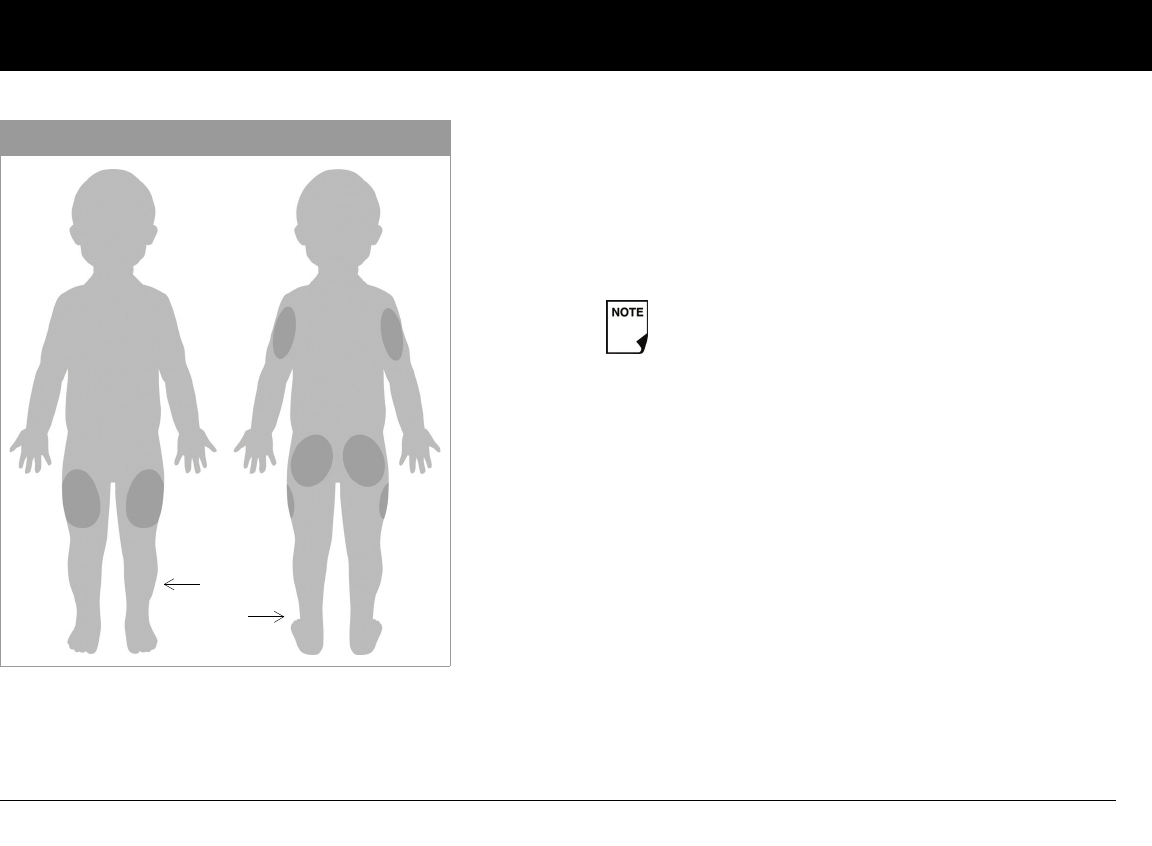
Using the OmniPod
51
5
Prepare the infusion site
You can reduce the risk of infection at the infusion site by follow-
ing aseptic technique and disinfecting the infusion site. Before
applying a new Pod, always:
1. Wash hands with soap and water.
2. Use soap to wash the infusion site.
3. Dry the site with a clean towel.
4. Use an alcohol prep swab to disinfect the infusion site. Start at
the center of the site and gently rub outward in a circular
motion.
5. Let the site air-dry thoroughly. Do not blow on the site to dry
it.
Figure 5-14
Front
Back
Antibacterial soap may irritate skin, especially at the
infusion site. Ask your healthcare provider how to
treat any skin irritation.
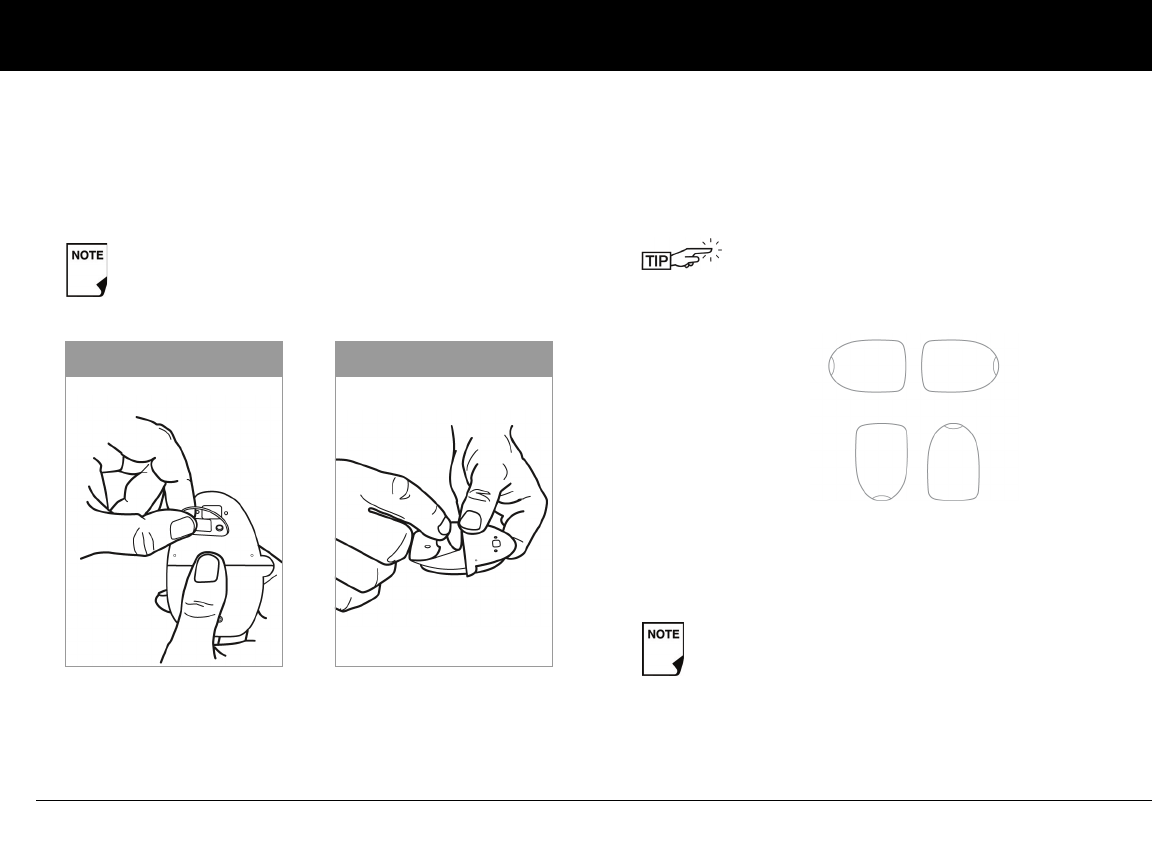
Using the OmniPod
52
5
Apply the new OmniPod
Prepare the Pod for applying to your infusion site:
1. To remove the needle cap on the underside of the Pod, pull it
upward (Figure 5-15).
2. Using the pull tabs, remove and discard the white paper
backing from the adhesive tape (Figure 5-16).
3. Apply the Pod to the prepared infusion site. Press firmly to
secure it to your skin.
When you remove the needle cap, a few drops of
insulin should be visible at the end of the needle.
Figure 5-15 Figure 5-16
For the Pod to work best, apply it:
1. Crosswise or at a slight angle on your abdo-
men, hip, upper back, or buttocks (see A)
2. Up and down or at a slight angle on your
upper arm or thigh (see B)
3. At least one inch away from the last site
The OmniPod’s adhesive keeps it securely in place for
up to 3 days. However, if necessary, several products
are available to enhance adhesion. Ask your health-
care provider about these products. Avoid getting
body lotion, creams, or oils near the infusion site;
these products may loosen the adhesive.
A:
B:
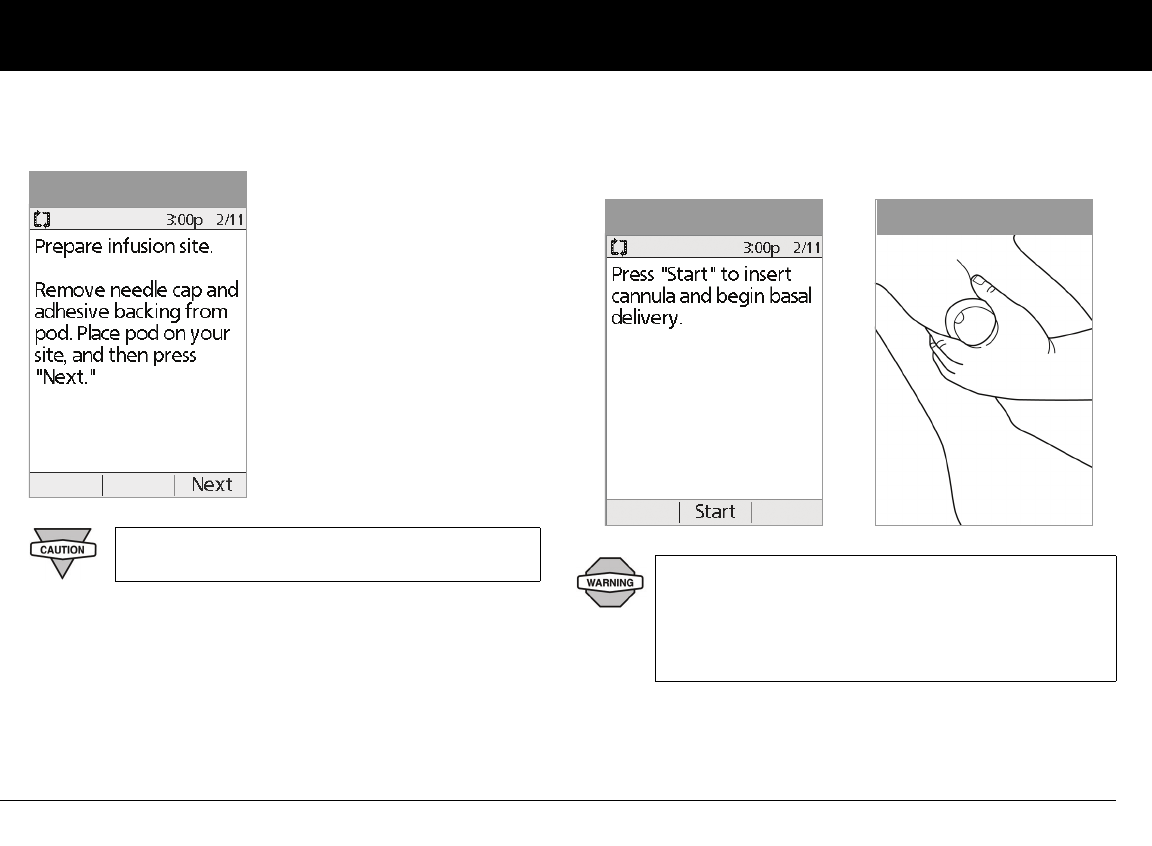
Using the OmniPod
53
5
4. After you securely apply the Pod, press Next (Figure 5-17). Insert cannula and begin insulin delivery
1. To insert the soft cannula, press Start (Figure 5-18).
The adhesive is designed for one-time use. Once
removed, a Pod cannot be reapplied.
Figure 5-17
If you are applying a Pod in a place that does not have
a lot of fatty tissue or is very lean, pinch the skin
around the Pod (Figure 5-19) after you press Start ,
and hold it until the cannula inserts. Occlusions may
result in lean areas if you do not use this technique.
Figure 5-18 Figure 5-19
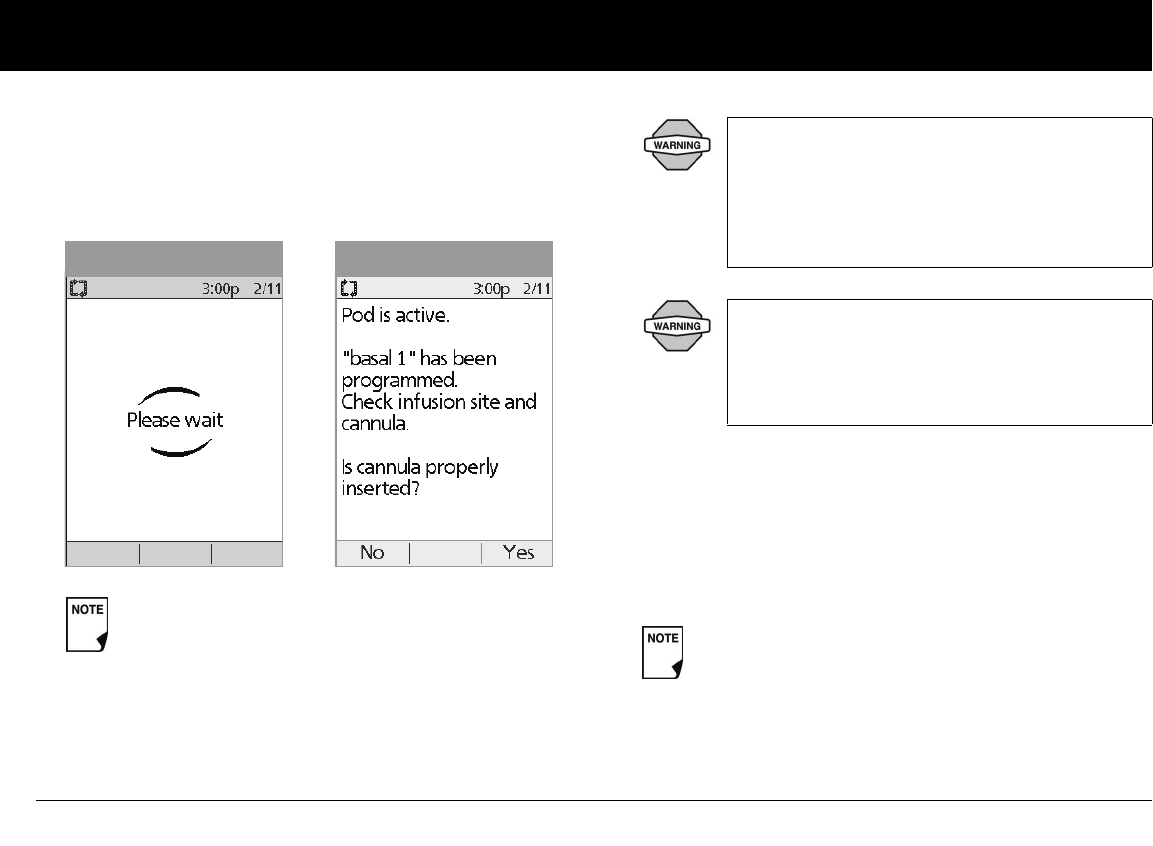
Using the OmniPod
54
5
The OmniPod automatically inserts the soft cannula below
your skin. It takes a few seconds to complete the insertion
process. Once the cannula is inserted, the Pod delivers a
prime bolus to fill the cannula with insulin (Figure 5-20).
Once the soft cannula is inserted, the PDM indicates that the
Pod is active (Figure 5-21).
Figure 5-21 also displays a reminder to check the infusion site
and cannula. Make sure the Pod is securely attached to your
skin. You can see the cannula through the small viewing
window on the Pod.
You will hear a click when the cannula inserts.
Figure 5-20 Figure 5-21
Check the infusion site after insertion to ensure
that the cannula was properly inserted. It is also a
good idea to check your blood glucose about
two hours after after each Pod change and to
check the infusion site periodically. If the cannula is
not properly inserted, hyperglycemia may result.
If you observe blood in the cannula, check your
blood glucose more frequently to ensure insulin
delivery has not been affected. If you experience
unexpected elevated blood glucose levels,
change your Pod.
To help avoid condensation from occurring in the
viewing window, make sure both your Pod and your
insulin are at room temperature.
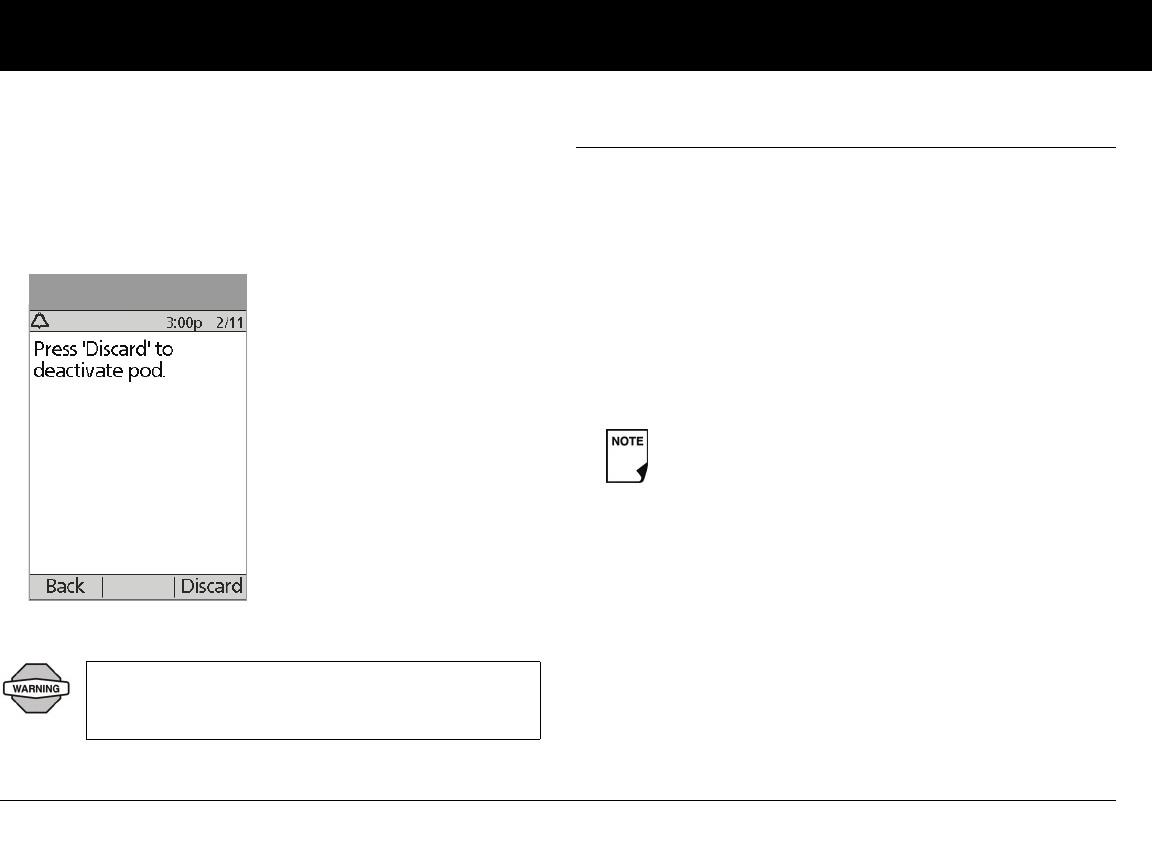
Using the OmniPod
55
5
2. Press Ye s if you can see that the cannula is properly inserted.
The PDM returns to the Status screen.
Or press No if you see a problem with the cannula. The PDM
instructs you to deactivate the new Pod (Figure 5-22). Press
Discard to restart the process with a new Pod.
Or press Back to return to the previous screen.
■ Check Pod Status
To check Pod status, if the PDM is turned off, press and hold the
Power button to display the Status screen. If the PDM is on,
press Back until you reach the Status screen. (If you press and
hold the Power button, you will turn off the PDM instead.) Or,
from the Home screen, press Status.
The PDM automatically checks the status of the Pod. The PDM
then displays the current reservoir volume, PDM battery level,
last blood glucose, last bolus dose, active basal program, and any
alarm conditions. See Chapter 6, Using the Personal Diabetes
Manager, for details of what you see on the Status screen.
If the Pod goes into hazard alarm condition and the PDM is
unable to communicate with it to turn off the alarm, you can turn
it off manually. See the end of Chapter 11, Communication Fail-
ures, for instructions.
NEVER inject insulin (or anything else) into the
fill port while the Pod is on your body. Doing so may
result in unintended or interrupted insulin delivery.
Figure 5-22
Once a Pod is activated and communicates with the
PDM, it can only receive commands from that PDM,
not from any other.
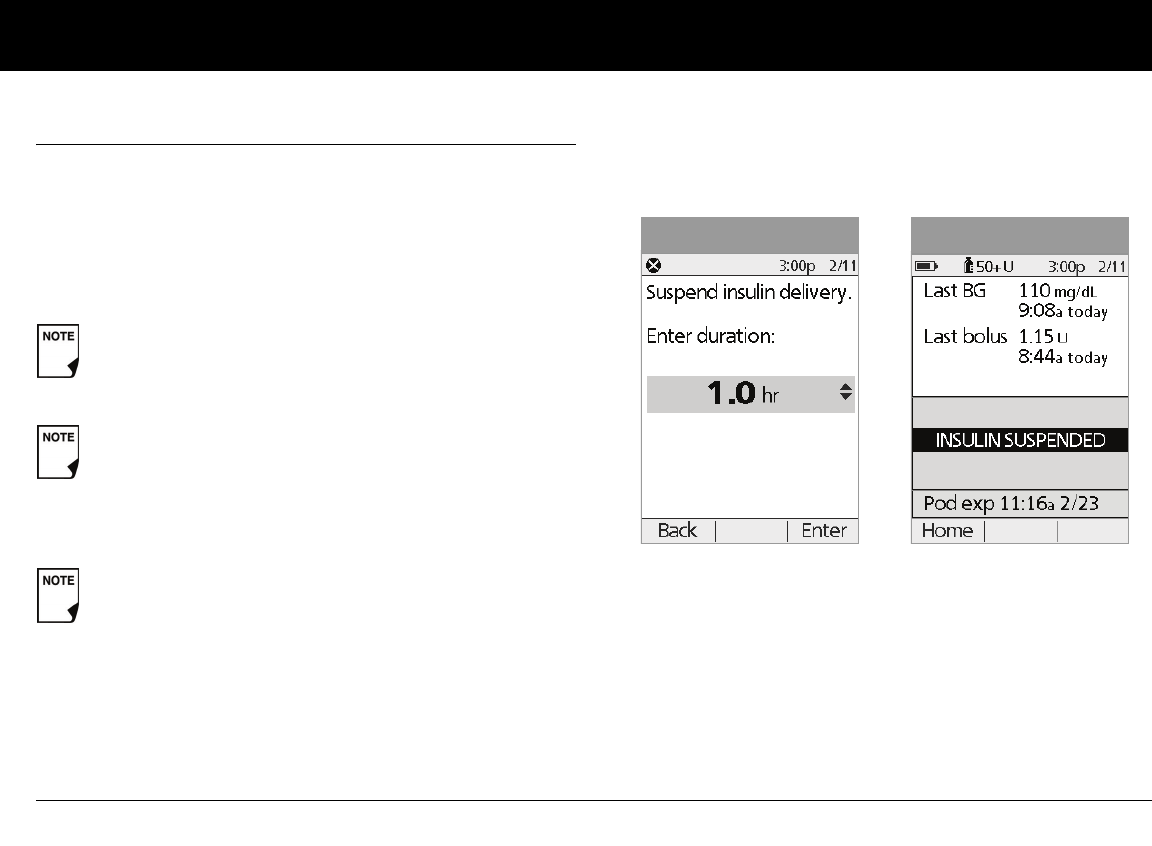
Using the OmniPod
56
5
■ Suspend Insulin Delivery
Sometimes you may need to briefly stop insulin delivery (for
example, when editing an active basal program or changing the
time or date). The OmniPod System lets you suspend all insulin
delivery for up to 2 hours. While in suspension, the Pod beeps
once every 15 minutes, reminding you that insulin delivery is
suspended.
1. On the Home screen, use the Up/Down Controller buttons
to choose Suspend; then press Select.
2. Enter how long you want to stop all insulin delivery, from 30
minutes to 2 hours in 30-minute increments (Figure 5-23),
then press Enter.
3. Press Confirm to confirm that you want to halt all insulin
delivery (basal and bolus). The PDM beeps and an on-screen
message lets you know that insulin delivery is indeed sus-
pended (Figure 5-24).
The Pod beeps every 15 minutes until the end of the suspen-
sion period. The Status screen shows INSULIN SUSPENDED
until you resume insulin delivery (see “Resume Insulin Deliv-
ery” below).
At any time during a suspension period, press Resume
to resume the basal program that was running when you
suspended insulin delivery.
Extended boluses and temporary basal rates will be can-
celled when you suspend insulin delivery.
If a temporary basal or extended bolus is in process, the
menu item is Suspend/cancel instead, and options for
canceling these programs also appear in the menu. If
these options appear, choose Suspend insulin delivery.
Figure 5-23 Figure 5-24
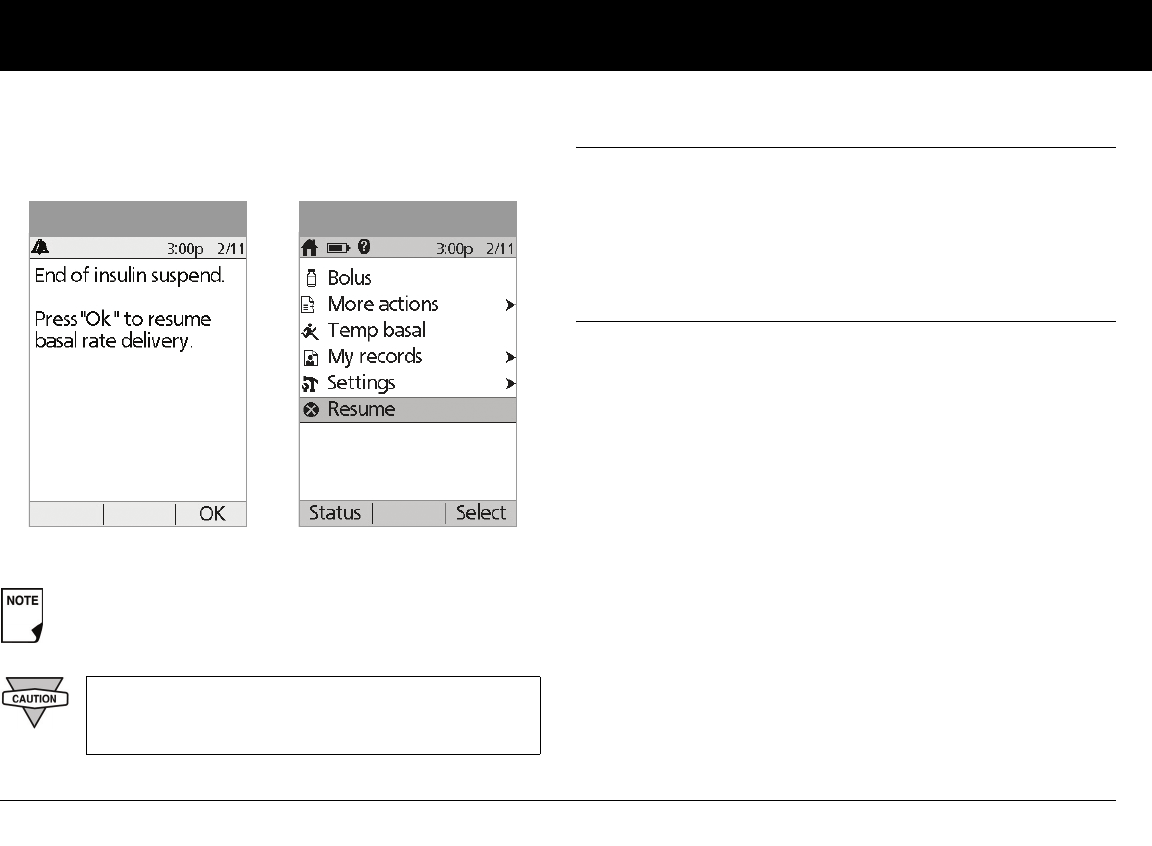
Using the OmniPod
57
5
At the end of the suspend time, a Pod Advisory alarm occurs
(Figure 5-25).
4. To resume your programmed basal rate, press OK.
■ Resume Insulin Delivery
1. On the Home screen, use the Up/Down Controller buttons
to choose Resume (Figure 5-26); then press Select.
2. Press Confirm to restart the basal program for that time seg-
ment.
■ Avoid Infusion Site Infections
• Always wash your hands and use aseptic technique to pre-
pare the infusion site before applying a Pod.
• Do not apply a Pod to any area of skin with an active infec-
tion. If you are unsure whether to use a specific site, ask your
healthcare provider.
• At least once a day, use the Pod’s viewing window to check
the site for signs of infection and to confirm that the soft can-
nula is securely in place.
• Be aware of the signs of infection, including pain, swelling,
redness, discharge, or heat at the site. If you suspect an infec-
tion, immediately remove the Pod and apply a new one in a
different location. Then call your healthcare provider.
• Change the Pod at least once every 2–3 days, or as instructed
by your healthcare provider.
The Advisory alarm repeats every 15 minutes until you
press OK.
Insulin delivery will not resume until you press OK. If
you do not press OK to resume insulin delivery, you
could develop hyperglycemia (high blood glucose).
Figure 5-25 Figure 5-26
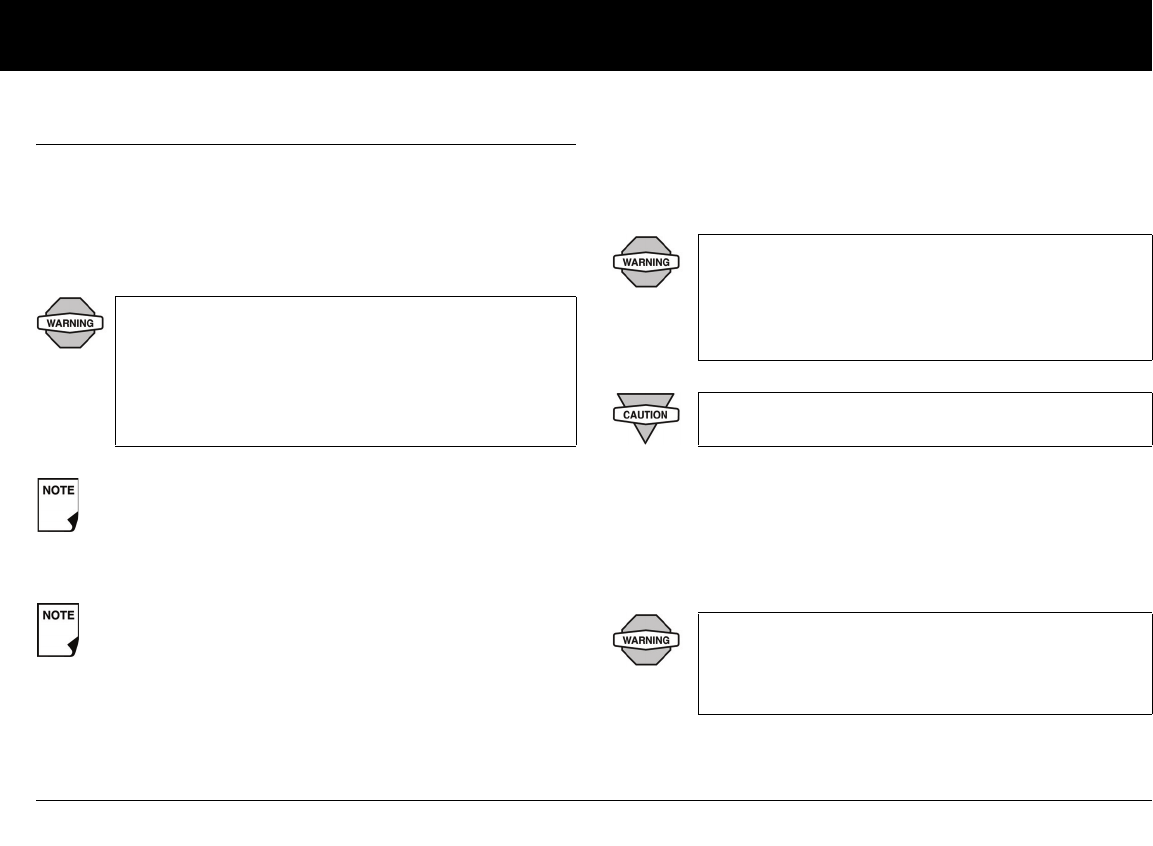
Using the OmniPod
58
5
■ Get the Most From Your Pod
Avoid extreme temperatures
The OmniPod’s operating temperature is between 40°F and
104°F (between 5°C and 40°C). Under normal circumstances,
your body temperature will keep the Pod well within this range.
Water and your OmniPod
The OmniPod is watertight to a depth of 8 feet for up to 30 min-
utes (IPX8). After exposure to water, rinse off the Pod with clean
water and gently dry it with a towel.
Safe storage
Store unopened OmniPods in a cool, dry place. Extreme heat or
cold can damage Pods and cause them to malfunction. If Pods
are exposed to extreme temperatures, allow them to return to
room temperature before use.
Do NOT expose a Pod to direct sunlight for long peri-
ods of time. It is recommended that you remove your
Pod prior to using hot tubs, whirlpools, or saunas.
These conditions could expose the Pod to extreme
temperatures and may also affect the insulin inside
the Pod.
Remember to check your blood glucose levels frequently
before and after removing the Pod. Check with your
healthcare provider for guidelines on removing the Pod
for extended periods.
Insulin degrades at high temperatures and will freeze
near 32°F (0°C). Check the insulin manufacturer’s instruc-
tions for use.
Do not expose your OmniPod to water at depths
greater than 8 feet or for more than 30 minutes.
Check often to make sure the Pod and soft cannula
are securely attached and in place. If the cannula is
not properly inserted, hyperglycemia may result.
The PDM is not waterproof. Do not place it in or near
water.
Pods are sterile unless their packaging is opened or
damaged. Do NOT apply or use a Pod if its sterile
packaging is opened or damaged, as this may
increase the risk of infection or serious injury.
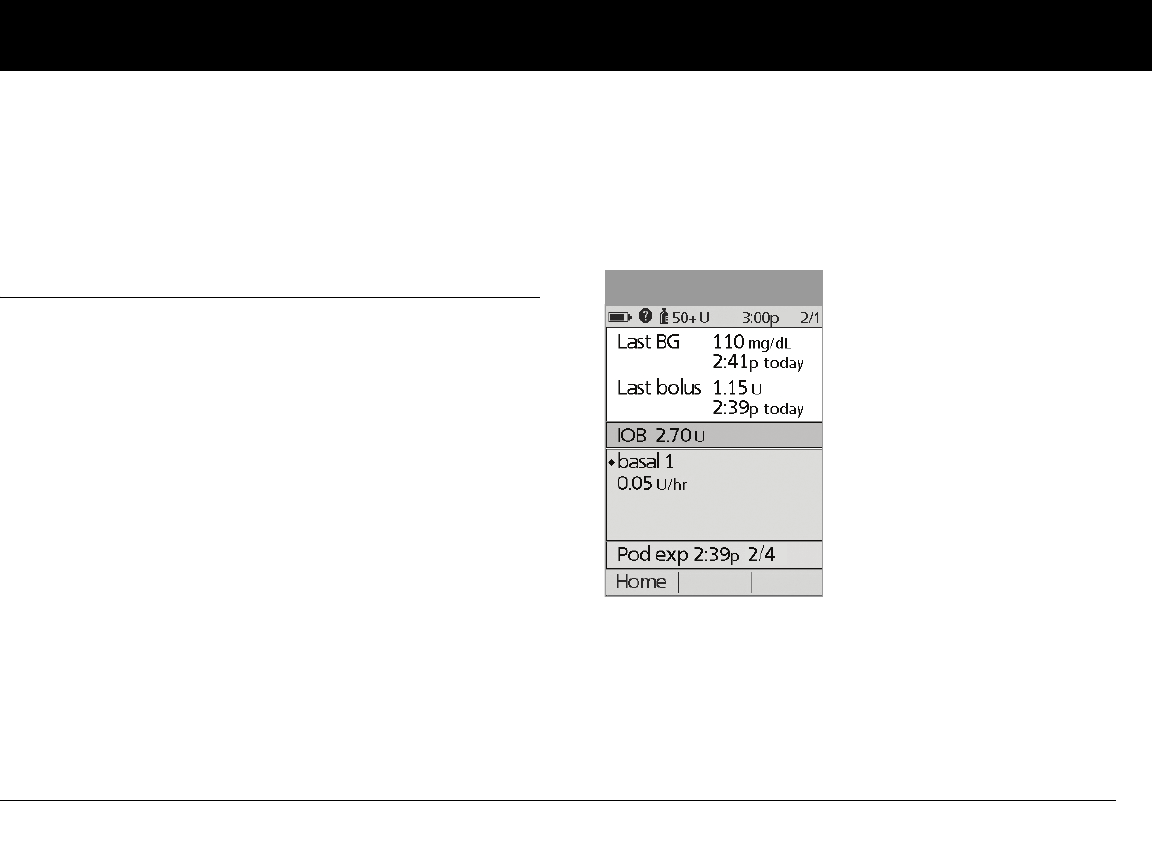
59
CHAPTER 6
Using the Personal Diabetes Manager
■ The Status Screens
When a Pod is active and the PDM is turned on, the PDM estab-
lishes communication with the Pod to obtain a status check.
During the status check, the PDM collects information from the
Pod about bolus deliveries, active basal programs, and Pod expi-
ration. The information obtained is then displayed in the status
screen, which shows the System’s current operating status.
The Status screen (Figure 6-1) displays:
• Time, date, and result of last blood glucose checked or
entered manually
• Time, date, and total amount of last bolus delivered
• Amount of insulin on board, if suggested bolus calculator is in
use
• Name and rate of active basal program or temp basal
program
• “Ext bolus,” the amount of insulin, and the delivery time
remaining if an extended bolus is being delivered
• “INSULIN SUSPENDED” if insulin delivery has been
suspended
• Time and date when the Pod will expire
Figure 6-1
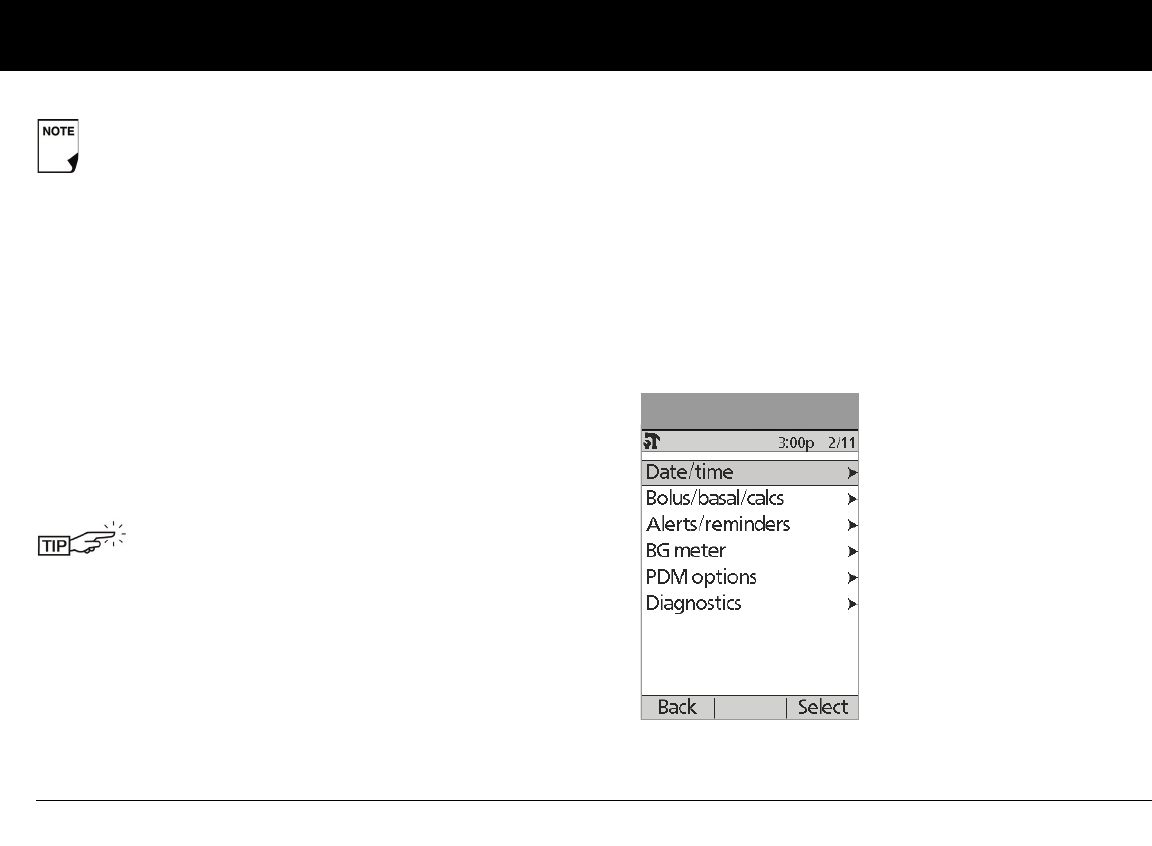
Using the Personal Diabetes Manager
60
6
Insulin gauge and display
One of the important icons on the Status screen is the insulin
gauge at the top of the screen. It indicates how much insulin is
left in the Pod’s reservoir. As the reservoir empties, the icon
changes to indicate the amount of insulin remaining.
Next to the insulin gauge, the PDM displays the number of units
remaining in the Pod. As long as more than 50 units remain, the
gauge displays “50+ U.” Once the reservoir volume drops to 50
units, the gauge counts down unit by unit. When the volume
falls below 5 units, the display changes to “LOW.”
PDM settings
You can adjust the PDM settings to meet your individual needs.
1. From the Status screens, press Home.
2. Use the Up/Down Controller buttons to choose Settings;
then press Select.
3. Choose System setup, then press Select.
4. Choose an option from the System setup list, then press
Select (Figure 6-2). Check with your healthcare provider
before making any changes.
If an OmniPod has not yet been activated (as during Pod
changes), the screen displays “No active Pod. Would you
like to activate a Pod now?” (See Chapter 5, Using the
OmniPod, for details on activating a Pod.)
Regularly checking the insulin gauge enables you
to plan Pod changes easily. For example, if you
know you will need approximately 20 units during
your work day and the insulin gauge shows only 17
units remaining, you can either take a new Pod with
you or change it before you leave for the day.
Figure 6-2
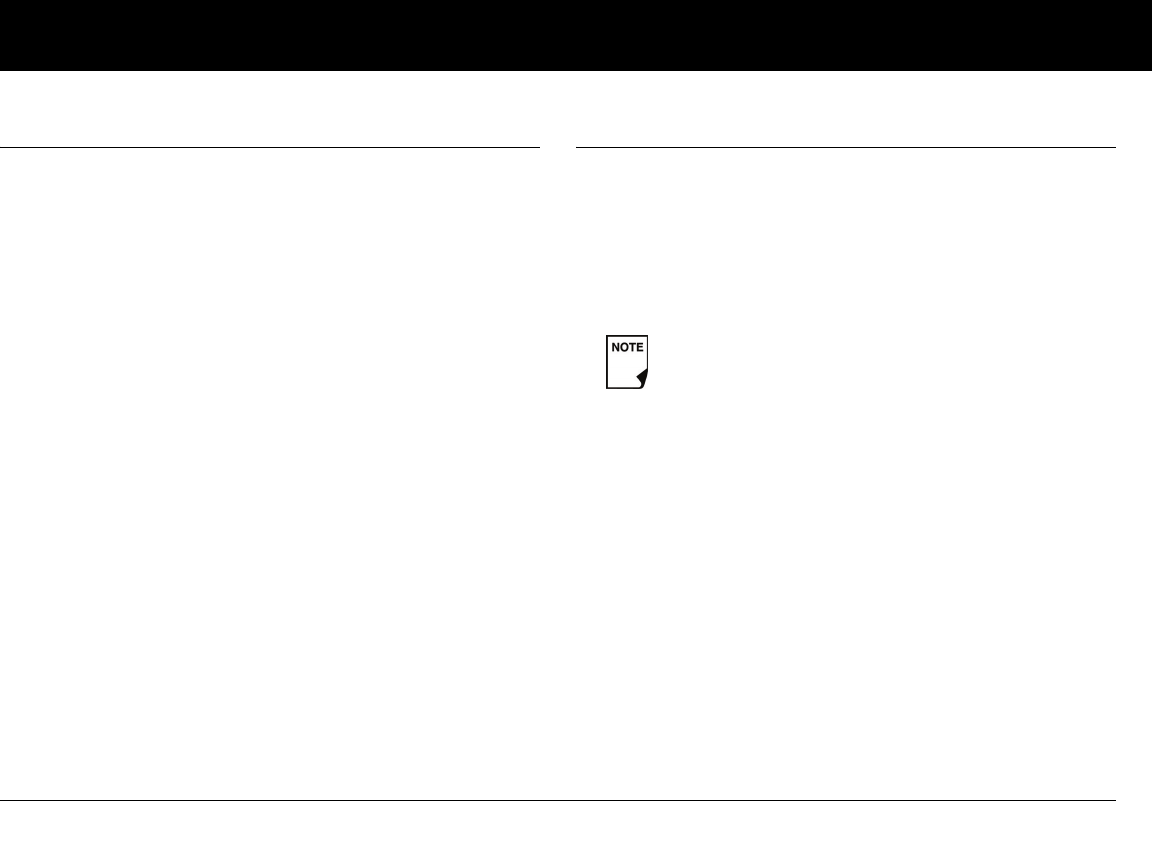
Using the Personal Diabetes Manager
61
6
■ The System Setup Menu
The System setup menu lets you personalize the settings that
control the OmniPod System. These include:
• Date and time
•Bolus doses, basal rates, and bolus calculator settings
• Alerts and reminders
• Blood glucose meter settings
• Blood glucose tags
• PDM options
• Diagnostics
You and your healthcare provider entered initial System settings
using the Setup Wizard (see Chapter 2, Getting Started). After
setup, you can use the System setup menu to customize or
change those settings, as described in this chapter.
■ Reset the Date or Time
Occasionally, you need to change date and time settings (for
example, to adjust for daylight savings time or after resetting the
PDM). As a safety feature, you can change date and time settings
only when the Pod is deactivated or when insulin delivery is sus-
pended (see Chapter 5, Using the OmniPod).
1. Suspend insulin delivery.
2. On the Home screen, use the Up/Down Controller buttons
to choose Settings; then press Select.
3. Choose System setup, then press Select.
4. Choose Date/time, then press Select.
5. Choose either Time or Date, then press Edit.
Reset the time
1. To enter the current time, press the Up/Down Controller
buttons. Press and hold the button to increase or decrease
the time faster.
If you are changing the Pod, you can reset the date or
time without suspending by changing the date or
time before activating the new Pod.
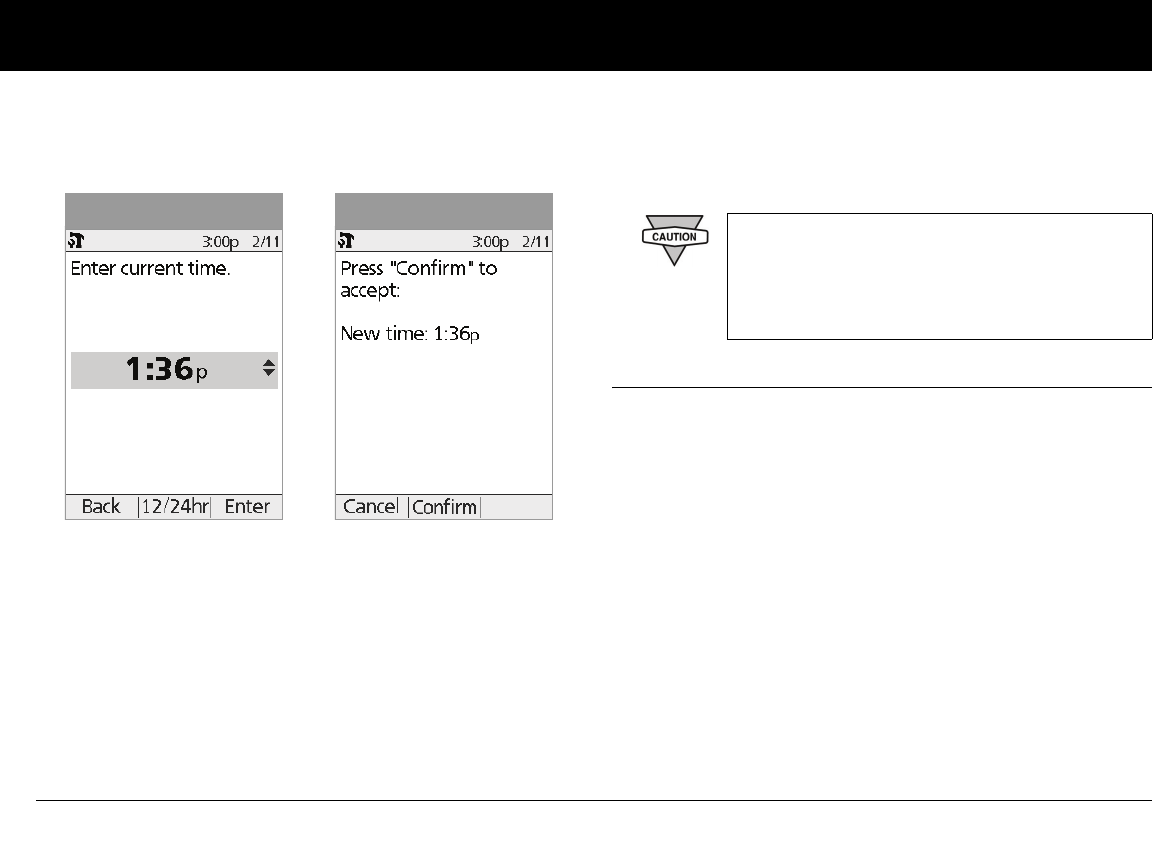
Using the Personal Diabetes Manager
62
6
2. Press 12/24 hr to choose either a 12-hour or 24-hour clock,
then press Enter (Figure 6-3).
3. Press Confirm to accept the new time (Figure 6-4).
Reset the date
1. Press the Up/Down Controller buttons to choose the cur-
rent year, then press Next.
2. Choose the current month, then press Next.
3. Choose the current day, then press Next.
4. Choose the date format to be displayed by the PDM, then
press Select.
5. Press Confirm to accept the new date and format.
■ Change Bolus and Basal Settings
You and your healthcare provider entered initial bolus and basal
System settings using the Setup Wizard. Using the System setup
menu, you can edit all the OmniPod System bolus and basal set-
tings as your needs change. Check with your healthcare provider
before making any changes.
1. On the Home screen, use the Up/Down Controller buttons
to choose Settings; then press Select.
2. Choose System setup, then press Select.
3. Choose Bolus/basal/calcs, then press Select.
Figure 6-3 Figure 6-4 If you suspended insulin delivery to change the
time or date, remember to resume insulin deliv-
ery. If you changed the time or date during the
Pod change process, remember to activate a new
Pod.
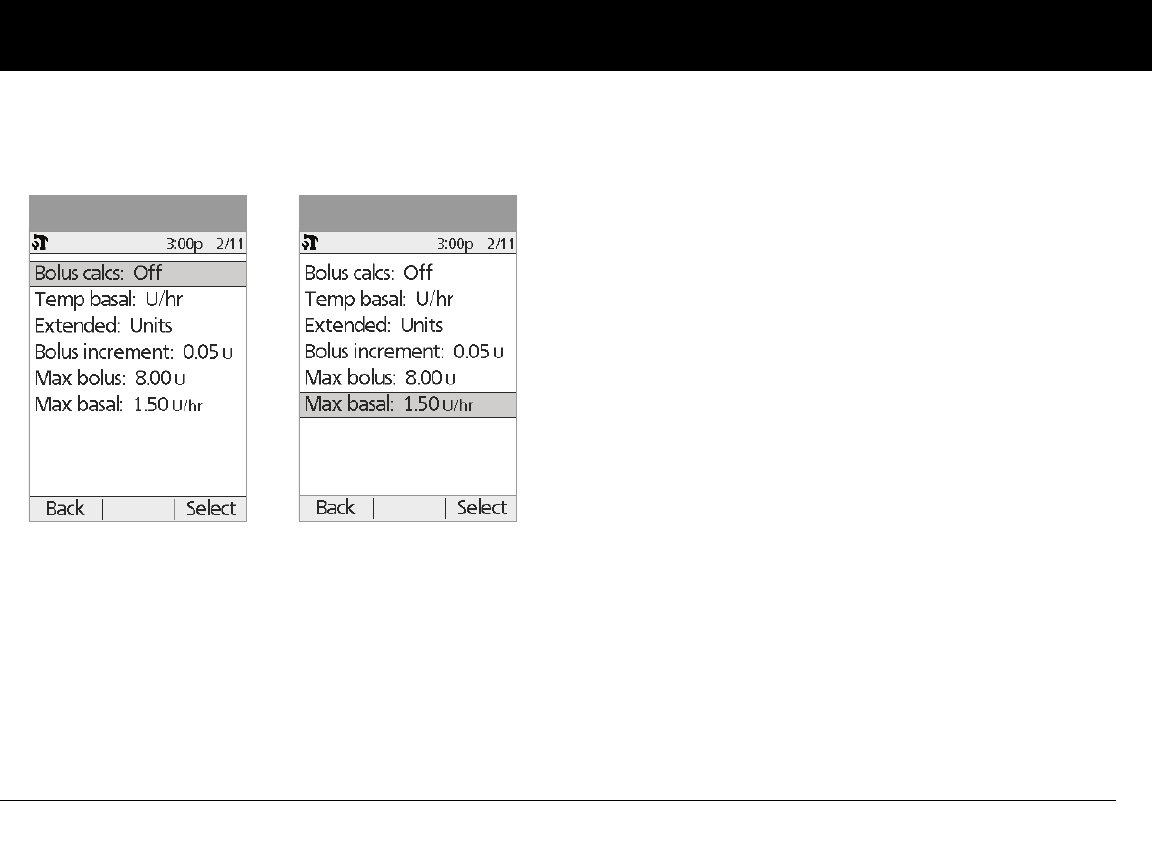
Using the Personal Diabetes Manager
63
6
4. Choose one of the options (Figure 6-5a and Figure 6-5b), then
press Select. Each option is described below.
Bolus calcs
When the suggested bolus calculator is turned Off and you want
to turn it On, press On and follow these steps:
1. Target BG and correct-above value—You can edit existing
time segments and add segments, up to a total of four.
a. To edit an existing target BG time segment, choose the
segment, then press Edit. Use the Up/Down Controller
buttons to choose a new start time, end time, target BG
value, and correct-above value (correction threshold). Press
Next after each entry.
b. To add a segment, choose [add new], then press New.
Use the Up/Down Controller buttons to choose a start
time, end time, target BG value, and correct-above value
(correction threshold). Press Next after each entry.
c. When you have completed all the time segments you
want, press Done, then Save.
2. Min BG for calcs (minimum blood glucose value allowed for
calculating boluses)—Use the Up/Down Controller buttons
to enter a new minimum BG, then press Next.
Figure 6-5a Figure 6-5b
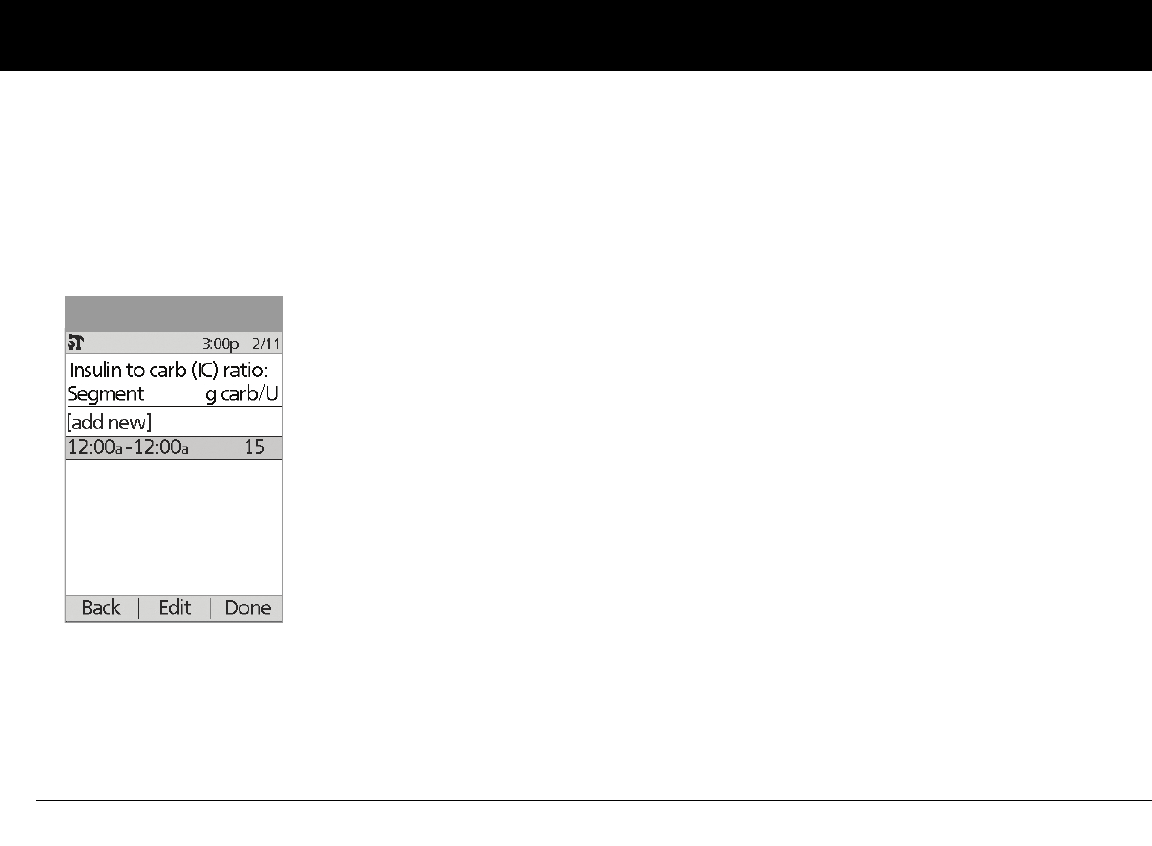
Using the Personal Diabetes Manager
64
6
3. Insulin to carb (IC) ratio—You can edit existing time seg-
ments and add segments, up to a total of four.
a. To edit an existing IC ratio time segment, choose the seg-
ment, then press Edit (Figure 6-6). Use the Up/Down
Controller buttons to choose a new start time, end time,
and IC ratio. Press Next after each entry.
b. To add a segment, choose [add new], then press New.
Use the Up/Down Controller buttons to choose a start
time, end time, and IC ratio. Press Next after each entry.
c. When you have completed all time segments, press
Done, then Save.
4. Correction factor—You can edit existing time segments and
add segments, up to a total of four.
a. To edit an existing correction factor time segment, choose
the segment, then press Edit. Use the Up/Down Control-
ler buttons to choose a new start time, end time, and cor-
rection factor. Press Next after each entry
b. To add a segment, choose [add new], then press New.
Use the Up/Down Controller buttons to choose a start
time, end time, and correction factor. Press Next after
each entry.
c. When you have completed all time segments, press
Done, then Save.
5. Reverse correction—Choose On or Off, then press Next.
6. Insulin action (duration)—Use the Up/Down Controller
buttons to choose a duration of insulin action, then press
Done.
7. Press OK.
Figure 6-6
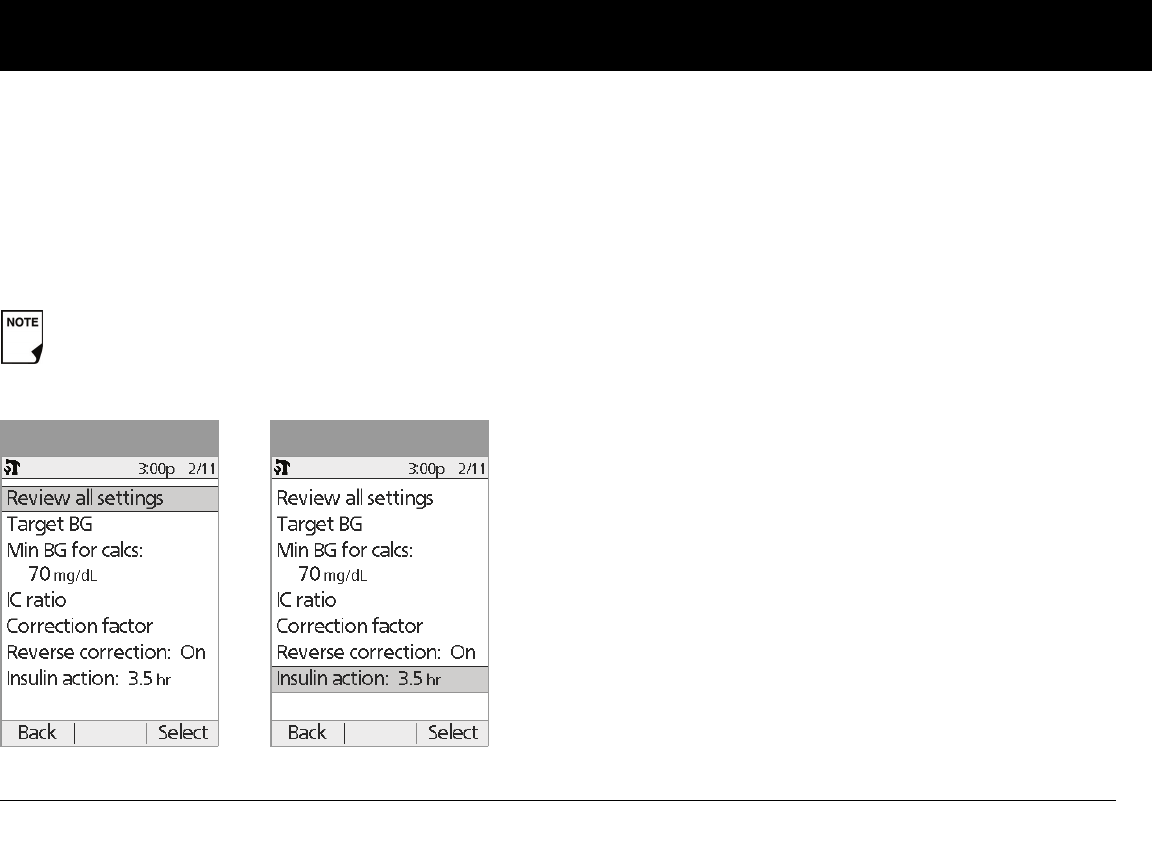
Using the Personal Diabetes Manager
65
6
Ratios/factors/targets
When the suggested bolus calculator is turned On, you can view
and change all the settings using the Ratios/factors/targets
menu option. Choose Review all settings, then press Select
(Figure 6-7a ). Or choose one setting from the menu, then press
Select (Figure 6-7b). The steps are the same whether you choose
all settings or individual ones.
1. Target BG and correct-above value—You can edit existing
segments and add segments, up to a total of four.
a. To edit an existing target BG time segment, choose the
segment, then press Edit. Use the Up/Down Controller
buttons to choose a new start time, end time, target BG
value, and correct-above value (correction threshold).
Press Next after each entry.
b. To add a segment, choose [add new], then press New.
Use the Up/Down Controller buttons to choose a start
time, end time, target BG value, and correct-above value
(correction threshold). Press Next after each entry.
c. When you have completed all the time segments you
want, press Done, then Save.
2. Min BG for calcs (minimum blood glucose value allowed for
calculating boluses)—Use the Up/Down Controller buttons
to enter a new minimum BG, then press Enter.
3. Insulin to carb (IC) ratio—You can edit existing time seg-
ments and add segments, up to a total of four.
a. To edit an existing IC ratio time segment, choose the seg-
ment, then press Edit. Use the Up/Down Controller but-
tons to choose a new start time, end time, and IC ratio.
Press Next after each entry.
b. To add a segment, choose [add new], then press New.
Use the Up/Down Controller buttons to choose a start
time, end time, and IC ratio. Press Next after each entry.
When the suggested bolus calculator is turned Off, the
Ratios/factors/targets option does not appear in the
Bolus/basal/calcs menu.
Figure 6-7a Figure 6-7b

Using the Personal Diabetes Manager
66
6
c. When you have completed all time segments, press
Done, then Save.
4. Correction factor—You can edit existing time segments and
add segments, up to a total of four.
a. To edit an existing correction factor time segment, choose
the segment, then press Edit. Use the Up/Down Control-
ler buttons to choose a new start time, end time, and cor-
rection factor. Press Next after each entry.
b. To add a segment, choose [add new], then press New.
Use the Up/Down Controller buttons to choose a start
time, end time, and correction factor. Press Next after
each entry.
c. When you have completed all time segments, press
Done, then Save.
5. Reverse correction—Choose On or Off, then press Select.
6. Insulin action (duration)—Use the Up/Down Controller
buttons to choose a duration of insulin action, then press
Enter.
Temp basal
Choose %, U/hr , or Off to set the mode for temporary basal
rates and presets, then press Select.
Extended
Choose %, Units, or Off to set the mode for extended boluses,
then press Select.
Bolus increment
Choose 0.05, 0.10, 0.50, or 1.00 units for bolus increments, then
press Select.
Max bolus
Use the Up/Down Controller buttons to enter the maximum
bolus dose you can take, then press Enter.
Max basal rate
Use the Up/Down Controller buttons to enter the maximum
basal rate you can choose, then press Enter.
Some settings have preset defaults, but all settings
are changeable. See the Appendices for a list of Sys-
tem specifications, including preset default settings.
For additional details on bolus and basal settings,
see Chapter 3, Understanding and Adjusting Basal
Rates, and Chapter 4, Understanding and Deliver-
ing Bolus Doses.
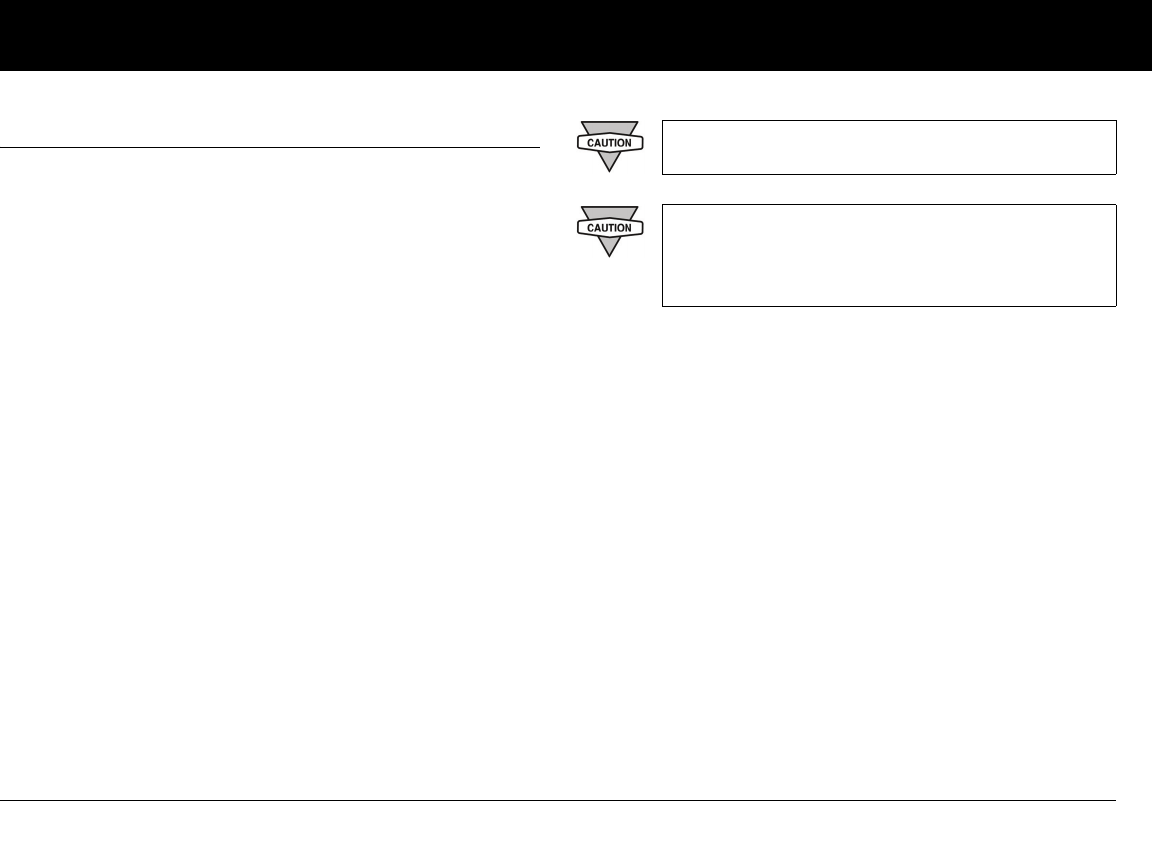
Using the Personal Diabetes Manager
67
6
■ Alerts and Reminders
In addition to automatic safety alarms (see Chapter 10, Errors,
Advisories, and Hazard Alarms), the OmniPod System offers a
number of alerts and reminders that you can set to help you
manage your diabetes. These features are optional. You can turn
alerts and reminders on or off at any time.
Alerts and reminders you can use are:
BG (blood glucose) reminder: Reminds you to check your blood
glucose. Choose from On or Off. The default setting is Off. When
the reminder is on, the PDM asks you each time you enter a bolus
dose whether you want to set a BG reminder, and you can then
choose a time interval, in 1/2-hour increments.
Expiration: Alerts you when the Pod is nearing the expiration
time. Choose an alert period from 1 to 24 hours before expira-
tion, in 1-hour increments. The default setting is 4 hours.
Low reservoir: Alerts you when insulin in the Pod reaches a cer-
tain level, so you can plan ahead to change the Pod. Choose a
level from 10 to 50 units, in 5-unit increments. The default setting
is 10 units.
Auto-off: Alerts you if the PDM does not receive a Pod status
within a predefined period of time. Obtain Pod status by press-
ing and holding the PDM’s Power button. This alert can be
especially reassuring if you are prone to hypoglycemia unaware-
ness. Choose a time period from 1 to 24 hours, in 1-hour
increments, or choose Off. The default setting is Off.
Bolus reminders: Alerts you if you have not delivered a meal
bolus, manually or using the suggested bolus calculator,
between the times you specify. Choose On or Off and choose up
to 6 time segments.
Reminder alerts: Pod beeps when a program is in process (see
Chapter 3, Understanding and Adjusting Basal Rates, and Chap-
ter 4, Understanding and Delivering Bolus Doses, for details).
These include:
• Temporary basal in process
• Extended bolus in process
Choose On or Off. The default setting is On.
Turning the PDM on by inserting a blood glucose
test strip does not send a Pod status to the PDM.
Many hazard alarms (such as Auto-off) will cause
alert escalation and deactivation of the active Pod if
you ignore them. Be sure to respond to all alerts and
alarms when they occur.
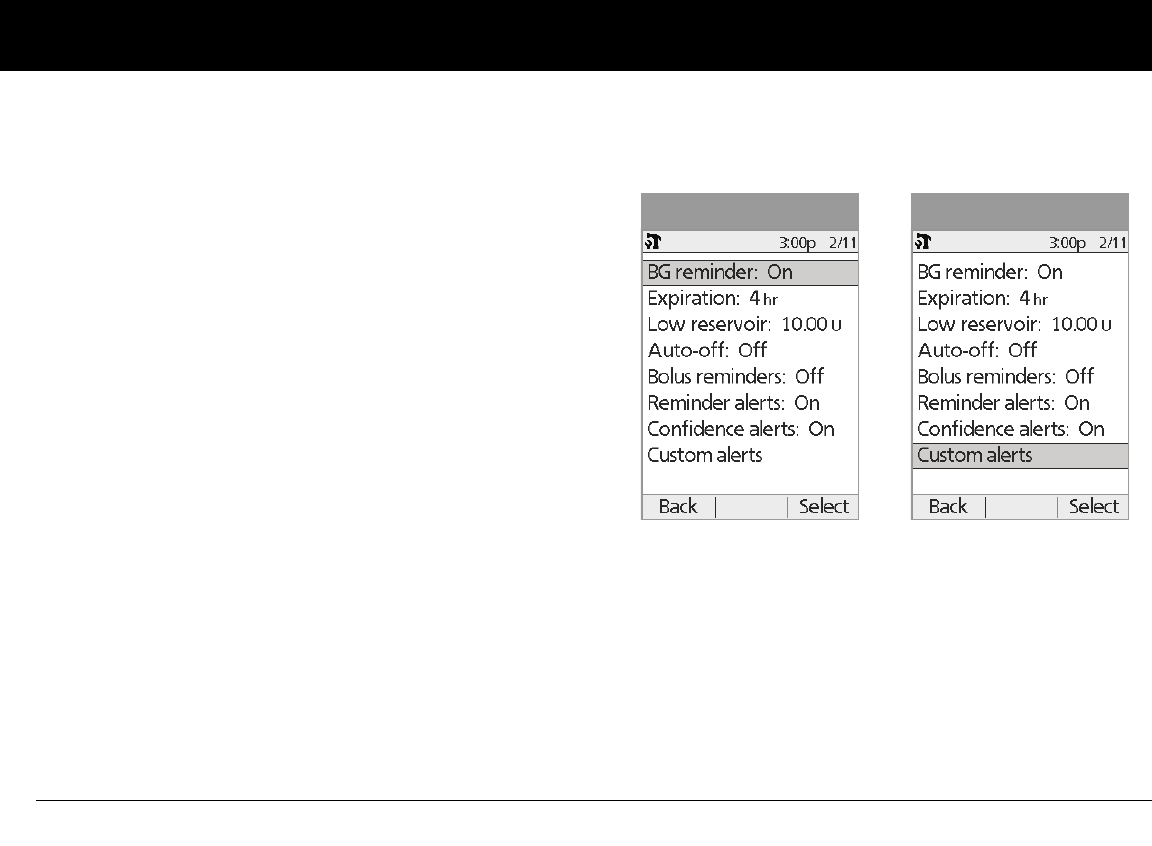
Using the Personal Diabetes Manager
68
6
Confidence alerts: The OmniPod or PDM beeps in response to
your instructions, so you become familiar with the operation of
the OmniPod System and feel confident that you are getting the
insulin you need. These alerts include:
• Bolus delivery started
• Bolus delivery completed
• Extended bolus started
• Extended bolus completed
• Temporary basal rate started
• Temporary basal completed
Choose On or Off. The default setting is On.
Custom alerts: Displays text reminders that you enter, at times
that you select. You can choose to receive an alert Daily, One
time only, or Off. You can change or delete these custom alerts
at any time.
Set alerts and reminders
1. On the Home screen, use the Up/Down Controller buttons
to choose Settings, then press Select.
2. Choose System setup, then press Select.
3. Choose Alerts/reminders, then press Select.
4. Choose the reminder or alert you want to set (Figure 6-8a and
Figure 6-8b), then press Select.
5. For all except Bolus reminders and Custom alerts, choose
the desired option or set the desired value, then press Select
or Enter.
Figure 6-8a Figure 6-8b

Using the Personal Diabetes Manager
69
6
6. For Bolus reminders
• Use the Up/Down Controller buttons to choose On or
Off, then press Select.
•If you chose On, you are taken to a new screen where you
can add, edit or delete reminders:
To add a Bolus reminder
a. Use the Up/Down Controller buttons to choose [add
new], then press New.
b. Choose a start time, then press Next.
c. Choose an end time, then press Save.
To edit a Bolus reminder
a. Choose the bolus reminder you wish to edit, then
press Edit.
b. Choose Edit, then press Select.
c. Enter a new start time, then press Next.
d. Enter a new end time, then press Save.
To delete a Bolus reminder
a. Choose the bolus reminder you wish to delete, then
press Edit.
b. Choose Delete then press Select.
c. Press Delete to remove the bolus reminder.
7. For Custom alerts
• Use the Up/Down Controller buttons to choose [add
new], then press New.
• To use the OmniPod System’s default naming system, sim-
ply press Next. The default naming system automatically
assigns alert names in numerical order, such as alert 1,
alert 2, alert 3.
If you want to give a different name to the custom alert:
a. Use the Up/Down Controller buttons to scroll
through the list of characters. An up-and-down-arrow
symbol on the screen indicates the character you are
changing.
b. Press the middle soft key to move the underscore to
the next character.
c. Enter each character one at a time. For example, for a
reminder to pick up a prescription, you might enter
R, x (Figure 6-9 on next page). (A blank character or
space is the first and last option in the scrolling menu.)
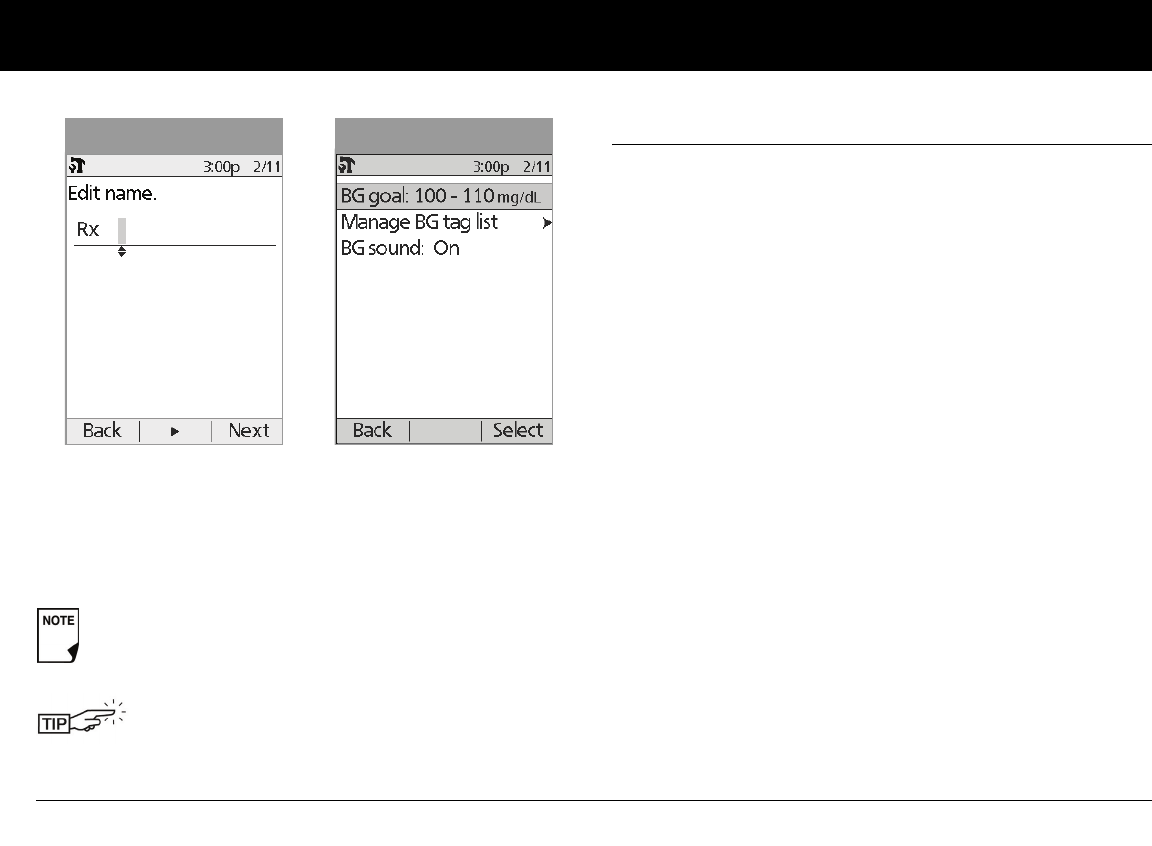
Using the Personal Diabetes Manager
70
6
d. Press Next.
• Enter the time of day for the alert, in 30-minute incre-
ments, then press Next.
• Choose Daily, One time only, or Off, then press Select.
■ Change Blood Glucose Meter Settings
You can adjust blood glucose (BG) meter settings:
• BG lower and upper limit goals (for BG history)
• BG sound—On or Off
• Manage BG tags list
1. On the Home screen, use the Up/Down Controller buttons
to choose Settings; then press Select.
2. Choose System setup, then press Select.
3. Choose BG meter, then press Select.
4. Choose the setting you want to change (Figure 6-10), then
press Select.
Change BG limit goal or BG sound
1. To change the BG limit goal, press Edit, change either or
both values, then press Save.
2. To change BG sound, choose On or Off, then press Select.
Custom alerts will repeat every 15 minutes until
acknowledged.
You can change or delete alerts and reminders at
any time.
Figure 6-9 Figure 6-10
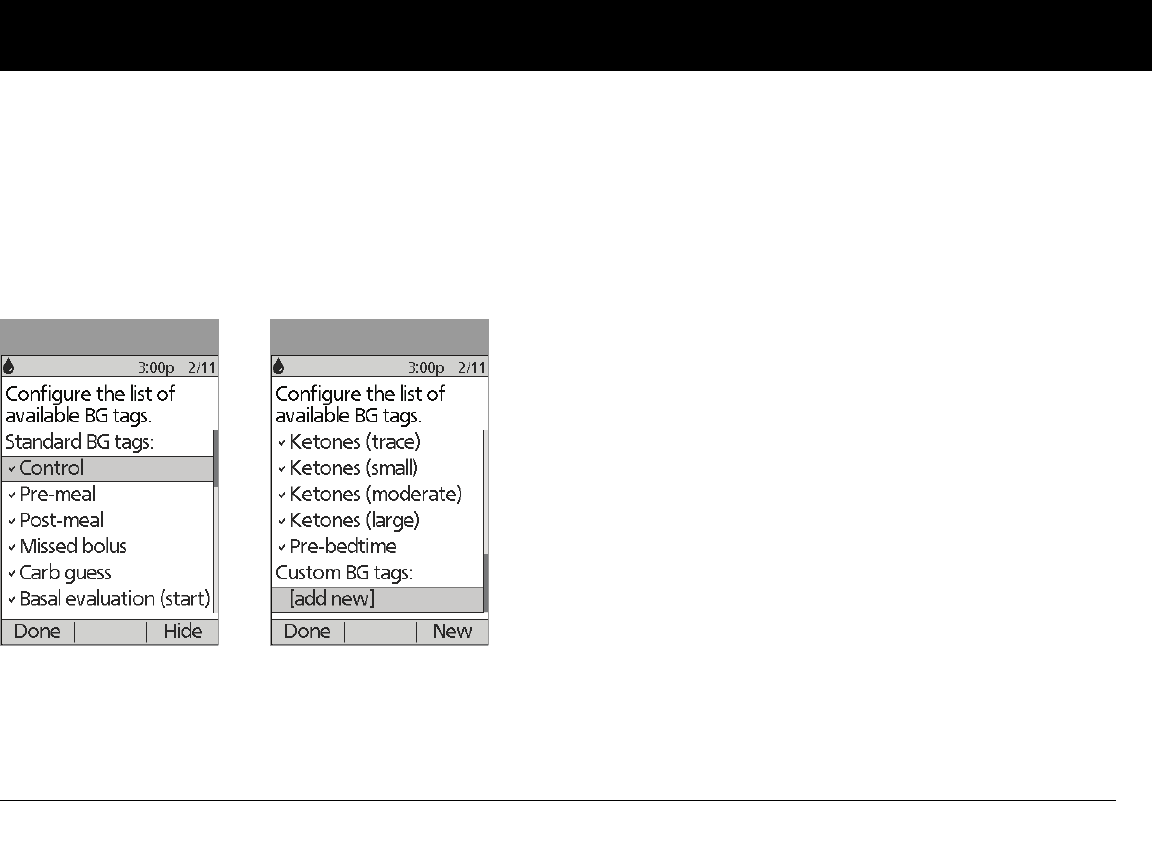
Using the Personal Diabetes Manager
71
6
Manage the Blood Glucose Tags List
You can create up to 15 custom blood glucose tags and hide any
of the standard tags you do not plan to use. Standard BG tags are
shown first on the screen (Figure 6-11a), followed by custom
tags, then [add new] (Figure 6-11b). For more information about
tagging BG readings, see Chapter 7, Checking Your Blood
Glucose.
1. To hide or show a standard BG tag, choose the tag, and press
Show (if it is marked as hidden) or Hide.
Tags you choose to show will be checkmarked; hidden ones
will not be.
2. To add a custom tag, choose [add new] at the end of the list
of custom tags, then press New.
In the Edit name screen, either:
a. Press Save to save the new tag with the default name,
custom tag1, custom tag2, and so on; or
b. Use the Up/Down Controller key to choose letters and
numbers for a name, followed by the middle soft key to
move forward one space. Then press Save.
3. To delete a custom tag, choose the tag, press Delete, then
press Delete again. Or press Cancel to leave the tag
unchanged.
Figure 6-11a Figure 6-11b
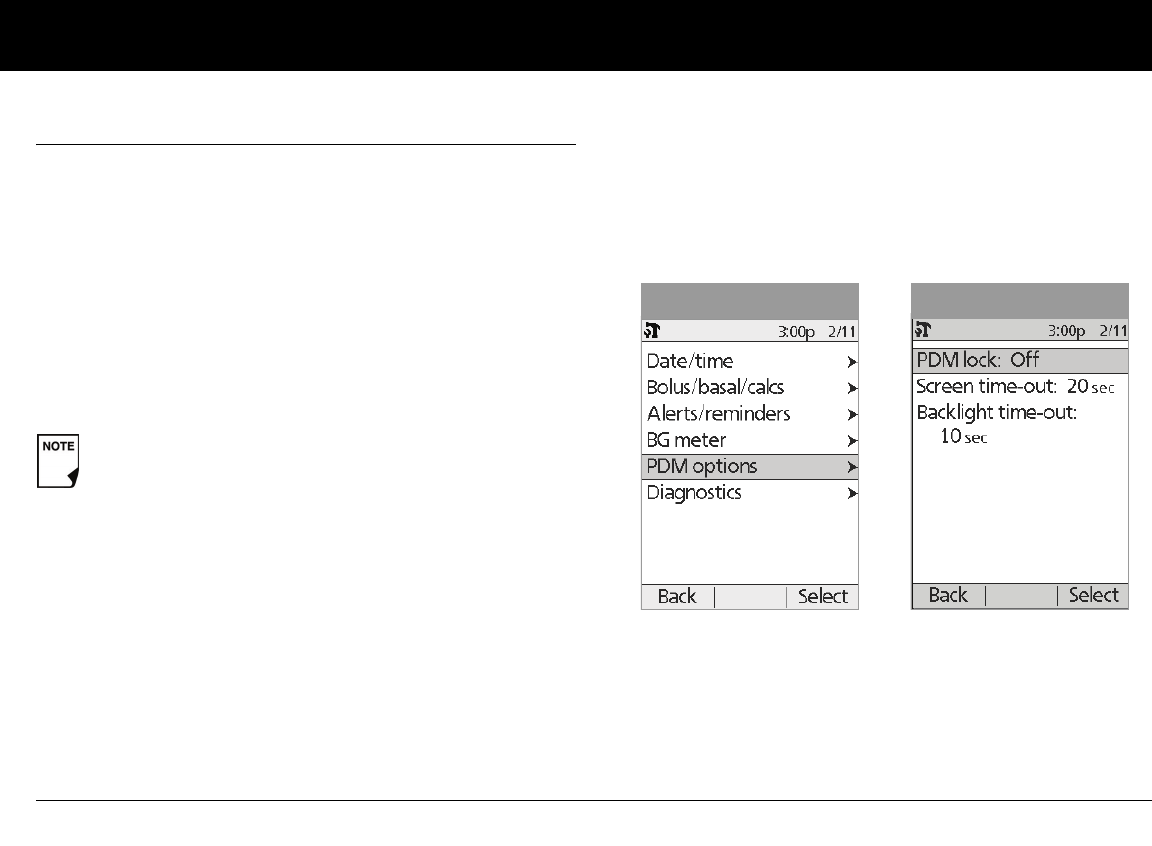
Using the Personal Diabetes Manager
72
6
■ Customize the Personal Diabetes Manager
Additional options let you customize how the PDM operates:
PDM lock: “Locks” the buttons on the PDM. The default setting is
Off. This safety feature can help avoid accidentally changing
basal rates or giving boluses.
Screen time-out: The screen turns off after a time interval that
you set, which occurs if you have not pressed any buttons on the
PDM. This setting preserves battery power by turning off the
screen when you are not using it. Choose an interval of 10, 20, or
30 seconds. Set it at the lowest setting (10 seconds) to maximize
battery life. The default is 20 seconds.
Backlight time-out: The backlight is on by default while you are
using the PDM. The time-out setting dims the backlight and
causes the screen to dim when you have not used it within the
time interval that you set. Choose an interval of 5, 10, or 20 sec-
onds. Set at the lowest setting (5 seconds) to maximize battery
life. The default is 10 seconds.
Set PDM options
1. On the Home screen, use the Up/Down Controller buttons
to choose Settings, then press Select.
2. Choose System setup, then press Select.
3. Choose PDM options (Figure 6-12), then press Select.
4. Choose one of the PDM (Figure 6-13), then press Select.
Press and hold the Power button to turn the screen back
on. In some cases, if it has been less than 5 minutes since
the screen timed out, pressing the Power button returns
you to the same screen you were using. If it has been lon-
ger than 5 minutes, the PDM brings you to the Status
screen.
Figure 6-12 Figure 6-13
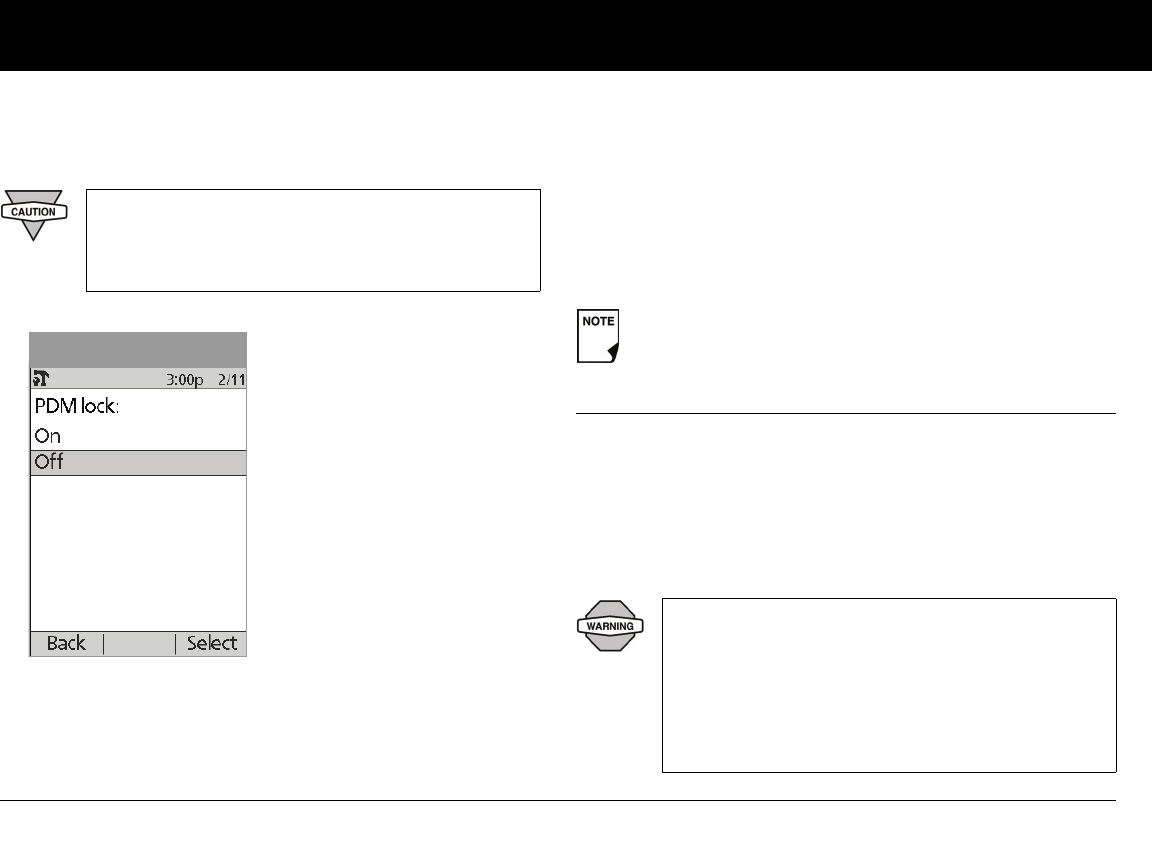
Using the Personal Diabetes Manager
73
6
Set PDM lock
Choose On or Off, then press Select (Figure 6-14).
Set the Screen time-out
Choose a time interval of 10, 20, or 30 seconds, then press
Select.
When the screen times out and goes black, turn it on again by
pressing the Home/Power button.
Set the Backlight time-out
Choose a time interval of 5, 10, or 20 seconds, then press Select.
When the screen dims, turn it on again by pressing any button.
The PDM will ignore the usual command and relight the screen.
■ Set Diagnostic Functions
The Diagnostics screen allows you to instantly confirm how the
System is working or to completely update settings entered dur-
ing setup (see Chapter 2, Getting Started). Options include:
Check alarms: Confirms that all alarms work properly when
needed. When you select this function, the PDM beeps, then the
Pod beeps.
If you choose On, other PDM options and most
other soft keys are locked and will not respond to
button presses. To use them, you must first set PDM
lock to Off.
Figure 6-14
The lowest setting, 5 seconds, will drain the battery the
least.
If the PDM fails to beep, immediately call Customer
Support at 800-591-3455 (from outside the United
States, 781-457-5098). If a Pod is active and fails to
beep, change the Pod immediately (see Chapter 5,
Using the OmniPod). Continuing to use the System
in these situations may put your health and safety at
risk.
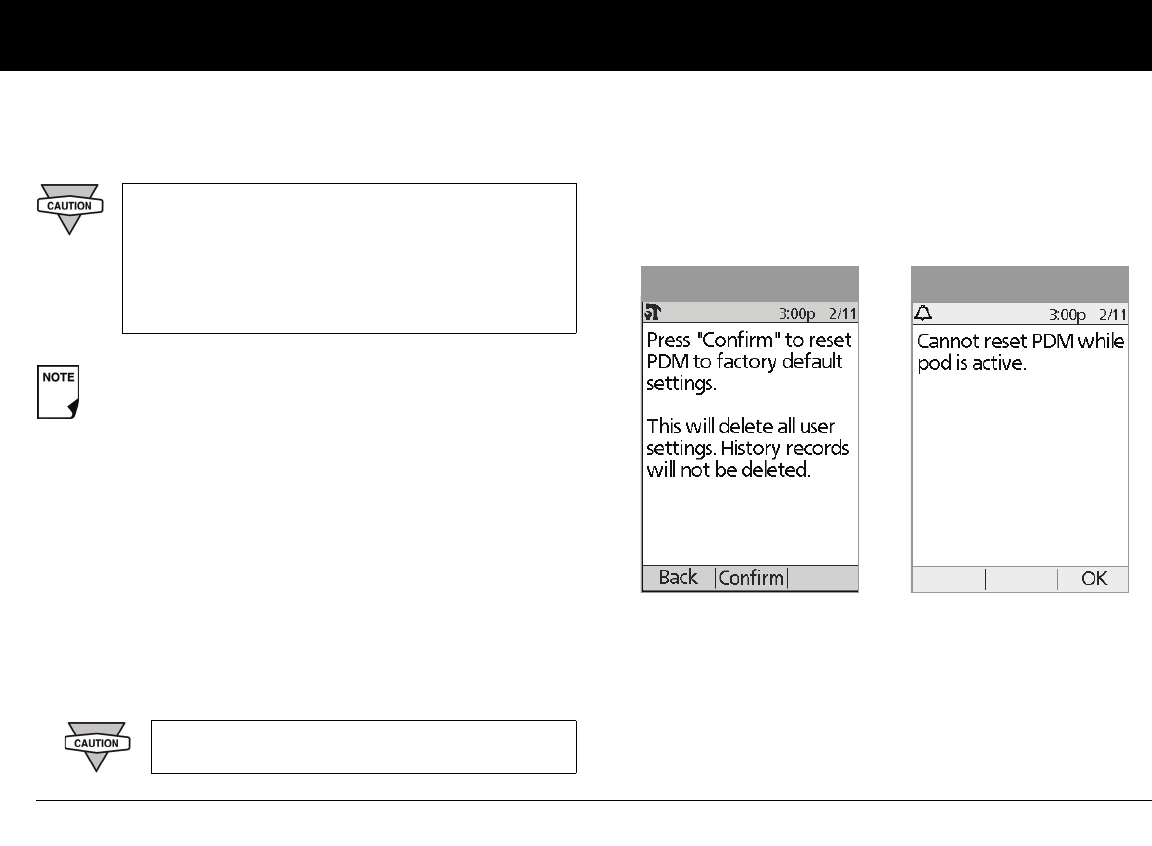
Using the Personal Diabetes Manager
74
6
Reset PDM (soft reset): Restores all settings in the PDM to the
factory defaults.
Diagnostic options
1. On the Home screen, use the Up/Down Controller buttons
to choose Settings, then press Select.
2. Choose System setup, then press Select.
3. Choose Diagnostics, then press Select.
To check alarms
1. Choose Check alarms, then press Select.
2. Press OK. The PDM beeps three times and vibrates three
times. If a Pod is active, it then beeps three times.
To reset the PDM
1. Choose Reset PDM, then press Select.
2. If the Pod is deactivated, the PDM asks for confirmation and
reminds you that you will lose all user settings (Figure 6-15).
Press Confirm to reset the PDM.
If the Pod is still active, you will be unable to reset the PDM
(Figure 6-16). Press OK to return to the Diagnostics menu.
Resetting the PDM deletes all basal programs, temp
basal presets, carb presets, bolus presets, and all sug-
gested bolus settings. Before you use this feature
and delete these settings, be sure you have a written
record of the information you need. History records
will not be deleted.
As a safety feature, you cannot reset the PDM when a
Pod is active. You must first deactivate the Pod.
Check the alarm function at every Pod change.
Figure 6-15 Figure 6-16
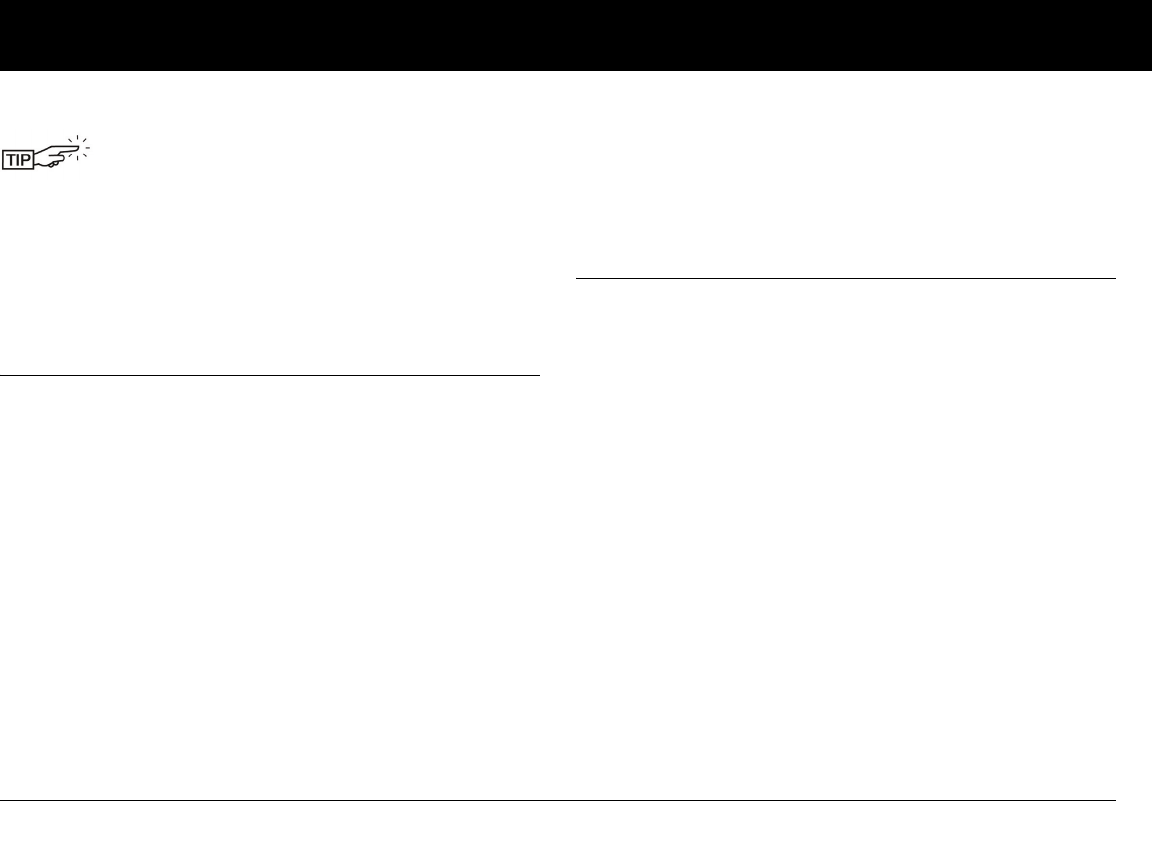
Using the Personal Diabetes Manager
75
6
■ Set a Vibration Alert
For certain reminders and alerts, you can choose vibration
instead of beeps or vibration followed by beeps, instead of only
beeps. If you set the vibration alert, the PDM will vibrate for:
• Blood Glucose reminders
• Missed Bolus reminders
•Custom Alerts
• “No active Pod” reminders
To change the type of alert
1. Use the Up/Down Controller button to choose Settings;
then press Select.
2. Choose Vibration alert, then press Select.
3. Choose Vibrate, Vibrate then beep, or Off (beep only), then
press Select. (Vibrate then beep means the PDM will repeat
the reminder twice using vibration. After that, it uses beeps.)
Or press Back to return to the Settings menu.
■ Get the Most from Your PDM
Keep it handy
Wireless communication technology means you don’t have to
keep the PDM right next to the Pod for the Pod to work. Once
you set your basal program, the Pod continues to deliver your
basal program 24 hours a day, regardless of the location of the
PDM. However, you still need the PDM to deliver a bolus, change
the basal rate, reference a food item, and so on. You can store the
PDM conveniently inside an article of clothing (like a shirt
pocket) or put it discreetly into a drawer, briefcase, or purse.
Communicating with the Pod
When you use the PDM to communicate with the OmniPod,
hold the PDM within 24'' (61 cm) of the Pod. If you wear the Pod
on your abdomen, holding the PDM in your hands when press-
ing the buttons should be close enough.
Water and your PDM
The PDM is not waterproof. Do NOT place it in or near water.
Use the form at the end of this User Guide to write
down all your settings from the Setup Wizard. You
can also attach a copy of the CSII orders that you
used during your training session. If you ever need
to reset your PDM, having these settings handy will
make setup very easy.
These forms are also available on Insulet’s Web site,
MyOmniPod.com/support/resources.
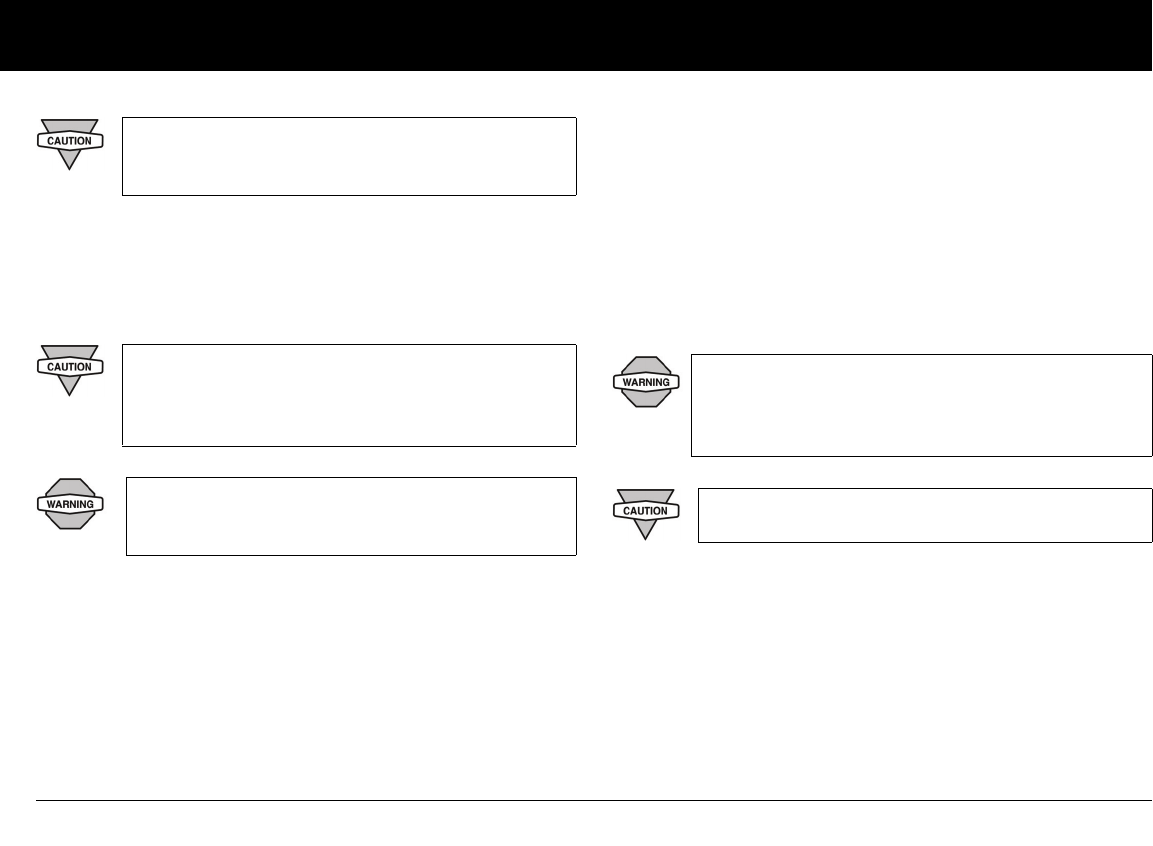
Using the Personal Diabetes Manager
76
6
Avoid extreme temperatures
Extreme operating temperatures can affect PDM batteries and
interfere with System operation. Avoid using the PDM in temper-
atures below 40°F (5°C) or above 104°F (40°C).
Electrical interference
The PDM is designed to withstand normal radio interference and
electromagnetic fields. However, as with all wireless communica-
tion technology, certain operating conditions can interrupt
communication. For example, electric appliances such as micro-
wave ovens and electric machinery located in manufacturing
environments may cause interference. In most cases, interrup-
tions are easy to resolve (see Chapter 11, Communication
Failures).
Do NOT use IV Prep wipes, alcohol swabs, soap,
detergent, or solvents to clean the screen or any
other part of the PDM.
Do not store or leave the PDM where it may be
exposed to extreme temperatures, such as inside a
car. Extreme heat or cold can cause the device to
malfunction.
Never attempt to test your blood glucose while your
PDM is connected via USB cable to a computer.
Doing so could result in electrical shock.
Only connect a USB cable to your PDM when down-
loading data to a computer. Other PDM functions are
disabled while a USB cable is connected, and the
PDM cannot communicate with the Pod.
When you connect a USB cable to the PDM, only use
a cable that is less than or equal to 9 feet in length.
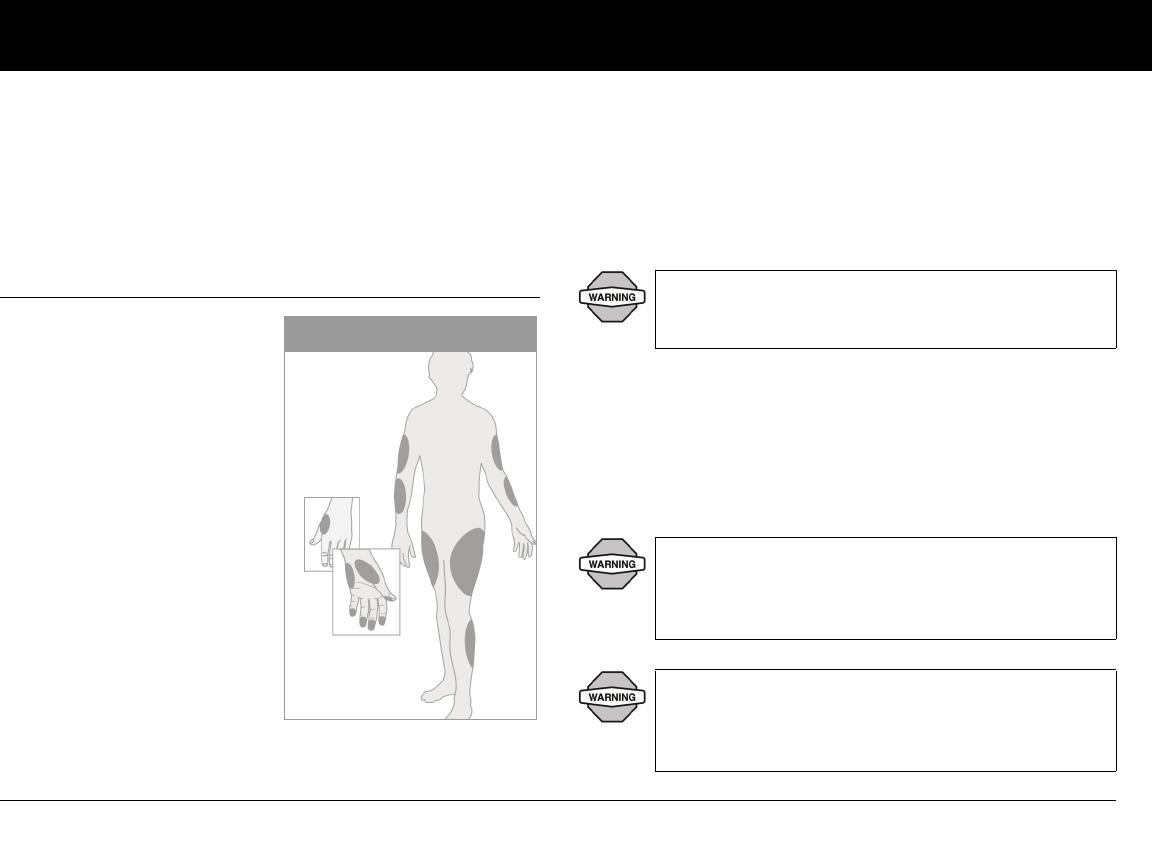
77
CHAPTER 7
Checking Your Blood Glucose
■ The Built-in FreeStyle® Blood Glucose Meter
With the FreeStyle® blood glu-
cose meter, you can check your
blood glucose on your finger,
hand, forearm, upper arm,
thigh, or calf (Figure 7-1).
Checking with the FreeStyle®
blood glucose meter requires a
very small sample size, just 1/3
or 0.3 microliter of blood—
about the size of a pinhead.
Most healthcare providers rec-
ommend checking on your
hand, arm, or leg when blood
glucose values are stable:
before meals and before bed-
time. However, when blood
glucose is changing, it is best to
test on your fingers. Blood from the fingertips may show these
changes sooner than blood from other sites.
You may also want to test for low blood glucose:
• When you feel symptoms such as weakness, sweating,
nervousness, headache, or confusion
• When you have delayed a meal after taking insulin
• When your healthcare provider advises you to do so
Illustration of
test areas on
the body
Figure 7-1
We recommend that you test on your fingers if you
are testing for hypoglycemia (low blood glucose) or if
you suffer from hypoglycemia unawareness.
Keep the OmniPod Insulin Management System and
the FreeStyle® accessories away from young children,
as they contain small parts that may be dangerous if
swallowed.
Only use FreeStyle® test strips and FreeStyle® control
solution with the OmniPod System. Using other
brands of test strips and control solutions with the
OmniPod System can produce inaccurate results.
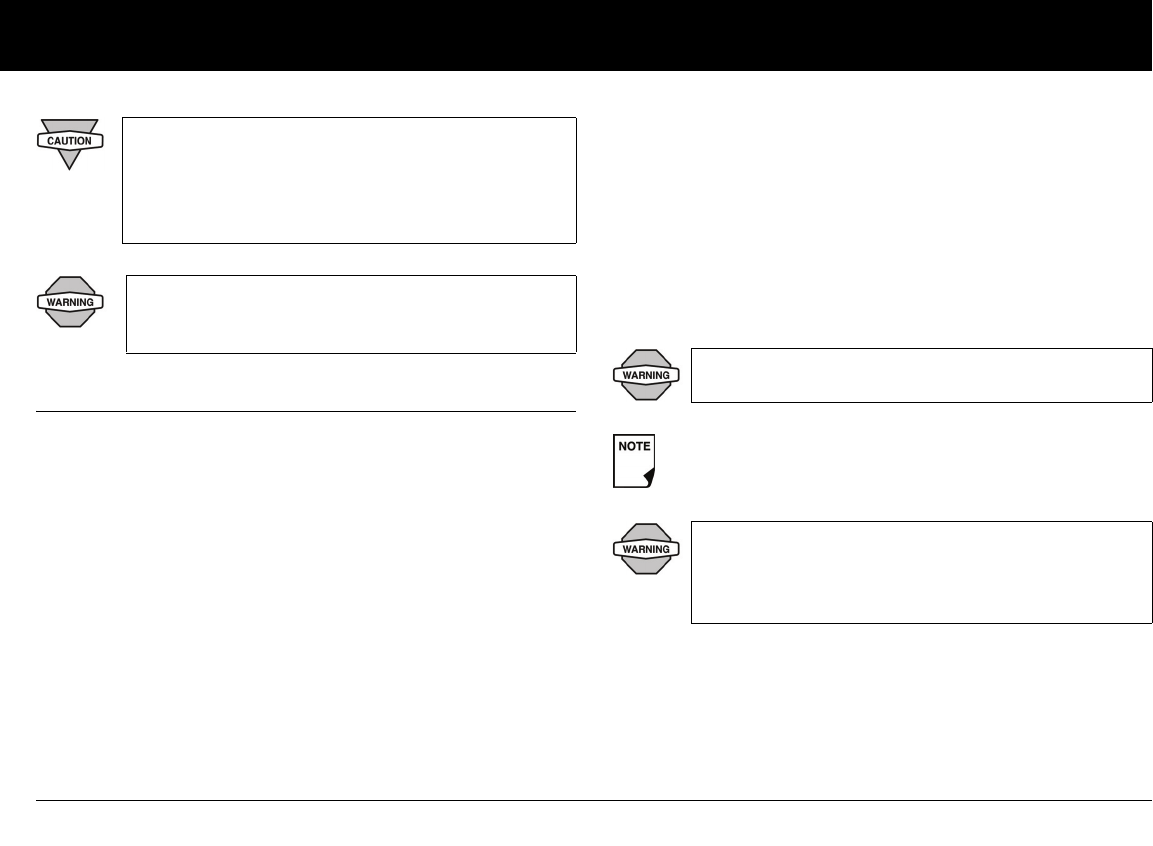
Checking Your Blood Glucose
78
7
■ The FreeStyle® Blood Glucose Test Strips
Important test strip information
• Store the blood glucose test strip package in a cool, dry place
between 37° and 86° F (3° and 30° C).
• Use test strips only when the System is within its operating
temperature range, between 40° and 104° F (5° and 40° C).
• Keep test strips away from direct sunlight and heat.
• Store test strips in their original vial only; never transfer them
to another vial or any other container.
• Never store individual test strips outside the vial.
• After removing a blood glucose test strip from the vial, imme-
diately replace the vial cap and close it tightly.
• With clean, dry hands, you can gently touch the test strip any-
where when removing it from the vial or inserting it into the
test strip port.
• Do not bend, cut, or alter blood glucose tests strips in any
way.
Please read all the instructions provided in this User
Guide and practice the testing procedures before
using the OmniPod System and FreeStyle® accesso-
ries. Follow the guidance of a healthcare professional
for proper blood glucose monitoring.
Never attempt to test your blood glucose while your
PDM is connected via USB cable to a computer.
Doing so could result in electrical shock.
Do not use strips beyond the expiration date printed
on the package, as this may cause inaccurate results.
For detailed storage and usage information, refer to the
package insert in the box containing the test strip vial.
Keep the test strip vial away from children. The cap is
a choking hazard. The cap or vial contains drying
agents that may be harmful if inhaled or swallowed
and may cause skin or eye irritation.
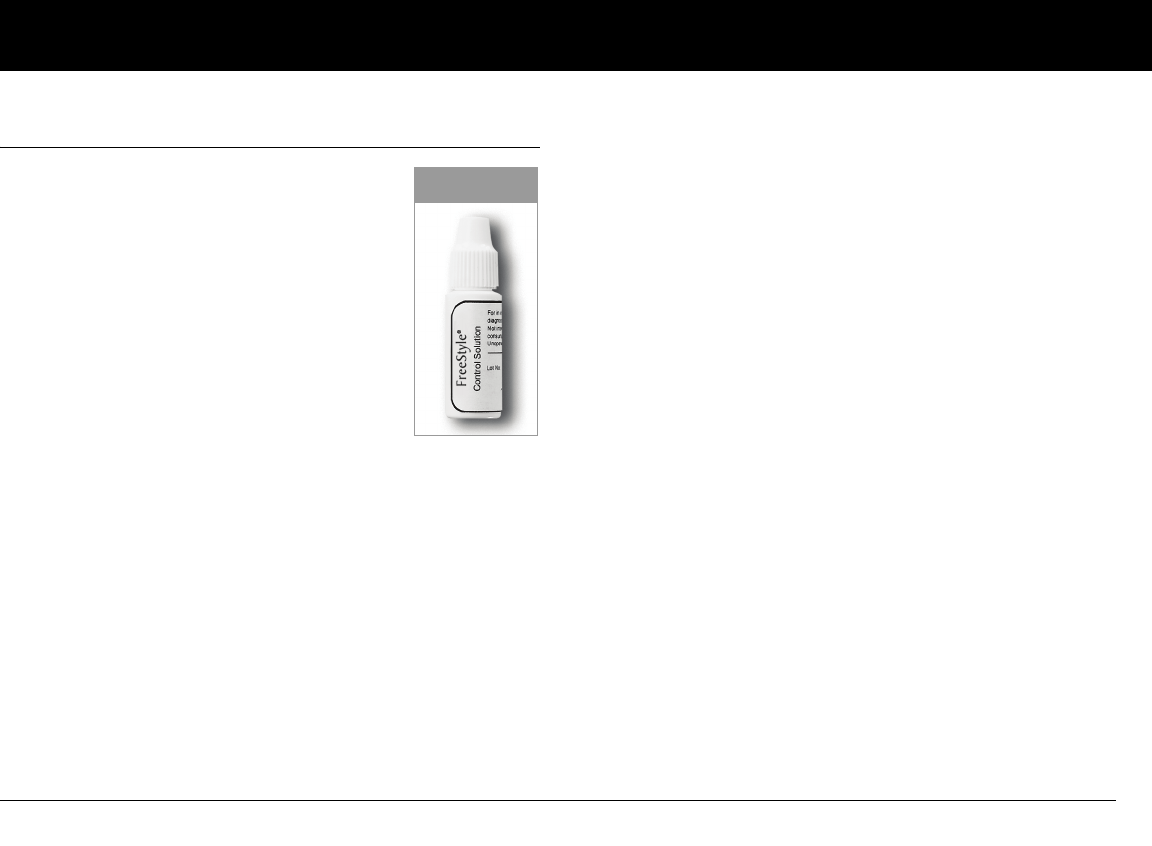
Checking Your Blood Glucose
79
7
■ The FreeStyle® Control Solution
The FreeStyle® control solution (Figure 7-2) is a
red liquid that contains a fixed amount of glu-
cose and has three important uses:
• To ensure that your meter and test strips
are working together properly
• To check that you are following the correct
testing procedure
• To practice testing without having to use
your own blood
When to perform a control solution test
You should perform a control solution test:
• When you first get your OmniPod System, before doing a
blood glucose test
• When you open and begin using a new vial of test strips
• When you suspect that your meter or test strips are not work-
ing properly
• When you think your test results are not accurate, or if your
test results are not consistent with how you feel
• When you drop or damage your PDM or expose it to liquids
• When your healthcare provider advises you to do so
Check that the meter and test strips are working
A control solution test follows the same procedure as a blood
glucose test, except that you use a sample of control solution
instead of a drop of blood. (See “Performing a Blood Glucose
Test” later in this chapter.)
When you perform a control solution test, if the reading is within
the control solution acceptable range, the meter is working
properly.
Control solution expiration date
FreeStyle® control solution is good for 3 months after opening
the bottle, or until the expiration date printed on the label,
whichever comes first. Count forward 3 months from the date
you open a new bottle of control solution. This is your discard
date. Write this date on the side of the control solution bottle. For
example, if you open the control solution on January 15, count
forward 3 months to April 15. This is the discard date to record
on the bottle, and the date to discard it and begin using a new
bottle.
Ensure accurate control solution results
• Replace the cap on the control solution bottle immediately
after using it.
Figure 7-2
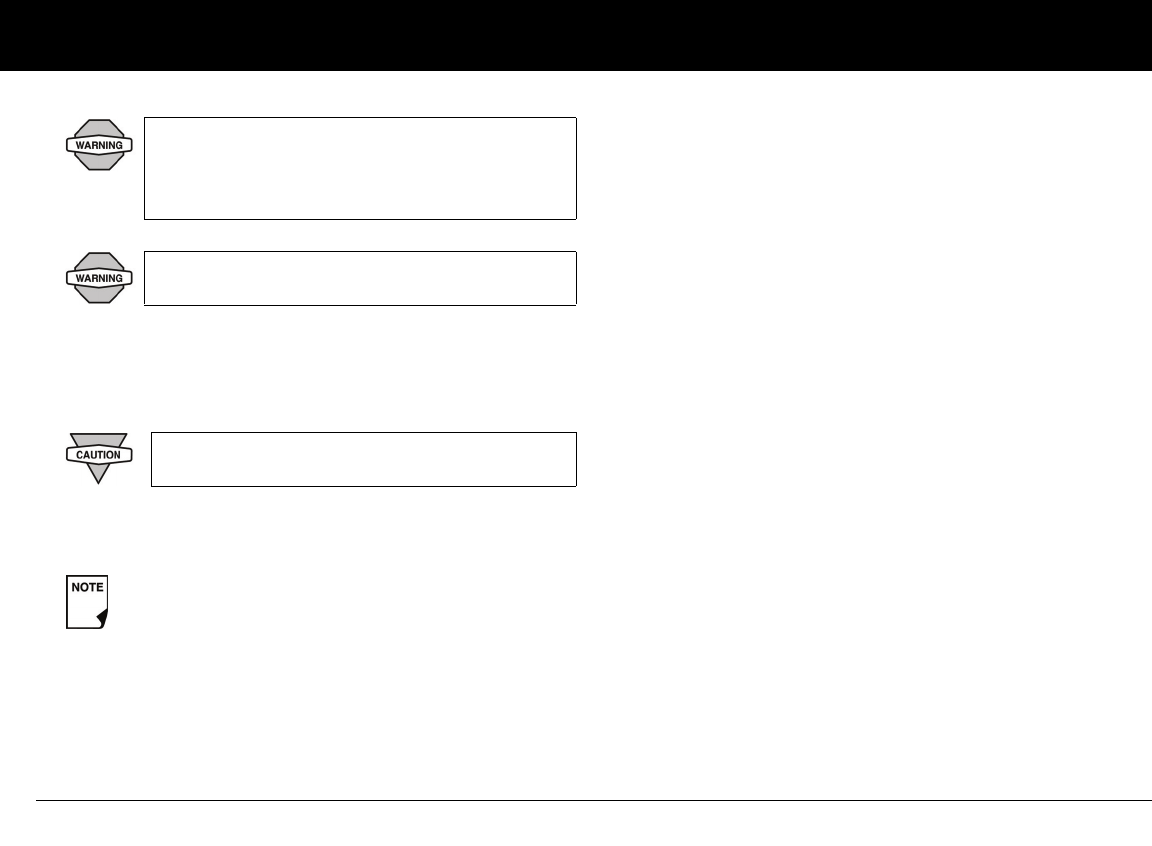
Checking Your Blood Glucose
80
7
• Do not add water or any liquid to control solution.
• Control solution tests are specified to be accurate only when
performed between 59° and 104° F (15° and 40° C).
• The control solution test results should fall within the range
printed on the test strip vial label.
If control solution results are out of this range, REPEAT THE
TEST.
Out-of-range control solution results
Out-of-range test results may be caused by:
• Expired or bad control solution
• Expired or bad test strip
• Error in performing test
• Watered-down control solution
• Code on test strip vial does not match code set in the PDM
• Malfunction of the OmniPod System
• Control solution test done outside 59º to 104ºF (15º to 40ºC)
If your control solution test results continue to fall outside the
range printed on the test strip vial:
1. The OmniPod System may not be working properly.
2. Do not use the System to test your blood glucose.
3. Call Customer Support, 800-591-3455, 24 hours/7 days
(from outside the United States, 781-457-5098).
Use only FreeStyle® control solution with the
OmniPod System. Other brands of control solu-
tion may produce inaccurate results with this
System.
Do not use control solution past the expiration
date or you may get inaccurate results.
Results from FreeStyle® control solution tests do
not reflect your blood glucose level.
The control solution range is a target range for control
solution only. It is not a target range for your blood
glucose.
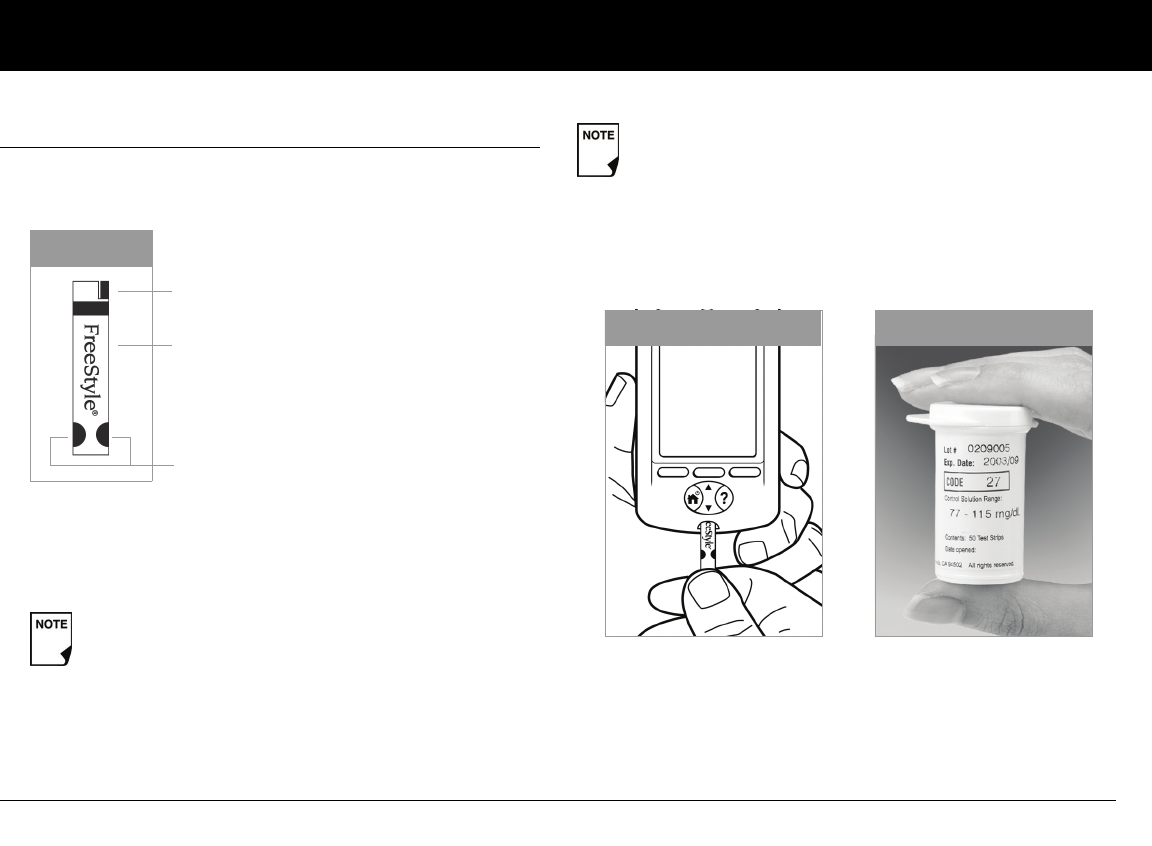
Checking Your Blood Glucose
81
7
■ Performing a Control Solution Test
1. Grasp the bottom of the test strip with the name “FreeStyle®”
facing up (Figure 7-3).
2. Insert the top of the test strip into the test strip port (Figure 7-4)
until it stops. This turns on the PDM and displays the code
number on the screen.
Be ready to adjust the code on the PDM to match the
code number on the test strip vial (Figure 7-5).
Figure 7-3
Top, to insert into meter
FreeStyle® test strip
Bottom edges, for blood sample
If you need to adjust the code number after the PDM
has moved to the next screen, just press the Up/Down
Controller buttons. The code screen reappears and you
can adjust the number.
The code number remains on the PDM screen for your
reference until you have completed the control test.
Figure 7-4 Figure 7-5
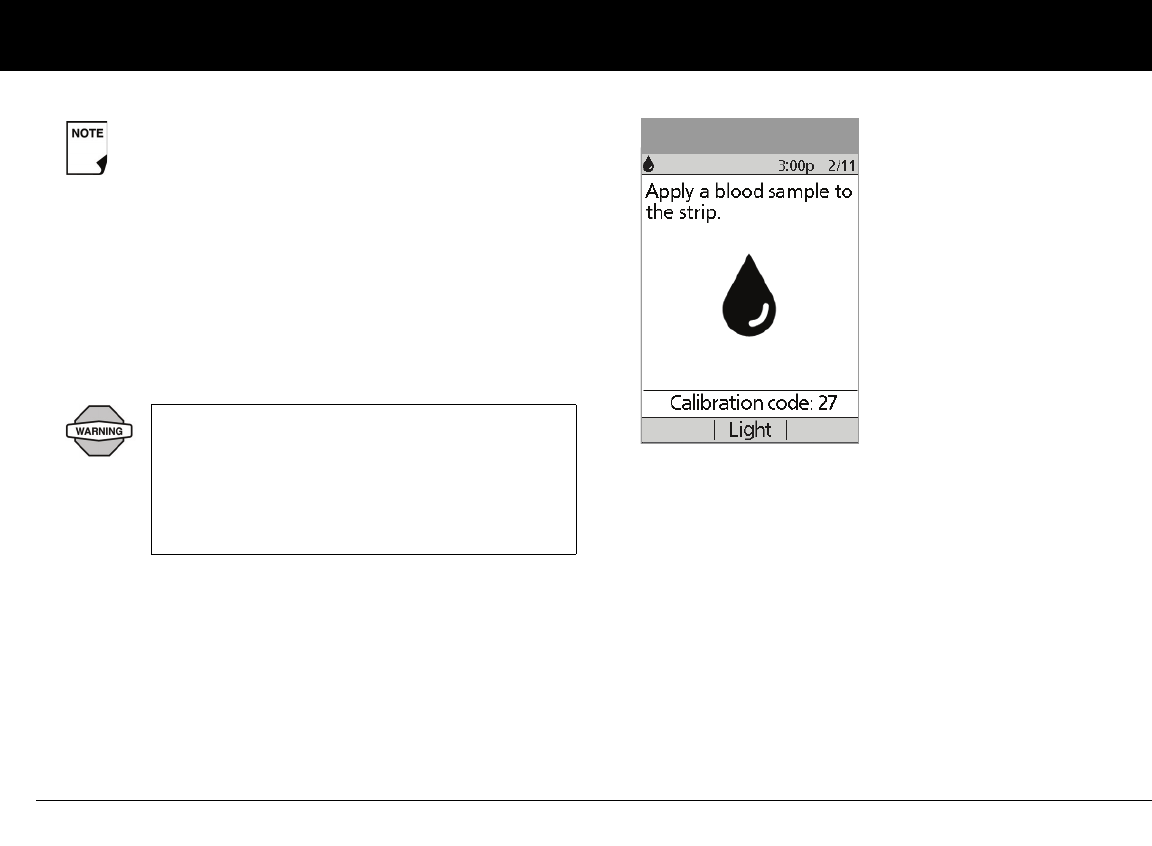
Checking Your Blood Glucose
82
7
3. To help you see the test strip port in reduced lighting, when
you insert a test strip into the PDM, you can turn on the port
light. Press the middle soft key labeled Light. To turn the light
off, press Light again.
4. Wait for the PDM to display “Apply a blood sample to the
strip” on the screen (Figure 7-6).
From some PDM screens, you cannot access the Free-
style® blood glucose meter. For example, you cannot
use the meter while you are activating a Pod or when
an alert, alarm, or communication error screen is dis-
played. In these cases, if you insert a test strip, the
PDM beeps to alert you.
The code number on the screen should match
the code number on the side of your test strip
vial (Figure 7-5 on previous page). They must
always match, or your results will be inaccurate.
(See “Set the blood glucose test strip code” later
in this chapter.)
Figure 7-6
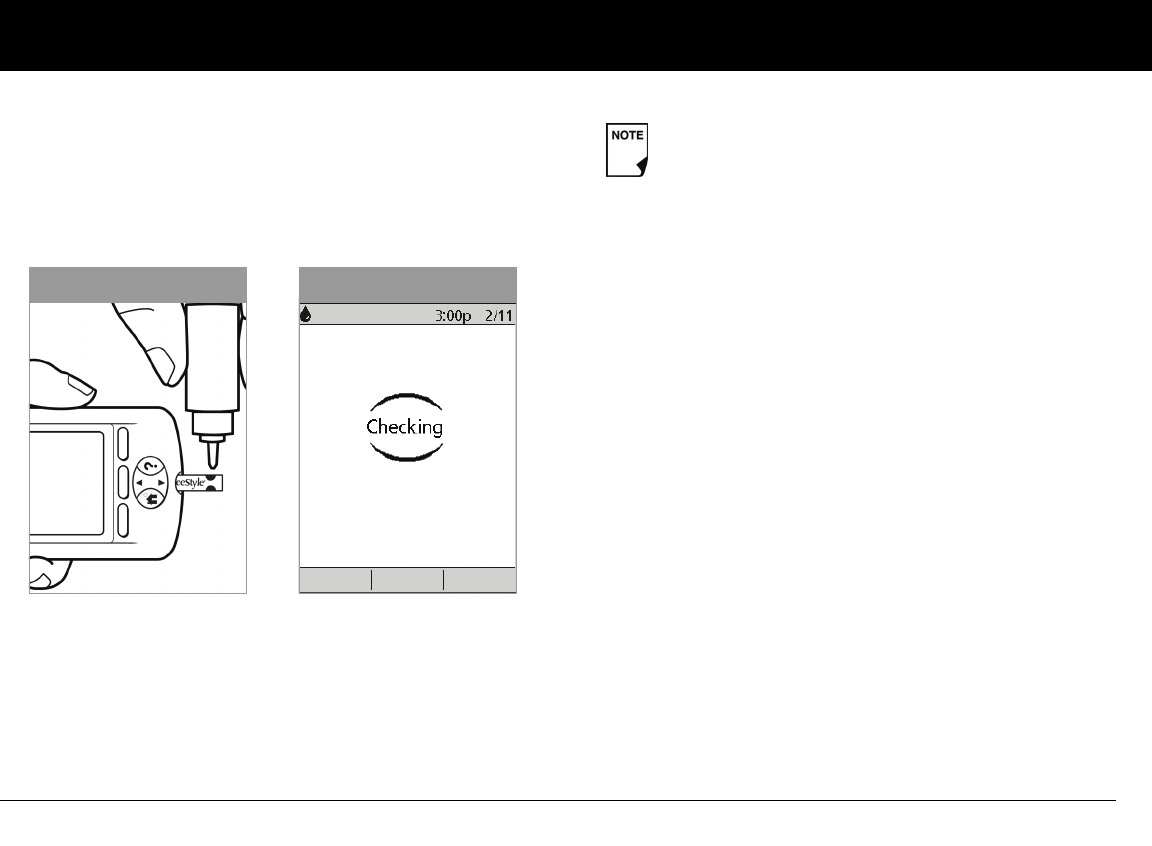
Checking Your Blood Glucose
83
7
5. Gently touch only ONE EDGE of the test strip to the control
solution. Specifically, apply the control solution to the test
strip edge next to one of the dark-colored half-circles (Figure
7-7). If BG sound is set to On, the PDM beeps when the test
strip is full.
If you do not apply the sample within 10 seconds, the strip-
port light turns off. To turn it on again, press Light.
The “Checking” screen appears while the sample is process-
ing (Figure 7-8). The strip-port light turns off when the sam-
ple is accepted.
If BG sound is set to On, the PDM beeps twice. The result
appears on the screen in about 7 seconds, on average.
6. To mark the result as a control solution result rather than a
blood glucose test:
a. Press Tag.
b. Use the Up/Down Controller buttons to select Control
(Figure 7-9 on the next page), then press Select. You can
select a second tag for the test result in the same way.
Figure 7-7 Figure 7-8
Do not apply control solution to both edges.
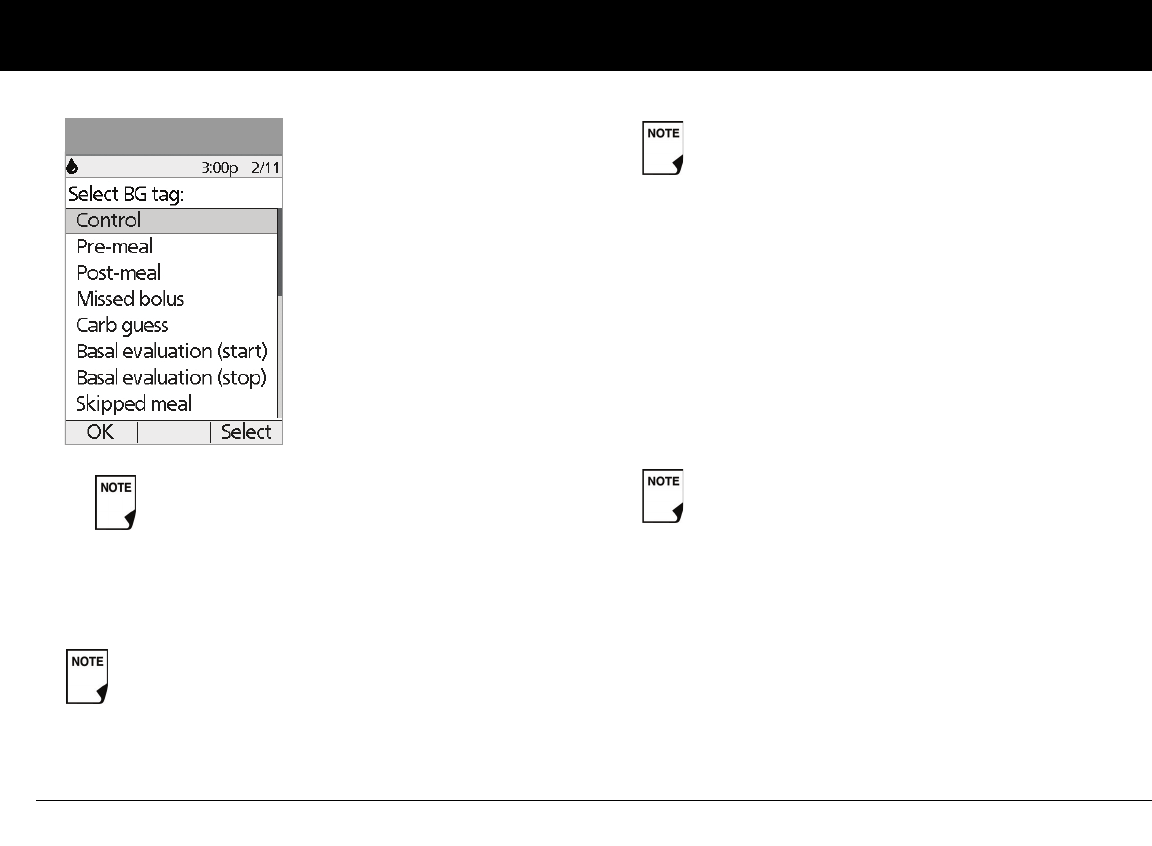
Checking Your Blood Glucose
84
7
c. Press Done.
7. If you do not want to mark the test as a control solution test,
press Next instead of Tag.
8. Compare the control solution test result to the range printed
on the test strip vial label. If the result does not fall within the
range, repeat the test. If the result still does not fall within
the range, call Customer Support, 800-591-3455, 24 hours/
7 days (from outside the United States, 781-457-5098).
9. Remove the test strip. If the strip-port light was turned on, it
now turns off.
If you remove the test strip before this step, you will still see
the available soft keys.
You can select a maximum of 2 tags.
If the suggested bolus calculator feature is turned Off,
the Bolus soft key appears instead of Next.
Figure 7-9 If you mark a test as a control solution test by mistake,
you can unmark it: Press Tag, select Control, then
press Clear.
Be sure to discard used test strips. (You can only use
test strips once.)
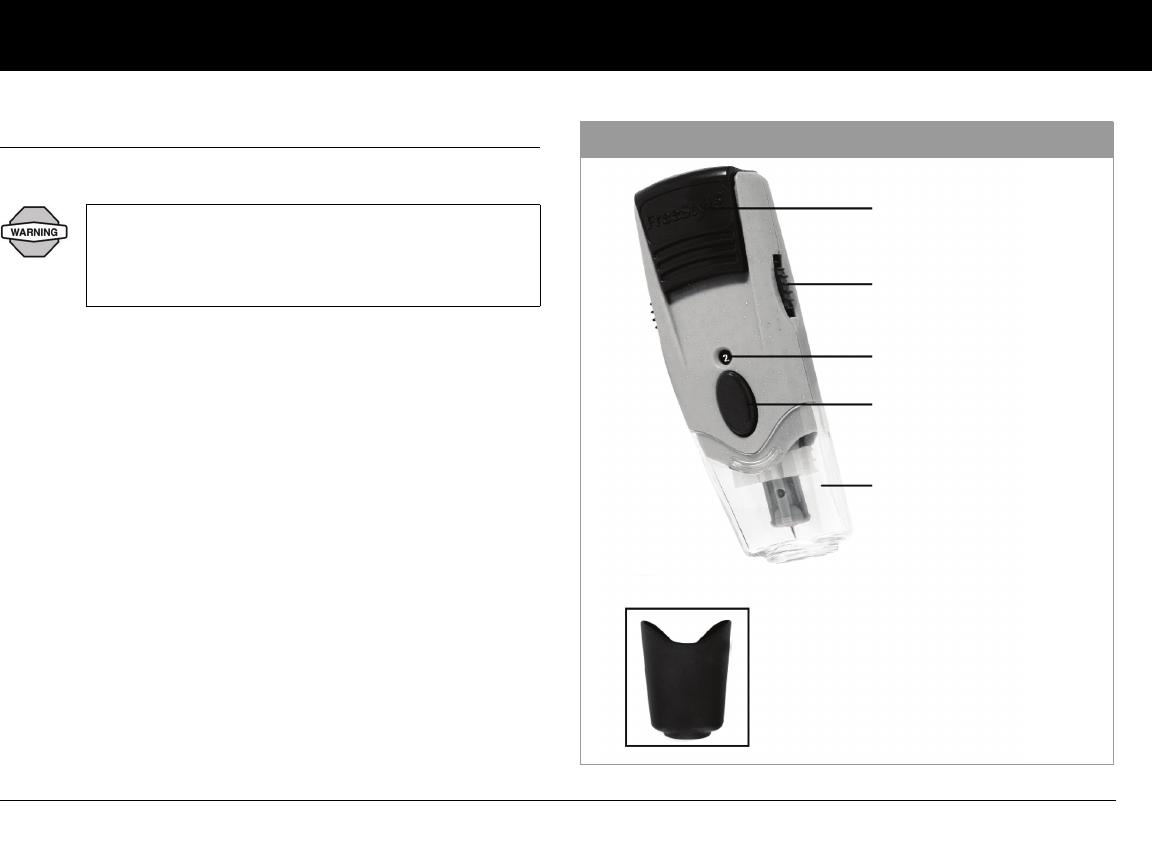
Checking Your Blood Glucose
85
7
■ Performing a Blood Glucose Test
Figure 7-10 shows the parts of the FreeStyle® lancing device.
To ensure accurate results, wash your hands and the
test site (for example, your forearm) with soap and
water. Do not leave any cream or lotion on the test
site. Thoroughly dry your hands and the test site.
Gray cap, for finger testing
Release button
Depth indicator window
Depth settings dial
Clear cap, for testing sites
other than the finger
Cocking handle
Figure 7-10
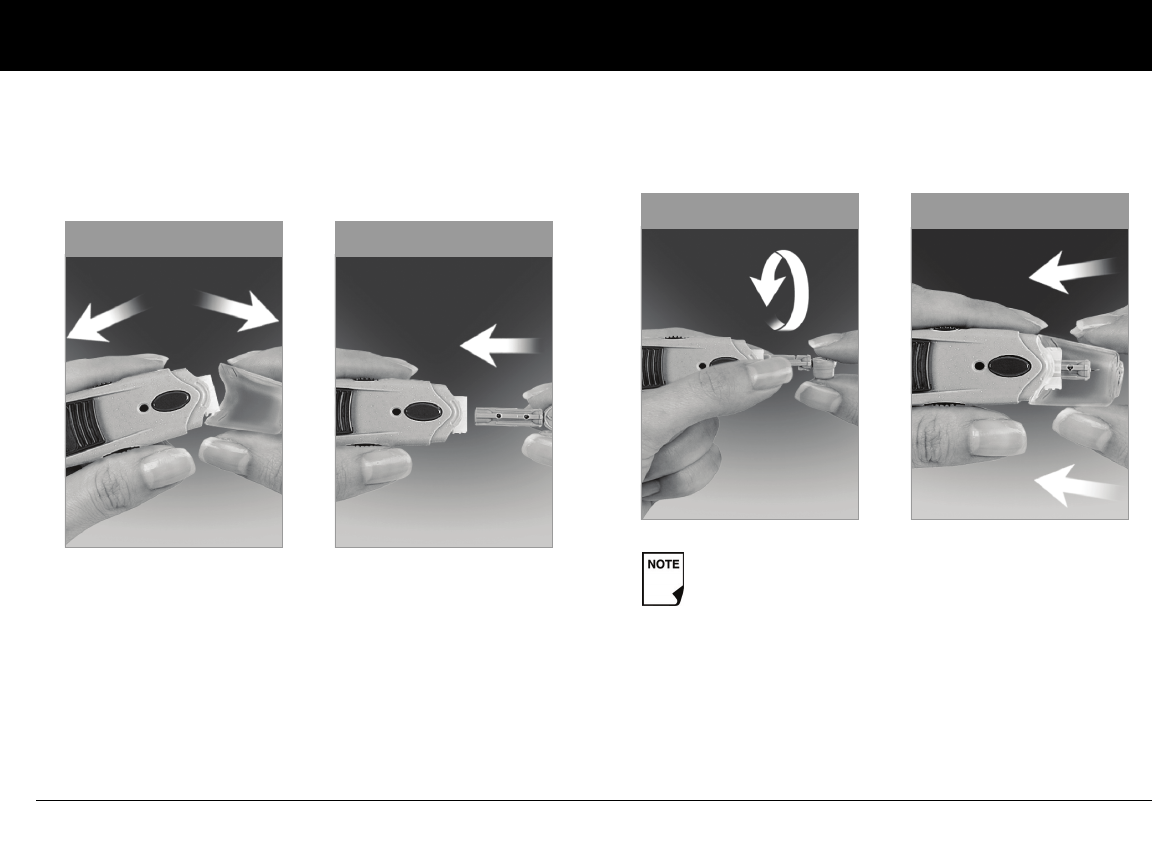
Checking Your Blood Glucose
86
7
Prepare the lancing device
1. Snap off the cap on the lancing device at an angle
(Figure 7-11).
2. Insert a new FreeStyle® lancet firmly into the white lancet
holder cup (Figure 7-12). Pushing the device into the cup may
cock the device, which is fine.
3. Hold the lancet firmly in place with one hand. With your other
hand, twist off the rounded top (Figure 7-13).
4. Replace the cap until it snaps or clicks into place (Figure 7-14).
Be careful not to touch the exposed needle on the lancet.
Figure 7-11 Figure 7-12
Use the clear cap to lance at the following test sites:
forearm, upper arm, hand, thigh, and calf. Use the
gray cap for finger tests only.
Figure 7-13 Figure 7-14
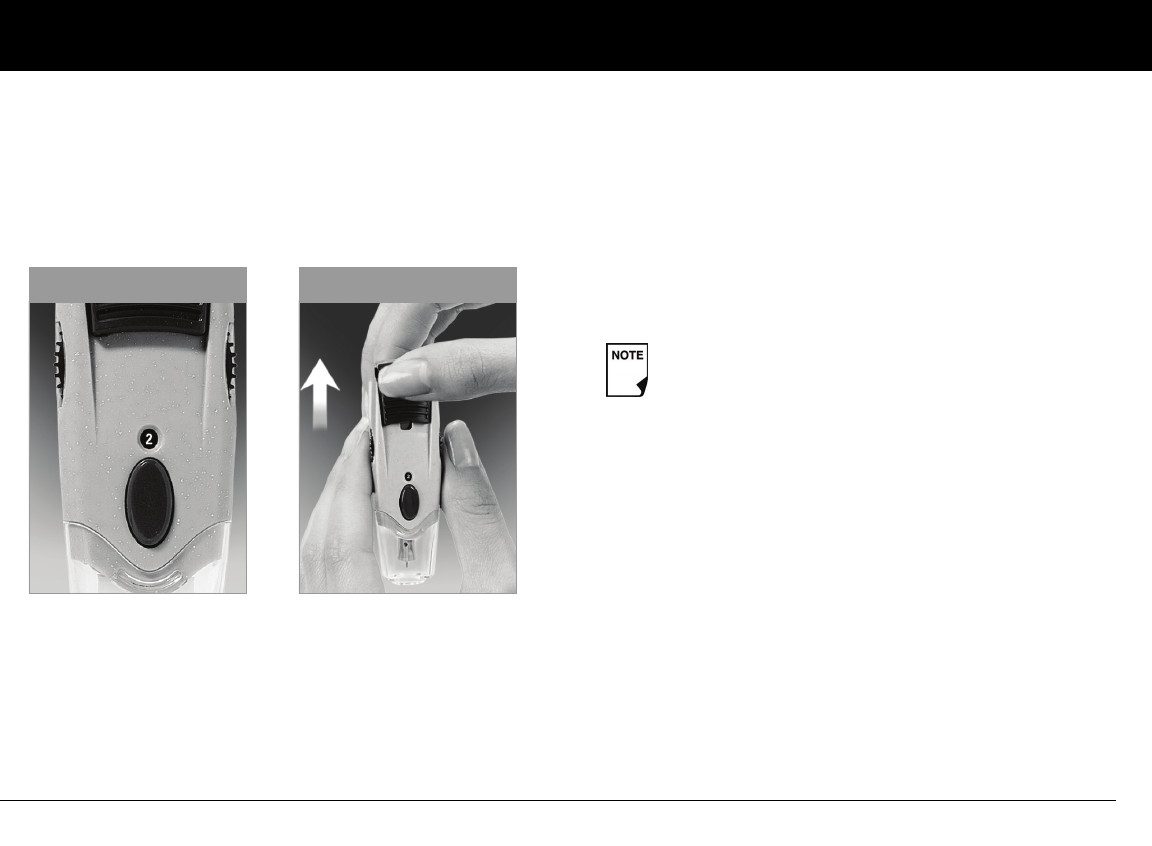
Checking Your Blood Glucose
87
7
5. The lancing device offers four different depth settings. Level 1
is the shallowest depth; level 4 is the deepest. Move the dial
to the desired setting as shown in the depth indicator win-
dow (Figure 7-15). We recommend that you start at level 2 for
most sites except the finger.
To lance your finger, we recommend that you start at level 1,
the shallowest. Be sure to use the gray cap.
6. Pull out the dark gray cocking handle until it clicks (Figure 7-
16). (You may have already cocked the handle in step 2. This is
okay.)
You are now ready to perform a blood glucose test.
Insert the blood glucose test strip
1. Insert a new blood glucose test strip into the test strip port
until it stops. The test strip port is at the bottom of the PDM.
2. To help you see the test strip port in reduced lighting, press
the middle soft key labeled Light. To turn the light off, press
Light again.
Figure 7-15 Figure 7-16
From some PDM screens, you cannot access the Free-
style® blood glucose meter. For example, you cannot
use the meter while you are activating a Pod or when
an alert, alarm, or communication error screen is dis-
played. In these cases, if you insert a test strip, the
PDM beeps to alert you.
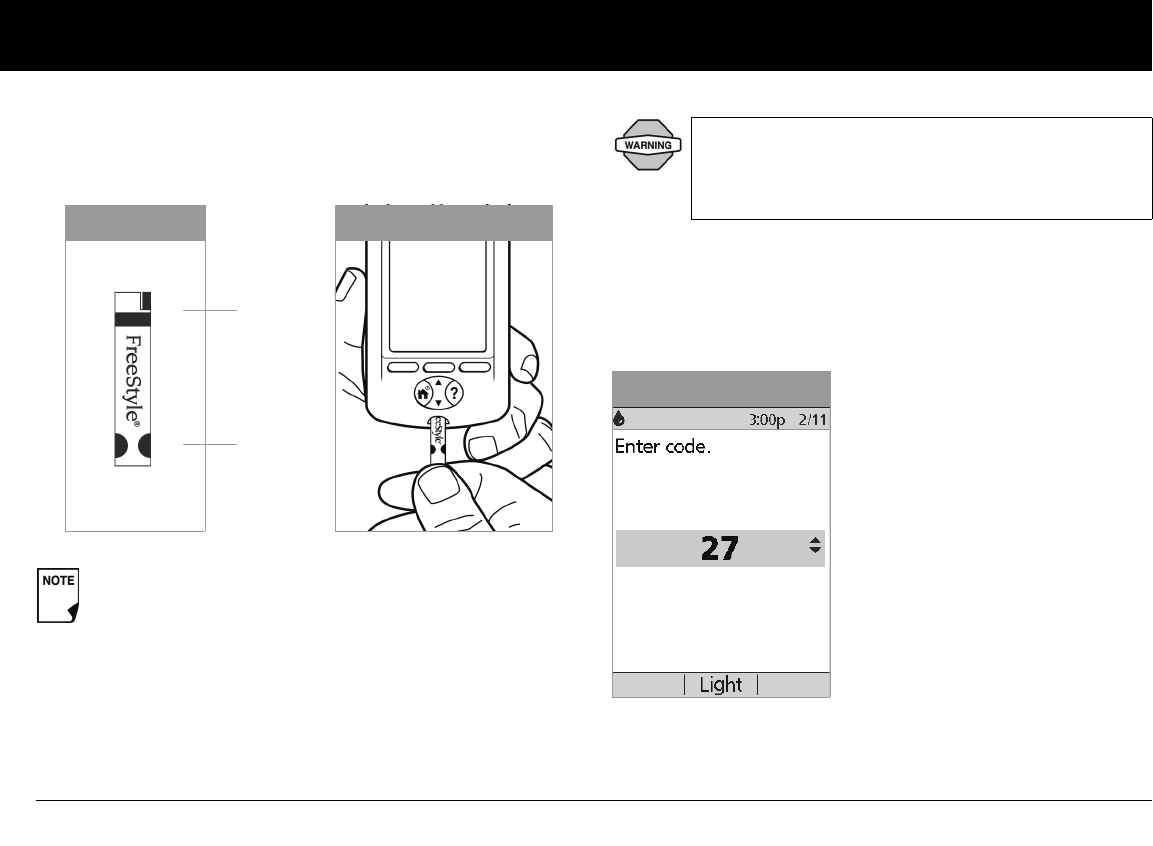
Checking Your Blood Glucose
88
7
3. Insert only the top end of the strip into the test strip port, with
the dark colored rectangle going into the meter (Figure 7-17
and Figure 7-18).
Set the blood glucose test strip code
After you insert the strip, the PDM displays a code number
(Figure 7-19). This number must match the code on the side of
the vial.
If you do not start the test within 2 minutes, the PDM
powers off. To restart the PDM, take out the unused strip
and reinsert it, or simply press and hold the Power but-
ton to turn on the PDM.
Figure 7-17 Figure 7-18
Keep the blood glucose test strip vial away from chil-
dren. The cap is a choking hazard. The cap or vial
contains drying agents that may be harmful if inhaled
or swallowed and may cause skin or eye irritation.
Figure 7-19
Bottom
Top
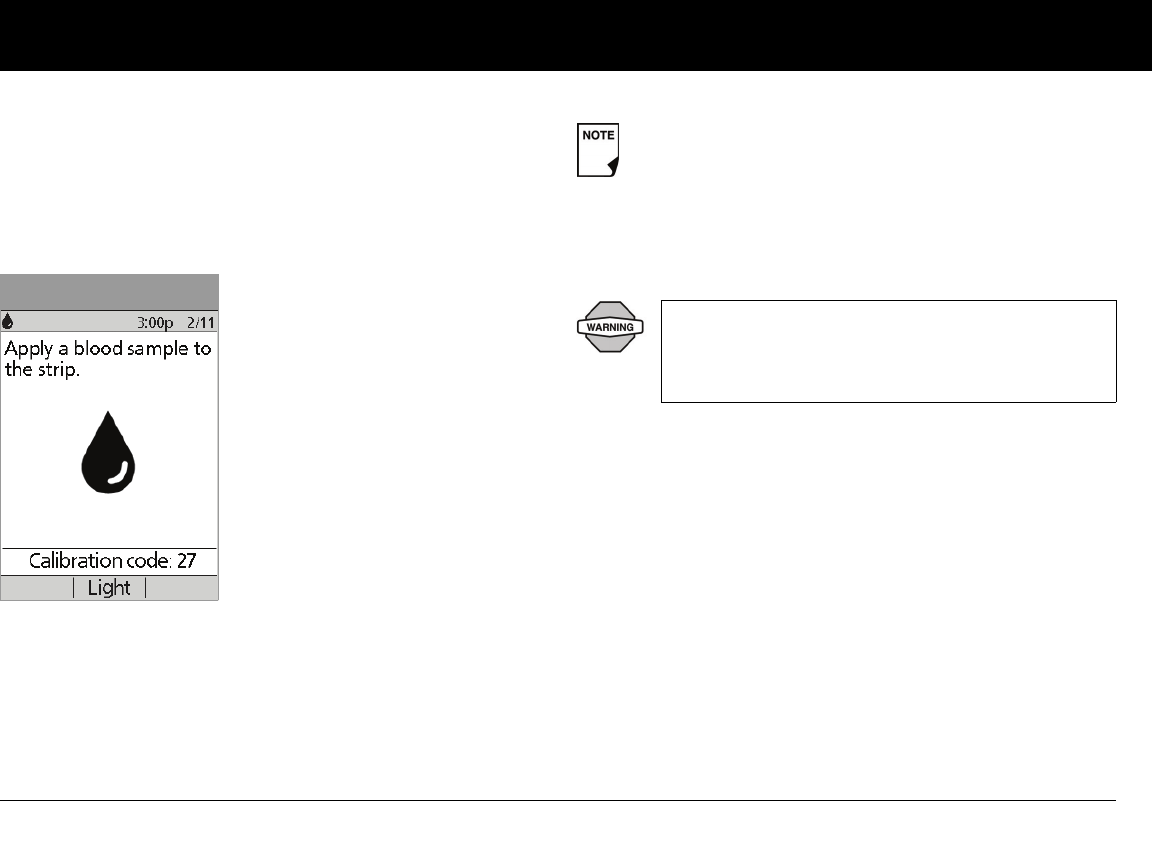
Checking Your Blood Glucose
89
7
To change the code number, press the Up/Down Controller
buttons until the number matches the number on your vial. The
numbers are between 1 and 50.
If you do not adjust the code number within 2 seconds, the next
screen appears automatically (Figure 7-20).
Lance your finger
1. To stimulate blood flow, keep your hand warm or lower your
hand to waist level and gently massage your finger.
Figure 7-20
If you need to adjust the code number after the PDM
has moved to the next screen, just press the Up/Down
Controller buttons. The code screen reappears and you
can adjust the number.
The code number remains on the PDM screen for your
reference until you have completed the BG test.
The code number on the screen should match the
code number on the side of your test strip vial (Fig-
ure 7-5). They must always match, or your results will
be inaccurate.
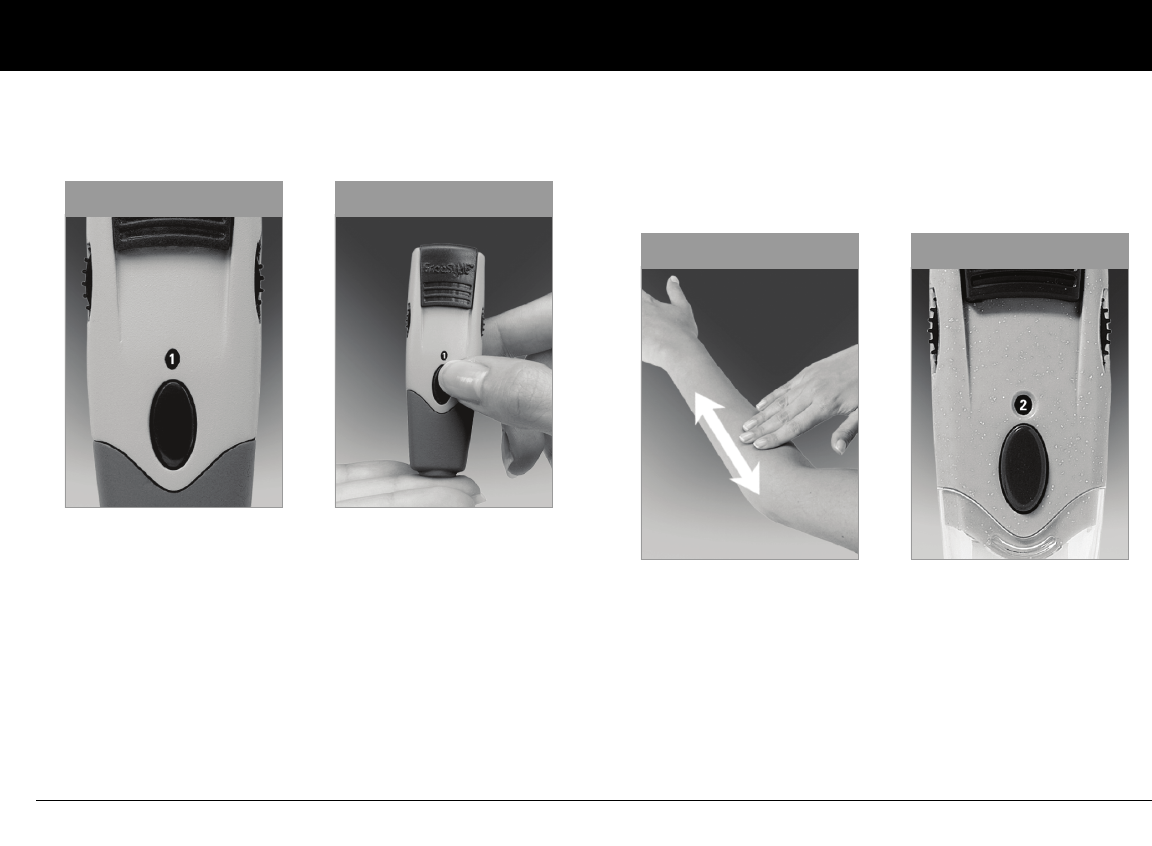
Checking Your Blood Glucose
90
7
2. Set the depth setting on the lancing device to its shallowest
depth, 1 (Figure 7-21).
3. Lightly touch the lancing device (with the gray cap) against
the side of your fingertip (Figure 7-22).
4. Depress the release button, then put down the lancing
device.
5. Gently squeeze your finger, if needed, until a blood drop the
size of a pinhead forms.
Lance your forearm, upper arm, hand, thigh, or calf
1. To bring fresh blood to the surface of the test site, rub the site
vigorously for a few seconds (Figure 7-23) until you feel it get-
ting warm.
2. Set the depth setting on the lancing device to 2 (Figure 7-24).
3. Hold the lancing device (with the clear cap) against the top of
your test site.
Figure 7-21 Figure 7-22
Figure 7-23 Figure 7-24
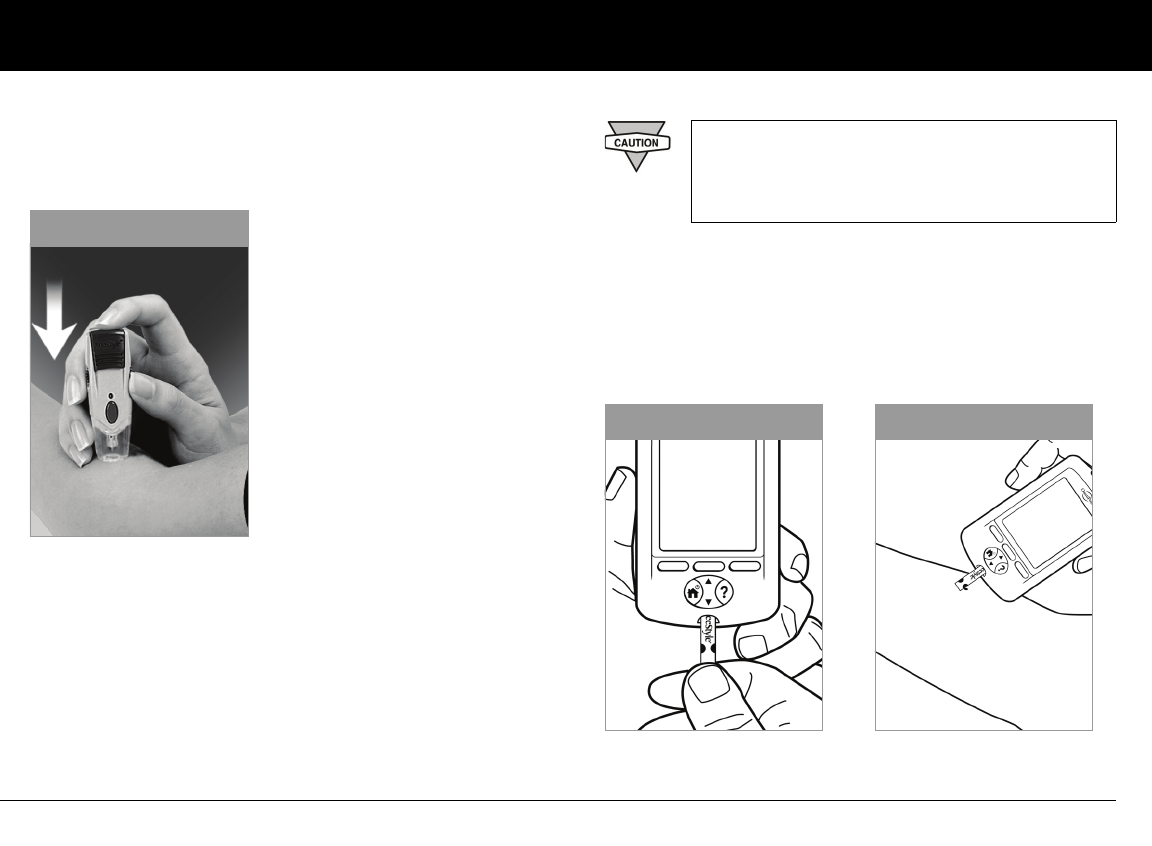
Checking Your Blood Glucose
91
7
4. Depress the release button. Do not lift up the lancing device;
instead, continue to hold it and gradually increase pressure
for several seconds (Figure 7-25).
5. While holding the lancing device on your test site, look
through the clear cap. The blood sample should be about the
size of a pinhead.
6. Lift the lancing device straight up; be careful not to smear the
blood sample on your test site.
Fill the blood glucose test strip with blood
1. Make sure that the strip is in the PDM and the PDM is pow-
ered on. If the PDM has powered off, take out the strip and
reinsert it (Figure 7-26), or simply press and hold the Power
button to turn on the PDM.
Figure 7-25
Avoid lancing areas with obvious veins or moles,
to avoid excess bleeding. Also avoid lancing
areas where tendons or bones stick out (for
example, hand bones and ankle bones).
Figure 7-26 Figure 7-27
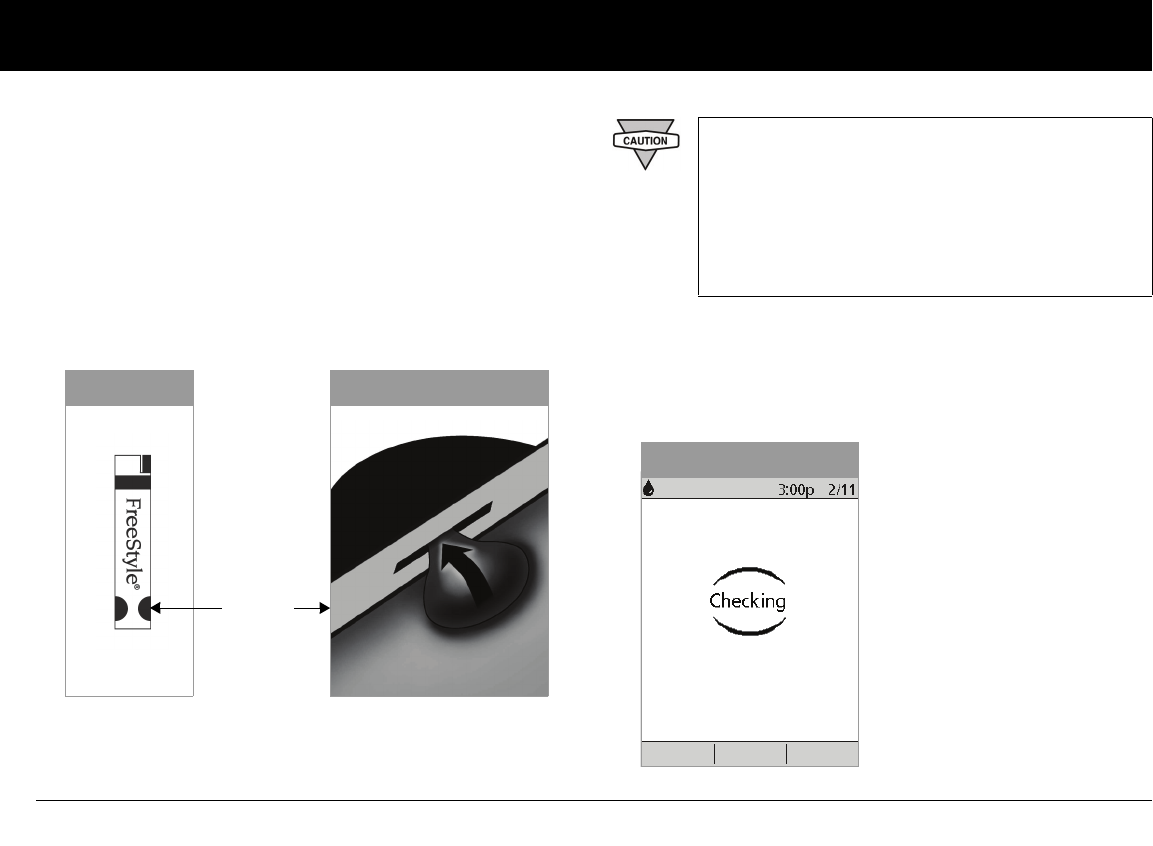
Checking Your Blood Glucose
92
7
2. Bring the strip to the blood sample at a slight angle
(Figure 7-27 on previous page).
If you do not apply the sample within 10 seconds, the strip-
port light turns off. To turn it on again, press Light.
Use only one edge of the blood glucose test strip per test. Do
not apply blood to both edges (Figure 7-28). Only use strips
once. Discard used strips.
The strip acts like a sponge and pulls the blood into the strip
through the edge (Figure 7-29). Wait for the reading
1. Do not lift up the strip until you hear 1 beep or see the word
“Checking” on the screen (Figure 7-30). This means you
applied enough blood and the meter is reading your glucose.
Figure 7-28 Figure 7-29
Do not:
• Press the strip against the test site
• Scrape the blood onto the strip
• Apply blood to the flat side of the strip
• Apply blood to the strip when it is out of the meter
• Put blood or foreign objects into the test strip port
Figure 7-30
Edge of
test strip
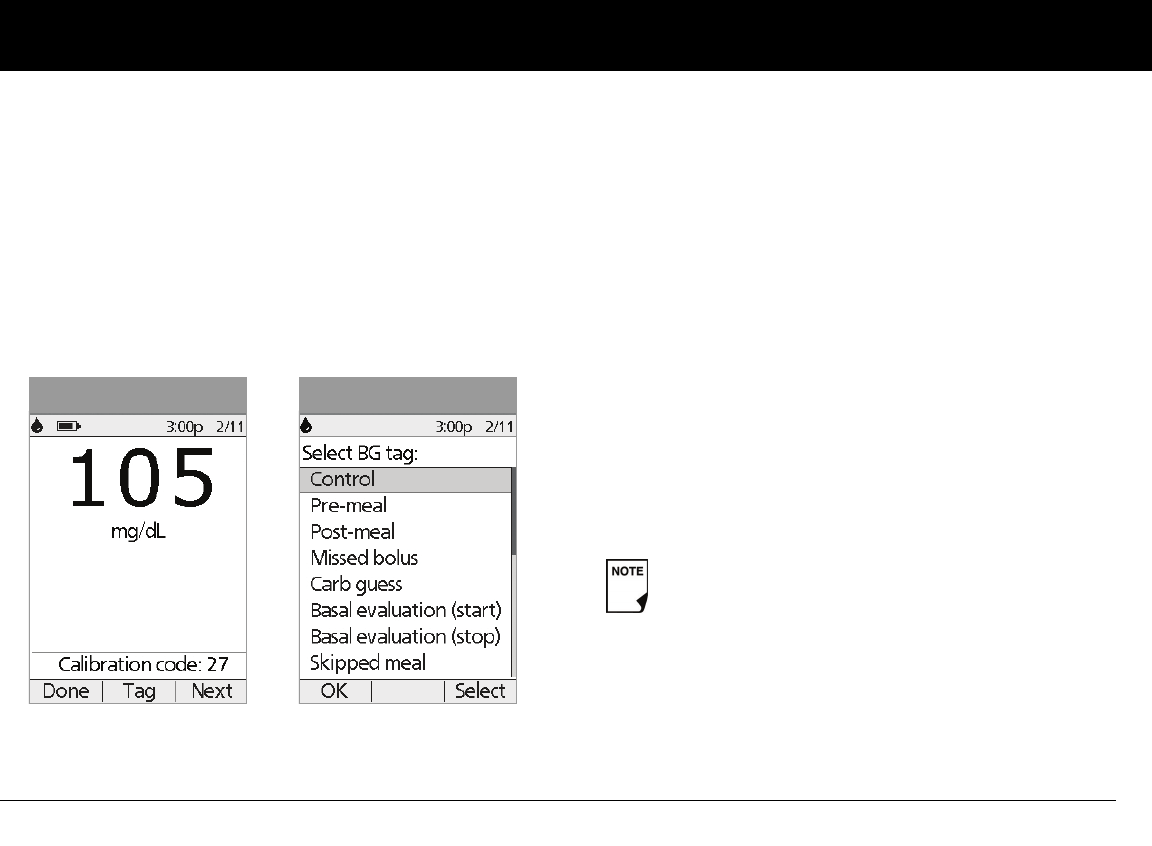
Checking Your Blood Glucose
93
7
2. If after 5 seconds the PDM does not display “Checking,” the
sample may be too small. If needed, add more blood to the
same edge of the strip for up to 60 seconds from the time of
the first application.
The strip-port light turns off when the blood sample is
accepted.
3. The reading is complete when you hear 2 beeps (if BG sound
is turned On) and the PDM shows your reading on the screen
(Figure 7-31).
The time the test takes depends on your blood glucose level.
The higher your glucose level, the longer it takes to get a
result. When your blood glucose level is in the range of 100 to
150 mg/dL, a result appears in an average of 7 seconds.
4. To mark the result as a pre- or post-meal test, to indicate a
level of exercise, or to indicate other situations connected to
this blood glucose reading, press Tag. Then:
a. Use the Up/Down Controller buttons to select a tag,
then press Select (Figure 7-32).You can select a second
tag for the reading in the same way.
To learn how to manage your list of tags and to add
custom tags, see ”Manage the Blood Glucose Tags List” in
Chapter 6, Using the Personal Diabetes Manager.
b. Press OK to return to the reading screen (Figure 7-31),
then press Next.
5. If you do not want to mark the test, press Next instead of Tag.
6. Remove the test strip. If the strip-port light was turned on, it
now turns off.
Figure 7-31 Figure 7-32
If the suggested bolus calculator feature is turned Off,
the Bolus soft key appears instead of Next.
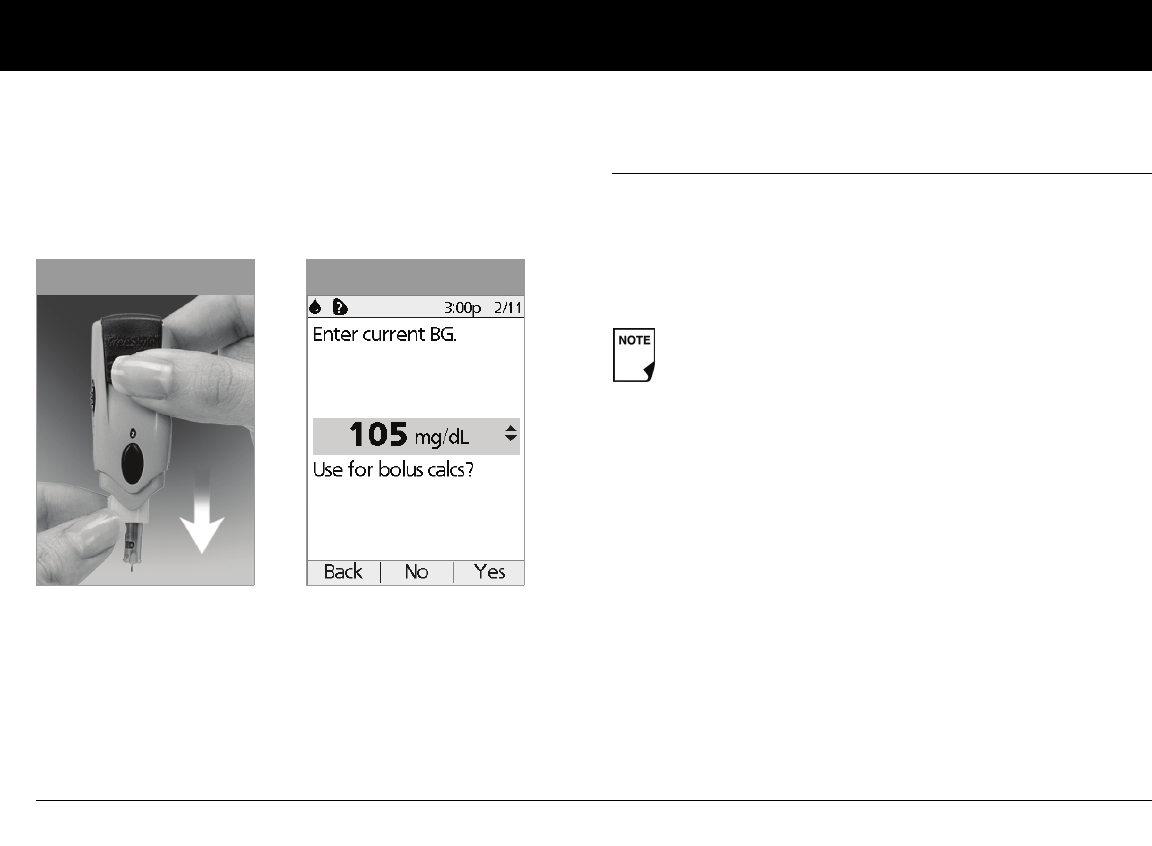
Checking Your Blood Glucose
94
7
Remove the lancet
When you have finished testing, snap off the cap from the
lancing device. Hold the lancet over a sharps container or a
puncture-proof container with a lid. Pinch the white clip that
holds the lancet until the lancet falls out (Figure 7-33).
e
■ Blood Glucose Results and the Suggested Bolus
Calculator
If the suggested bolus calculator feature is turned On when you
check your blood glucose, the PDM will display the result. From
here, press Next to enter carbs (if eating) and have the System
calculate a suggested bolus. (See “Suggested Bolus Calculator” in
Chapter 4, Understanding and Delivering Bolus Doses.)
If the suggested bolus calculator feature is turned Off, the Next
soft key does not appear. Instead:
Press Bolus to open a screen where you can enter a bolus
manually.
Or press Done to return to the Status screen to see the most
recent BG result.
The BG result, either from the PDM or from manual entry, is
stored in the System’s history, whether suggested bolus calcula-
tor is turned On or Off. (See “Blood Glucose History Records” in
Chapter 8, Understanding Your Records.)
Figure 7-33 Figure 7-34
If you use the suggested bolus calculator within 10
minutes after taking a blood glucose reading, or if you
store a BG reading (for example, one you enter manually)
within the same 10 minutes, the BG value will be popu-
lated automatically for use in the suggested bolus
calculator process (Figure 7-34).
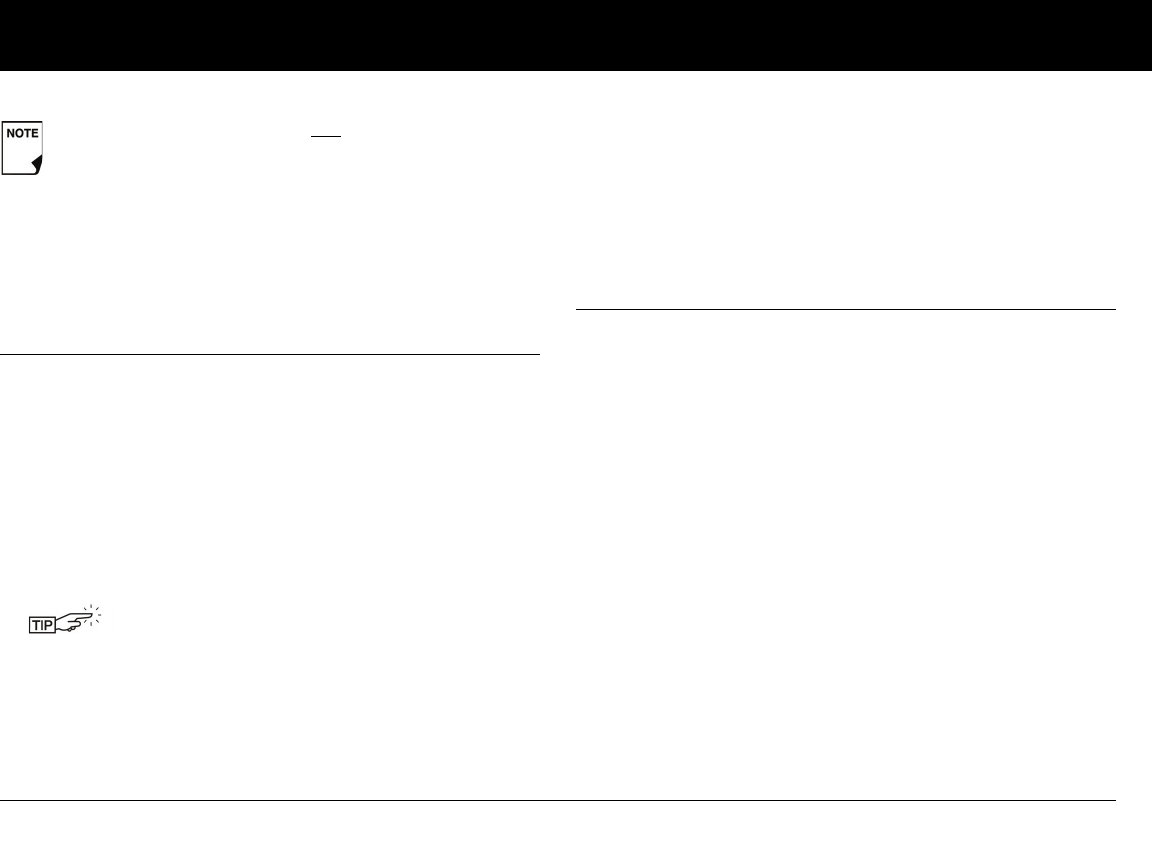
Checking Your Blood Glucose
95
7
■ Entering Blood Glucose Readings Manually
You can enter blood glucose readings manually into the PDM.
This is particularly helpful if you use a separate blood glucose
meter.
1. On the Home screen, use the Up/Down Controller buttons
to choose More actions; then press Select.
2. Choose Add BG reading, then press Select.
3. Use the Up/Down Controller buttons to enter the BG read-
ing from your separate meter.
4. Press Tag to assign a tag to the reading. Press OK when fin-
ished. (For an explanation of entering tags, see page 93.)
5. Press Save to save the reading.
Or press Cancel to return to the More actions menu without
saving the reading.
■ Editing Tags
Within 2 hours of a blood glucose reading, you can remove or
change a tag or add one. However, you cannot alter a Control
tag.
1. On the Home screen, use the Up/Down Controller buttons
to choose More actions; then press Select.
2. Choose Assign/Edit BG tags, then press Select.
3. Use the Up/Down Controller buttons to choose a reading,
then press Tag (Figure 7-35 on the next page). A “?” icon is
shown to the right of any reading to which you have already
assigned one or two tags.
The Bolus Entry screen does not open if:
• A regular bolus is currently in process
• The meter temperature is out of range
• You have tagged this BG reading as a Control
• The BG reading is less than your “Min BG for calcs”
• Insulin is suspended
To enter a “LOW” reading, press the Up/Down
Controller buttons down until you reach the mini-
mum value (20); then press down one more time.
To enter a “HIGH” reading, press up until you reach
the maximum value (500); then press up one more
time.
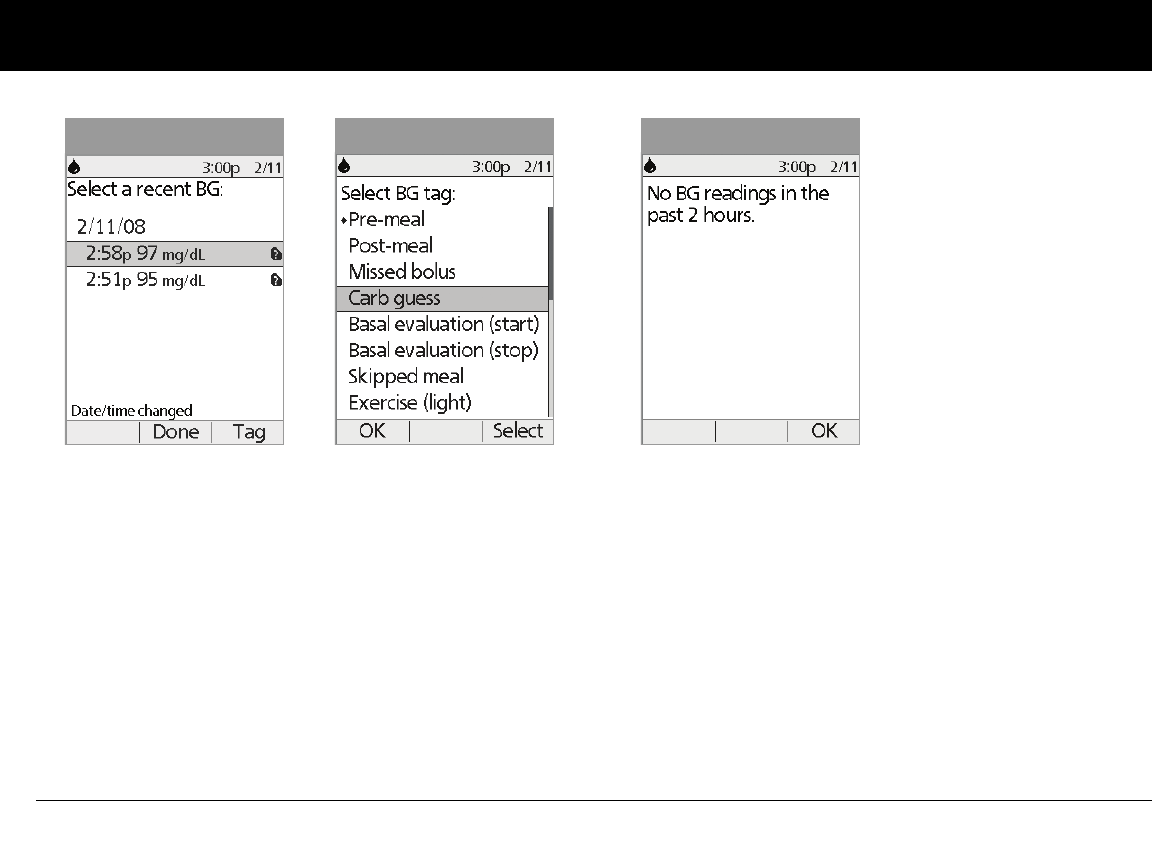
Checking Your Blood Glucose
96
7
Or press Done to return to the More actions menu.
4. Use the Up/Down Controller buttons to choose the first tag
you want, then press Select (Figure 7-36). A diamond icon
appears next to selected tags, as in “Pre-meal” in the figure. You
can select up to two tags for each BG reading.
5. To remove a selected tag, highlight it and press Clear. (The
soft key changes from Select to Clear when you highlight
the tag.)
6. Press OK to return to the list of readings.
If no BG readings have been entered into the PDM within the
past 2 hours, you will see the screen in Figure 7-37. Press OK to
return to the More actions menu.
To learn how to manage your list of tags and to add custom tags,
see ”Manage the Blood Glucose Tags List” in Chapter 6, Using the
Personal Diabetes Manager.
Figure 7-35 Figure 7-36 Figure 7-37
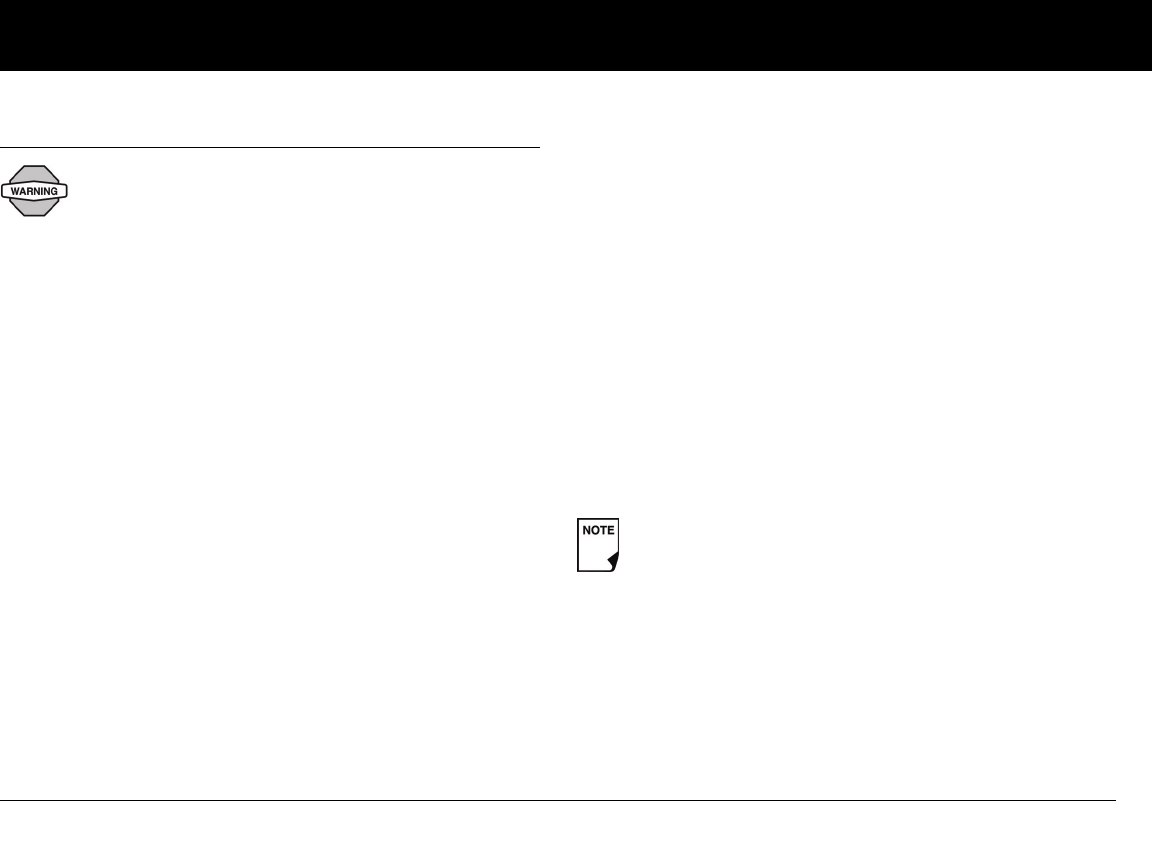
Checking Your Blood Glucose
97
7
■ Low and High Blood Glucose Readings
WARNINGS!
“LOW” or “HIGH” blood glucose readings can indicate a poten-
tially serious condition requiring immediate medical attention.
If left untreated, this situation can quickly lead to diabetic keto-
acidosis (DKA), shock, coma, or death.
Low readings
If your reading is below 20 mg/dL, the PDM displays: “LOW Treat
your low BG!” This indicates severe hypoglycemia (low blood
glucose).
Low reading with symptoms
If you get a “LOW Treat your low BG!” reading and feel symptoms
such as weakness, sweating, nervousness, headache, or confu-
sion, follow your healthcare provider’s recommendation to treat
hypoglycemia.
Low reading without symptoms
If you get a “LOW Treat your low BG!” reading but have no symp-
toms of low blood glucose, retest with a new strip. If you still get
a “LOW Treat your low BG!” reading, follow your healthcare pro-
vider’s recommendation to treat hypoglycemia.
High readings
If your reading is above 500 mg/dL, the PDM displays “HIGH
Check for ketones!” This indicates severe hyperglycemia (high
blood glucose).
High reading with symptoms
If you get a “HIGH Check for ketones!” reading and feel symp-
toms such as fatigue, thirst, excess urination, or blurry vision,
follow your healthcare provider’s recommendation to treat
hyperglycemia.
High reading without symptoms
If you get a “HIGH Check for ketones!” reading but have no symp-
toms of high blood glucose, retest with a new strip. If you still get
a “HIGH Check for ketones!” reading, follow your healthcare pro-
vider’s recommendation to treat hyperglycemia.
You can add and edit tags for LOW and HIGH BG readings
just as you would to any other reading. To add tags, see
page 93; to edit tags, see page 95.
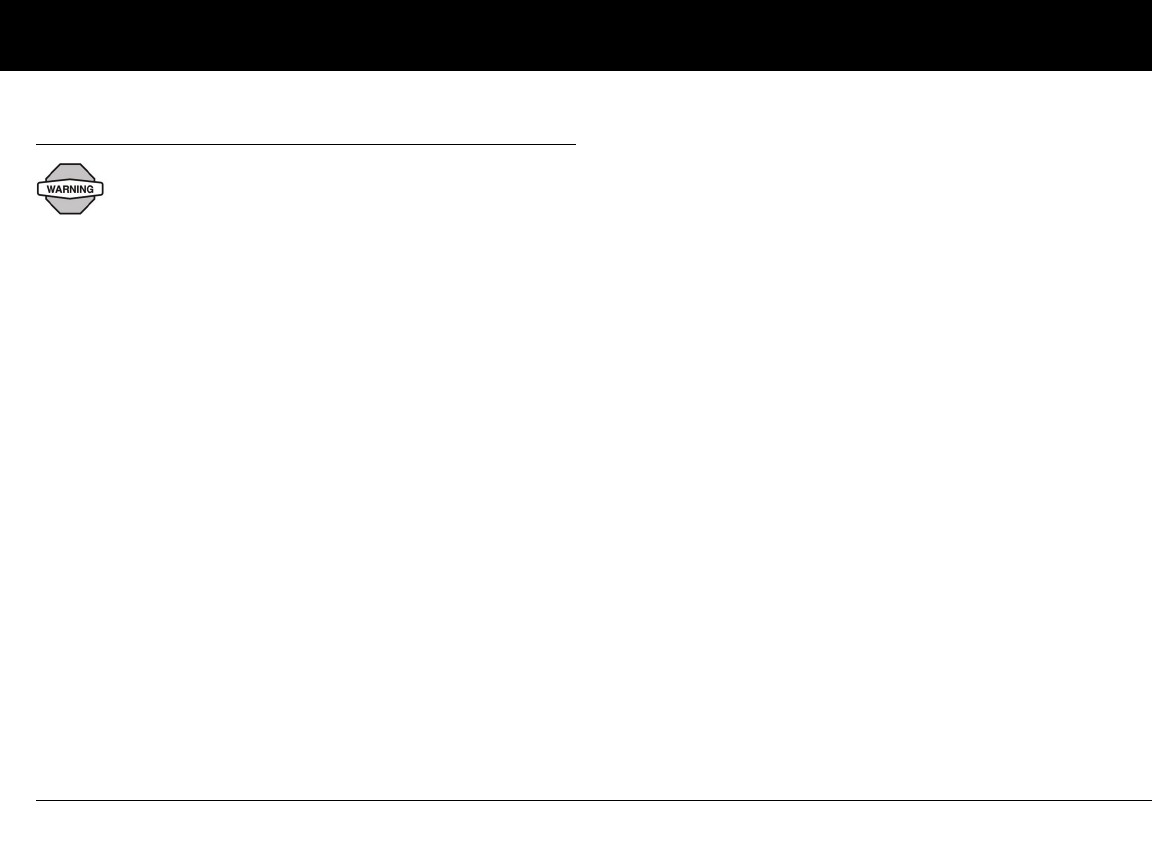
Checking Your Blood Glucose
98
7
■ Important Health-Related Information
WARNINGS!
• Severe dehydration and excessive water loss may cause false
low results. If you believe you are suffering from severe dehy-
dration, consult your healthcare provider immediately.
• Test results below 70 mg/dL mean low blood glucose (hypo-
glycemia).
• Test results greater than 250 mg/dL mean high blood
glucose (hyperglycemia).
• If you get results below 70 mg/dL or above 250 mg/dL, but
do not have symptoms of hypoglycemia or hyperglycemia
(see Chapter 9, Living with Diabetes), repeat the test. If you
have symptoms or continue to get results that fall below 70
mg/dL or above 250 mg/dL, follow the treatment advice of
your healthcare provider.
• If you are experiencing symptoms that are not consistent
with your blood glucose test and you have followed all
instructions described in this User Guide, call your healthcare
provider immediately.
• Blood circulation is different between the finger or palm (at
the base of the thumb) and other test sites like the forearm,
upper arm, hand, thigh, and calf. You may see differences in
blood glucose measurements between the other test sites
and your finger or palm (at the base of the thumb) after eat-
ing, insulin medication, or exercise.
• You may see changes in blood glucose in blood samples
from the finger or palm (at the base of the thumb) sooner
than in blood samples from the forearm and other alternate
sites. Vigorous rubbing of the alternate test sites before lanc-
ing helps to minimize these differences.
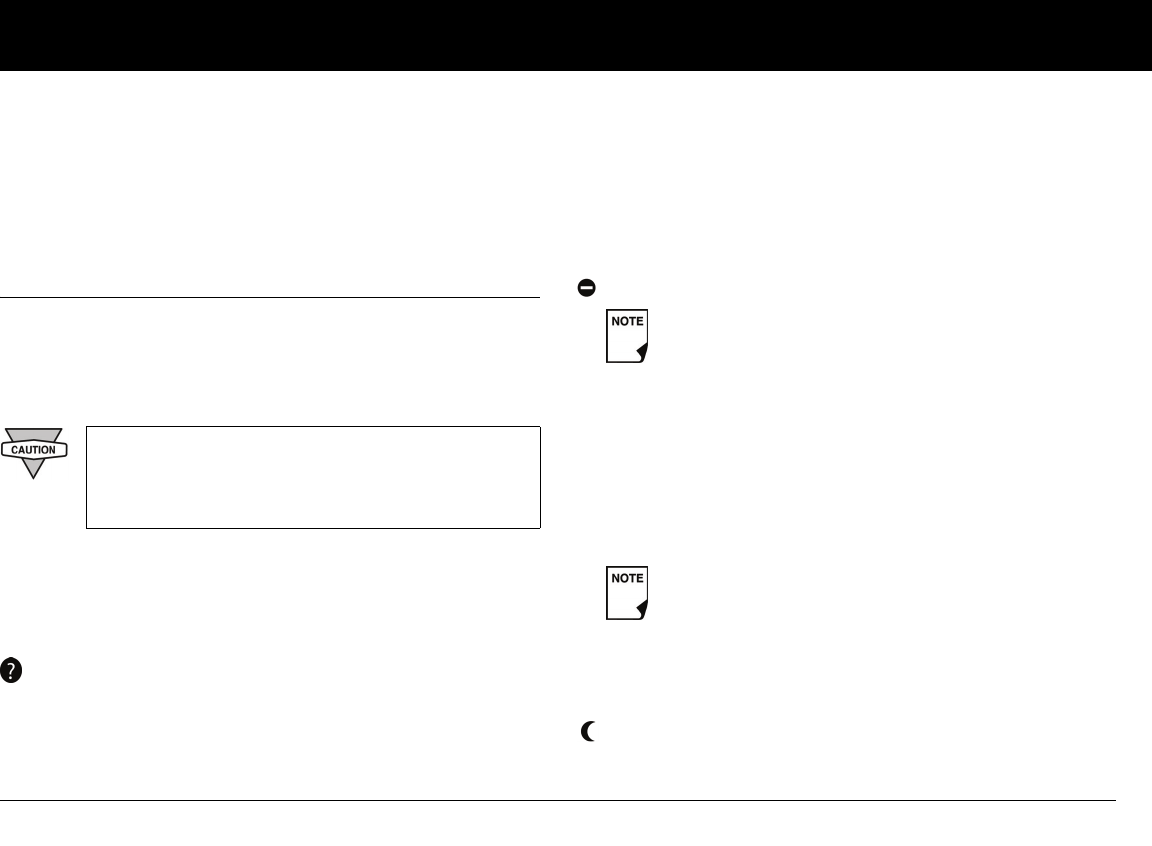
99
CHAPTER 8
Understanding Your Records
■ Record Keeping
Record keeping is an important part of successful diabetes man-
agement. The Personal Diabetes Manager (PDM) helps simplify
this task. It automatically stores records of insulin-delivery his-
tory, blood glucose readings, alarms, and carbohydrates.
Special symbols in record screens
In the record screens, you may encounter several special
symbols:
If the PDM batteries run out, data in the memory is at
risk. Do NOT remove the old batteries until you have
new ones at hand. The longer the batteries are
removed, the more the memory is at risk.
Records with a question-mark symbol next to them have
additional information available. To see this information, use
the Up/Down Controller buttons to highlight the record,
then press the User Info/Support button to view details
about that record.
The record for this item has been “lost.”
If the PDM can no longer communicate with an
active Pod, then you must activate a new Pod. The
PDM may not be able to communicate with the
active Pod because of signal interference or because
you have discarded the Pod. If you change the Pod
without getting a Status update, any “unconfirmed”
records will be “lost.” If this occurs, the PDM will not
display insulin totals for any day containing “lost”
records.
✔The record for this item is “unconfirmed.”
When you power on the PDM, it will request a status
update from the active Pod and then update the
insulin history. If the PDM does not receive a status
update from the Pod, the PDM will update history
with “unconfirmed” records. The next time the PDM
receives a status update, it will update these records.
This insulin delivery item spans midnight. The date given
is the start date.
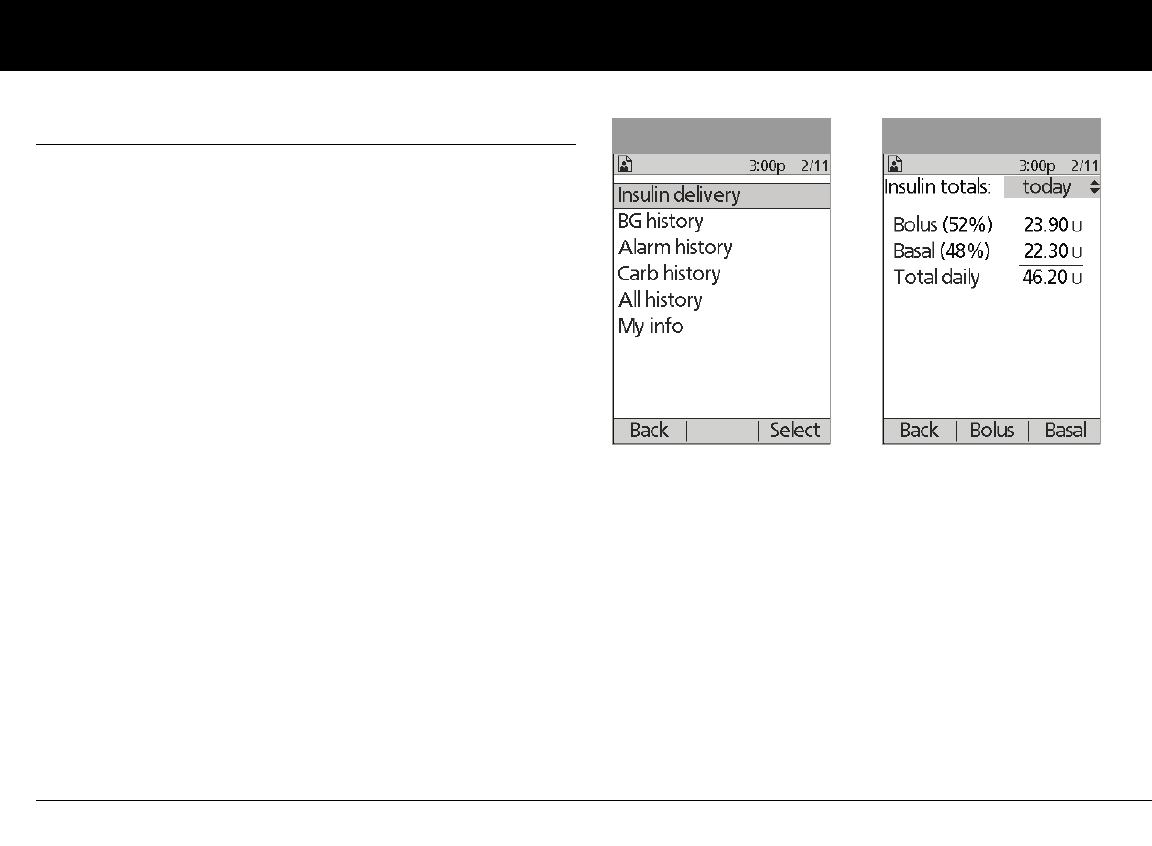
Understanding Your Records
100
8
■ Insulin Delivery Records
The PDM stores:
•Basal rates (including any rate changes and temporary basals)
•Bolus doses (both normal and extended)
• Dates, times, and how long insulin delivery was suspended,
and dates and times when it was resumed
• Total daily doses (basal plus boluses) by date
The PDM can store over 5,000 records or approximately 90 days’
worth of information. Once the memory is full, new information
begins to replace the oldest information.
View insulin delivery records
1. On the Home screen, use the Up/Down Controller buttons
to choose My records, then press Select.
2. Choose Insulin delivery, then press Select (Figure 8-1).
The PDM displays a summary of today’s information,
including total boluses delivered, total basal amount deliv-
ered, and total daily dose delivered (Figure 8-2). Press the
Up/Down Controller buttons to view the summary for
previous days.
Wherever you see the ? symbol, press the User Info/Support
button to see additional information.
3. To review your basal history by day, press Basal.
The display shows the basal deliveries that have occurred for
the current day, most recent first (Figure 8-3 on the next
page). The active basal rate or program is indicated by a dia-
mond icon (♦).
Figure 8-1 Figure 8-2
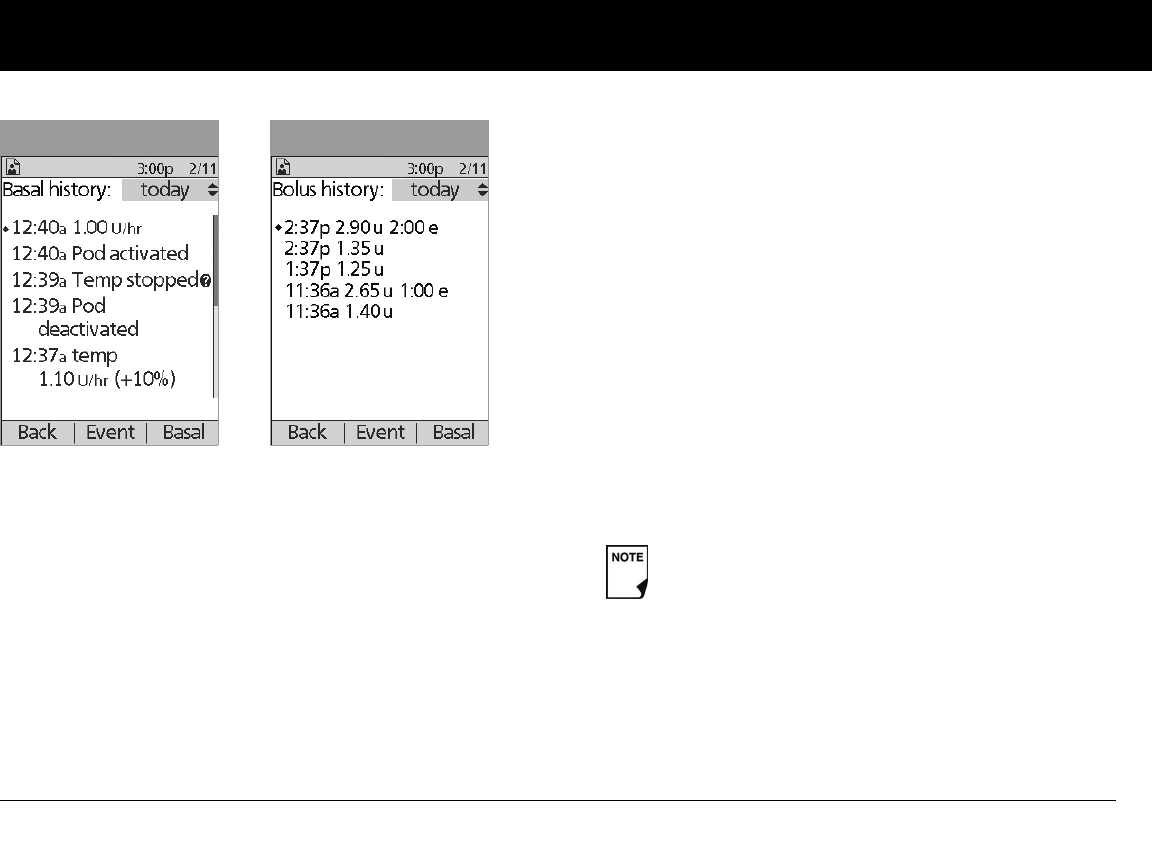
Understanding Your Records
101
8
For a temporary basal, the display shows the % adjustment to
the default basal. So, in Figure 8-3, “1.10 temp U/hr (+10%)”
means that you delivered a temporary basal of 1.10 units per
hour, which was 10% more than the default basal. (Notice
that two hours later, the basal rate returns to the default.)
Also, the “Pod activated” entry shows what time you applied
a new Pod.
Press the Up/Down Controller buttons for earlier or later
dates.
Press Event to use the Up/Down Controller buttons to scroll
through the list of information on the screen. Choose a
record, then press the User Info/Support button to view
details about that record. Record details may include insulin
delivery that was interrupted due to a Pod alarm, Pod deacti-
vation, or user cancellation. The screen shows the amount of
the bolus or basal that remained undelivered.
4. Press Day to return to dates.
5. To review your bolus history by day, press Bolus.
The display indicates whether the bolus was normal or
extended (marked “e,” Figure 8-4). Normal and extended
boluses are displayed separately even if they were pro-
grammed at the same time. Extended boluses are shown
with time and duration. If an extended bolus is active, a dia-
mond icon (♦) appears next to it. If a bolus was cancelled,
only the amount delivered before cancellation is shown.
Press the Up/Down Controller buttons for different dates.
Press Event to use the Up/Down Controller buttons to scroll
through the list of information on the screen. Press Day to
return to dates.
Figure 8-3 Figure 8-4
The amount shown after cancellation may be in 0.05
unit increments, even though you may have pro-
grammed the bolus increment to be in 0.10 units.
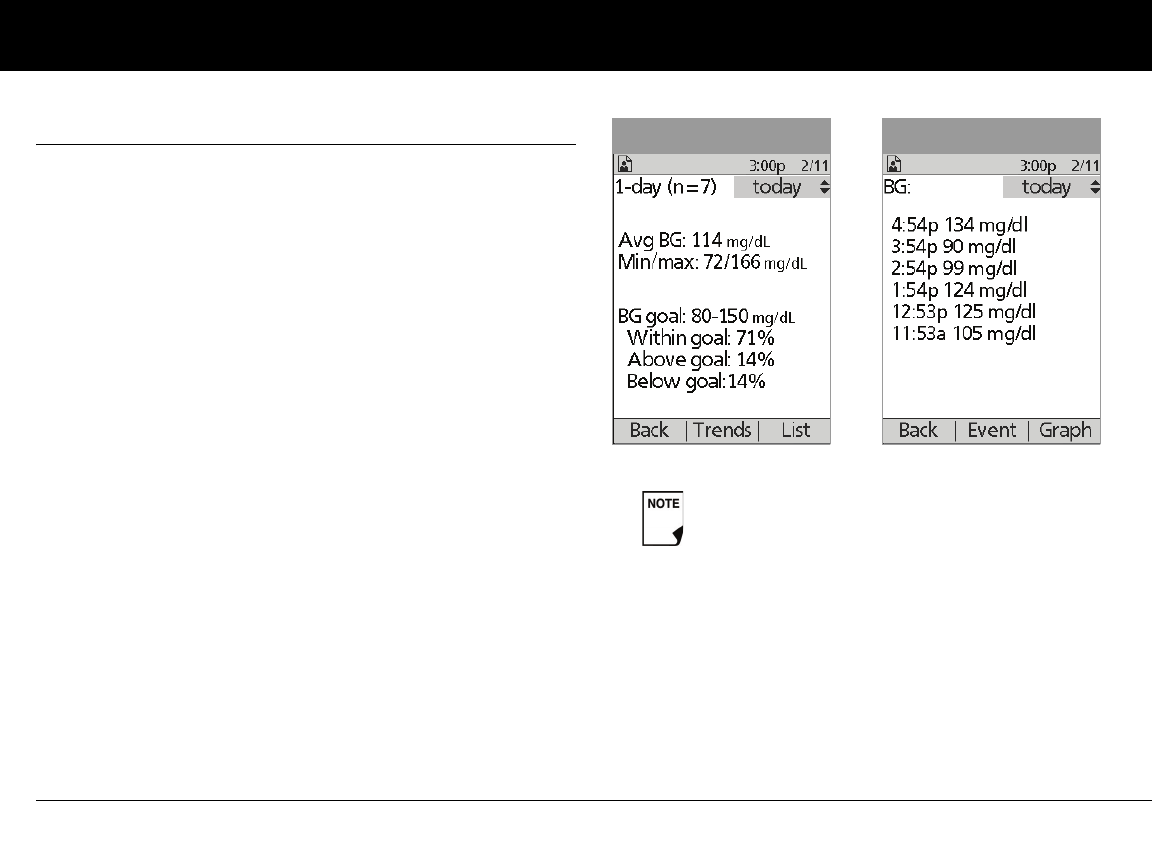
Understanding Your Records
102
8
■ Blood Glucose Records
The PDM stores blood glucose records for the past 90 days. You
can choose to view individual readings, single-day trends with
individual readings, or trends for the previous 7, 14, 30, 60, or 90
days.
View single-day trends
1. On the Home screen, use the Up/Down Controller buttons
to choose My records, then press Select.
2. Choose BG history, then press Select.
The PDM displays the current-day trends first (Figure 8-5),
including:
• Number of days and number of blood glucose
readings (n)
• Average blood glucose (Avg BG)
• Lowest and highest blood glucose (Min/max)
•The BG goal you have set
• Percentage of readings within the BG goal
• Percentage of readings above the BG goal
• Percentage of readings below the BG goal.
3. Press List to see a list of the current day’s readings
(Figure 8-6).
LOW and HIGH readings are included in the number
of BG readings (n), but not in calculations or averages.
Figure 8-5 Figure 8-6
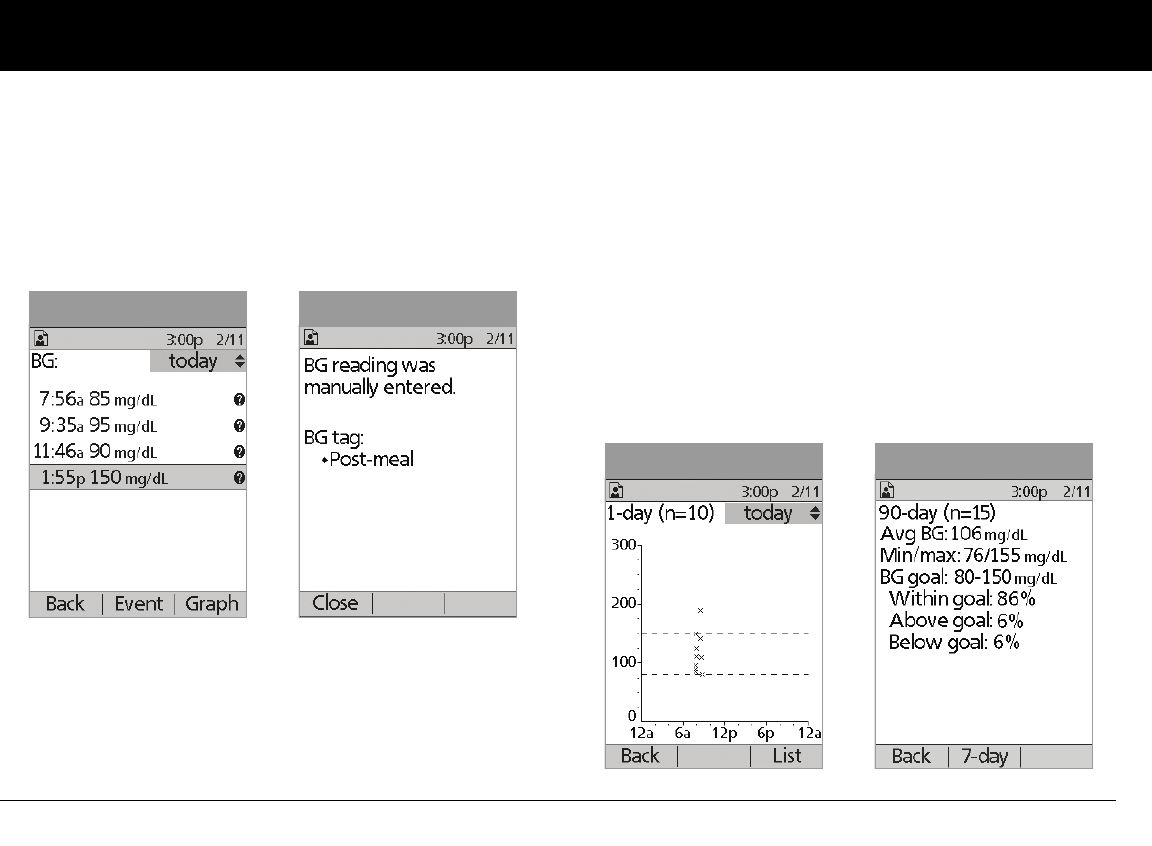
Understanding Your Records
103
8
In the List view, press Event to select individual readings.
Readings with a question-mark icon next to them have addi-
tional information available (Figure 8-7). To see this informa-
tion, use the Up/Down Controller buttons to choose the
reading. Then press the User Info/Support button to view
details about that reading (Figure 8-8).
4. Press Close to return to the List view.
5. Press Graph to see a graph of the data (Figure 8-9).
View multiple-day trends
1. On the Home screen, use the Up/Down Controller buttons
to choose My records, then press Select.
2. Choose BG history, then press Select.
3. Press Trends to display blood glucose data for the past 7
days.
4. Continue pressing the middle soft key to view trends for the
previous 14, 30, 60, and 90 days.
The PDM displays the same details for multiple days as for
single days, plus the average number of BG measurements
taken per day (Figure 8-10).
Figure 8-7 Figure 8-8
Figure 8-9 Figure 8-10
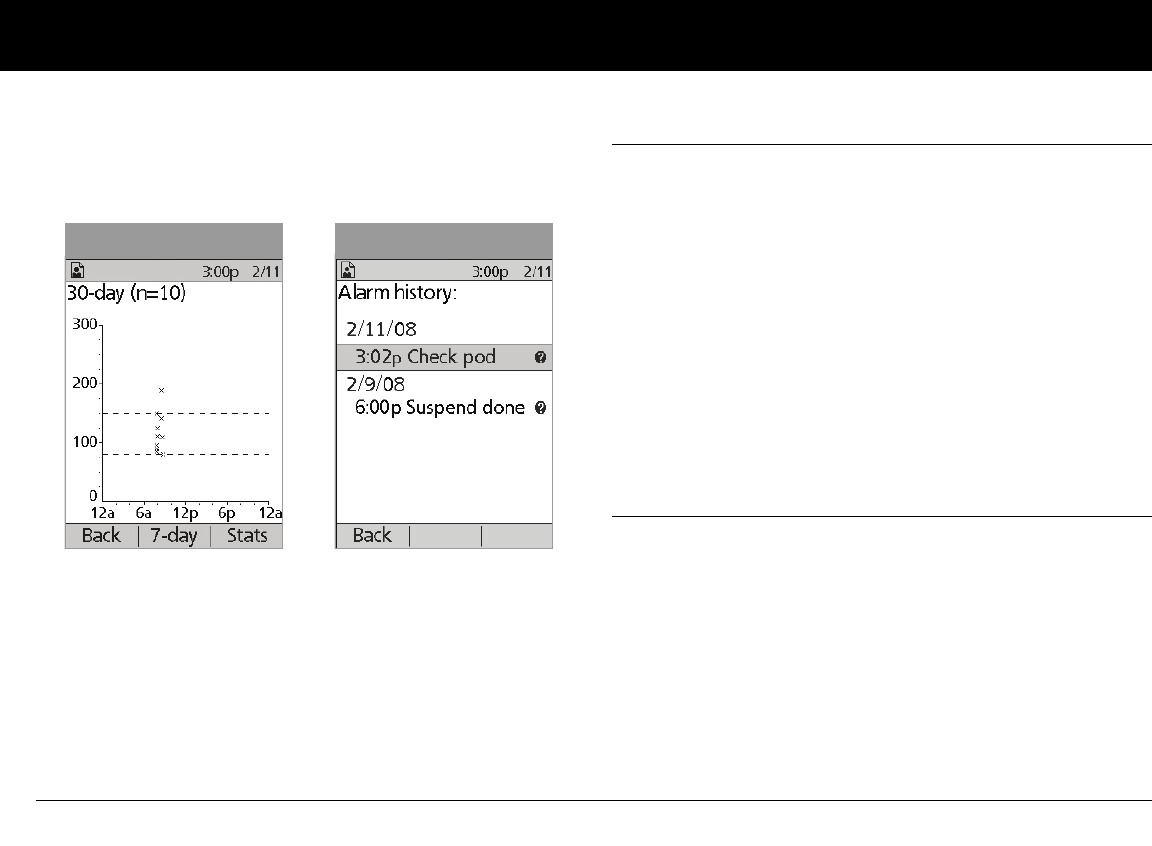
Understanding Your Records
104
8
5. For the 7-, 14-, and 30-day trends, press Graph to see a graph
of the trends (Figure 8-11). (Graphs are not available for 60-, or
90-day trends.) Press Stats to return to the detail view.
6. Press Back to return to the single-day trends.
■ Alarm Records
The PDM lists the entire alarm history for the OmniPod System.
The PDM can store over 90 days’ worth of alarm records.
1. On the Home screen, use the Up/Down Controller buttons
to choose My records, then press Select.
2. Choose Alarm history, then press Select.
The PDM displays the date, time, and type of each alarm
(Figure 8-12).
3. Press the Up/Down Controller buttons to see additional
screens.
4. Choose an alarm record, then press User Info/Support to
see more information.
■ Carbohydrate Records
The PDM displays the record of carbohydrates you have entered.
1. On the Home screen, use the Up/Down Controller buttons
to choose My records, then press Select.
2. Choose Carb history, then press Select.
The PDM displays the date, time, and grams of carbohydrate
you have entered (Figure 8-13 on th following page).
Figure 8-11 Figure 8-12
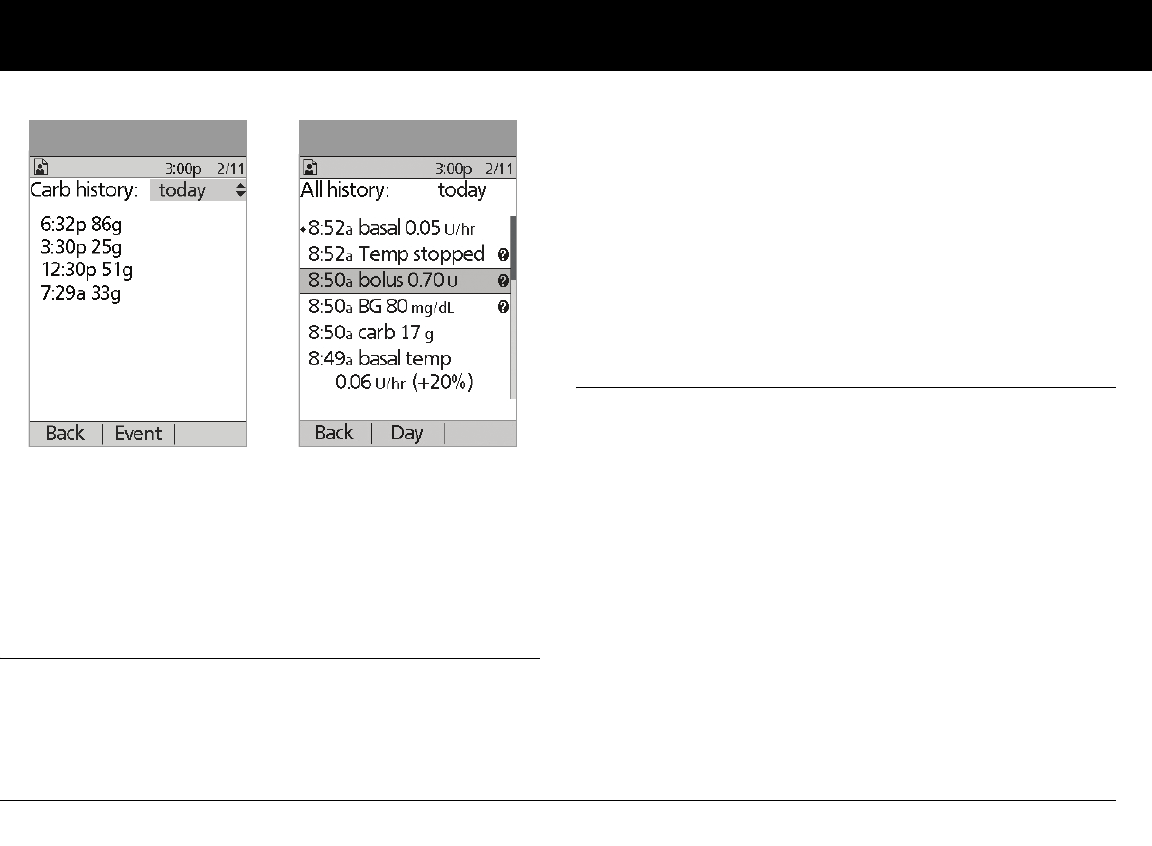
Understanding Your Records
105
8
3. Press the Up/Down Controller buttons to see additional
days.
Press Event to use the Up/Down Controller buttons to scroll
through the list of information on the screen. Press Day to
use the Up/Down Controller for dates.
■ All Records
The PDM displays the combined insulin delivery, blood glucose,
alarm, and carbohydrate records.
1. On the Home screen, use the Up/Down Controller buttons
to choose My records, then press Select.
2. Choose All history, then press Select.
The PDM displays all history for the most recent date (Figure
8-14).
3. Press the Up/Down Controller buttons to see additional
days.
Press Event to use the Up/Down Controller buttons to scroll
through the list of information on the screen. Press Day to
use the Up/Down Controller for dates.
■ User Information/Support
You or your healthcare provider may have entered personal
contact information during your start-up visit. To view this infor-
mation, press the User Info/Support button (to the right of the
Power button) while on the Home screen. Or follow the steps
below to view the information. You can add or change the user
information at any time.
You may want to include your name, address, phone, email
address, emergency contact and phone, doctor’s or healthcare
provider’s name and phone, prescription numbers, or other
information.
The user information screen also displays contact information for
Insulet Corporation and product information for your OmniPod
System (make, model, serial number). You cannot change this
information.
Figure 8-13 Figure 8-14
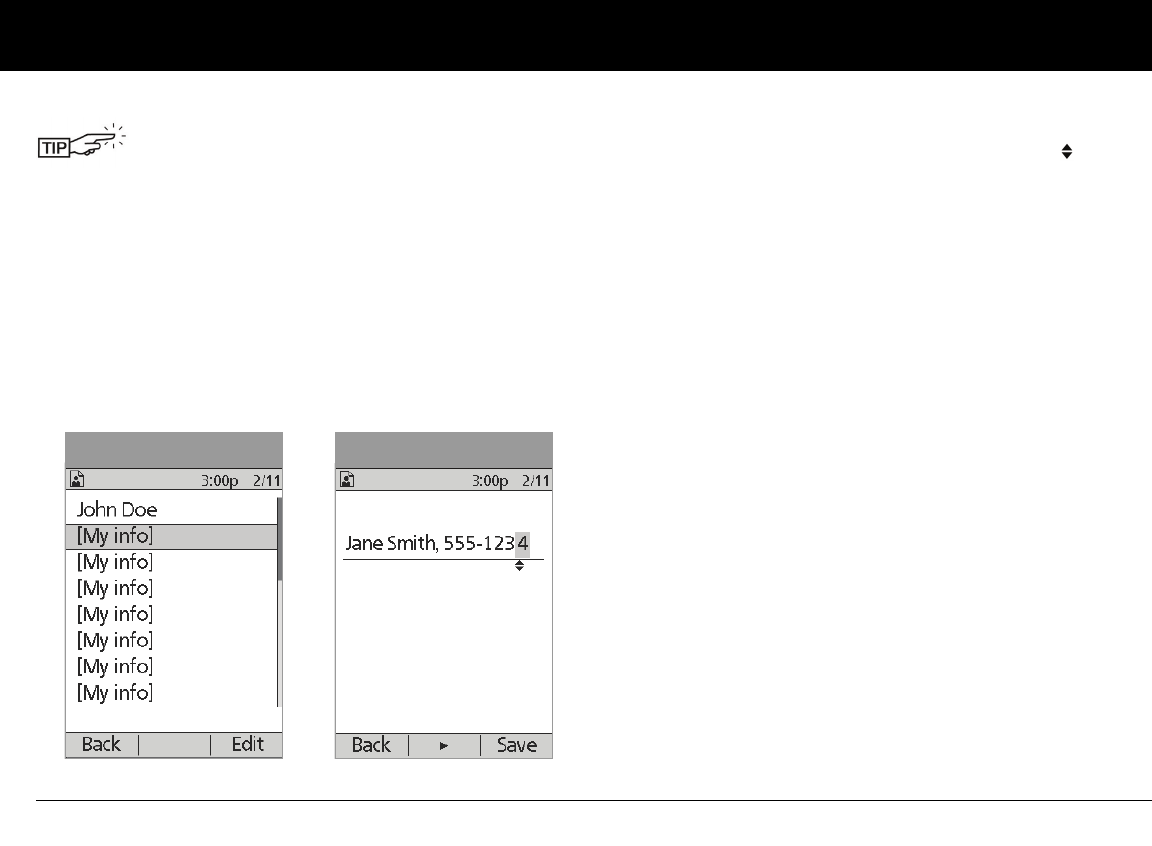
Understanding Your Records
106
8
Add or change user information
1. On the Home screen, use the Up/Down Controller buttons
to choose My records, then press Select.
2. Choose My info, then press Select.
3. Choose [My info] (Figure 8-15), then press Edit.
4. Press the Up/Down Controller buttons to scroll through the
list of characters. An up-and-down-arrow symbol ( ) on the
screen indicates the character you are changing.
5. Press the middle soft key to move the underscore to the next
character.
6. Enter each character one at a time. For example, if you want
to enter your address, you might enter 5, 6, 5, [space], M, a, i, n,
[space], S, t, [period]. (A blank character or space is the first
and last option in the scrolling menu.)
For your healthcare provider and local phone number, you
might enter J, a, n, e, [space], S, m, i, t, h, [comma], [space], 5, 5,
5, [hyphen], 1, 2, 3, 4 (Figure 8-16).
7. Press Save.
8. Repeat steps 3–7 for each line of personal information you
want to enter or change. Twenty lines are available.
The User Info/Support icon is also displayed on the
suggested bolus screen. For information about the
support information displayed on these screens,
see Chapter 4, Understanding and Delivering Bolus
Doses.
Figure 8-15 Figure 8-16
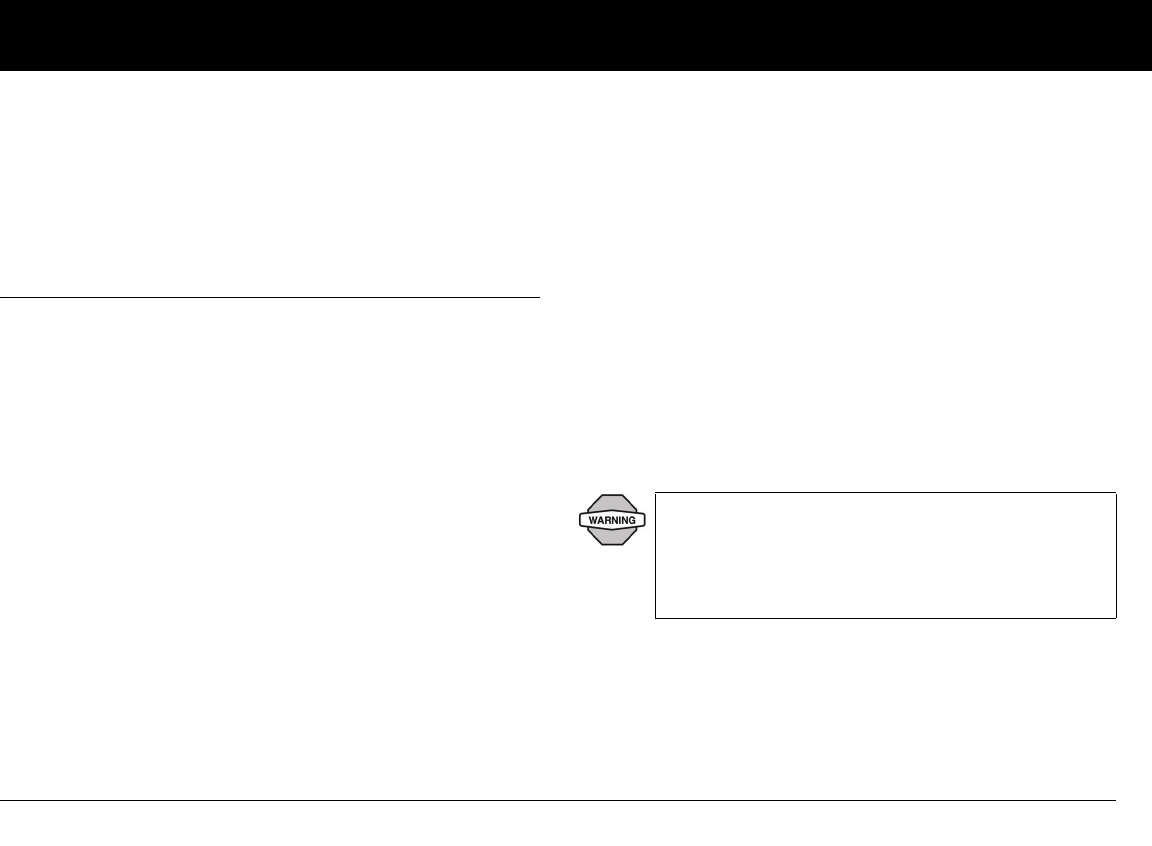
107
CHAPTER 9
Living with Diabetes
■ Your Role: Safely Using the OmniPod System
Before deciding on the OmniPod Insulin Management System,
you and your healthcare provider discussed the advantages and
benefits of the OmniPod System, as well as the responsibilities
that come with insulin pump therapy. Remember: safe use
begins and ends with you. If you have questions or doubts about
being able to safely use the OmniPod System at any time, consult
your healthcare provider immediately.
Most problems are easily avoided by:
• Learning all you can about successful diabetes management.
• Being actively involved in your treatment.
•Checking your blood glucose levels frequently.
• Washing your hands and disinfecting infusion sites to reduce
the possibility of infection.
• Being aware of the signs of hypoglycemia (low blood glu-
cose), hyperglycemia (high blood glucose), and diabetic
ketoacidosis (DKA). (See “Avoid Lows, Highs, and DKA” later in
this chapter.)
• Keeping a diabetes emergency kit with you at all times. (See
“Prepare for Emergencies” later in this chapter.)
• Knowing how to contact your healthcare provider in case of
an emergency.
If you are unable to use the OmniPod Insulin Man-
agement System according to instructions, you may
be putting your health and safety at risk. Talk with
your healthcare provider if you have questions or con-
cerns about using the OmniPod System.
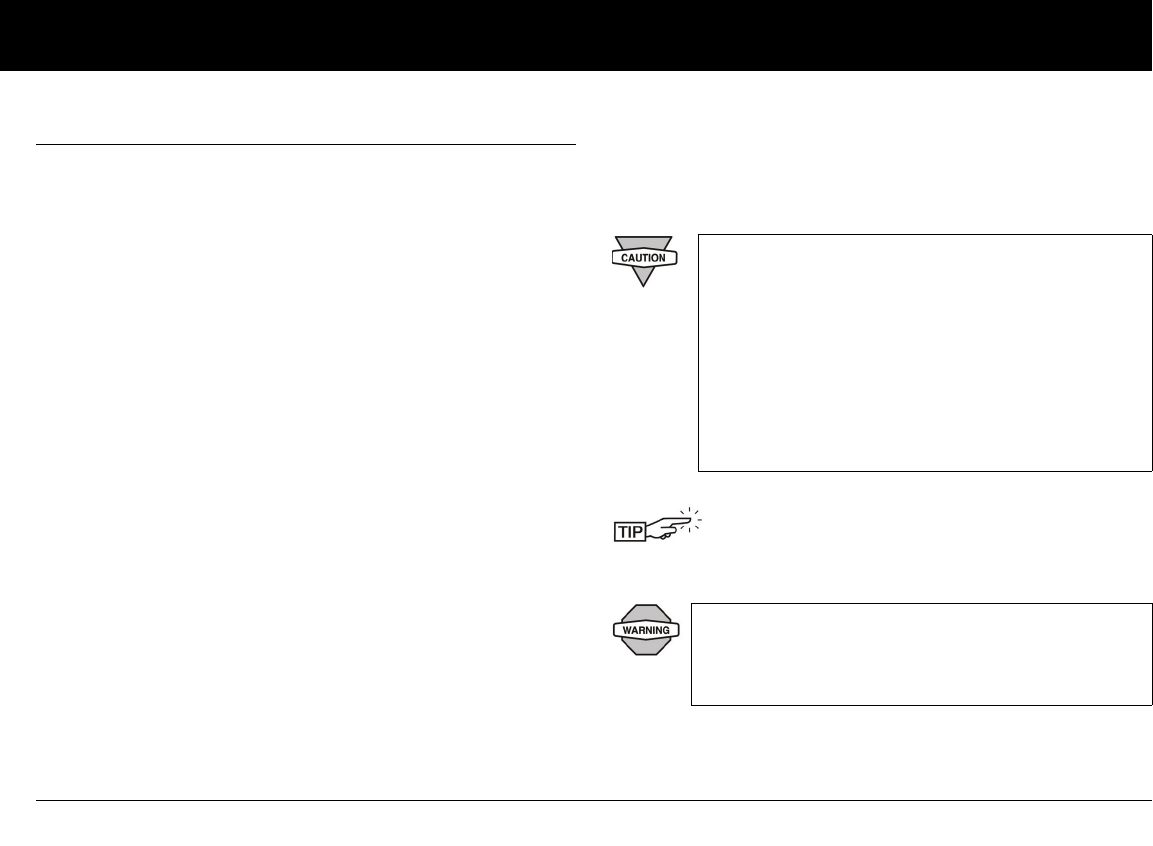
Living with Diabetes
108
9
■ Daily Diabetes Management Activities
To ensure proper OmniPod System operation and your contin-
ued good health:
• Check your blood glucose frequently
• Inspect the infusion site daily
Check your blood glucose frequently
When you routinely check your blood glucose level, you can iden-
tify and treat high or low blood glucose before it becomes a
problem (see “Avoid Lows, Highs, and DKA” later in this chapter).
Check your blood glucose (BG):
• At least 4 to 6 times a day: when you wake up, before every
meal, and before going to bed
• Whenever you feel nauseated or sick
• Before driving a car
• Whenever your blood glucose has been running unusually
high or low
• If you suspect that your blood glucose is high or low
• Before, during, and after exercise
• As directed by your healthcare provider
Inspect the infusion site daily
At least once a day, use the OmniPod viewing window to inspect
the infusion site. Check the site for signs of infection, such as pain,
swelling, redness, discharge, or heat.
If an infusion site shows signs of infection:
1. Immediately remove the Pod and apply a new
one at a different site (see Chapter 5, Using the
OmniPod).
2. Contact your healthcare provider.
3. Treat the infection according to instructions from
your healthcare provider. (Refer to Chapter 5, Using
the OmniPod, for how to prepare and care for a
site.)
Consider making infusion site checks a part of your
regular daily routine (like showering or brushing your
teeth). That way, it’s easy to remember.
If you observe blood in the cannula, check your blood
glucose more frequently to ensure insulin delivery
has not been affected. If you experience unexpected
elevated blood glucose levels, change your Pod.
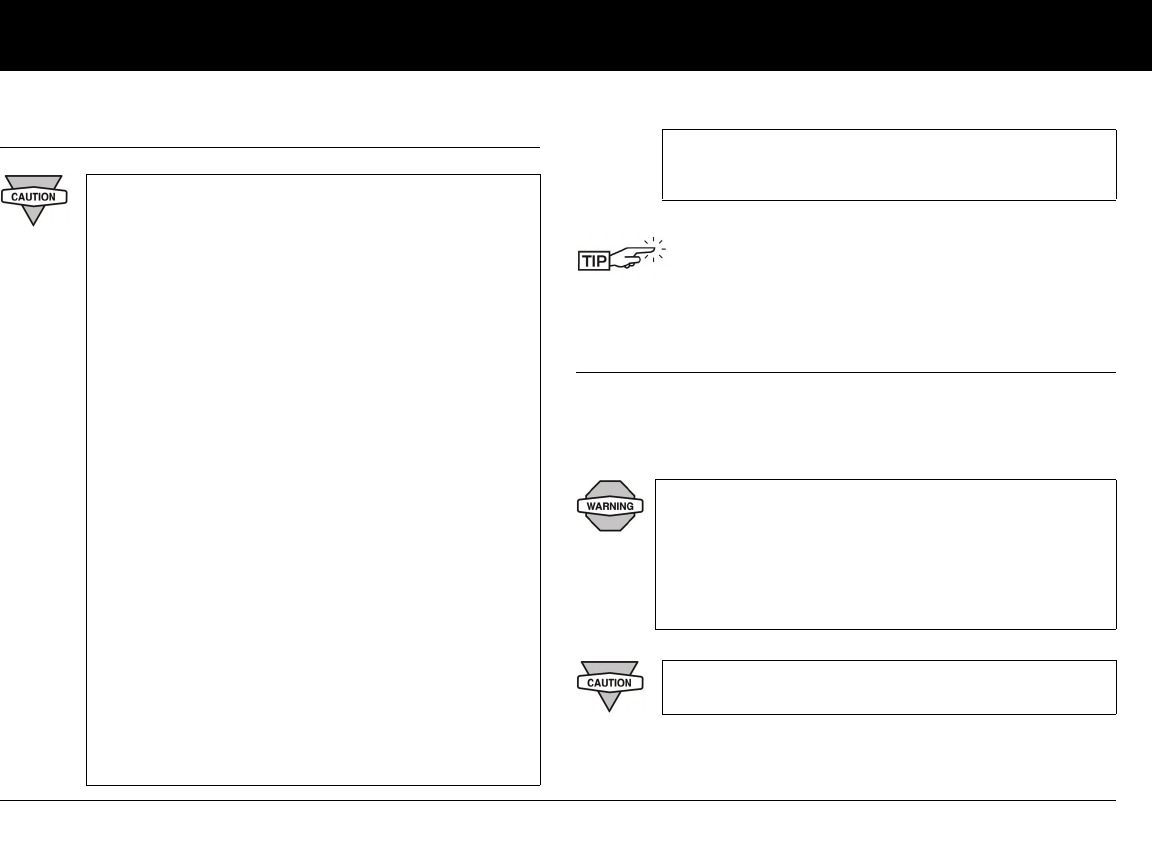
Living with Diabetes
109
9
■ Prepare for Emergencies
■ Water and Your OmniPod
The OmniPod is watertight to a depth of 8 feet for up to 30
minutes (IPX8). After the Pod gets wet, rinse it off with clean
water and dry it with a towel.
Keep an emergency kit with you at all times to
quickly respond to any diabetes emergency. The kit
should include:
• Several new, sealed OmniPods
• Extra new PDM batteries (at least two AAA alka-
line)
• A vial of rapid-acting U-100 insulin
• Syringes for injecting insulin
• Instructions from your healthcare provider about
how much insulin to inject if delivery from the
OmniPod is interrupted
• Blood glucose test strips
• Ketone test strips
• Lancing device and lancets
• Glucose tablets or another fast-acting source of
carbohydrate
• Alcohol prep swabs
• A copy of the letter from your healthcare pro-
vider for airline security (see “Minimize airport
security delays” later in this chapter)
• Phone numbers for your healthcare provider
and/or doctor in case of an emergency
• Glucagon kit and written instructions for giving
an injection if you are unconscious (see ”Avoid
Lows, Highs, and DKA” later in this chapter)
Ask your healthcare provider to help you develop
plans for handling emergency situations, including
what to do if you cannot reach your healthcare
provider.
Do NOT expose your OmniPod to water at depths
greater than 8 feet or for longer than 30 minutes.
Check the infusion site often to make sure the Pod
and soft cannula are securely applied and in place. If
the cannula is not properly inserted, hyperglycemia
may result.
The Personal Diabetes Manager (PDM) is not water-
proof. Do NOT place it in or near water.
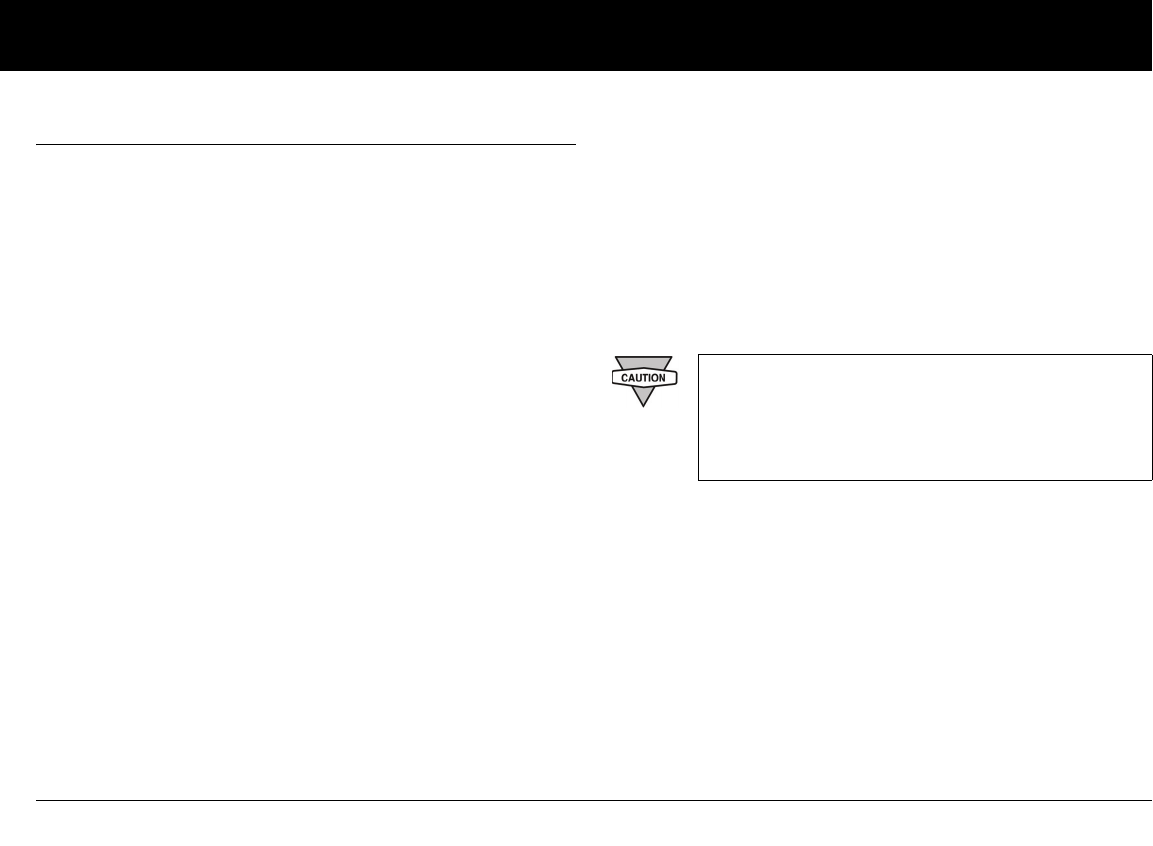
Living with Diabetes
110
9
■ Traveling and Vacationing
Plan for changing time zones
If you’re planning a vacation or business trip to a different time
zone, you may need to adjust your basal rate programs. For
changes of just a few hours, basal rate adjustments are minor
and easy to calculate. For long-distance travel, however, figuring
out the correct program can be more challenging. Your health-
care provider can help with these adjustments.
Take enough supplies
Keeping your emergency kit with you during trips or vacations
is especially important (see “Prepare for Emergencies” earlier in
this chapter). It may be difficult or impossible to get insulin or
supplies in an unfamiliar place. If traveling by air, be sure to pack
your supplies in your carry-on luggage. When packing for travel,
take more supplies than you think you’ll need. Be sure to include:
• Diabetes emergency kit packed in your carry-on luggage
• Enough OmniPods for your trip, plus a backup supply
• Extra new PDM batteries
• Additional blood glucose meter
• Insulin syringes or pens in case you need injections
• Several vials of insulin or insulin cartridges if you use a pen
• Glucagon kit (Make sure any person you are traveling with
knows how to give the injection.)
• Alcohol prep swabs
• Written prescriptions for all medications and supplies
(Generic medications may be easier to find than brand
names outside the US.)
When you travel outside the country or for long
periods of time, be sure to take extra OmniPod sup-
plies. Call 800-591-3455 (from outside the United
States: 781-457-5098) to order additional supplies
for your trip.

Living with Diabetes
111
9
Minimize airport security delays
Contact the airlines in advance for information on their current
security requirements. To make airport security checks go
smoothly, be sure you have the following easily accessible:
• A signed letter from your healthcare provider explaining that
you need to carry insulin supplies and OmniPod System
equipment
• An emergency kit (see “Prepare for Emergencies” earlier in
this chapter)
• A list of the supplies you must carry, including the contents of
your emergency kit
• Prescriptions for insulin and all supplies, clearly marked with
their original pharmacy labels
If the security detector goes off, tell the security screener that you
have diabetes and wear an insulin Pod (pump).
Keep supplies accessible
On airplanes and trains, keep these items with you, rather than
checking them:
• Personal Diabetes Manager (PDM)
• An emergency kit
• Vials of insulin (cargo area temperatures may affect insulin)
• A copy of your healthcare provider’s letter (see “Minimize air-
port security delays”)
• Prescriptions for insulin and supplies
• Snacks, in case food is not available
• Bottled water (especially on planes) to prevent dehydration
• The name and phone number of a physician at your final
destination, in case of emergency
OmniPods and PDMs can safely pass through airport
X-ray machines (see the FCC notice in the Appendices).
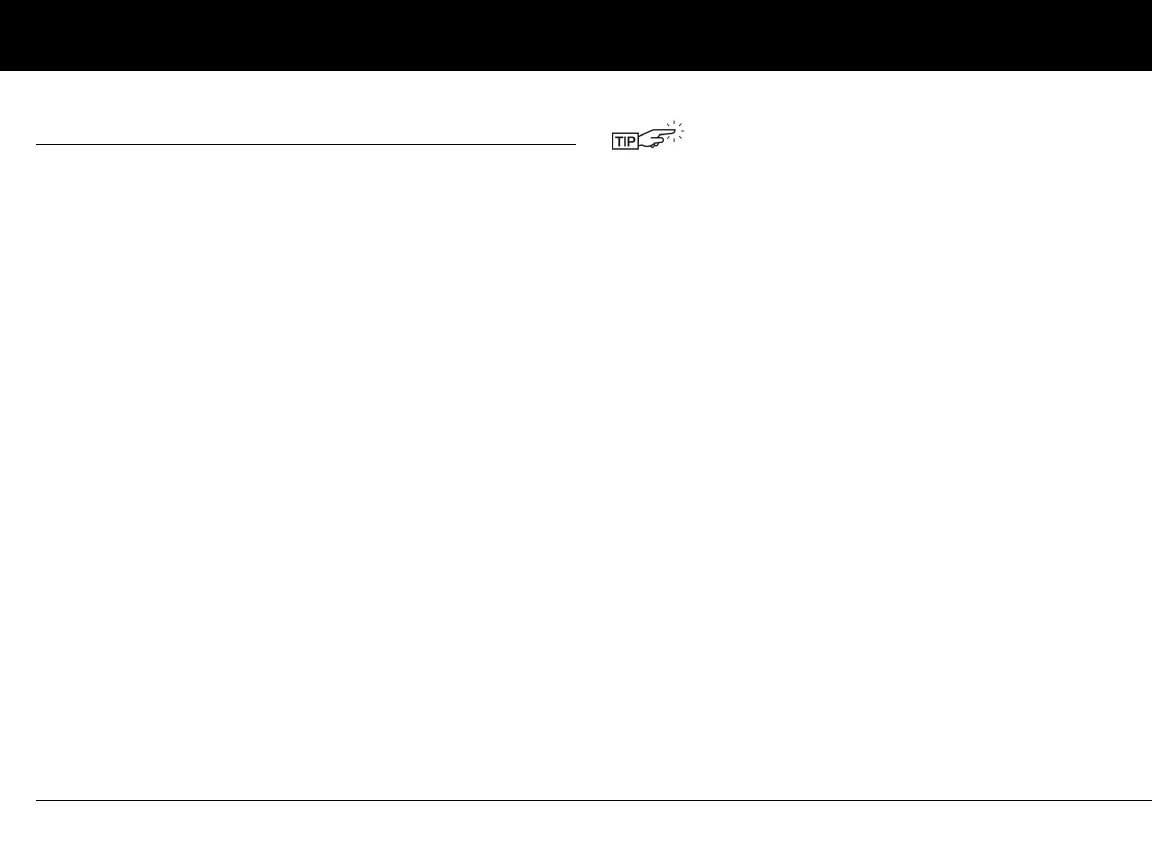
Living with Diabetes
112
9
■ Avoid Lows, Highs, and DKA
You can avoid most risks related to using the OmniPod System
by practicing proper techniques and by acting promptly at the
first sign of trouble. You can avoid potential problems by
knowing the signs of hypoglycemia (low blood glucose), hyperg-
lycemia (high blood glucose), and diabetic ketoacidosis (DKA).
The easiest and most reliable way to avoid these conditions is to
check your blood glucose often.
General precautions
• Keep careful records and discuss changes and adjustments
with your healthcare provider.
• Tell your healthcare provider if you have extreme highs or
lows, or if highs or lows are occurring more often than usual.
• If you have technical problems with your OmniPod System
and cannot resolve them, do not hesitate to call our 24-hour
Customer Support line at 800-591-3455 (from outside the
United States, 781-457-5098).
Hypoglycemia (low blood glucose)
Hypoglycemia can occur even when a Pod is working properly.
Never ignore the signs of low blood glucose (no matter how
mild). If left untreated, severe hypoglycemia can cause seizures
or lead to unconsciousness. If you suspect that your blood glu-
cose level is low, check your BG level to confirm.
Symptoms of hypoglycemia
Never ignore these symptoms:
• Shakiness
•Fatigue
• Unexplained sweating
• Cold, clammy skin
• Weakness
• Blurred vision or a headache
• Sudden hunger
• Rapid heart rate
• Confusion
• Tingling in the lips or tongue
•Anxiety
Hypoglycemia unawareness is a condition in which
you do not realize when your blood glucose level is
low. If you are prone to hypoglycemia unawareness,
you may want to use the OmniPod System’s blood
glucose reminder and check your blood glucose
more frequently. See “Alerts and reminders” in Chap-
ter 6, Using the Personal Diabetes Manager, for how
to set the reminder.
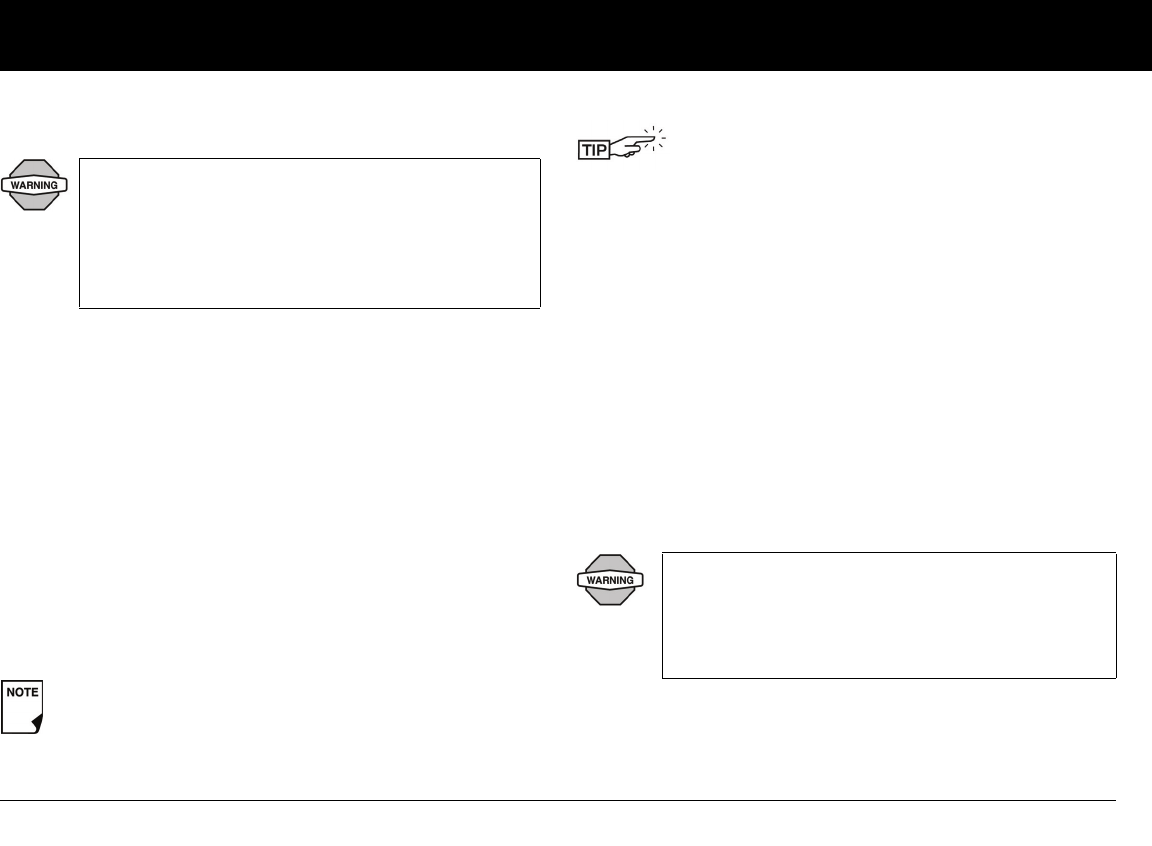
Living with Diabetes
113
9
To avoid hypoglycemia (low blood glucose)
• Work with your healthcare provider to establish individual-
ized blood glucose targets and guidelines.
• Keep a fast-acting carbohydrate with you at all times to
respond quickly to low blood glucose. Examples of fast-
acting carbs are glucose tablets, hard candies, or juice.
• Teach your friends, family members, and colleagues to
recognize the signs of hypoglycemia, so they can help if you
develop hypoglycemia unawareness or a severe adverse
reaction.
• Keep a glucagon injection kit with your emergency supplies.
Teach friends and family members how to give a glucagon
injection in case you have severe hypoglycemia and become
unconscious.
Again, frequent blood glucose checks are the key to avoiding
potential problems. Detecting low blood glucose early lets you
treat it before it becomes a problem.
Check with your healthcare provider for guidance in any and all
areas listed above.
To treat hypoglycemia (low blood glucose)
Any time your blood glucose is low, treat it immediately. Check it
every 15 minutes while you are treating, to make sure you don’t
overtreat the condition and cause blood glucose levels to rise
too high.
Make sure your blood glucose is at least 100 mg/dL
before driving or working with dangerous machinery
or equipment. Hypoglycemia may cause you to lose
control of a car or dangerous equipment. Also, when
you focus intently on a task, you may miss the symp-
toms of hypoglycemia.
Periodically check the expiration date of your glucagon
kit to make sure it has not expired.
Always carry medical identification (emergency
wallet card) and wear an emergency medical neck-
lace or bracelet such as the Medic Alert tag. (See the
end of the Appendices for address, telephone, and
web site information for obtaining these items.)
Even if you cannot check your blood glucose, do NOT
wait to treat symptoms of hypoglycemia, especially
if you are alone. Waiting to treat symptoms could
lead to severe hypoglycemia, which can quickly lead
to shock, coma, or death.
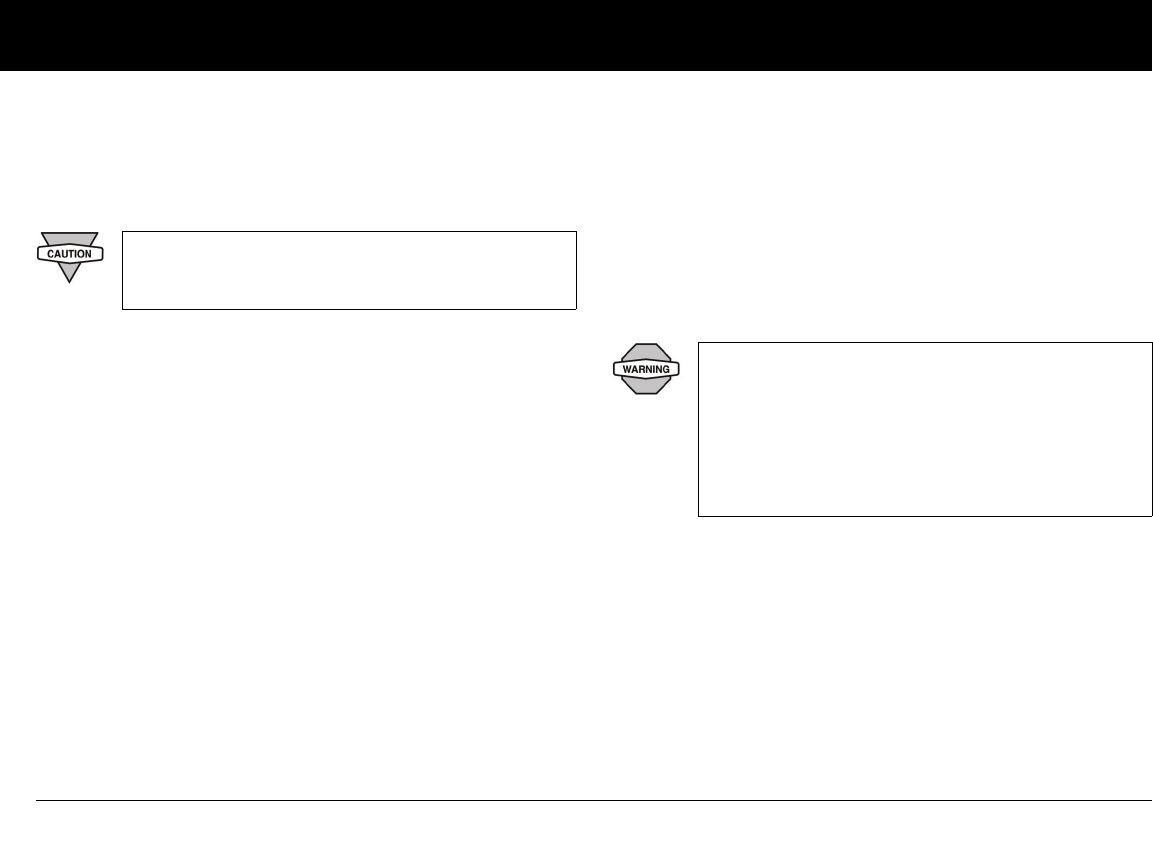
Living with Diabetes
114
9
1. If blood glucose is below 70 mg/dL, eat or drink 15 grams of
fast-acting carbohydrate, such as glucose tablets, juice, or
hard candy (see “How much is 15 grams of carbohydrate?”
below).
2. Check blood glucose again after 15 minutes.
3. If blood glucose remains low, take another 15 grams of
carbohydrate. Contact your healthcare provider as needed
for guidance.
4. Repeat steps 2 and 3 until blood glucose is within the BG goal.
5. Investigate possible cause for hypoglycemia to avoid similar
problems in the future (see “Possible causes of hypoglycemia
(low blood glucose)” on the next page).
How much is 15 grams of carbohydrate?
Examples of fast-acting foods:
Three 5-gram glucose tablets, or four 4-gram tablets
4 ounces of apple or orange juice
6 Lifesavers or similar hard candy
1/2 can of regular (non-diet) soda
2 tablespoons of table sugar, honey, or corn syrup
Do NOT use chocolate or candy bars to treat low
blood glucose. Their fat content slows down glucose
absorption.
Teach people you trust (like family members and
close friends) how to give a glucagon injection. You
will need to rely on them to give it to you if you have
severe hypoglycemia and become unconscious.
Include a copy of the glucagon instructions in your
emergency kit and periodically review the proce-
dure with family and friends.
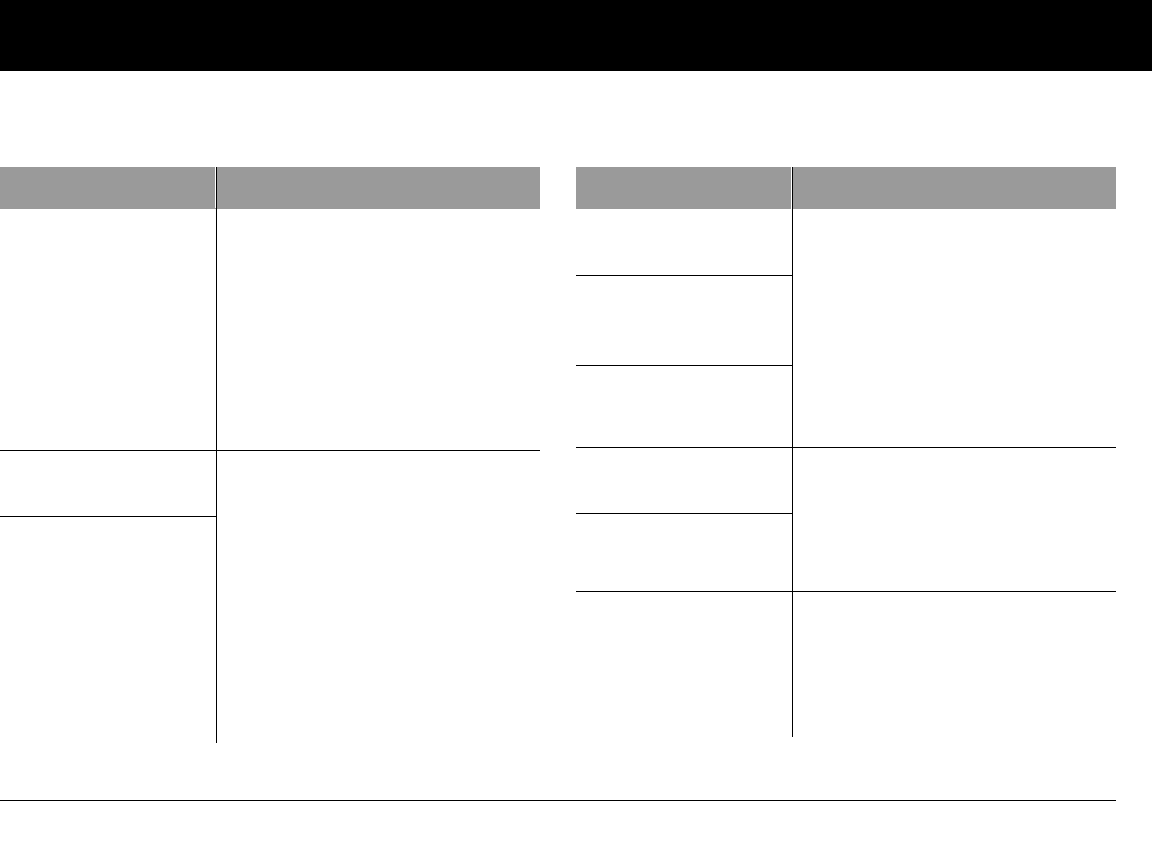
Living with Diabetes
115
9
Possible causes of hypoglycemia (low blood glucose)
Possible cause of low Suggested action
Incorrect basal
program
Confirm that correct basal program
is active.
Confirm that PDM time is set cor-
rectly.
Consult your healthcare provider
about adjusting your basal pro-
grams or using a temporary (temp)
basal rate.
Incorrect bolus
timing
Take bolus with food.
Check blood glucose before giving
meal bolus; if necessary, adjust
bolus.
Check bolus size and timing.
Do NOT overcorrect for post-meal
glucose levels.
Check carb intake.
Consult healthcare provider for
guidance.
Bolus too large
Possible cause of low Suggested action
Incorrect target
blood glucose levels
Consult healthcare provider about
refining these settings as needed.
Incorrect correction
factor (sensitivity
factor)
Incorrect insulin-to-
carb ratio
Prone to severe hypo-
glycemia
Consult healthcare provider about
hypoglycemia unawareness and
about raising target blood glucose
levels.
Hypoglycemia
unawareness
Unplanned physical
activity
If blood glucose is below 100 mg/dL,
eat a snack before activity.
Consult your healthcare provider
about using a temporary (temp)
basal rate.
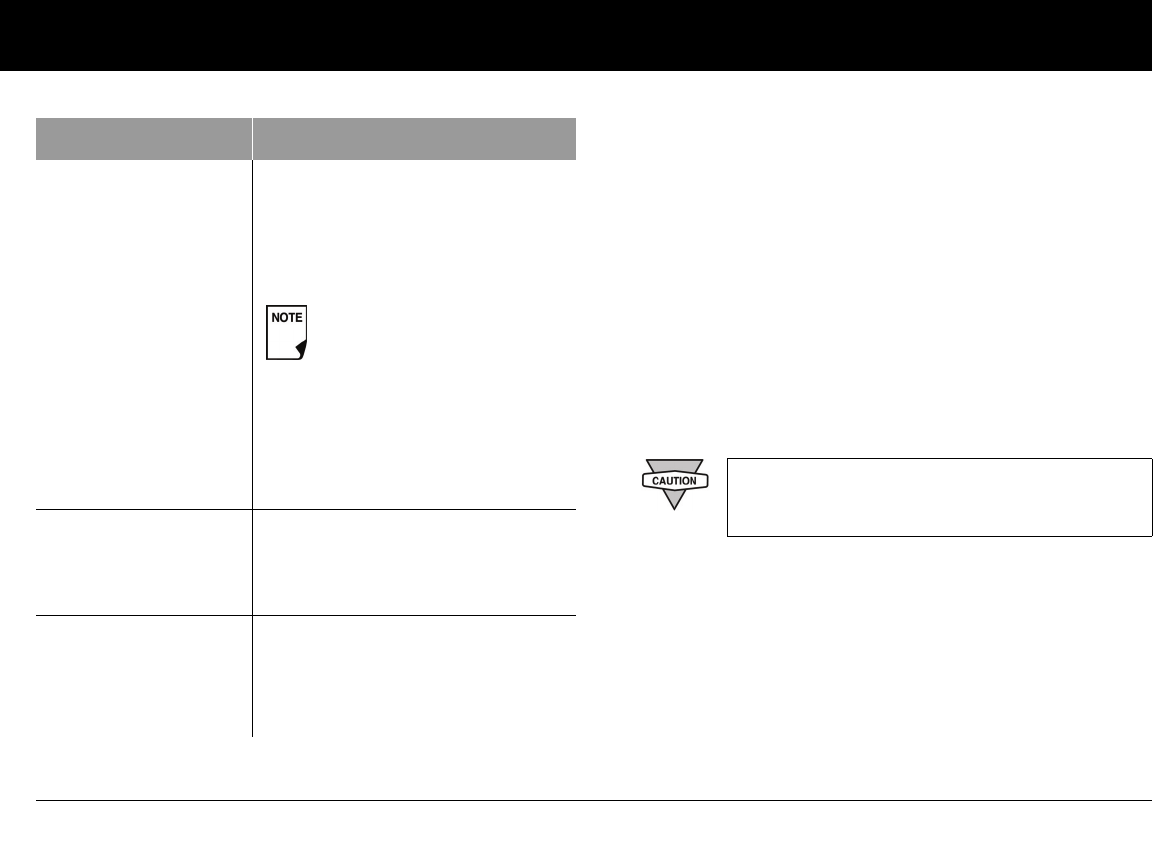
Living with Diabetes
116
9
Hyperglycemia (high blood glucose)
Insulin Pods use rapid-acting insulin, so you have no long-acting
insulin in your body. If an occlusion (interruption of insulin deliv-
ery from the Pod) occurs, your blood glucose can rise rapidly.
Symptoms of hyperglycemia (high blood glucose)
•Fatigue
• Frequent urination, especially during the night
• Unusual thirst or hunger
• Unexplained weight loss
• Blurred vision
• Slow healing of cuts or sores
Possible cause of low Suggested action
Prolonged or intense
exercise
Adjust insulin delivery as instructed
by your healthcare provider.
Check blood glucose before, dur-
ing, and after activity and treat as
necessary.
Consult your healthcare provider
about adjusting your basal pro-
grams or using a temporary (temp)
basal rate.
Low carbohydrate
intake prior to
activity
Consume carbohydrate before
activity, especially if you have not
decreased insulin beforehand.
Alcohol consumption Check blood glucose before going
to bed.
Consult healthcare provider for
guidance.
Effects of exercise can last
several hours—even a full
day—after activity ends.
Hyperglycemia symptoms can be confusing.
Always check your blood glucose before you
treat for hyperglycemia.
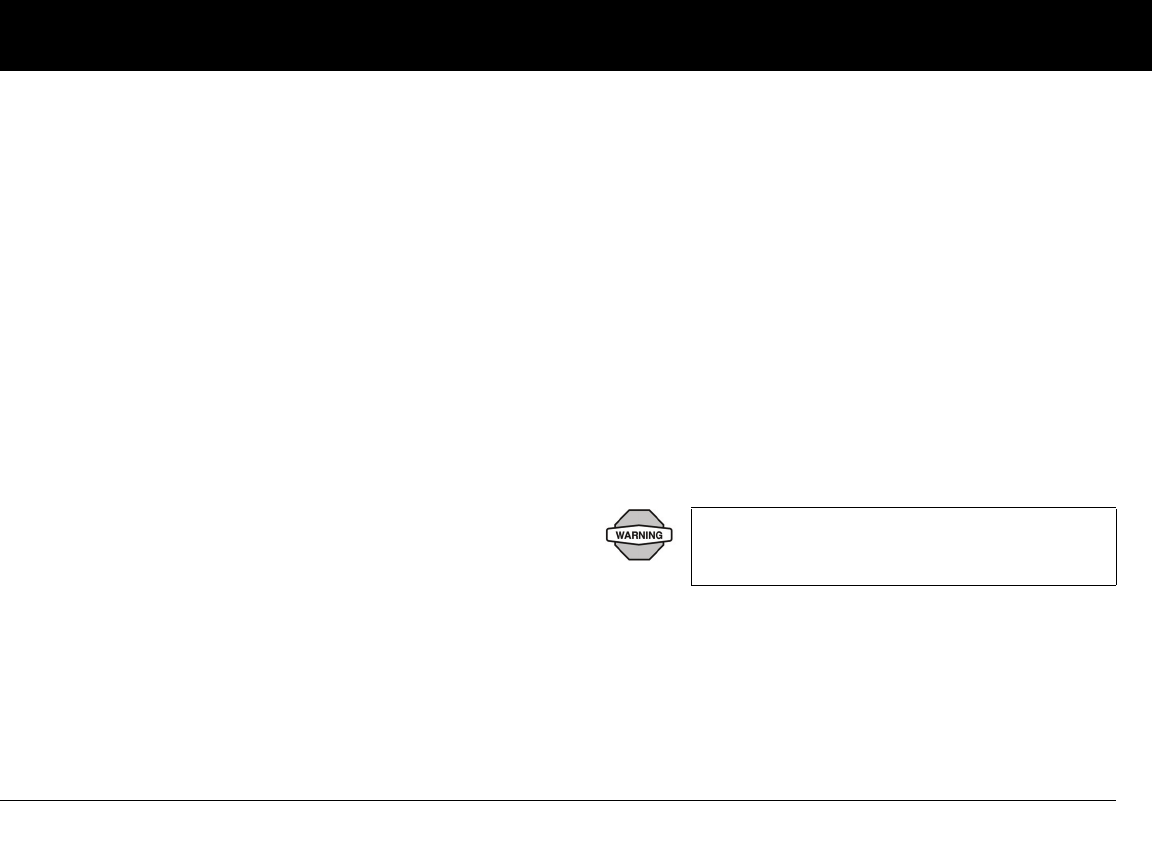
Living with Diabetes
117
9
To avoid hyperglycemia (high blood glucose)
Check your blood glucose at least 4–6 times a day (when you
wake up, before each meal, and before going to bed). In addi-
tion, always check it:
• If you feel nauseated or sick
• Before driving a car
• Whenever your blood glucose has been running unusually
high or low
• If you suspect that your blood glucose is high or low
• Before, during, and after exercise
• As directed by your healthcare provider
To treat hyperglycemia (high blood glucose)
Always check your blood glucose levels frequently while treating
hyperglycemia. You don’t want to over-treat the condition and
cause your BG level to drop too far.
1. Check your blood glucose level. The result will help you to
find out how much insulin is needed to return your blood
glucose to the BG goal.
2. If your blood glucose is 250 mg/dL or above, check for
ketones. If ketones are present, follow your healthcare
provider’s guidelines.
3. If ketones are not present, take a correction bolus as pre-
scribed by your healthcare provider.
4. Check blood glucose again after 2 hours.
5. If blood glucose levels have not decreased, take a second
bolus by injection, using a sterile syringe. Ask your healthcare
provider whether to inject the same amount of insulin as in
step 3.
6. If you feel nauseated at any point, check for ketones and call
your healthcare provider immediately (see “Diabetic ketoaci-
dosis (DKA)” later in this chapter).
7. If blood glucose remains high after another 2 hours (a total of
4 hours), replace the Pod. Use a new vial of insulin to fill the
new Pod. Then:
• Contact your healthcare provider for guidance.
• Drink eight ounces of water every 30 minutes until blood
glucose is within BG goal.
8. Investigate possible cause for hyperglycemia to avoid similar
problems in the future (see “Possible causes of hyperglyce-
mia (high blood glucose)” below).
If you need emergency attention, ask a friend or
family member to take you to the emergency
room or call an ambulance. Do NOT drive yourself.
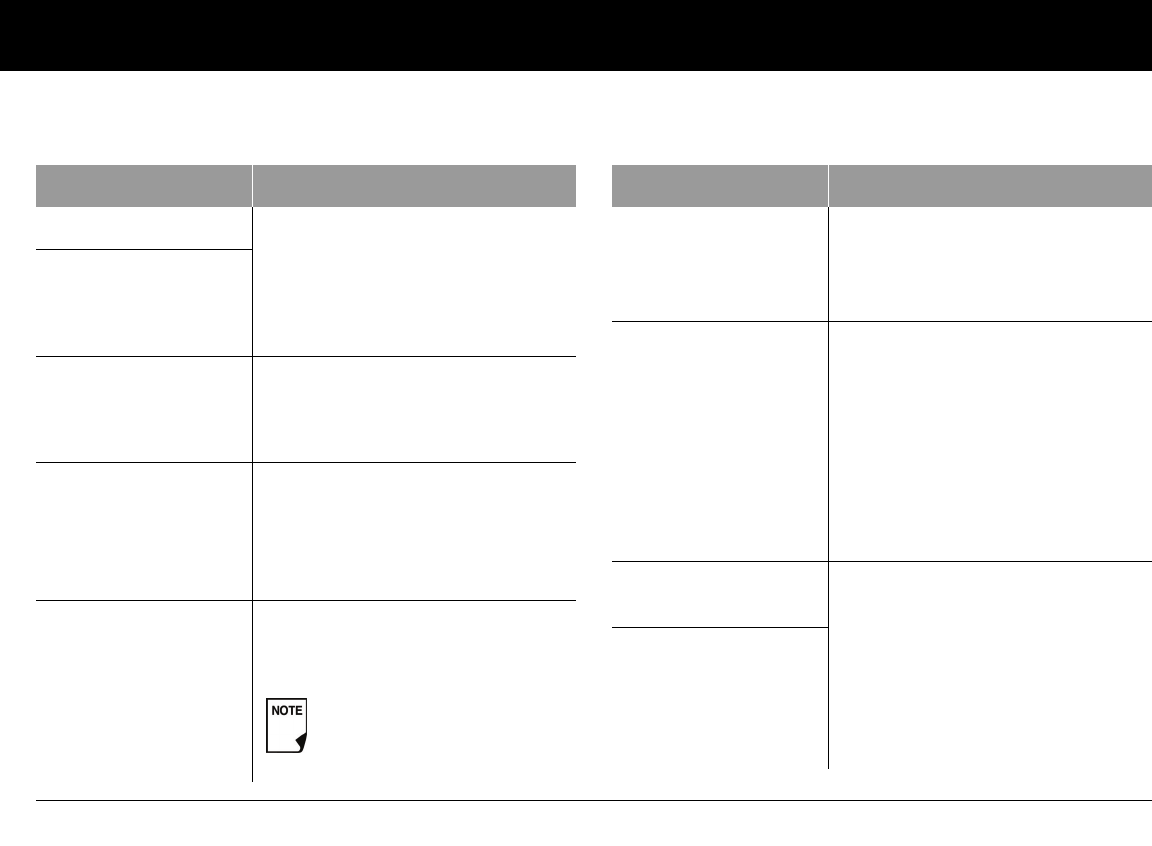
Living with Diabetes
118
9
Possible causes of hyperglycemia (high blood glucose)
Possible cause of high Suggested action
Expired insulin Deactivate and remove used Pod.
Apply new Pod filled with insulin
from a new vial.
Insulin exposed
to extreme
temperatures
Infusion site in or
near a scar or mole
Deactivate and remove used Pod.
Apply a new Pod in a different
location.
Infected infusion site Deactivate and remove used Pod.
Apply a new Pod in a different loca-
tion and consult your healthcare
provider.
Dislodged cannula Deactivate and remove used Pod.
Apply a new Pod in a different
location.
Avoid sites near a waistband,
belt, or other areas where fric-
tion may dislodge the cannula.
Possible cause of high Suggested action
Empty Pod Deactivate and remove used Pod.
Apply a new Pod in a different
location.
Incorrect basal
program
Confirm that correct basal program
is active.
Confirm that PDM time is set
correctly.
Consult your healthcare provider
about adjusting your basal pro-
grams or using a temporary (temp)
basal rate.
Incorrect bolus
timing
Check carb intake.
Take bolus with food.
Check blood glucose before giving
meal bolus; if necessary, adjust
bolus.
Consult healthcare provider for
guidance.
Bolus too small
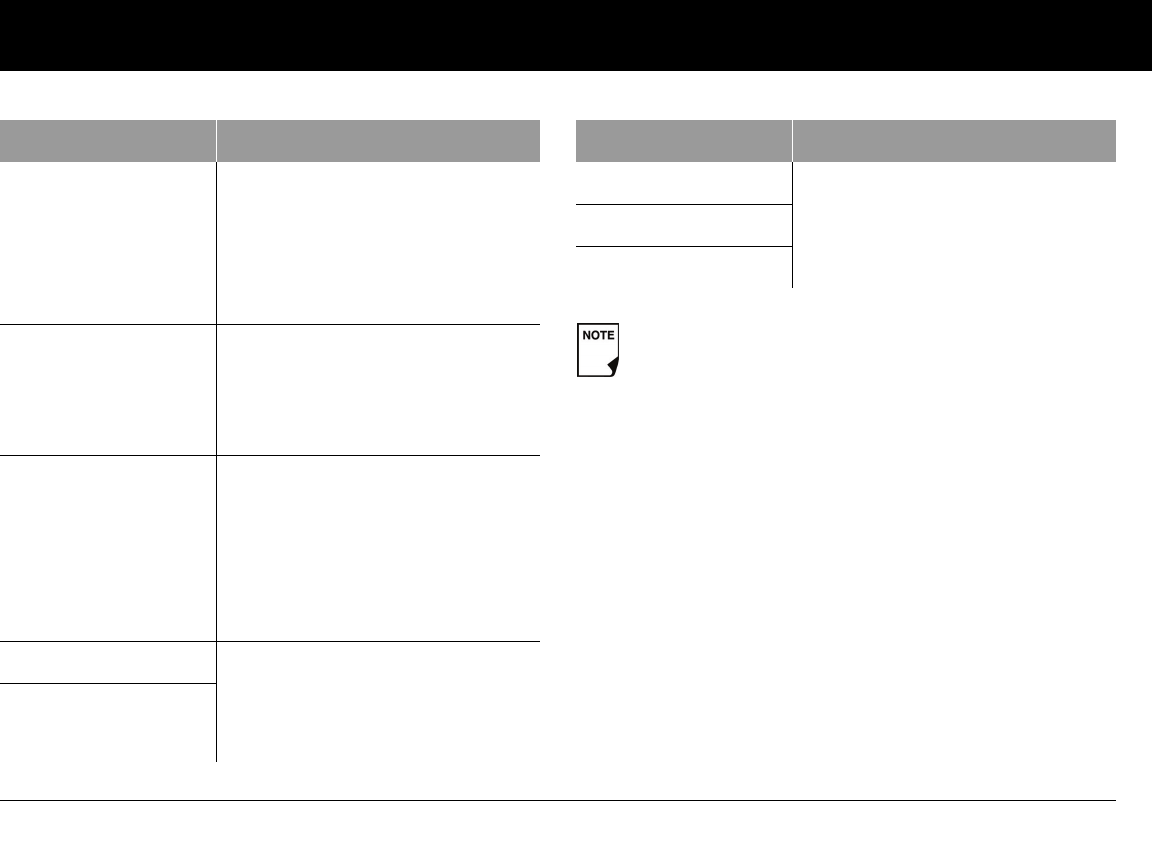
Living with Diabetes
119
9
High-protein or
high-fat meal
Calculate protein/fat intake and
account for it in your bolus timing
and bolus type.
Consult healthcare provider about
using the extended bolus option.
Less activity than
normal
Consult your healthcare provider
about adjusting your basal pro-
grams or using a temporary (temp)
basal rate.
Blood glucose value
greater than
250 mg/dL (with
ketones present)
before exercise
Do NOT exercise when ketones are
present. (Blood glucose increases
with exercise when ketones are
present.)
Consult healthcare provider for
guidance.
Infection or illness See “Sick days” later in this chapter.
Consult your healthcare provider
about sick-day guidelines and
about medication changes.
Medication change
Possible cause of high Suggested action
Weight loss or gain Consult your healthcare provider
for guidance.
Menstrual cycle
Pregnancy
Check with your healthcare provider for guidance on any
of the causes or suggested actions above.
Possible cause of high Suggested action
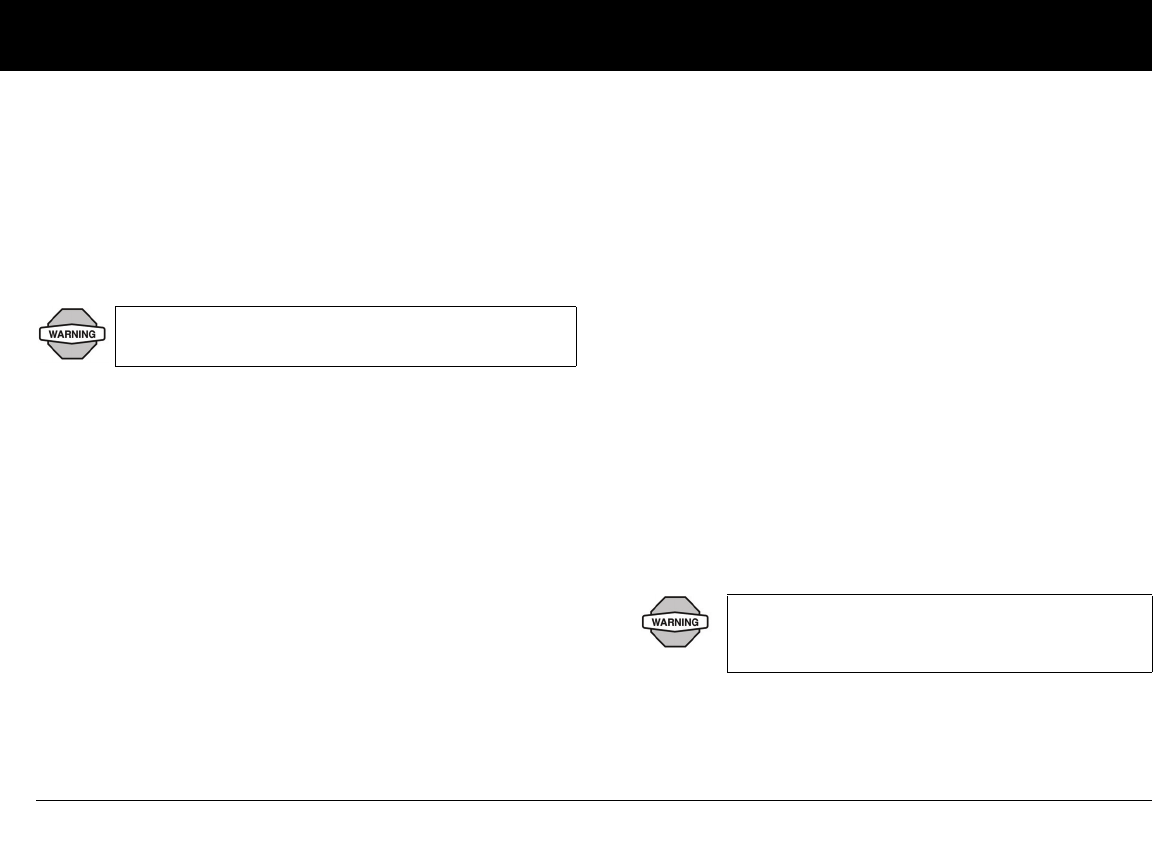
Living with Diabetes
120
9
Diabetic ketoacidosis (DKA)
Insulin Pods use rapid-acting insulin, so you have no long-acting
insulin in your body. If insulin delivery from the Pod is interrupted
(an occlusion), your blood glucose can rise rapidly and lead to
diabetic ketoacidosis (DKA). DKA is a serious—but totally pre-
ventable—emergency that can occur if you ignore high blood
glucose levels.
Symptoms of DKA
Nausea and vomiting
Abdominal pain
Dehydration
Fruity-smelling breath
Dry skin or tongue
Drowsiness
Rapid pulse
Labored breathing
The symptoms of DKA are much like those of the flu. Before
assuming you have the flu, check your blood glucose and check
for ketones to rule out DKA.
To avoid DKA
The easiest and most reliable way to avoid DKA is by checking
your blood glucose at least 4–6 times a day. Routine checks
allow you to identify and treat high blood glucose before DKA
develops.
To treat DKA
• Once you have begun treatment for high blood glucose,
check for ketones.
• If ketones are negative or trace, continue treating for high
blood glucose.
• If ketones are present, and you are feeling nauseated or ill,
immediately call your healthcare provider for guidance.
• If ketones are positive, but you are not feeling nauseated or ill,
replace the Pod, using a new vial of insulin.
• Check blood glucose again after 2 hours. If blood glucose
level has not declined, immediately call your healthcare
provider for guidance.
If left untreated, DKA can cause breathing difficulties,
shock, coma, and eventually death.
If you need emergency attention, ask a friend or
family member to take you to the emergency
room or call an ambulance. Do NOT drive yourself.
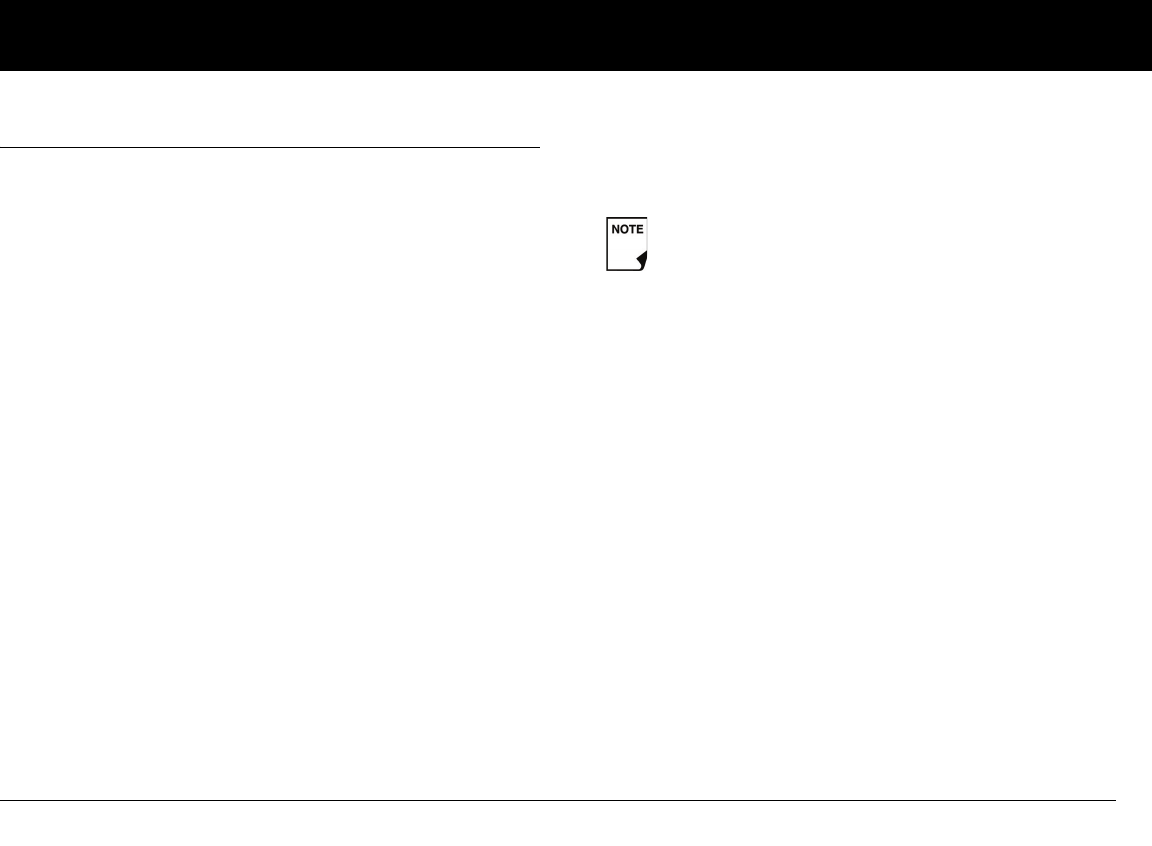
Living with Diabetes
121
9
■ Handling Special Situations
Sick days
Any physical stress can cause your blood glucose to rise, and ill-
ness is a physical stress. Your healthcare provider can help you
make a plan for sick days. The following are only general
guidelines.
When you are ill, check your blood glucose more often (at least
once every 2 hours) to avoid DKA. The symptoms of DKA are
much like those of the flu. Before assuming you have the flu,
check your blood glucose to rule out DKA (see ”Diabetic ketoaci-
dosis (DKA)” earlier in this chapter).
To handle sick days
• Treat the underlying illness to promote faster recovery.
• Eat as normally as you can.
• Adjust bolus doses, if necessary, to match changes in meals
and snacks.
• Always continue your basal insulin, even if you are unable to
eat. Contact your healthcare provider for suggested basal
rate adjustments during sick days.
• Check your blood glucose every 2 hours and keep careful
records of results.
• Check for ketones when blood glucose is 250 mg/dL or
higher.
• Follow your healthcare provider’s guidelines for taking addi-
tional insulin on sick days.
• Drink plenty of noncaffeinated fluids to prevent dehydration.
• Call your healthcare provider immediately if you have:
• Persistent nausea
• Vomiting for more than 2 hours
• High blood glucose or ketones that stay high even
though you take extra insulin
• Low blood glucose with nausea and vomiting
Exercising, playing sports, or working hard
Check your blood glucose levels before, during, and after exercis-
ing, playing sports, or doing unusually hard physical labor.
The OmniPod’s adhesive keeps it securely in place for up to 3
days. However, if necessary, several products are available to
enhance adhesion. Ask your healthcare provider about these
products.
Avoid getting body lotion, creams, or oils near the infusion site;
these products may loosen the adhesive.
If you are well enough to eat, drink sugar-free bever-
ages. However, if you are too sick to eat solid foods,
alternate between sugar-free beverages and those
containing sugar.
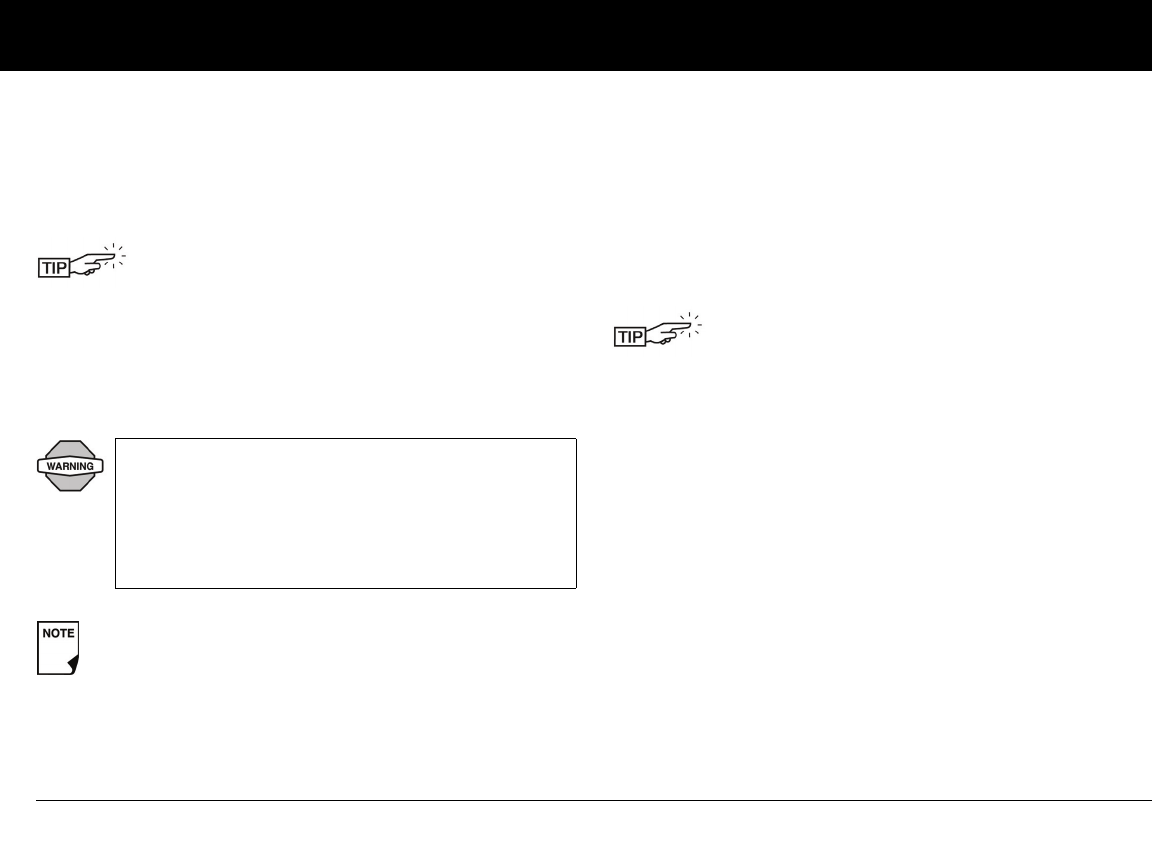
Living with Diabetes
122
9
For some contact sports, you may want to remove the OmniPod.
Be sure to check your blood glucose levels before removing the
Pod and after applying a new one. Pods are designed for one-
time use. Do not attempt to reapply a used Pod.
If you will need to remove the Pod for more than 1 hour, ask your
healthcare provider to recommend appropriate guidelines.
X-rays, MRIs, and CT scans
Surgery or hospitalization
For scheduled surgeries or hospitalization, you should tell the
doctor/surgeon or hospital staff about your insulin Pod. It may
be necessary to remove it for certain procedures or treatments.
Remember to replace the basal insulin that was missed while the
Pod was removed. Your healthcare provider can help you pre-
pare for these situations.
If possible, avoid wasting Pods by planning removal
times that coincide with a scheduled Pod replace-
ment.
The OmniPod and PDM may be affected by strong
radiation or magnetic fields. Before having an X-ray,
MRI, or CT scan (or any similar test or procedure),
remove your Pod and put it and the PDM outside the
treatment area. Check with your healthcare provider
on Pod removal guidelines.
The Pod and PDM can tolerate common electromag-
netic and electrostatic fields, including airport security
and cellular phones.
Always carry medical identification and wear an
emergency medical necklace or bracelet such as
the Medic Alert tag. (See the end of the Appendices
for address, telephone, and web site information.)
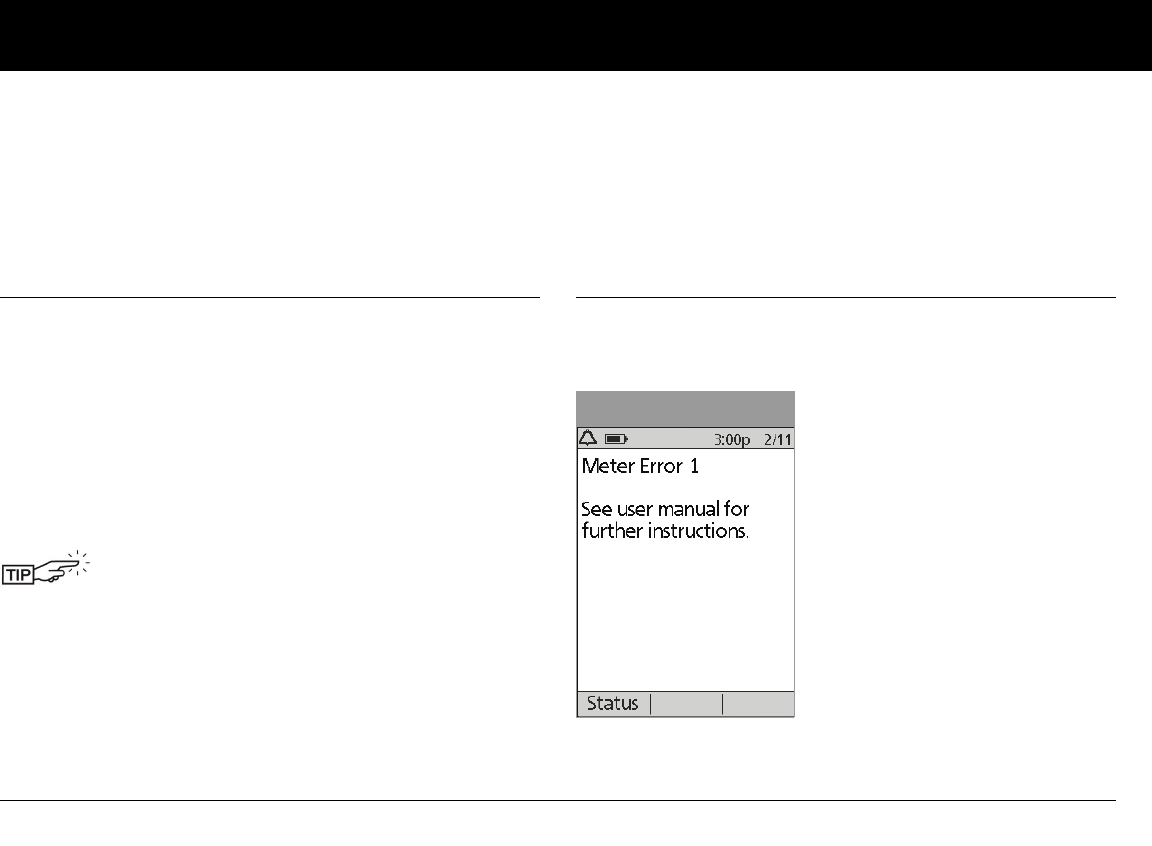
123
CHAPTER 10
Errors, Advisories, and Hazard Alarms
■ Safety Checks
The OmniPod System has a very important safety feature: It can
check its own functions and let you know when something
needs attention. When you turn on the Personal Diabetes Man-
ager (PDM), the System automatically performs a series of safety
checks. To make you aware of a serious or potentially serious
condition, the System sounds an alarm and displays an on-
screen message. The message has instructions for taking care of
the alarm condition. Alarm conditions are easy to handle. They
are not a problem if you attend to them promptly.
■ Blood Glucose Meter Error Messages
These messages let you know about an error in the blood glu-
cose meter, test strip, sample, or results. The PDM beeps and
displays aon error message number, as in Figure 10-1.
The following table explains what the message could mean and
what you should do.
Check your blood glucose level frequently.
Figure 10-1
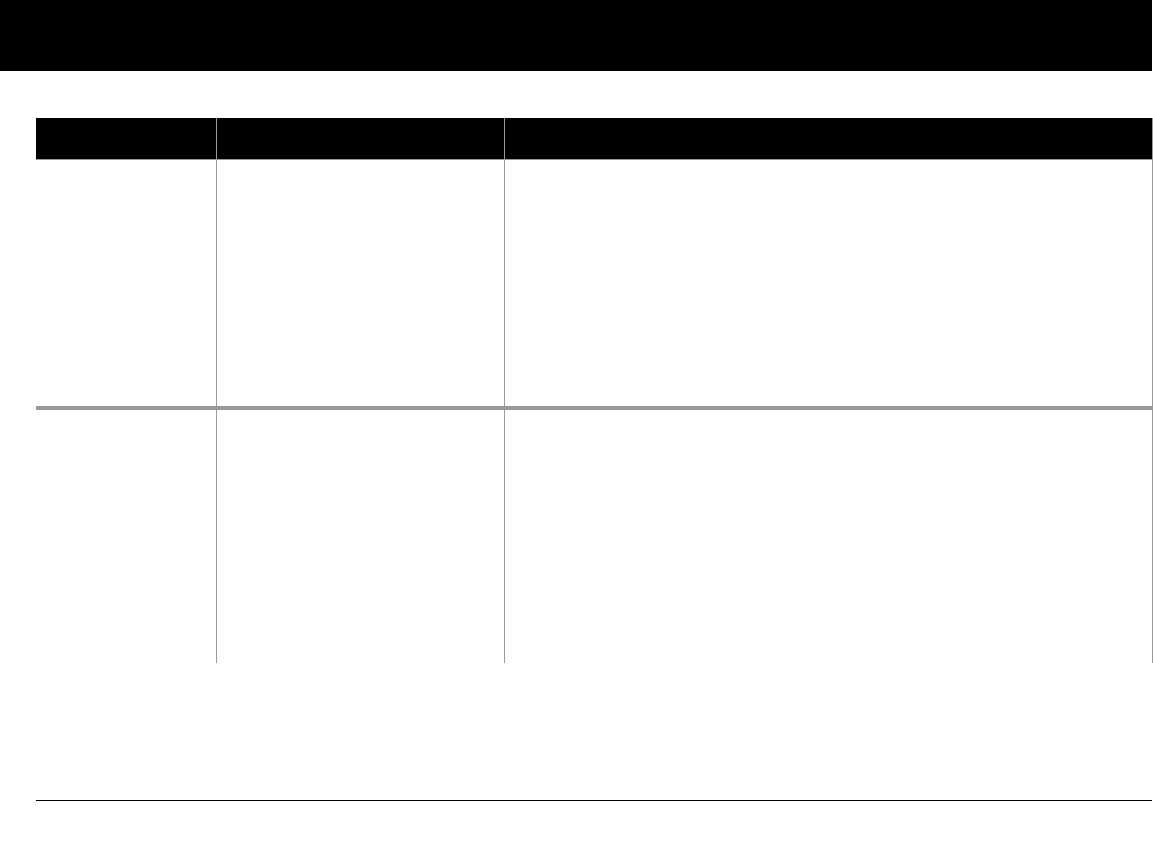
Errors, Advisories, and Hazard Alarms
124
10
Error message Possible causes Action
Meter Error 1
See user manual for
further instructions.
• Blood sample is too small.
• Problem with the test strip.
• Problem with the meter.
• Very low blood glucose: less
than 20 mg/dL.
1. If you have symptoms such as weakness, sweating, nervousness, head-
ache, or confusion, follow the recommendations of your healthcare
provider for treating hypoglycemia.
2. Conduct a control solution test using a new test strip. If the results of
the control solution test are within the range printed on the side of the
test strip vial, retest using blood and a new test strip.
3. If the control solution test does not work, or the error persists, call
Customer Support at 800-591-3455 (from outside the United States,
781-457-5098).
Meter Error 2
See user manual for
further instructions.
• Problem with the test strip.
• Problem with the meter.
• Very high blood glucose:
above 500 mg/dL.
• HIGH control solution
applied when temperature
is too cold. (This applies
only to control solution
labeled HIGH.)
1. If you have symptoms such as thirst, fatigue, excess urination, or blurry
vision, follow the recommendations of your healthcare provider for
treating hyperglycemia.
2. Conduct a control solution test using a new test strip. If the results of
the control solution test are within the range printed on the side of the
test strip vial, retest using blood and a new test strip.
3. If the control solution test does not work or the error persists, call
Customer Support at 800-591-3455 (from outside the United States,
781-457-5098).
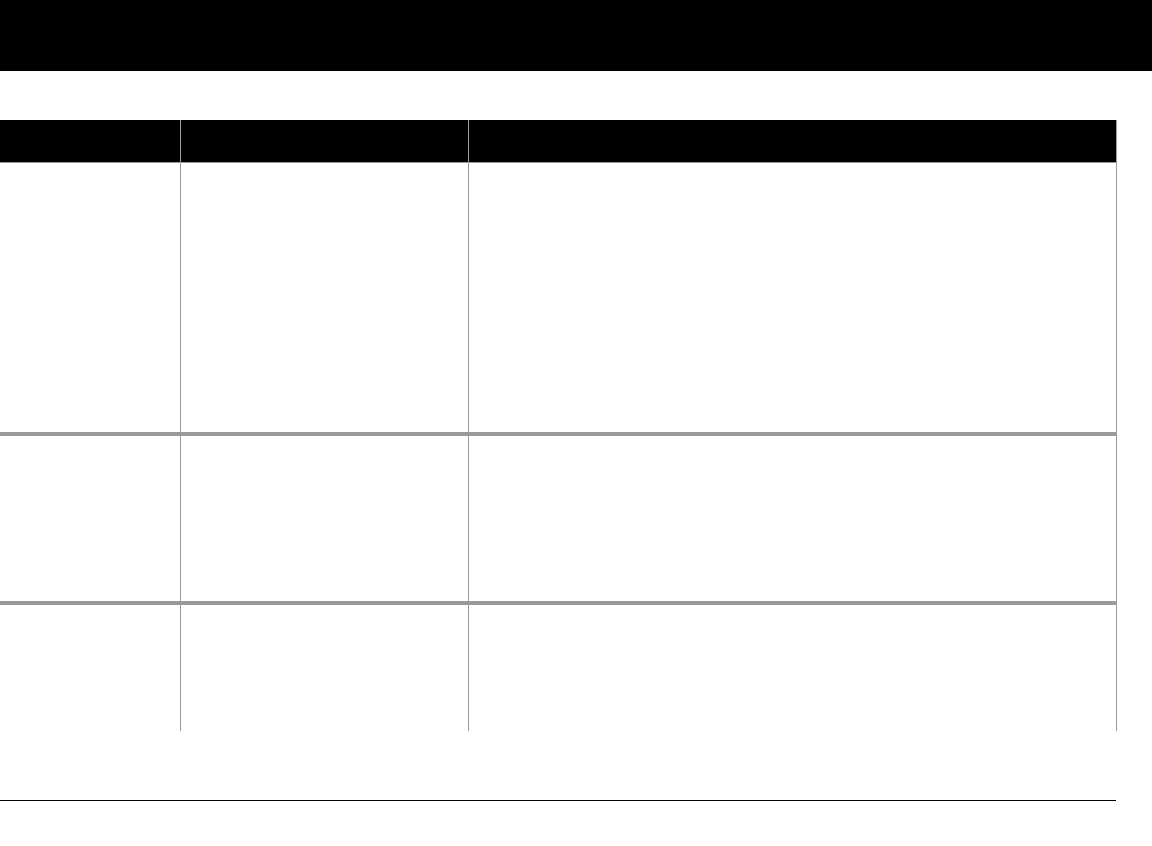
Errors, Advisories, and Hazard Alarms
125
10
Meter Error 3
See user manual for
further instructions.
• Incorrect test procedure.
For example, putting blood
on the test strip before
inserting the test strip into
the meter, or applying
blood before the Blood
Drop and Test Strip symbols
display.
• Problem with the test strip.
• Problem with the meter.
1. Be sure you see the Blood Drop and Test Strip symbols on the display
screen before you apply blood or control solution.
2. Conduct a control solution test using a new test strip. If the results of
the control solution test are within the range printed on the side of the
test strip vial, retest using blood and a new test strip.
3. If the control solution test does not work or the error persists, call
Customer Support at 800-591-3455 (from outside the United States,
781-457-5098).
Meter Error 4
See user manual for
further instructions.
• Problem with the test strip.
• Problem with the meter.
1. Conduct a control solution test using a new test strip. If the results of
the control solution test are within the range printed on the side of the
test strip vial, retest using blood and a new test strip.
2. If the control solution test does not work or the error persists, call
Customer Support at 800-591-3455 (from outside the United States,
781-457-5098).
Meter Error 6
See user manual for
further instructions.
• Blood sample was applied
while the code number was
being changed.
1. Retest using a new test strip. Do not press any buttons or soft keys while
applying blood or control solution to the test strip.
2. If the error persists, call Customer Support at 800-591-3455 (from out-
side the United States, 781-457-5098).
Error message Possible causes Action
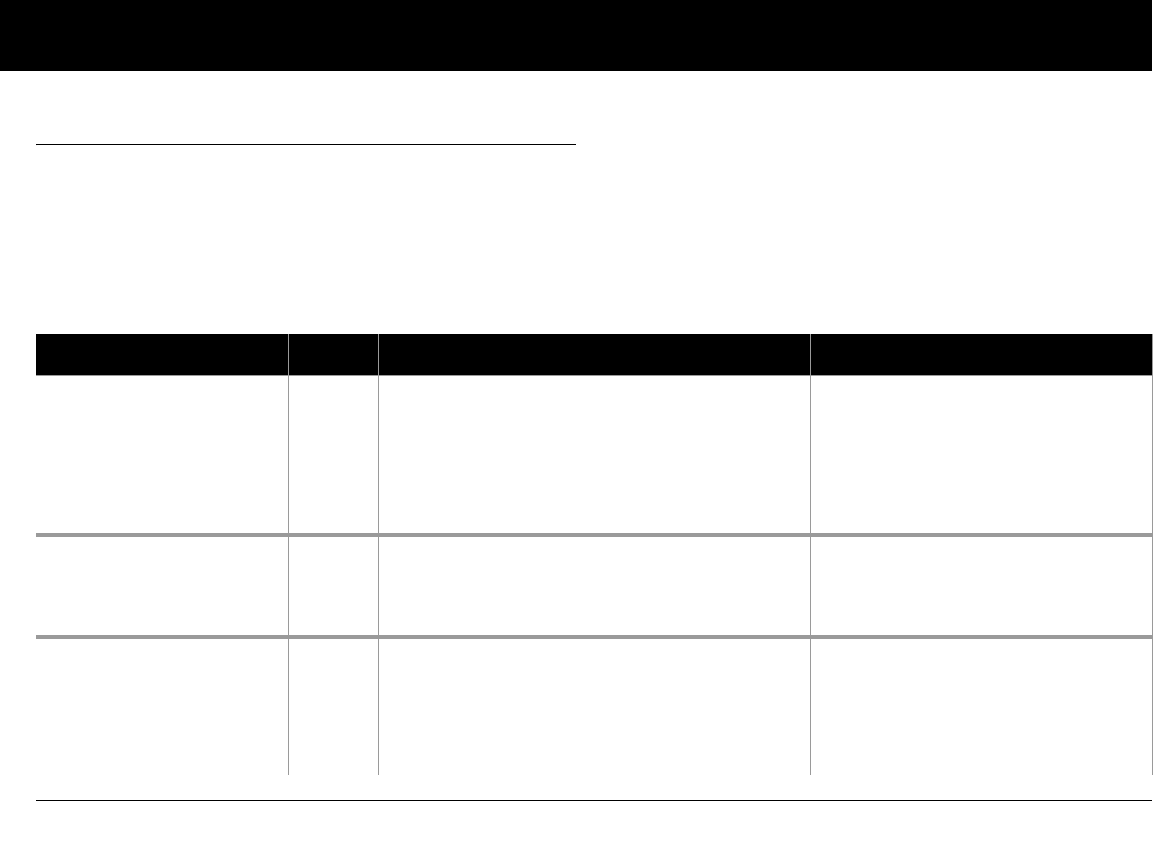
Errors, Advisories, and Hazard Alarms
126
10
■ Advisory Alarms
Advisory alarms tell you about a condition that requires your
attention. Each advisory alarm beeps intermittently. When you
hear an advisory alarm, first turn on the PDM to display the Sta-
tus screen. The PDM communicates with the Pod, if necessary,
and the screen displays a message describing the alarm and how
to resolve it.
Some advisory alarms are controlled by levels you set in the Set-
tings screen. One example is the level at which the Low
reservoir volume alarm sounds.
All advisory alarms are time-sensitive and require a response.
Some advisory alarms escalate to hazard alarms if you do not
respond within a certain time period (as noted in the table
below).
Alarm Source Beep Pattern Action
Low reservoir.
Replace pod soon.
(This is based on the volume
level you selected.)
Pod
and
PDM
2 sets of beeps every minute for 3 minutes.
Repeats every 60 minutes until acknowledged.
Escalates to hazard alarm when empty. See
“Hazard Alarms” later in this chapter.
Press OK to acknowledge.
Expiration alert.
Pod expires at 5:00p. 2/11
Pod
and
PDM
2 sets of beeps every minute for 3 minutes.
Repeats every 15 minutes until acknowledged.
Press OK to acknowledge.
Change Pod (see Chapter 5, Using the
OmniPod).
Pod expiration advisory.
Change pod now.
Pod 2 sets of beeps that repeat periodically.
Repeats every 15 minutes during the last hour of
the Pod’s life.
Escalates to Pod expired hazard alarm.
Press OK to acknowledge.
Change Pod (see Chapter 5, Using the
OmniPod).
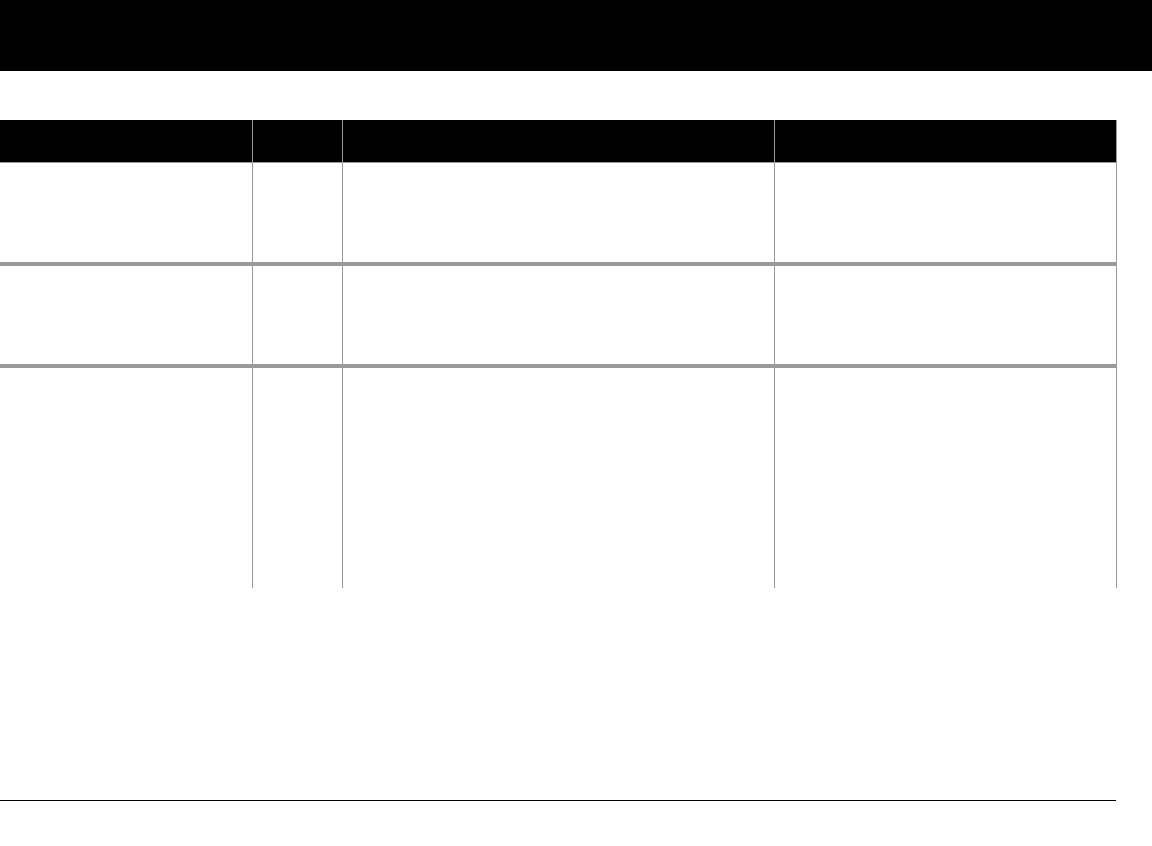
Errors, Advisories, and Hazard Alarms
127
10
End of insulin suspend.
Press “Ok” to resume basal
rate delivery.
Pod 2 sets of beeps every minute for 3 minutes.
Repeats every 15 minutes until insulin delivery is
resumed.
Press OK to resume insulin delivery at
programmed basal rate.
Auto-off advisory Pod
and
PDM
2 sets of beeps every minute for 15 minutes.
Escalates to Auto-off hazard alarm if not
acknowledged within 15 minutes.
Press OK to acknowledge.
Reset clock.
Stuck key detected.
Check Home button to
resolve.
For technical support, call
800.591.3455.
PDM 2 sets of beeps every 5 minutes. Check the key described on the
screen. (In this example, the stuck key
is the Home button.) Press the key to
unstick it.
If this does not work, call Customer
Support at 800-591-3455 for assis-
tance (from outside the United States,
781-457-5098).
Alarm Source Beep Pattern Action
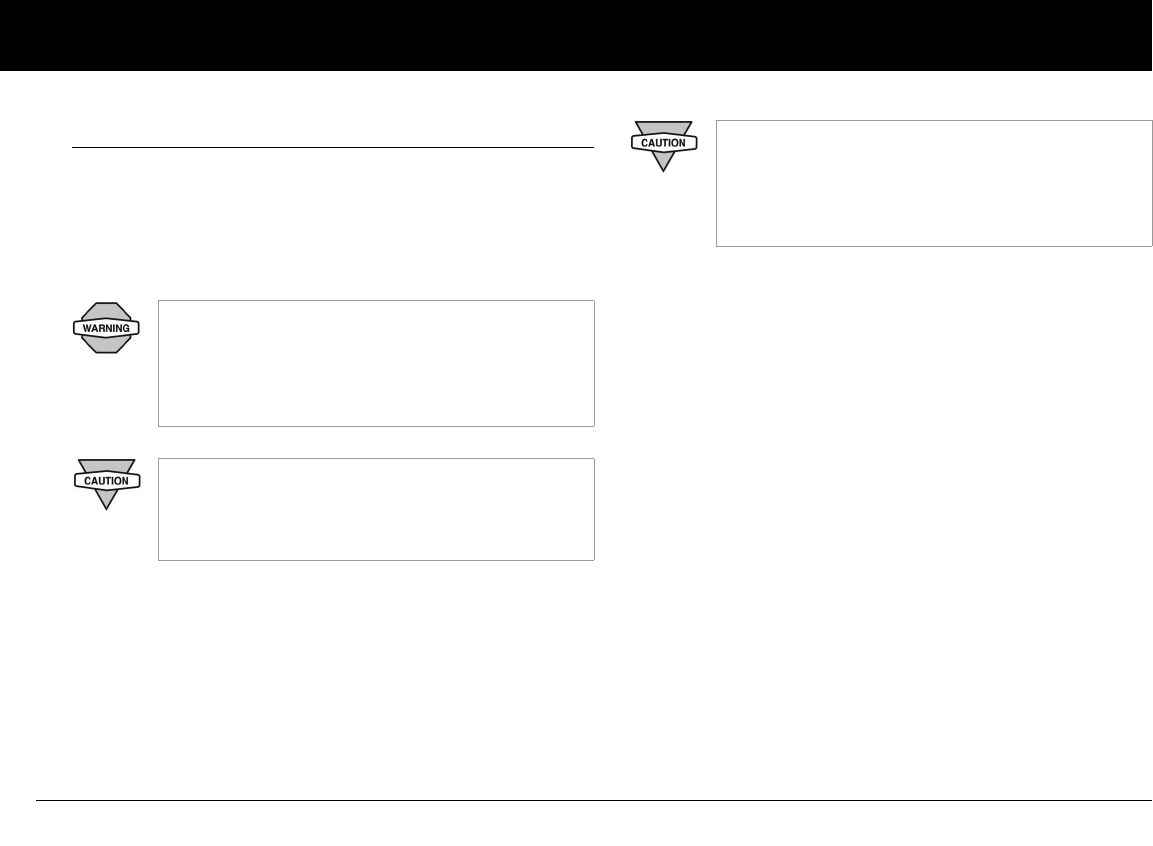
Errors, Advisories, and Hazard Alarms
128
10
■ Hazard Alarms
Hazard alarms occur either when the Pod is in a very serious
condition or something is wrong with the PDM. Hazard alarms
are continuous tones and each has an on-screen message. Fol-
low the instructions in the message to fix the alarm situation.
For details, see the table below. If the PDM cannot communicate with the Pod to accept or
shut off a hazard alarm, you can shut it off manually.
1. Remove the Pod from your body if you have not already
done so.
2. Press the end of a paper clip or similar item into the manual
alarm shut-off port on the top side of the Pod. (See Chapter
11, Communication Failures, Figure 11-17.)
When a hazard alarm occurs in the Pod, all insulin
delivery stops. Failing to address the situation
could result in hyperglycemia. If you had a temp
basal or extended bolus running when the hazard
occurred, the PDM will remind you of this.
Many hazard alarms (such as Auto-off ) will cause
alert escalation and deactivation of the active Pod
if ignored. Be sure to respond to all alerts and
alarms when they occur.
For a hazard alarm caused by a PDM error or
System error that displays “Call customer sup-
port,” remove the Pod and call 800-591-3455
immediately for Customer Support (from outside
the United States, 781-457-5098).
Hazard Alarms
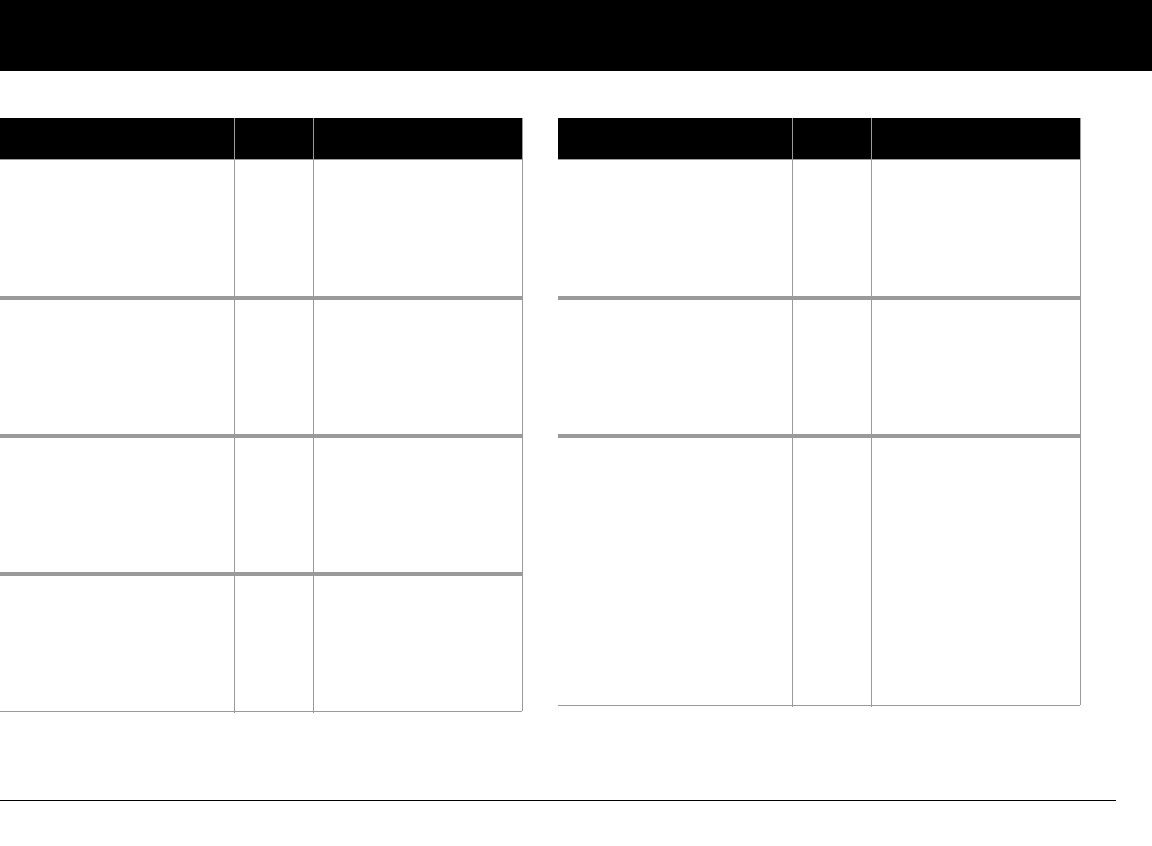
Errors, Advisories, and Hazard Alarms
129
10
Alarm Source Action
Empty reservoir.
Insulin delivery stopped.
Change pod now.
Pod Press OK to acknow-
ledge.
Change Pod.
Check blood glucose.
Occlusion detected.
Insulin delivery stopped.
Change pod now.
Pod Press OK to acknow-
ledge.
Change Pod.
Check blood glucose.
Pod expired.
Insulin delivery stopped.
Change pod now.
Pod Press OK to acknow-
ledge.
Change Pod.
Check blood glucose.
Auto-off.
Remove pod now.
Pod
and
PDM
Press OK to acknow-
ledge.
Change Pod.
Check blood glucose.
Pod deactivation required.
Press “Ok” to deactivate.
PDM Press OK to acknow-
ledge.
Change Pod.
Check blood glucose.
Pod Error.
Insulin delivery stopped.
Change pod now.
Pod
or
PDM
Press OK to acknow-
ledge.
Change Pod.
Check blood glucose.
PDM Error.
Remove pod now.
Call customer support:
800.591.3455
Ref: 05-100-0618-00000
PDM Press OK to acknow-
ledge.
Remove Pod.
Call Customer Sup-
port at 800-591-3455
(from outside the
United States,
781-457-5098).
Check blood glucose.
Alarm Source Action
Hazard Alarms
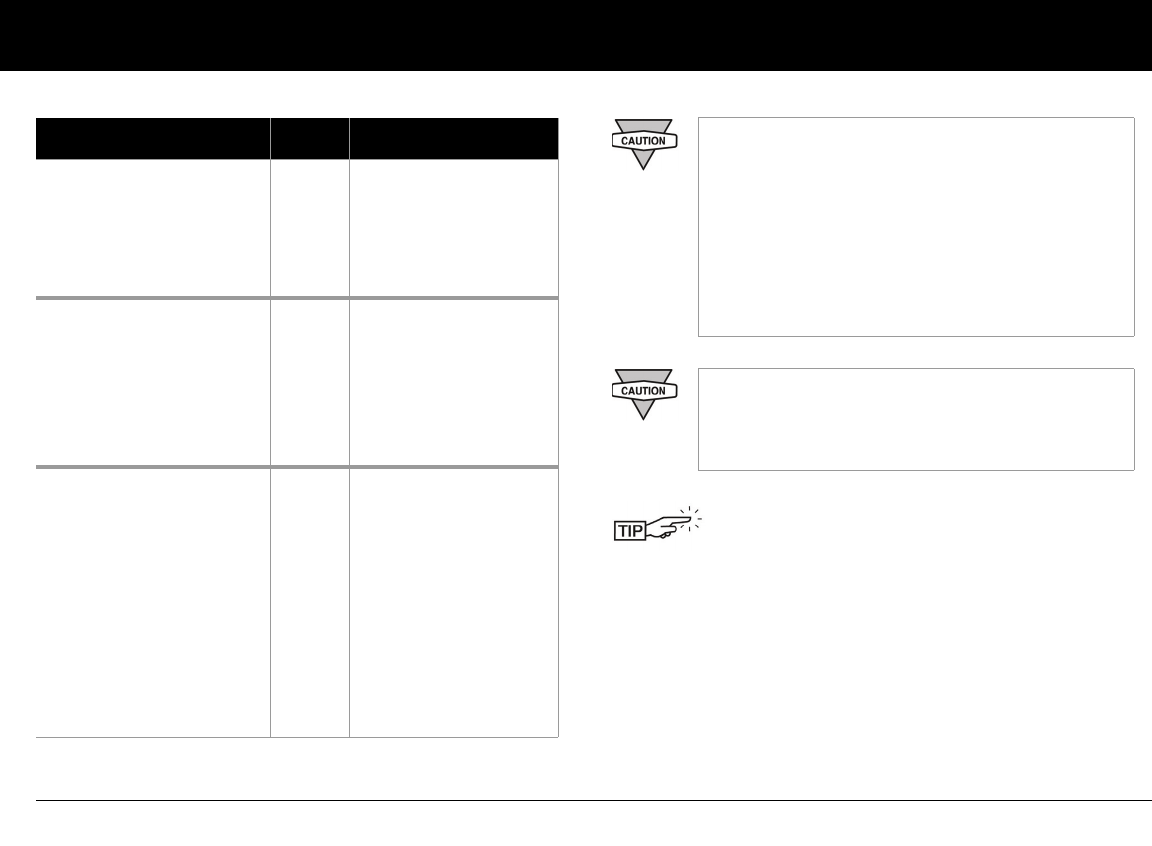
Errors, Advisories, and Hazard Alarms
130
10
PDM Error.
Press “Ok” to reset clock.
PDM Press OK to acknow-
ledge.
Reset clock.
Check blood glucose.
PDM Error.
Memory corruption.
Press “Ok” to reset PDM
and delete all user set-
tings. History records will
not be deleted.
PDM Press OK to acknow-
ledge.
Change Pod.
Check blood glucose.
System Error.
Remove pod now.
Call customer support:
800.591.3455
Ref: 05-100-0618-00000
PDM
or
Pod
Press OK to acknow-
ledge.
Remove Pod.
Call Customer Sup-
port at 800-591-3455
(from outside the
United States,
781-457-5098).
Check blood glucose.
Alarm Source Action Due to the serious nature of hazard alarms, you
must act promptly to resolve them.
1. Acknowledge the alarm condition by pressing
OK, which silences the alarm.
2. Deactivate and remove the active Pod (see
Chapter 5, Using the OmniPod).
3. Activate and apply a new Pod (see Chapter 5,
Using the OmniPod).
If you ever need to return the PDM for repair or
replacement, contact your healthcare provider
for instructions on going back to treatment by
injections.
Use the form at the end of this User Guide to write
down all your settings from the Setup Wizard. You
can also attach a copy of the CSII orders that you
used during your training session. If you ever
need to reset your PDM, having these settings
handy will make setup very easy.

Errors, Advisories, and Hazard Alarms
131
10
Resources for OmniPod users are available from the
Customer Support tab on our Web site:
MyOmniPod.com/support/resources
Among these resources are an online copy of this
User Guide and the My OmniPod System Information
form, which you will also find at the end of this
guide.

132
CHAPTER 11
Communication Failures
■ The Communication Process
When you turn on or use the Personal Diabetes Manager (PDM),
it establishes communication with the active OmniPod. Usually,
communication occurs quickly. Occasionally, communication
takes longer, and the PDM displays the communication icon dur-
ing that time, in the upper left hand corner of the current screen.
However, if communication does not work, the PDM will walk
you through the necessary steps to re-establish communication.
Communication can fail if the PDM is:
• Too far from the Pod—It must be within 24" (61 cm) when
you are entering or changing settings.
• Interrupted by outside interference—See the “OmniPod
System Federal Communications Commission (FCC) Notice
Concerning Interference” in the Appendices.
■ Failure During Pod Activation or Operation
When you send an instruction from the PDM—such as Start to
begin bolus delivery, or Enable to begin using a different basal
program—the Pod usually responds quickly. However, if the
PDM cannot send your instruction within a few seconds, it dis-
plays the “Communication error” screen (Figure 11-1 on the next
page).
1. Move the PDM closer to the Pod. The PDM will try to commu-
nicate with the Pod again. If communication still fails, you will
see the message in Figure 11-2 on the next page.
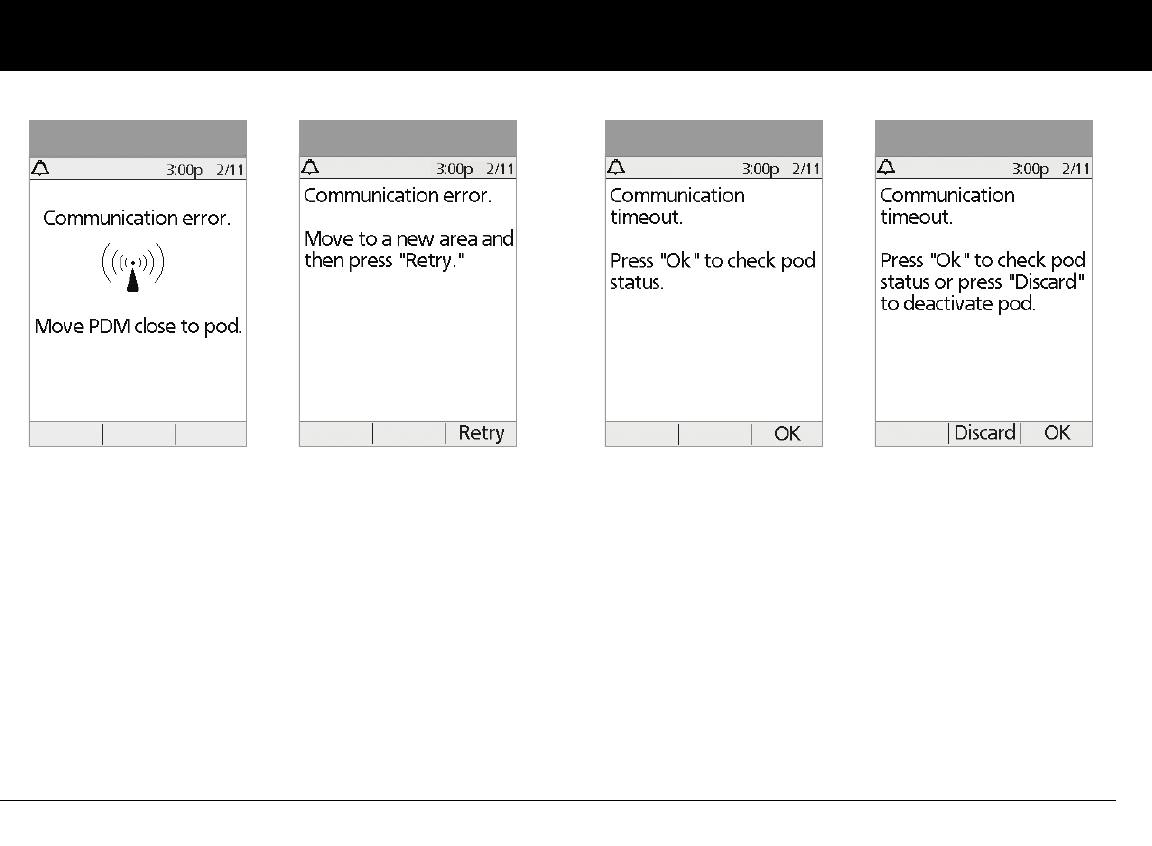
Communication Failures
133
11
2. Move across the room or to a different room. Then press
Retry.
a. If you press Retry within 2 minutes, the PDM tries to
communicate with the Pod again. If it cannot communi-
cate, it displays the same screen as in Figure 11-2, then
finally the “Communication timeout” screen (Figure 11-3).
Press OK to check the Pod status.
b. If the status check fails, you will see Figure 11-4. Press OK
to try checking Pod status again, or press Discard to
begin the deactivation process.
Figure 11-1 Figure 11-2 Figure 11-3 Figure 11-4
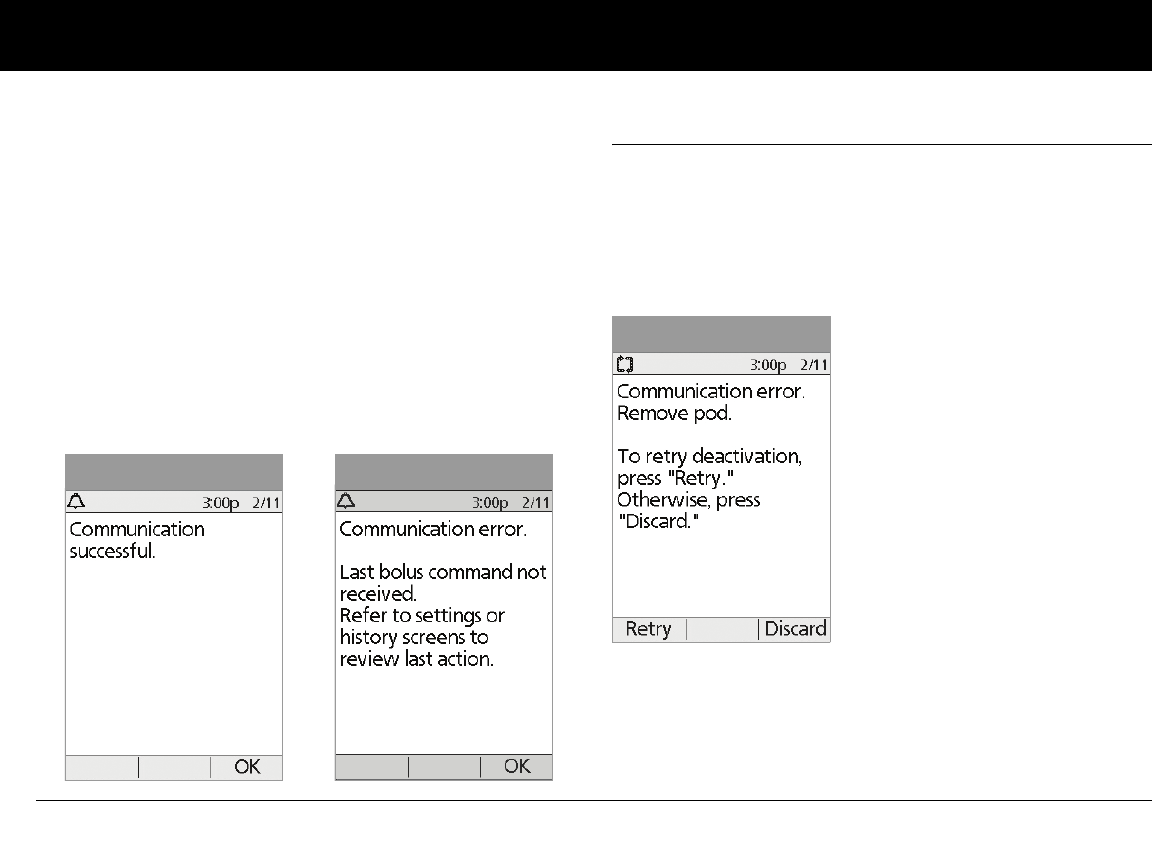
Communication Failures
134
11
3. If at any point in this process the PDM can communicate
again with the Pod, you will see either:
a. Figure 11-5, indicating that your original instruction or
command was successfully sent to the Pod. When you
press OK, or within 5 seconds, the System displays the next
screen in the command sequence you were entering.
b. Figure 11-6, indicating that your last command was not
sent to the Pod. Press OK.
If you were activating a Pod, the System returns to the pre-
vious screen, where you can continue activation. If you
were issuing any other command, the System returns to
the Status screen, where you can reissue the command.
■ Failure During Pod Deactivation
To review the deactivation process, see “Deactivate the current
OmniPod” in Chapter 5, Using the OmniPod.
If you press Confirm to deactivate the active Pod and the PDM
cannot send your instruction to the Pod, you will see the screen
in Figure 11-7.
Either:
1. Press Retry to try deactivating the Pod again. If the PDM still
cannot send the instruction, you will see Figure 11-7 again.
Follow step 2.
Figure 11-5 Figure 11-6
Figure 11-7
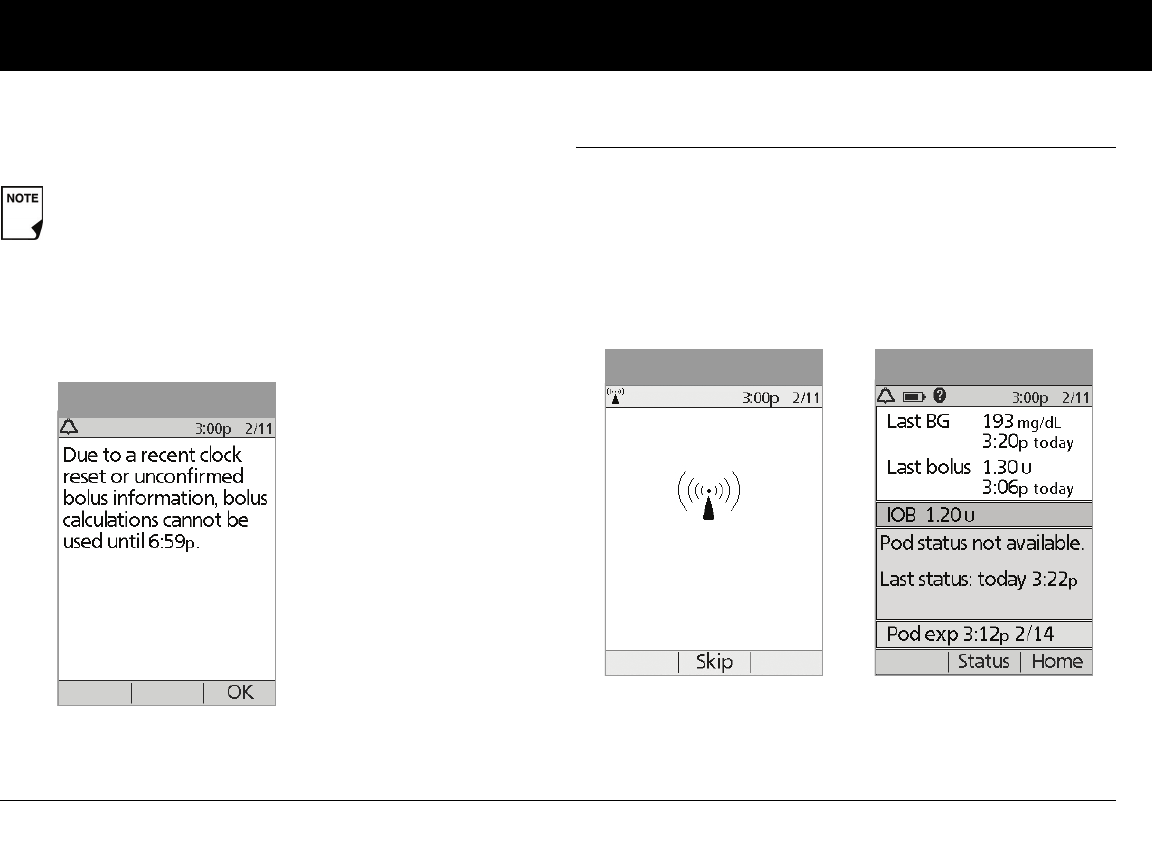
Communication Failures
135
11
2. Press Discard. The PDM will consider the Pod lost, and ask
whether you want to activate a new Pod.
■ Failure During Request for Status
If you turn on the PDM or press Status and the PDM cannot
communicate with the Pod, it displays a communication icon
(Figure 11-9). Below the icon is a soft key labeled Skip.
Either:
1. Wait until you see the “Pod status not available” screen
(Figure 11-10).
Or press Skip to skip the communication process and imme-
diately bring up Figure 11-10.
If you have an unconfirmed correction bolus when you
discard a Pod, then the bolus calculator will be temporar-
ily disabled. In this situation, the bolus calculator is dis-
abled until the duration-of-insulin-action period passes
(Figure 11-8). If you have any questions, call Insulet Cus-
tomer Support, 800-591-3455, 24 hours/7days (from
outside the United States, 781-457-5098).
Figure 11-8
Figure 11-9 Figure 11-10
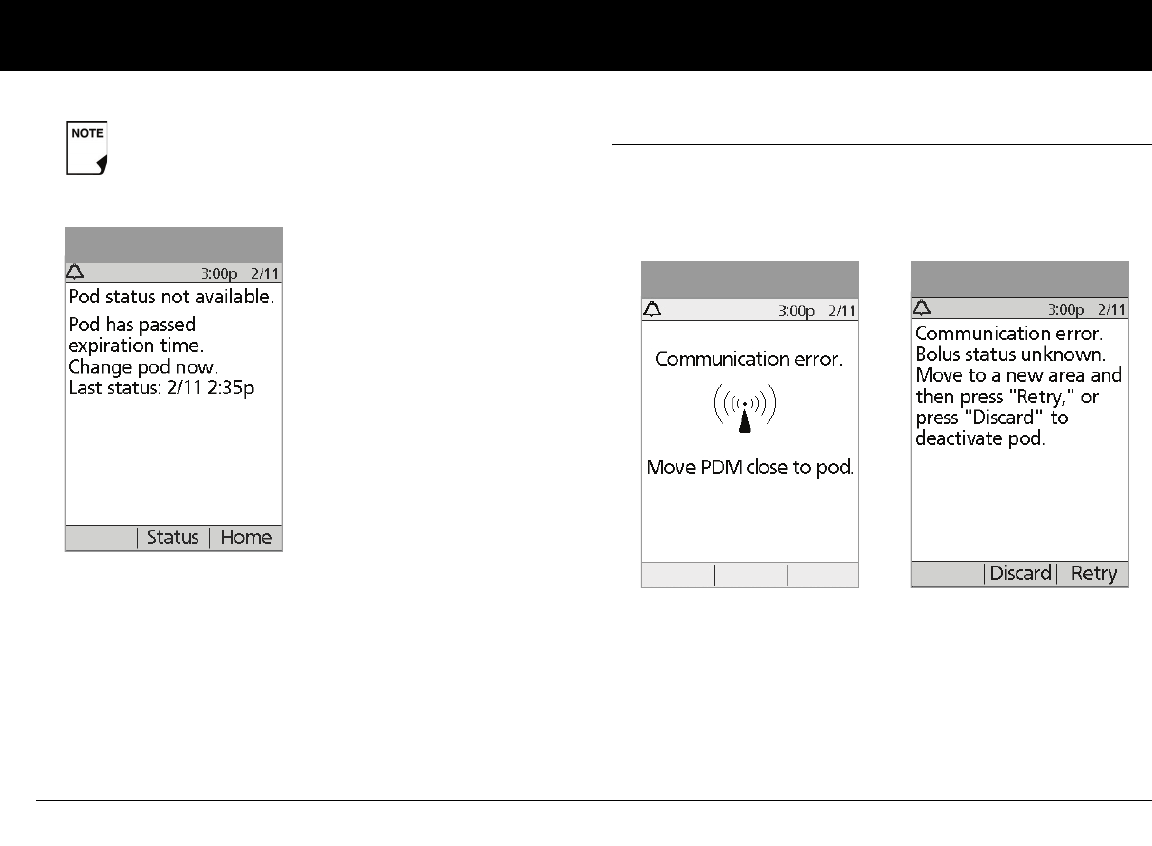
Communication Failures
136
11
At either “Pod status not available” screen, press Home to return
to the Home screen, or press Status to send another status
request.
■ Failure During Bolus Cancellation
1. When you instruct the PDM to cancel a bolus, if the PDM can-
not send your instruction to the Pod within a few seconds, it
displays the “Communication error” screen (Figure 11-12).
2. Move the PDM close to the Pod. The PDM tries to communi-
cate with the Pod again.
3. If the PDM still cannot communicate with the Pod, you will
see the “Bolus status unknown” message (Figure 11-13).
If the Pod has expired, you will see the screen in
Figure 11-11 instead.
Figure 11-11
Figure 11-12 Figure 11-13
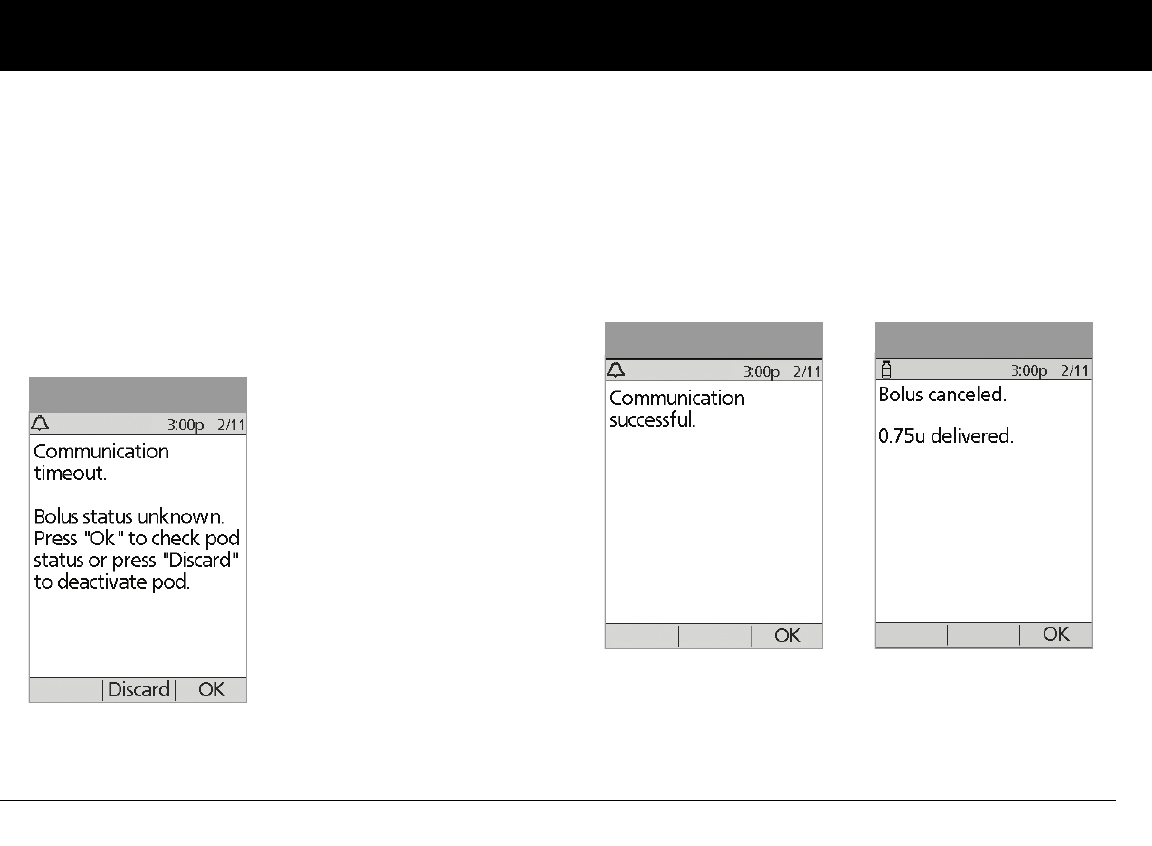
Communication Failures
137
11
4. Move across the room or to a different room. Then either:
a. Press Discard to begin the deactivation process.
b. Press Retry to repeat the attempts to communicate with
the Pod. The PDM tries to communicate with the Pod
again. If it cannot communicate, it displays the same
screen as in Figure 11-13, then finally a second “Bolus sta-
tus unknown” screen (Figure 11-14). Press OK to check the
Pod status or press Discard to begin the deactivation pro-
cess.
5. If at any point in this process the PDM can communicate
again with the Pod, you will see Figure 11-15. The message
indicates that your original instruction to cancel the bolus
was successful.
c. Press OK. The PDM displays the screen in Figure 11-16,
showing how much insulin was delivered before the
bolus was canceled.
d. Press OK again to return to the Status screen
Figure 11-14
Figure 11-15 Figure 11-16
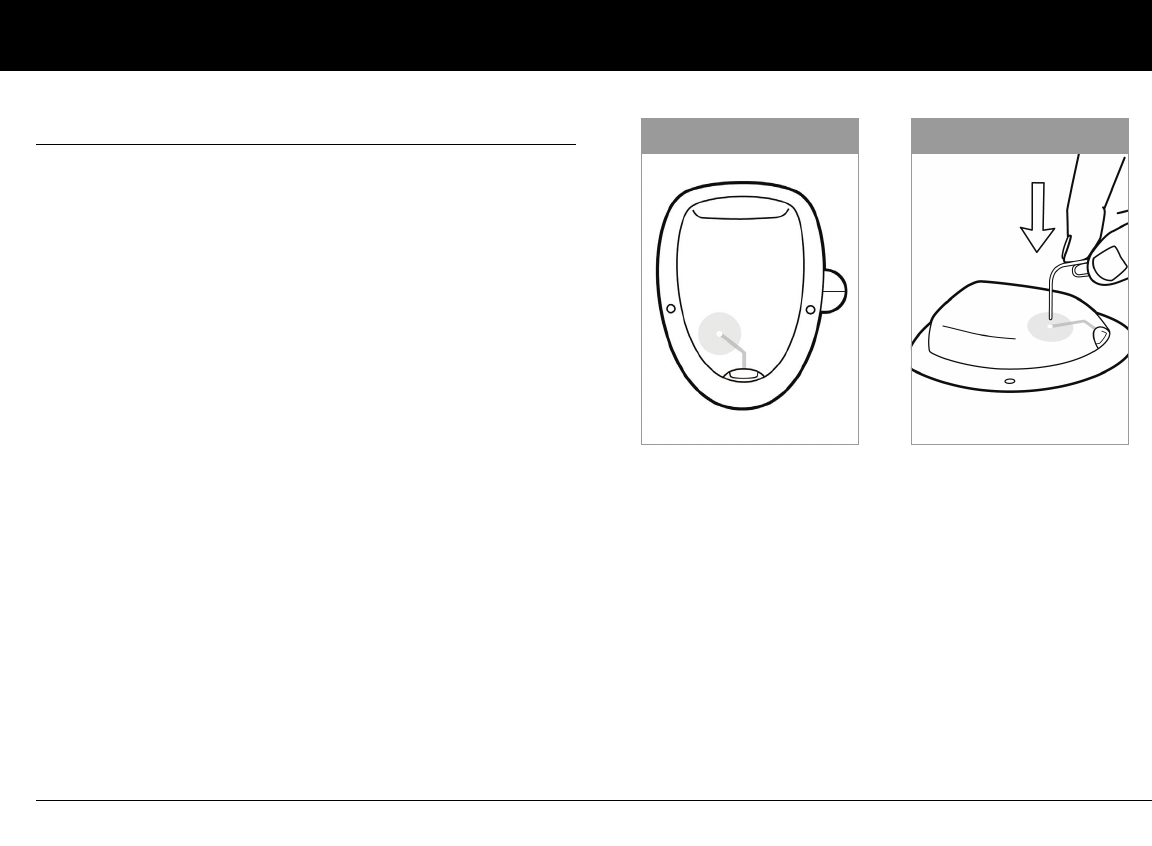
Communication Failures
138
11
■ Failure During a Hazard Alarm
If you respond to a hazard alarm (see Chapter 10, Errors, Adviso-
ries, and Hazard Alarms), but the PDM cannot communicate with
the Pod to acknowledge or shut off the alarm, you can shut off
the alarm manually.
1. Remove the Pod from your body if you have not already
done so.
2. Press the end of a paper clip or similar item straight down into
the manual alarm shut-off port (Figure 11-17) on the top side
of the Pod (Figure 11-18). The port can be found by following
the bright white trail on the top of the Pod. Move the paper
clip back and forth until the alarm stops. Then discard the Pod
according to local waste disposal regulations.
Figure 11-17 Figure 11-18
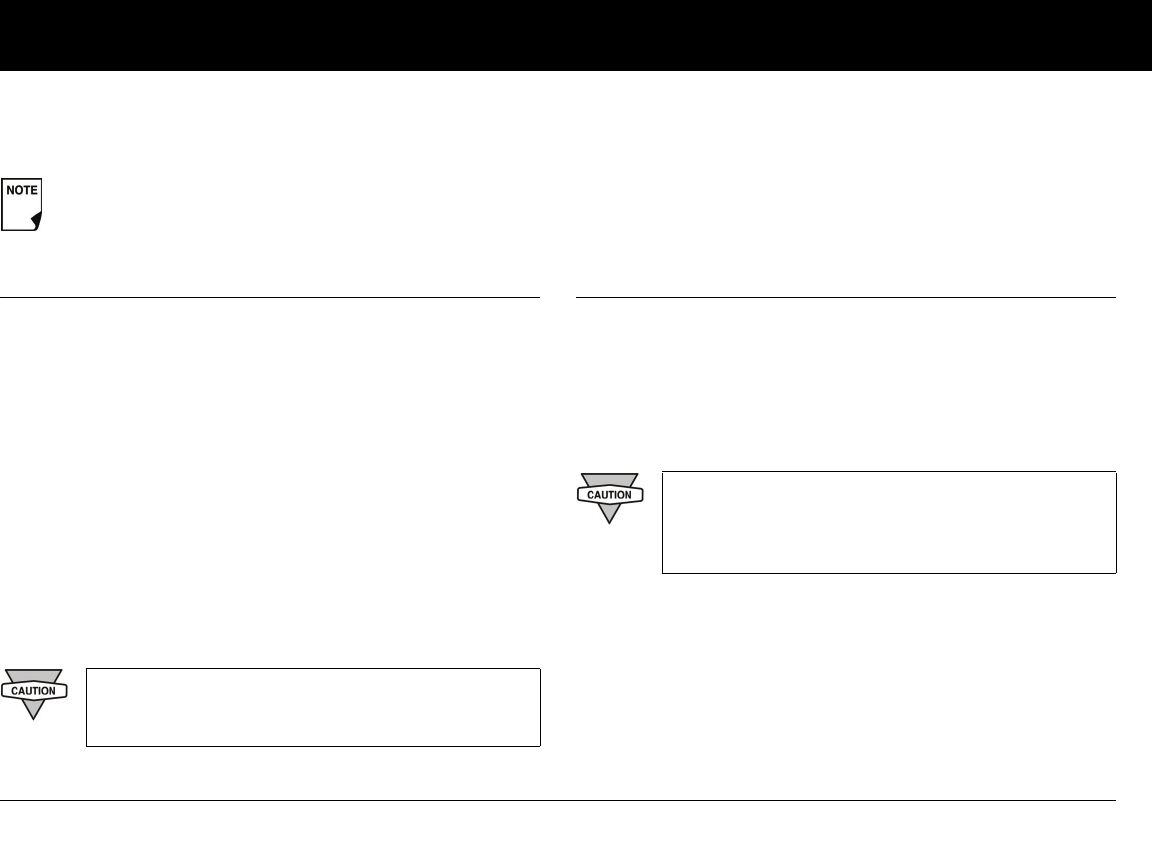
139
Appendices
The OmniPod Insulin Management System has no user-serviceable parts. If you require assistance operating or maintaining
the System, please contact Customer Support at 800-591-3455 (from outside the United States, 781-457-5098).
■ OmniPod Care and Maintenance
Storage
Store unopened OmniPods in a cool, dry place. Extreme heat or
cold can damage Pods and cause them to malfunction. If Pods
are exposed to extreme temperatures, inspect them carefully
before use. Pods are sterile unless packaging is opened or dam-
aged. Do not apply or use a Pod if its sterile packaging is opened
or damaged.
Cleaning
OmniPods are watertight. If you need to clean a Pod, you can
gently wash it with a clean, damp cloth. Or you can use mild soap
and water. However, do not use strong detergents or solvents.
They can damage the Pod’s casing or irritate the infusion site.
■ Personal Diabetes Manager Care and Maintenance
Storage
When you are not actively using the Personal Diabetes Manager
(PDM) to enter or change programs, you can store it in a conve-
nient, nearby location. The storage location should be cool and
dry.
If the PDM is not safe from children or others who may press the
buttons by accident, consider using the optional PDM lock
safety feature to prevent accidental program changes (see
Chapter 6, Using the Personal Diabetes Manager).
Hold the Pod securely and take care while cleaning
it, so the cannula doesn’t kink and the Pod doesn’t
become detached from your skin.
Do not store or leave the PDM where it may be
exposed to extreme temperatures, such as inside a
car. Extreme heat or cold can cause the device to
malfunction.
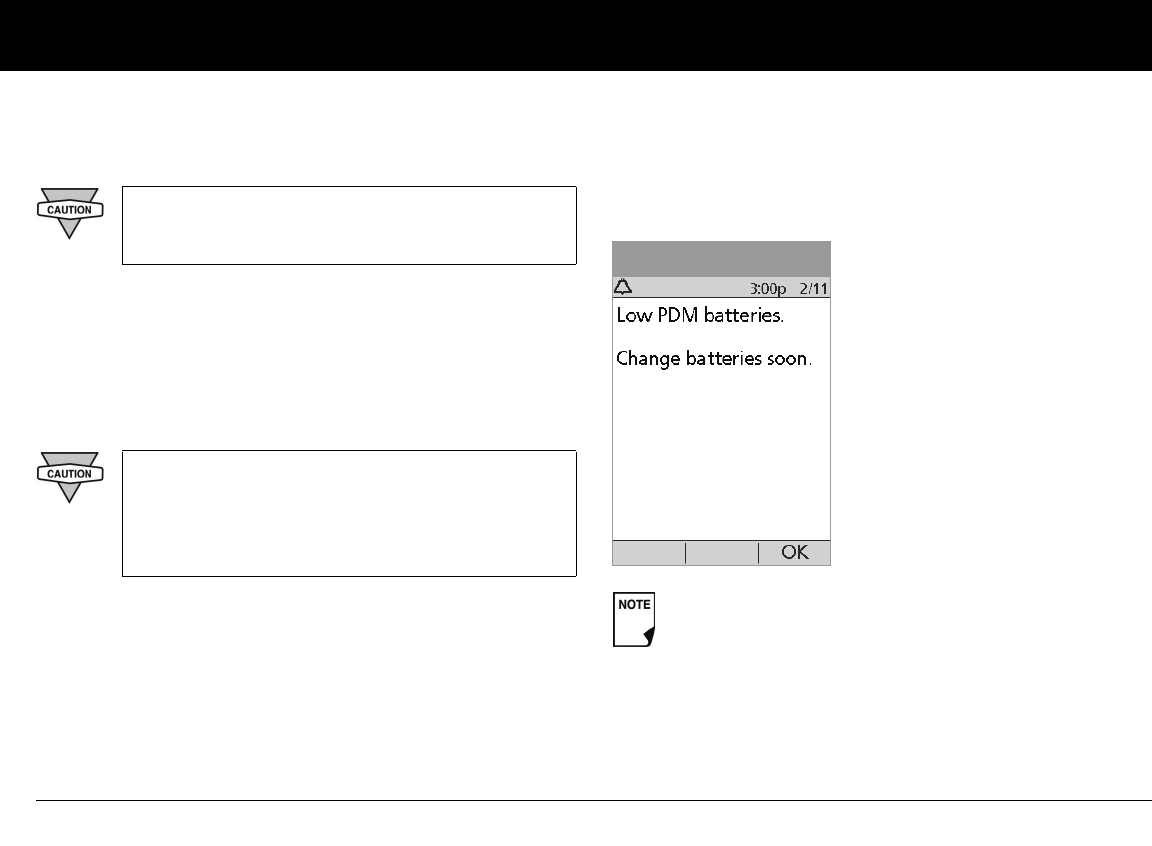
Appendices
140
Cleaning
You can clean the outside of the PDM with a clean, damp cloth.
If the battery compartment becomes soiled, gently shake out
the debris or use a dry, lint-free cloth to remove it.
Replacing batteries
The PDM uses two (2) AAA alkaline batteries. You can purchase
them at any grocery, hardware, or convenience store.
On average, a pair of batteries powers the PDM for 3 weeks. The
battery life indicator on the PDM shows the battery power level.
See “Personal Diabetes Manager Icons” on page150 for the vari-
ous battery power levels and their respective icons.
The PDM automatically alerts you when its battery power gets
low (see Figure A-1). When you see the “Low PDM battery” alert,
press OK to turn off the alert. Replace the batteries as soon as
you can.
Do NOT use IV Prep wipes, alcohol wipes, soap,
detergent, or solvents. Never put any liquid into the
battery compartment.
Do not use any other type of batteries than AAA
alkaline batteries to power the PDM. Never use old
or used batteries; the PDM may not work properly.
Using any kind of batteries other than alkaline may
reduce battery life and cause damage to the PDM.
When your PDM alerts you that battery power is getting
low, the PDM will maximize remaining battery life by:
• Turning off your vibration alert (if set)
• Disabling bright mode
• Disabling the test strip port light
Once the batteries are replaced, these functions resume.
Figure A-1
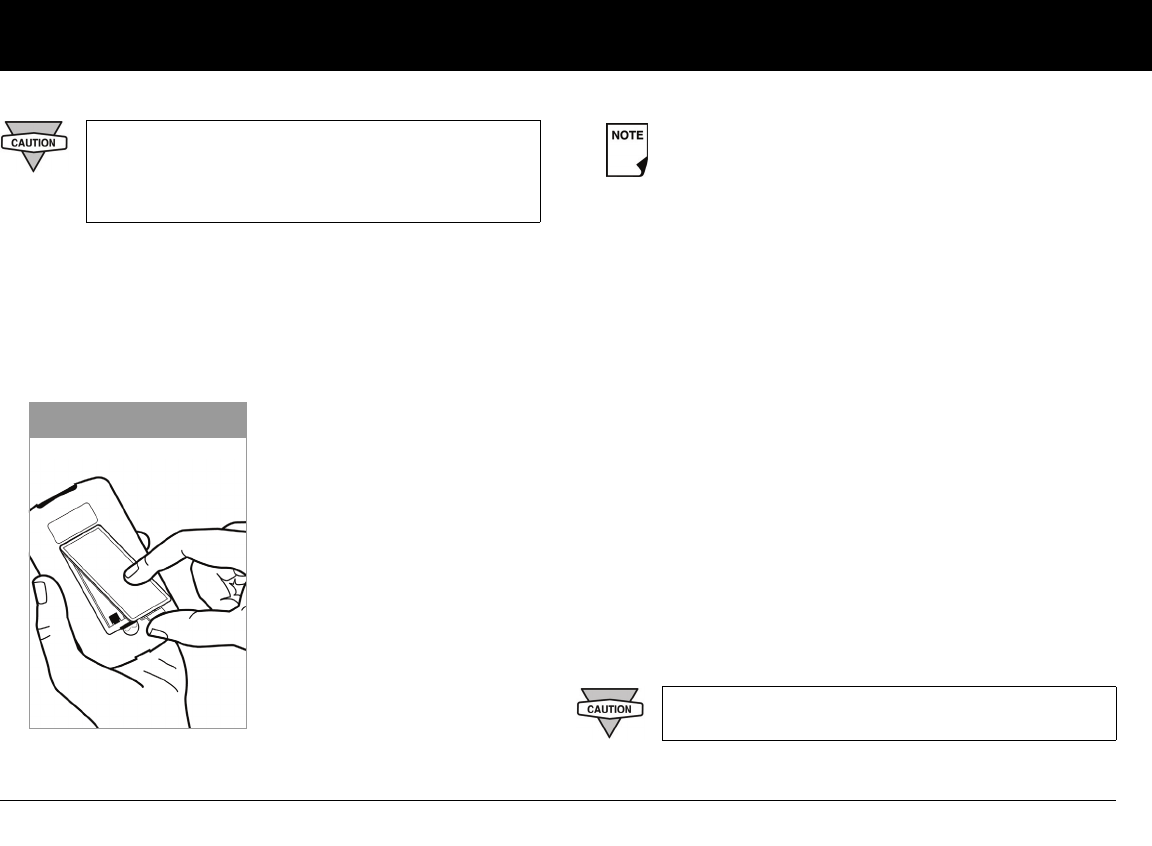
Appendices
141
To replace batteries
1. Open the battery compartment on the back of the PDM by
pushing the compartment latch inward and then upward
(Figure A-2). No special tools are necessary.
2. Insert 2 new AAA alkaline batteries into the compartment.
3. Replace the battery door.
4. Turn the PDM face up.
5. Press and hold the Power button.
The PDM is now ready to use. Dispose of the old batteries in
accordance with local waste disposal regulations.
If the PDM becomes submerged in water
The PDM is not waterproof. Do not place it in water or leave it
near water where it can accidentally fall in. If it becomes sub-
merged in water:
1. Dry the outside of the PDM with a clean, lint-free cloth.
2. Open the battery compartment; remove the batteries and
discard them.
3. Use a clean, lint-free cloth to gently absorb any water in the
battery compartment.
4. Leave the battery compartment door open until the PDM is
thoroughly dry.
If the batteries run out, data in the memory is at risk.
DO NOT remove the old batteries until you have
new ones at hand. The longer the batteries are
removed, the more the memory is at risk.
Figure A-2
The diagram inside the compartment shows you
which direction to insert the batteries.
Never use a blow dryer or hot air to dry the Pod or
PDM. Extreme heat can damage the electronics.
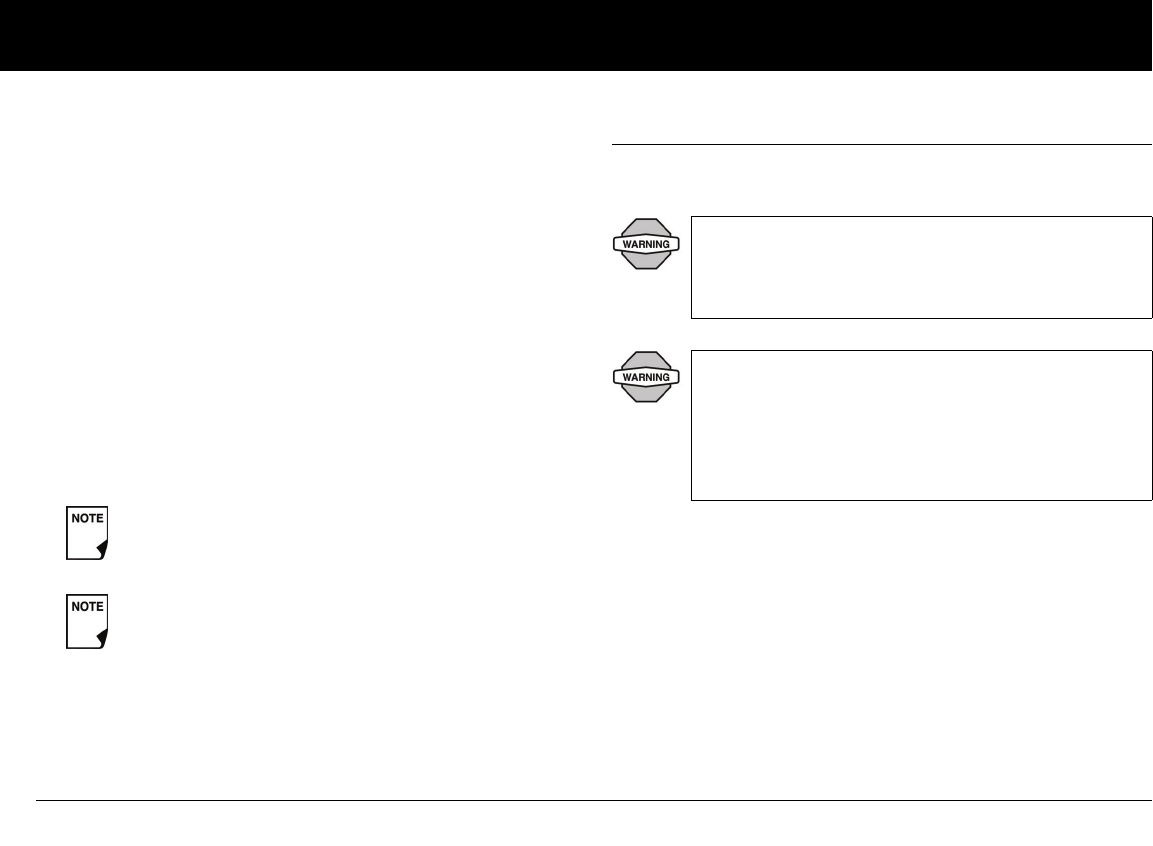
Appendices
142
5. Do not put in fresh batteries or attempt to use the PDM until
it has thoroughly air-dried.
If you drop the PDM
The PDM is built to withstand reasonable amounts of abuse, but
shock or a severe impact can damage it. If you drop the PDM or if
it is otherwise subjected to severe impact:
1. Inspect the outside of the PDM for visible signs of damage.
2. Press and hold the Power button to see whether the PDM
turns on and whether the LCD screen is damaged.
3. Inspect the inside of the battery compartment for visible
signs of damage.
4. Do NOT use the PDM if it appears damaged or is not working
as it should.
■ Storage and Supplies
Storage
Ordering supplies
You can order all OmniPod System products and supplies
directly from Insulet Corporation. You can order them by calling
800-591-3455 (from outside the United States, 781-457-5098),
Monday-Friday, 8:30am–8pm Eastern Time. We use established,
reliable carriers to insure fast, safe delivery. Special or overnight
delivery is possible to most parts of the continental United
States.
For 24-hour Customer Support, call 800-591-3455
(from outside the United States, 781-457-5098).
See the warranty coverage on page 158.
Store all OmniPod System products and supplies
(including unopened Pods) in a cool, dry place. Prod-
ucts or supplies that have been exposed to extreme
temperatures may not function properly.
It is especially important to store your insulin in a well-
controlled environment. Inspect insulin before using
it; never use insulin that looks cloudy or discolored.
Insulin that is cloudy or discolored may be old, conta-
minated, or inactive. Check the insulin manufacturer’s
instructions for use and expiration date.
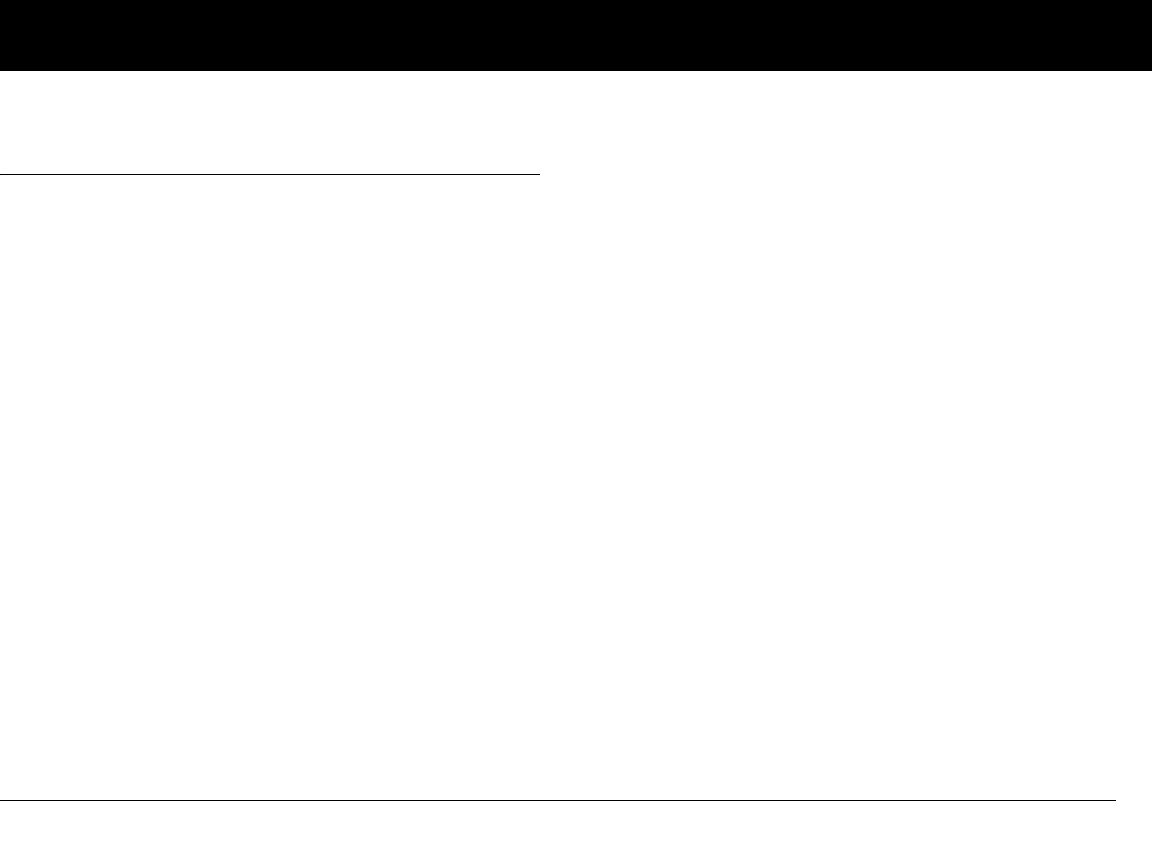
Appendices
143
■ Suggested Bolus Calculator Examples and
Guidelines
A suggested bolus is equal to the sum of a correction bolus and
meal bolus, then adjusted for insulin on board, if applicable.
Examples of each of these elements are shown below.
Example of correction bolus
Target BG: 100 mg/dL
Current BG: 200 mg/dL
Correction factor (CF): 50
200 mg/dL (current) –100 mg/dL (target) = 100 mg/dL
100 mg/dL ÷ 50 (CF) = 2 units correction bolus
If the reverse correction feature is turned On and if your current
BG is below your target BG, the suggested bolus calculator sub-
tracts a correction amount from the meal bolus.
Example of reverse correction bolus:
Target BG: 100 mg/dL
Current BG: 75 mg/dL
Correction factor (CF): 50
75 mg/dL (current) – 100 mg/dL (target) = –25 mg/dL
–25 mg/dL ÷ 50 CF = –0.5 units reverse correction bolus
(reduces meal bolus)
Meal bolus calculation
Carbs entered ÷ insulin-to-carb (I/C) ratio
Example of meal bolus
Carbs entered: 45 grams of carb
Insulin-to-carb ratio: 15
45 carbs ÷ 15 I/C ratio = 3 units meal bolus
Insulin-on-board (IOB) calculation
(Duration of insulin action – time since your previous bolus) ÷
(duration of insulin action) ∗ (previous bolus)
IOB from a previous correction bolus is called “correction IOB,”
and IOB from a previous meal bolus is called “meal IOB.”
Example of correction IOB
Duration of insulin action: 3 hours
Time since previous correction bolus: 1 hour
Previous correction bolus: 3 units
3 hours – 1 hour = 2 hours
2 hours ÷ 3 hours = 2/3
2/3 ∗ 3 units = 2 units correction IOB
In other words, one hour after your previous correction bolus,
you have received only 1 unit of insulin from it; 2 units of insulin
are still working to correct your BG. This feature prevents deliver-
ing too much insulin when correcting a high BG.
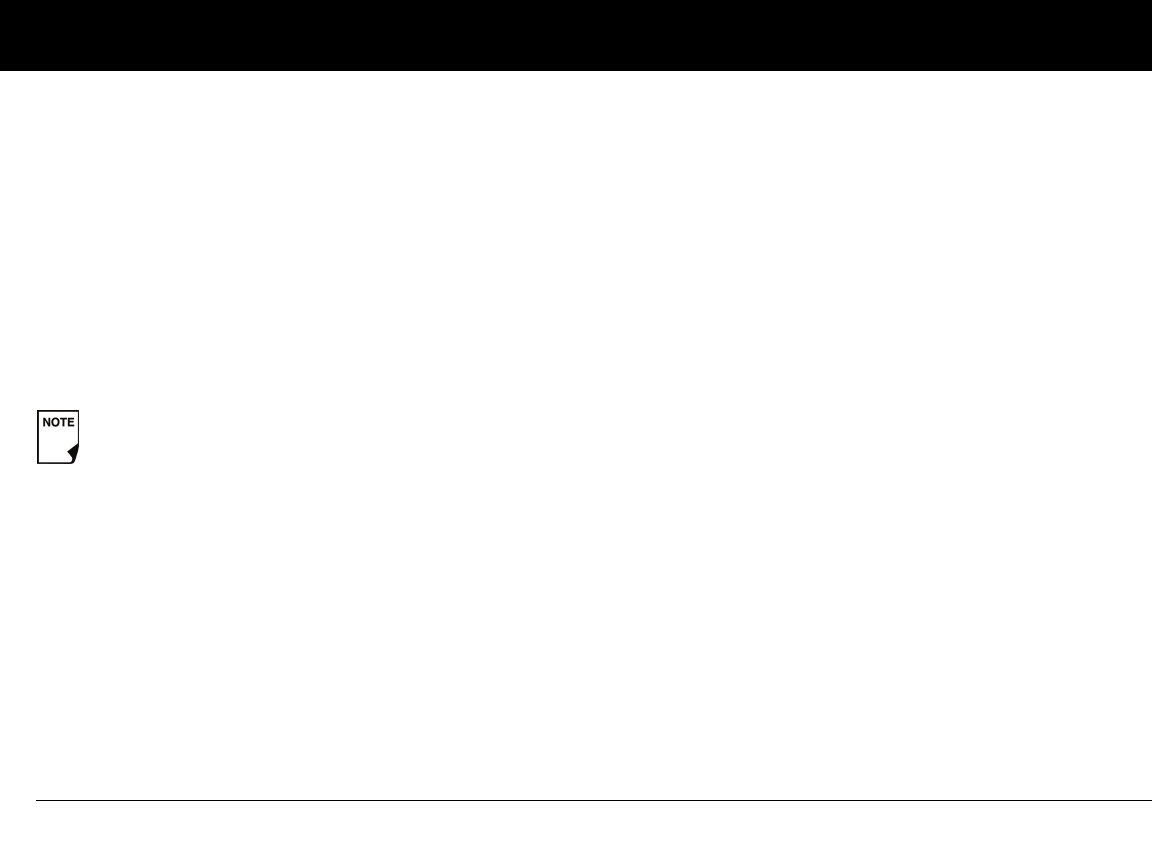
Appendices
144
Example of meal IOB
Duration of insulin action: 3 hours
Time since previous meal bolus: 2 hours
Previous meal bolus: 4.5 units
3 hours – 2 hours = 1 hour
1 hours ÷ 3 hours = 1/3
1/3 ∗ 4.5 units = 1.5 units meal IOB
In other words, two hours after your previous meal bolus, you
have received 3 units of insulin from it; 1.5 units of insulin are still
working to cover your meal.
Examples of suggested bolus calculations
The examples below use these settings:
• Target BG: 100 mg/dL
• I/C ratio: 1:15
• Correction factor (CF): 50
• Duration of insulin action: 3 hrs
Example 1
Current BG level: 150 mg/dL
Carb intake: 0 grams of carbohydrate (carbs)
Meal IOB: 1 units
Correction IOB: 1 units
Correction bolus: 150 mg/dL (current) – 100 mg/dL (target) = 50
50 ÷ 50 (CF) = 1 unit
Meal bolus: 0 (carbs) ÷ 15 (I/C ratio) = 0 units
Suggested bolus dose = 1 (correction) + 0 (meal) – 2 (IOB) = 0U
Example 2
Current BG level: 150 mg/dL
Carb intake: 45 carbs
Meal IOB: 0 units
Correction IOB: 0 units
Correction bolus: 150 mg/dL (current) – 100 mg/dL (target) = 50
50 ÷ 50 (CF) = 1 unit
Meal bolus: 45 (carbs) ÷ 15 (I/C ratio) = 3 units
Suggested bolus dose = 1 (correction) + 3 (meal) – 0 (IOB) = 4U
Meal IOB is only used to reduce a correction bolus,
and the correction bolus is only reduced until it
becomes 0 units.

Appendices
145
Example 3
Current BG level: 100 mg/dL
Carb intake: 45 carbs
Meal IOB: 1 units
Correction IOB: 0 units
Correction bolus: 100 mg/dL (current) – 100 mg/dL (target) = 0
0÷ 50 (CF) = 0 units
Meal bolus: 45 (carbs) ÷ 15 (I/C ratio) = 3 units
Suggested bolus dose = 0 (correction) + 3 (meal) – 0 (IOB) = 3U
Example 4
Current BG level: 150 mg/dL
Carb intake: 60 carbs
Meal IOB: 0 units
Correction IOB: 1 unit
Correction bolus: 150 mg/dL (current) – 100 mg/dL (target) = 50
50 ÷ 50 (CF) = 1 unit
Meal bolus: 60 (carbs) ÷ 15 (I/C ratio) = 4 units
Suggested bolus dose = 1 (correction) + 4 (meal) – 1 (IOB) = 4U
Calculator guidelines
When the suggested bolus calculator is turned On, the OmniPod
System applies these guidelines to the suggested bolus doses:
• Suggested bolus doses are rounded down to the nearest
0.05U.
• If the total of the suggested bolus calculation (correction
bolus plus meal bolus) is less than zero, the suggested bolus
dose is 0.00U.
• The System will not suggest a bolus dose if your current
blood glucose (BG) reading is below the minimum BG you
have set for bolus calculation (see Chapter 2, Getting Started,
and Chapter 6, Using the Personal Diabetes Manager).
• The System suggests a correction bolus only when your BG
reading is above the correction threshold or correct-above
value you have set (see Chapter 2, Getting Started, and
Chapter 6, Using the Personal Diabetes Manager).
• Meal IOB, which is insulin on board from a previous meal
bolus, is subtracted first from the current correction bolus, if
any, until it is zero. However, any remaining meal IOB is never
subtracted from the current meal bolus.
• Correction IOB, which is insulin on board (active insulin) from
a previous correction bolus, is then subtracted from the cur-
rent correction bolus, if any remains, until it is zero. At that
point, any remaining correction IOB is subtracted from the
current meal bolus.
Meal IOB is never subtracted from another meal
bolus—only from a correction bolus.

Appendices
146
• The calculated insulin on board is rounded up to the nearest
0.05U.
• A reverse correction only occurs if the meal bolus is greater
than 0.00U.
• If your blood glucose value is below the target blood glucose
value and you have set reverse correction to On, the sug-
gested correction bolus is subtracted from the suggested
meal bolus. If you have set reverse correction to Off, the
System will not subtract insulin from the suggested meal
bolus dose.
If you manually increase or decrease the suggested bolus, the
following rules apply:
• If you increase a suggested bolus, the increase is applied to
the meal bolus unless there is no meal bolus, in which case it
is applied to the correction bolus.
• If you decrease a suggested bolus, the decrease is applied to
the meal bolus until it reaches zero; then it is applied to the
correction bolus. If there is no meal bolus, the decrease is
applied to the correction bolus.
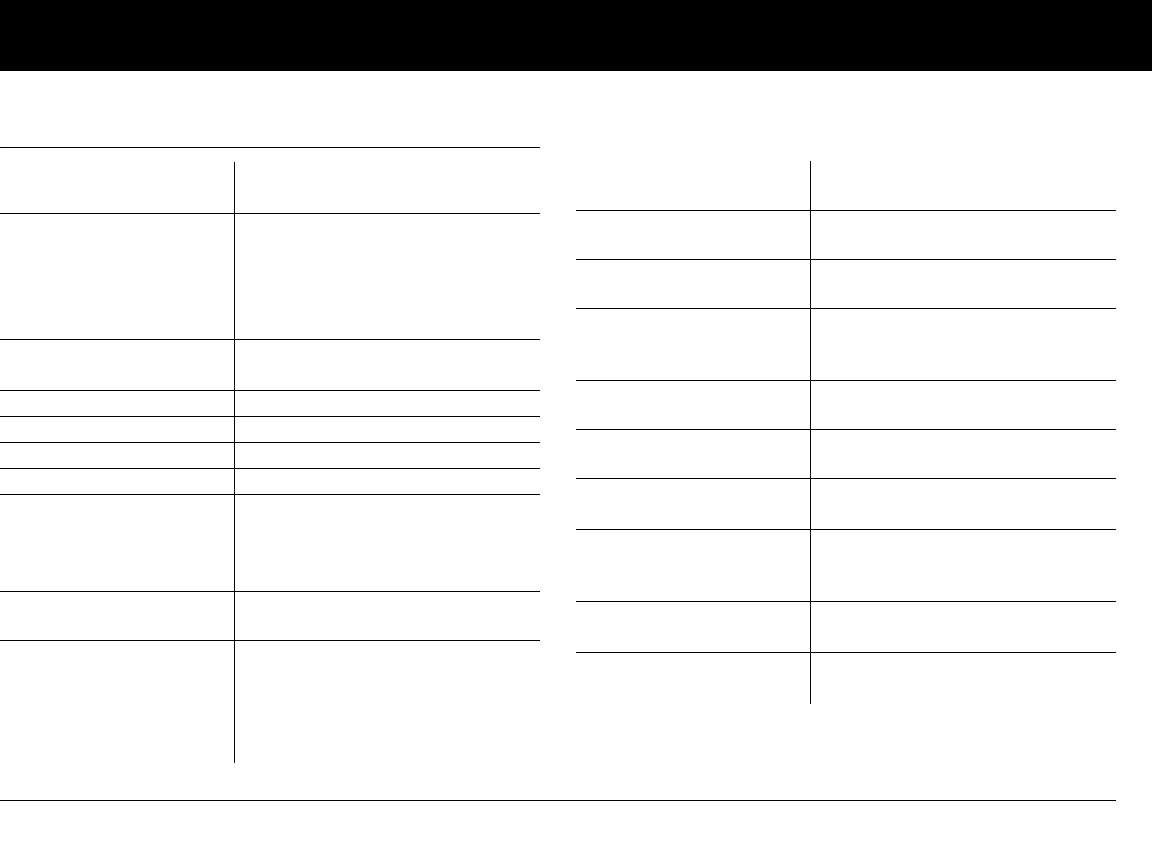
Appendices
147
■ OmniPod System Options and Settings
Time 12-hour or 24-hour clock
Default is 12-hour
Date MM/DD/YY
DD/MM/YY
MM.DD.YY
DD.MM.YY
Default is MM/DD/YY
Maximum basal rate 30 U/hr
Default is 3.00 U/hr
Basal programs 7
Basal rate segments 24 per program
Basal rate increment 0.05 units
Temp basal presets 7
Temp basal %, Units, or Off
30 minutes to 12 hours in 30-
minute increments
Default is Off
Blood glucose (BG) goal for
BG history
Upper and lower limits; 70 to 200
mg/dL in 1 mg/dL increments
Blood glucose reminder On or Off; maximum of 4
Reminder time of 1 to 4 hours
after every bolus dose in 30-
minute increments
Default is Off
Blood glucose meter sound On or Off
Default is On
Suggested bolus calculator On or Off
Default is On
Target BG value and
correction threshold
4 time segments; 70 to 200 mg/dL
in 1 mg/dL increments
Minimum BG allowed for
use by the suggested bolus
calculator
50 to 70 mg/dL in 1 mg/dL incre-
ments
Default is 70 mg/dL
Insulin-to-carb (IC) ratio 4 time segments; 1 to 150 g carb/
U in 1g carb/U increments
Correction (sensitivity)
factor
4 time segments; 1 to 300 mg/dL
in 1 mg/dL increments
Reverse correction On or Off
Default is On
Duration of insulin action 2 to 6 hours in 30-minute incre-
ments
Default is 4 hours
Bolus increment 0.05, 0.1, 0.5, or 1.0 units
Default is 0.1 units
Maximum bolus size 30 units
Default is 10 units
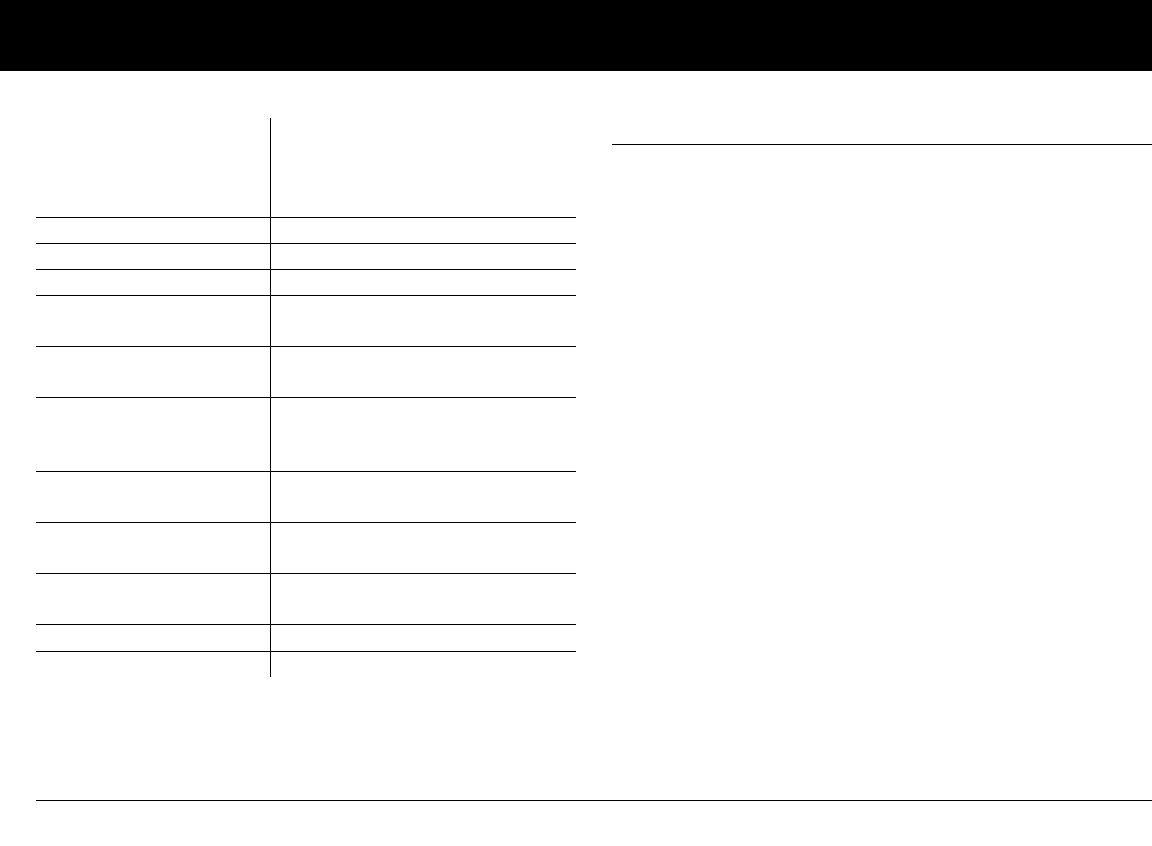
Appendices
148
■ OmniPod Specifications
Size: 1.6" wide x 2.4" long x 0.7" high
4.1cm x 6.2cm x 1.7cm)
Weight (with full reservoir): 34 grams
Operating temperature range: 40°F to 104°F (5°C to 40°C)
Under normal circumstances, your body temperature will keep
the Pod well within this range.
Startup temperature: above 50°F (10°C)
Storage temperature range: 14°F to 122°F (-10°C to 50°C)
Reservoir volume (deliverable): 200 units
Cannula insertion depth: 6.5mm
Watertight rating: IPX8 (8 feet for 30 minutes)
Insulin concentration: U-100
Alarm type: Audible
Delivery accuracy (tested per IEC 60601-2-24):
Basal: +/- 5% at rates > 0.1 U/hr
Bolus: +/- 5% for all set values > 0.1 units
Operating relative humidity range: 20–85%, noncondensing
Storage relative humidity range: 20–85%, noncondensing
Operating atmospheric pressure: 700 hPA to 1060 hPA
Storage atmospheric pressure: 700 hPA to 1060 hPA
Extended bolus %, Units, or Off
30 minutes to 8 hours in 30-
minute increments
Default is Off
Bolus presets 7
Carbohydrate presets 36
Suspend 30 minutes to 2 hours
Low reservoir volume
indicator
10 to 50 units in 5-unit increments
Default is 10.0 units
Pod expiration alert 1 to 24 hours in 1-hour increments
Default is 4 hours
Auto-off alert 1 to 24 hours or Off in 1-hour
increments
Default is Off
PDM lock On or Off
Default is Off
Screen time-out 10, 20, or 30 seconds
Default is 20 seconds
Backlight time-out 5, 10, or 20 seconds, or Always on
Default is 10 seconds
History storage 5400 records/90 days
Language English

Appendices
149
■ Personal Diabetes Manager Specifications
Size: 2.5" wide x 4.5" long x 1.0" high (6.4cm x 11.4cm x 2.5cm)
Weight (with batteries): 125 grams (4.4 oz)
Screen: 1.4" wide x 1.9" long (3.6cm x 4.8cm); 2.4" diagonal
(6.1cm) LCD
Battery: Powered by 2 AAA alkaline batteries
Battery life: Approximately 3 weeks
Operating temperature range: 40°F to 104°F (5°C to 40°C)
Storage temperature range: 14°F to 122°F (-10°C to 50°C)
Operating relative humidity range: 5% to 90% noncondensing
Storage relative humidity range: 5% to 90% noncondensing
Operating atmospheric pressure: 700 hPA to 1060 hPA
Storage atmospheric pressure: 700 hPA to 1060 hPA
Communication distance: Up to 24" (61cm)
Alarm type: Audible and selected vibratory
Warranty: 4 years
■ Blood Glucose Meter Specifications
Assay method: Coulometric electrochemical sensor
Calibration: Plasma equivalent
Hematocrit: 15% to 65%
Measurement units: mg/dL
Result range: 20 to 500 mg/dL
Sample: Whole blood, capillary
Sample size: 300 nanoliters (1/3 or 0.3 microliter)
Test time: Average of 7 seconds
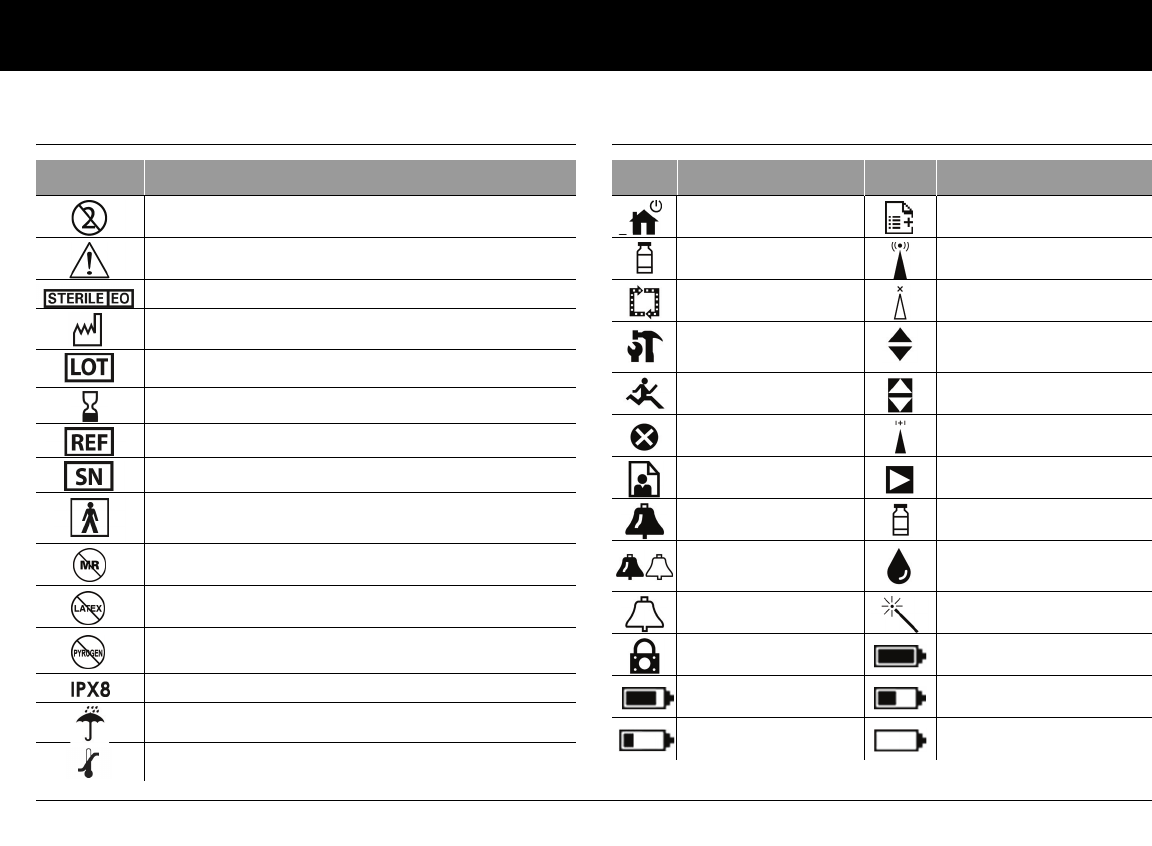
Appendices
150
■ OmniPod System Label Symbols ■ Personal Diabetes Manager Icons
Symbol Meaning
Do not reuse this device. Single-use only.
Please read instructions for use (see User Guide).
Sterilized by ethylene oxide
Manufacture date: (year–month)
Lot number
Expiration date (use-by date): (year–month)
Reference/model number: (reorder number)
Device serial number
Type BF medical device
(protection from electrical shock)
Not MRI-safe
Latex free
Non-pyrogenic
Watertight to 8 feet for 30 minutes
Keep dry
Storage temperature
Icon Meaning Icon Meaning
Power More actions
Bolus/insulin gauge Communication
Pod change Communication failure
Diagnostics/
settings Up/Down
Temp basal Up/Down (on color)
Suspend/cancel Status
My Records Text entry right
Advisory alarm Insulin gauge
(alternating)
Hazard alarm
Apply blood sample/
Blood glucose records
Alert Setup Wizard
PDM lock Battery full
Battery 3/4 full Battery half full
Battery 1/4 full Battery empty
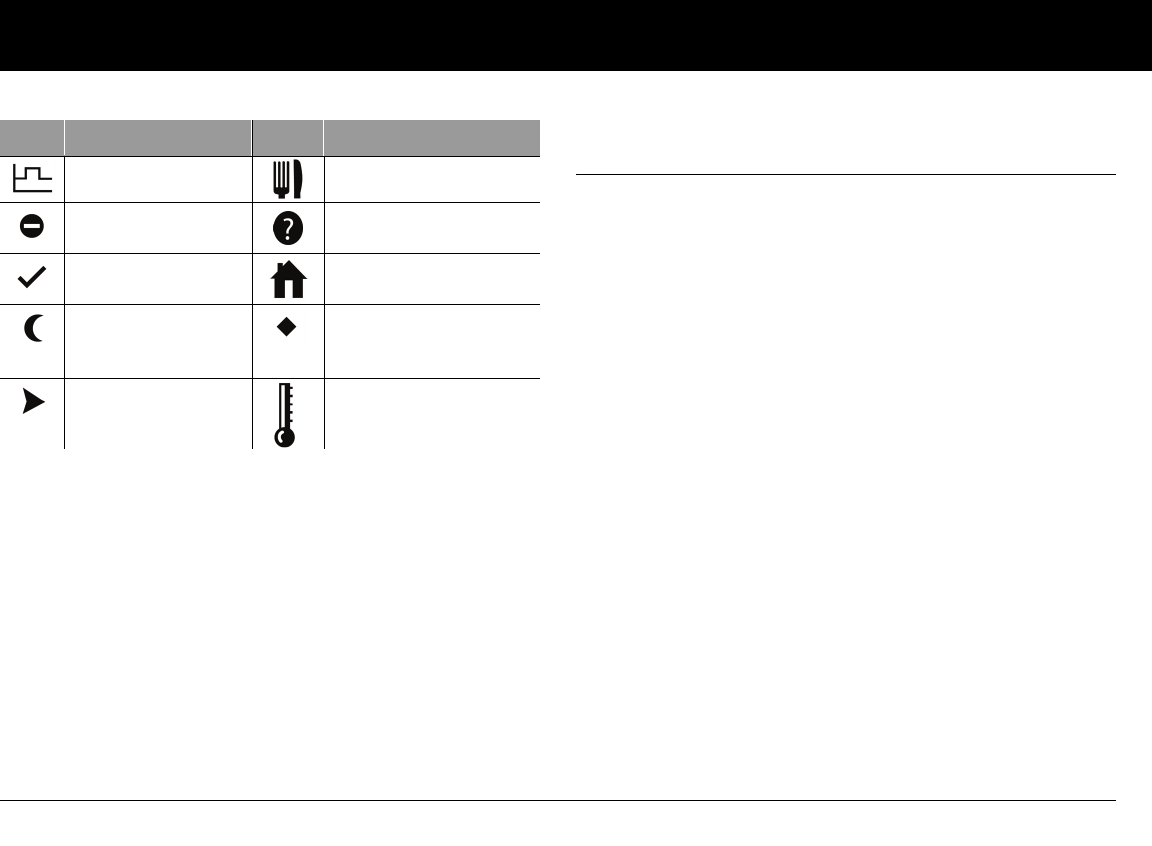
Appendices
151
■ OmniPod System Federal Communications
Commission (FCC) Notice Concerning Interference
The OmniPod Insulin Management System (both the OmniPod
and the Personal Diabetes Manager or PDM) complies with Part
15 of the FCC Rules. Operation is subject to the following two
conditions:
1. These devices may not cause harmful interference.
2. These devices must accept any interference received, includ-
ing interference that may cause undesirable operation.
Changes or modifications not expressly approved by Insulet
could void the user’s authority to operate the equipment.
Both the OmniPod and the PDM generate, use, and can radiate
radio frequency energy, and may cause harmful interference to
radio communications. There are no guarantees that interfer-
ence will not occur in a particular installation. If the OmniPod
System does cause harmful interference to radio and television
reception, the interference may be corrected by one of the fol-
lowing measures:
• Move or relocate the OmniPod System.
• Increase the distance between the OmniPod System and the
other device that is emitting or receiving interference.
Basal program Food library
“Lost” history
record
User Information/
Support
“Unconfirmed”
history record Home screen
“Delivery Spans
Midnight”
history record
Active/default
program or selected
BG tag
Submenu Temperature out of
range
Icon Meaning Icon Meaning

Appendices
152
■ Electromagnetic Compatibility
The information contained in this section (such as separation
distances) is, in general, specifically written with regard to the
OmniPod System. The numbers provided will not guarantee
faultless operation but should provide reasonable assurance of
such. This information may not be applicable to other medical
electrical equipment; older equipment may be particularly sus-
ceptible to interference.
General Notes
Medical electrical equipment requires special precautions
regarding electromagnetic compatibility (EMC) and needs to be
installed and put into service according to the EMC information
provided in this document and the instructions for use.
Portable and mobile RF communications equipment can affect
medical electrical equipment.
Cables and accessories not specified within the instructions for
use are not authorized. Using other cables and/or accessories
may adversely impact safety, performance, and electromagnetic
compatibility (increased emission and decreased immunity).
Care should be taken if the OmniPod is used adjacent to other
electrical equipment; if adjacent use is inevitable, such as in work
environments, the OmniPod should be observed to verify nor-
mal operation in this setting.
The OmniPod communicates by low level RF energy. As with
all RF receivers, the potential for disturbance exists, even with
equipment that complies with FCC and CISPR emissions require-
ments. The OmniPod communicates with the following charac-
teristics:
Frequency: 13.56 Mhz, ASK modulation, with an effective
radiated power of 16mW
The OmniPod System greatly exceeds the immunity require-
ments of the general standard for electromagnetic compatibility,
IEC 60601-1-2.
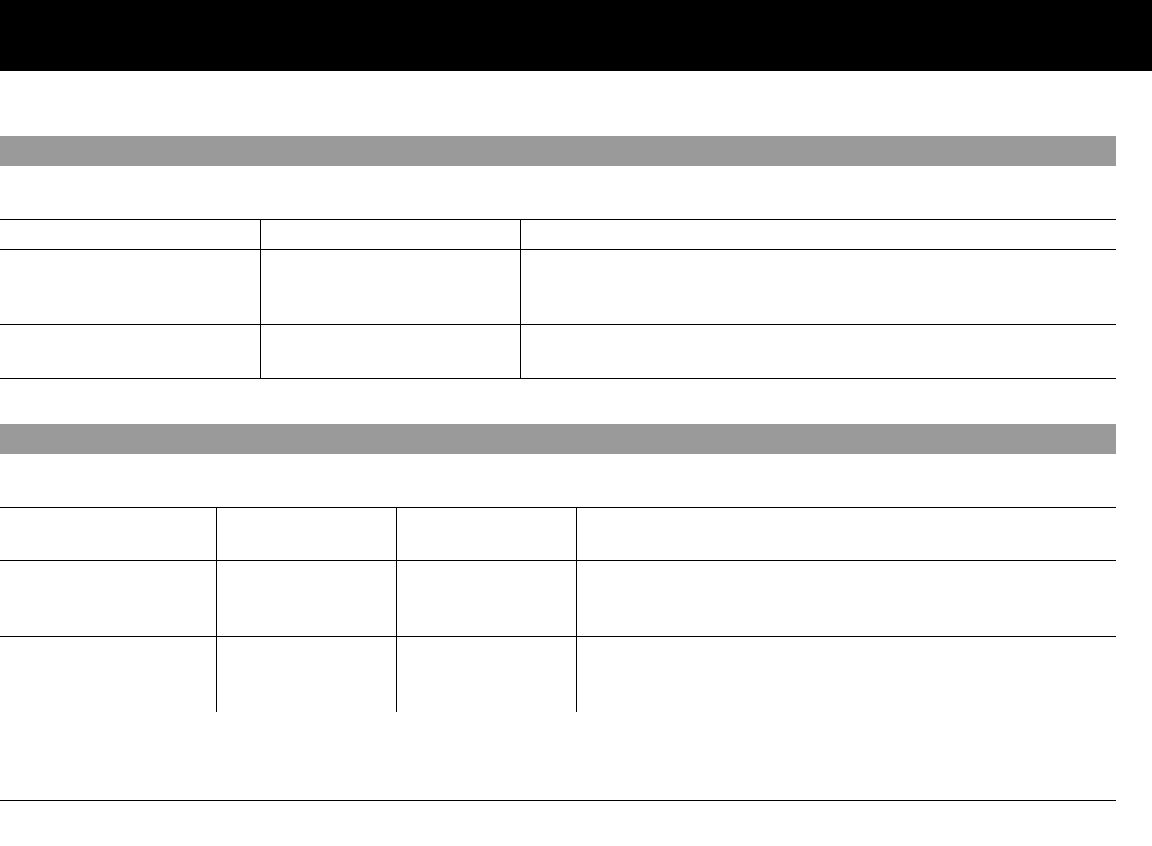
Appendices
153
Electromagnetic Emissions
This equipment is intended for use in the electromagnetic environment specified below. The user of this equipment should assure
that is used in such an environment.
Emissions Compliance according to Electromagnetic environment
RF Emissions (CISPR 11) Group 2 The OmniPod and the PDM emit low level electromagnetic energy
(RF) in order to communicate. Although unlikely, nearby electronic
equipment may be affected.
CISPR B
Emissions Classification
Class B The OmniPod is suitable for use in all establishments including
domestic establishments.
Electromagnetic Immunity
The OmniPod is intended for use in the electromagnetic environment specified below. You should observe these requirements in
the use of the OmniPod System.
Immunity against
IEC 60601-1-2
test level
Compliance level
(of this device) Electromagnetic environment
ElectroStatic Discharge,
ESD (IEC 61000-4-2)
contact discharge:
± 6 kV
air discharge: ± 8 kV
± 8 kV
± 15 kV
If floors are covered with synthetic material, try to avoid electro-
static discharges.
Power Frequency mag-
netic fields 50/60 Hz
(IEC 61000-4-8)
3 A/m 400 A/m Suitable for most environments. Magnetic field strengths in
excess of 400 A/m would be unlikely except in close proximity
to industrial magnetic devices.
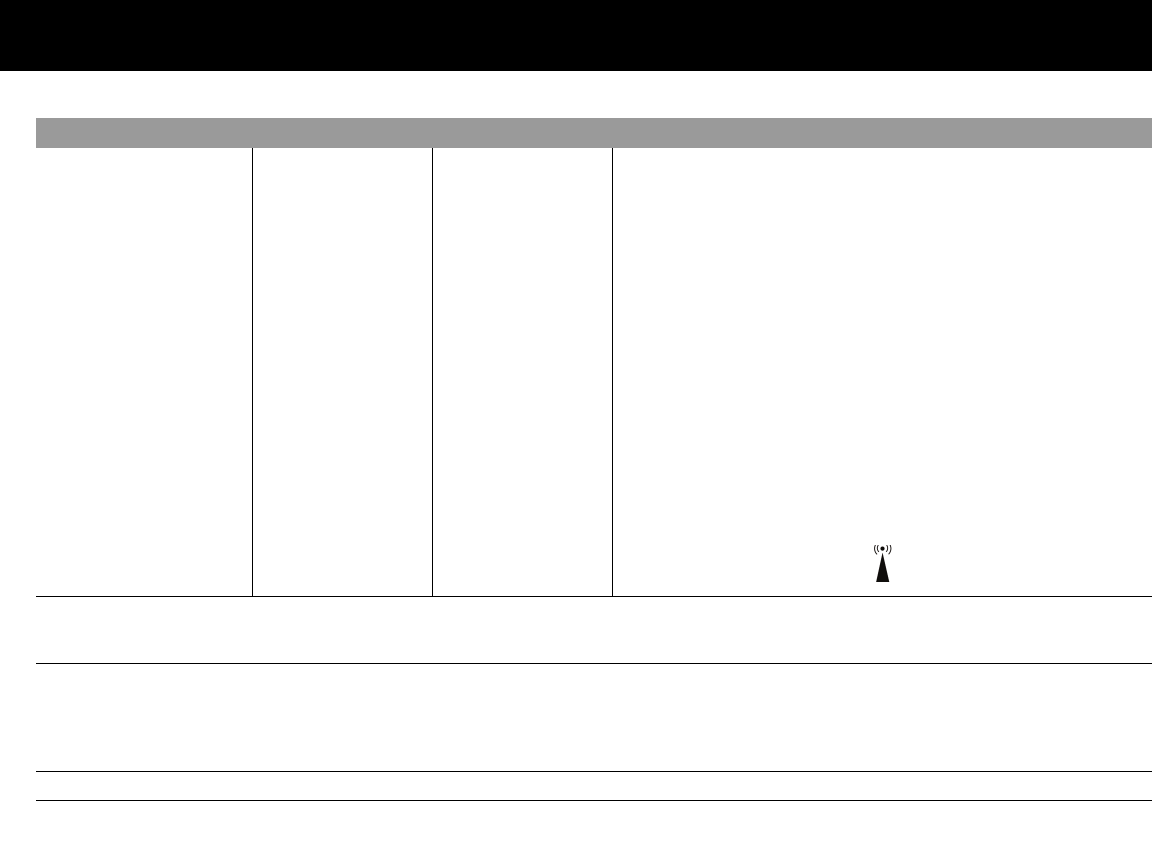
Appendices
154
Conducted RF
(IEC 61000-4-6)
Radiated RF
(IEC 61000-4-3)
3 Vrms
150kHz to 80Mhz
80 MHz–2.5 GHz
3 V/m
10 V/m
Portable and mobile RF communications equipment should
be used no closer to any part of the OmniPod than the recom-
mended separation distance calculated from the equation
applicable to the frequency of the transmitter as below.
Recommended separation distance:
d=1.17 √P
d=0.35/ √P 80 MHz to 800MHz
d=0.7 √P 800 MHz to 2.5 GHz
where P is the maximum output power rating of the transmit-
ter in watts (W) according to the transmitter manufacturer and
d is the recommended separation distance in meters (m).
Field strengths from fixed RF transmitters, as determined by an
electromagnetic site survey,a should be less than the compli-
ance level in each frequency range.
Interference may occur in the vicinity of equipment marked
with the following symbol:
Note 1: At 80 MHz and 800 MHz, the higher frequency range applies.
Note 2: These guidelines may not apply in all situations. Electromagnetic propagation is affected by absorption and reflections from structures,
objects, and people.
aField strengths from fixed transmitters, such as base stations for radio (cellular/cordless) telephones and land mobile radios, amateur radio, AM
and FM radio broadcast, and TV broadcast, cannot be predicted theoretically with accuracy. To assess the electromagnetic environment due to
fixed RF transmitters, an electromagnetic site survey should be considered. If the measured field strength in the location in which the equipment
is used exceeds the applicable RF compliance level above, the equipment should be observed to verify normal operation. If abnormal perfor-
mance is observed, additional measures may be necessary, such as reorienting or relocating the equipment.
Electromagnetic Immunity (Continued)
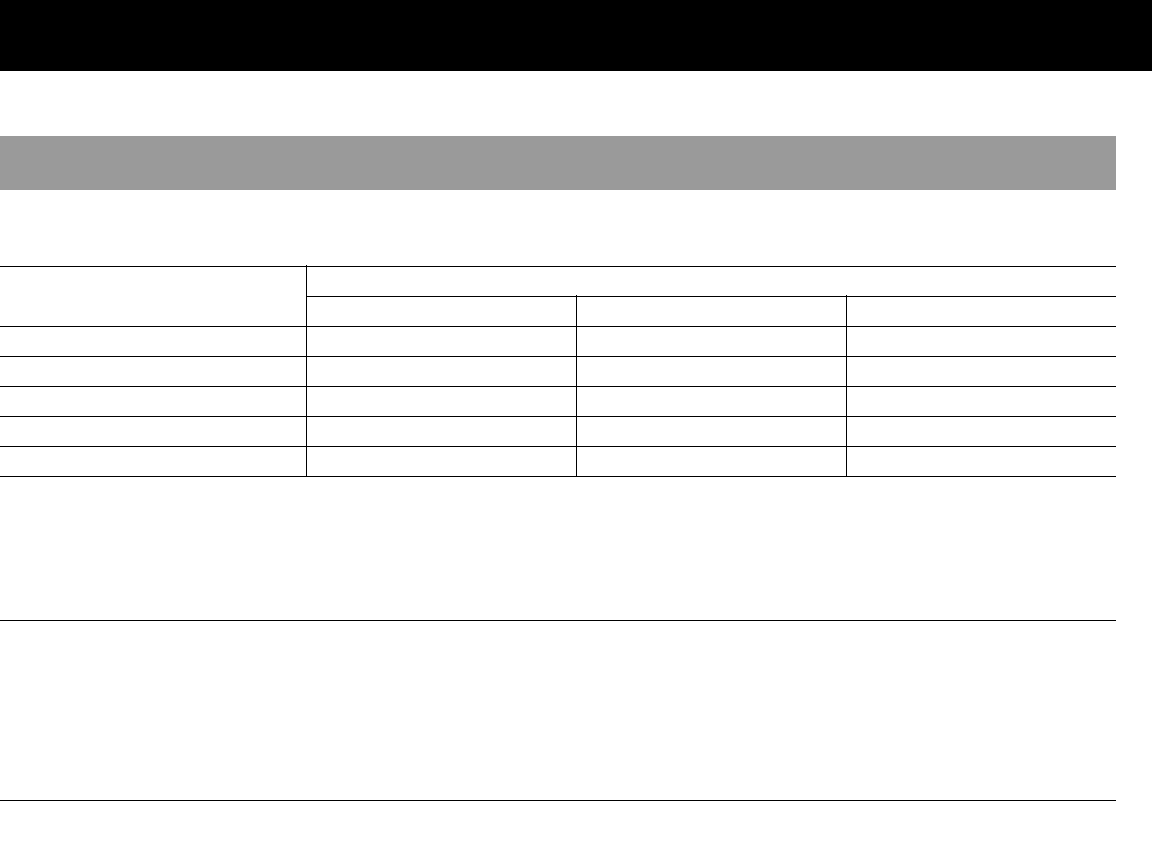
Appendices
155
Recommended separation distances between portable and mobile RF communications equipment
and the OmniPod System
You can help prevent electromagnetic interference by maintaining a minimum distance between portable and mobile RF communi-
cations equipment (transmitters) and the OmniPod system, as recommended below, according to the maximum output power of
the communications equipment.
Rated maximum output power
of transmitter, in watts
Separation distance according to frequency of transmitter, in meters
150 kHz to 80 MHz, d = 1.17
√
P 80 MHz to 800MHz, d = 0.35
√
P 800 MHz to 2.5 GHz, d = 0.7
√
P
0.01 0.12 0.035 0.070
0.1 0.37 0.11 0.22
1 1.17 0.35 0.7
10 3.70 1.11 2.21
100 11.7 3.5 7.0
For transmitters rated at a maximum output power not listed above, the recommended separation distances in meters (m) can be estimated
using the equation applicable to the frequency of the transmitter, where P is the maximum output power rating of the transmitter in watts (W)
according to the transmitter manufacturer.
NOTE 1: At 80 MHz and 800 MHz, the separation distance for the higher frequency range applies.
NOTE 2: These guidelines may not apply in all situations. Electromagnetic propagation is affected by absorption and reflection from structures,
objects, and people.

Appendices
156
■ Customer Bill of Rights
Mission Statement
Insulet Corporation is dedicated to designing, developing, and
distributing products that provide superior treatment options
and lifelong health benefits for people with diabetes.
Scope of Services
Insulet Corporation’s scope of services is limited to providing the
OmniPod Insulin Management System. The System consists of
the handheld, wireless Personal Diabetes Manager (PDM), which
programs the OmniPod with insulin delivery instructions, and
the compact, lightweight OmniPod, which is worn discreetly
beneath clothing and delivers insulin based on instructions from
the PDM. The PDM contains a fully integrated blood glucose
meter and is very similar in materials, construction, and appear-
ance to a personal digital assistant. The OmniPod features no
tubing and virtually pain-free automated cannula insertion.
Compliance
The OmniPod Insulin Management System is manufactured and
distributed by Insulet Corporation. The company is committed
to complying with all federal and state regulations. If you have
any questions or concerns regarding any of our activities, please
contact us at 1-800-591-3455 (from outside the United States,
781-457-5098).
Supply Shipment
Insulet Corporation contacts customers to schedule quarterly
supply shipments approximately two weeks prior to delivery.
Inquiries
Representatives are available to answer product-related inquiries
24 hours per day at our toll free number, 1-800-591-3455 (from
outside the United States, 781-457-5098). For all other questions,
concerns, or complaints, please contact us between the hours of
8:30am and 6:00pm Eastern Time, Monday through Friday, at 1-
800-591-3455 (from outside the United States, 781-457-5098).
We will respond immediately whenever possible; some issues
may take up to 14 days to resolve.
Customer’s Bill of Rights and Responsibilities
You have the right to:
1. Receive considerate and respectful service.
2. Receive service without regard to race, creed, national origin,
sex, age, disability, sexual orientation, illness, or religious affili-
ation.
3. Expect confidentiality of all information pertaining to you,
your medical care and service. Please review our HIPAA Pri-
vacy Notice later in this section.
4. Receive a timely response to your request for service.
5. Receive continued service.

Appendices
157
6. Select the medical equipment supplier of your choice.
7. Make informed decisions regarding your care planning.
8. Understand what services will be provided to you.
9. Obtain an explanation of charges, including policy for pay-
ment.
10. Agree to or refuse any part of the plan of service or plan of
care.
11. Voice complaints without fear of termination of service or
other reprisals.
12. Have your communication needs met.
You have the responsibility to:
1. Ask questions about any part of the plan of service or plan of
care that you do not understand.
2. Use the equipment for the purpose for which it was pre-
scribed, following instructions provided for use, handling
care, safety and cleaning.
3. Supply Insulet Corporation with insurance information nec-
essary to obtain payment for services.
4. Be accountable for charges not covered by your insurance.
You are responsible for settlement in full of your account.
5. Notify us immediately of:
a. Equipment failure, damage or need of supplies.
b. Any change in your prescription or physician.
c. Any change or loss in insurance coverage.
d. Any change of address or telephone number, whether
permanent or temporary.

Appendices
158
■ Limited Warranty for the Personal Diabetes
Manager
Limited Warranty Coverage
Insulet Corporation warrants to the original purchaser (“you”) that the Per-
sonal Diabetes Manager (the “PDM”) will be free from defects in materials
and workmanship, under normal use and conditions, for a period of four (4)
years from the date of purchase. If Insulet Corporation determines that the
PDM is defective during the warranty period, Insulet Corporation will either
repair or replace, at its option, the PDM at no charge to you, subject to the
conditions and exclusions stated herein. This Warranty applies only to new
devices and, in the event the PDM is repaired or replaced, the warranty
period shall not be extended.
Warranty Claim Procedure
You must notify Insulet Corporation of the claimed defect within the war-
ranty period by writing or calling: Insulet Corporation, 9 Oak Park Drive,
Bedford, Massachusetts 01730; Telephone: 800-591-3455 (from outside the
United States: 781-457-5098) and Fax: 877-467-8538. The claim must
include the date of purchase, model number, serial number, and a descrip-
tion of the claimed defect. Insulet Corporation's authorization must be
obtained prior to returning the PDM. If authorized, the PDM must be prop-
erly packaged and returned to Insulet Corporation. Insulet Corporation will
pay all freight and transportation charges, where applicable, incurred in
shipping a PDM to be repaired or replaced under this Warranty.
Conditions
Proof of Purchase in the form of a bill of sale or receipted invoice showing
that the PDM is within the warranty period must be presented to obtain
warranty service.
Exclusions
This Warranty covers only the original purchaser and cannot be transferred
with sale, rental or other transfer of the PDM to any other person or entity.
THIS WARRANTY DOES NOT APPLY IF THE PDM HAS BEEN:
• changed or modified by any person or entity other than Insulet
Corporation;
• serviced or repaired by any person or entity other than Insulet
Corporation;
• damaged by an act of God, misuse, abuse, negligence, accident, wear
and tear, unreasonable use, or by other causes unrelated to defective
materials or workmanship.
Miscellaneous
REPAIR OR REPLACEMENT AS PROVIDED UNDER THIS WARRANTY IS YOUR
EXCLUSIVE REMEDY. ANY APPLICABLE IMPLIED WARRANTIES, INCLUDING
WARRANTIES OF MERCHANTABILITY AND FITNESS FOR A PARTICULAR
PURPOSE, ARE LIMITED IN DURATION TO THE DURATION OF THIS WAR-
RANTY. IN NO EVENT SHALL INSULET CORPORATION, ITS SUPPLIERS, OR ITS
DISTRIBUTORS BE LIABLE FOR CONSEQUENTIAL OR INCIDENTAL DAM-
AGES FOR BREACH OF ANY EXPRESS OR IMPLIED WARRANTY ON THE
PDM. Some states do not allow limitation on how long an implied warranty
lasts, and some states do not allow the exclusion or limitation of conse-
quential or incidental damages, so the above limitations or exclusions may
not apply to you.
This Warranty gives you specific legal rights, and you may also have other
rights which vary from state to state. This Warranty is valid only in the
United States.
No Other Warranty
Unless modified in writing and signed by both parties, this Warranty is
understood to be the complete and exclusive agreement between the par-
ties, superseding all prior agreements, oral or written, and all other
communications between the parties relating to the subject matter of this
agreement. No employee of Insulet Corporation or any other party is
authorized to make any warranty in addition to those made in this
Warranty.

Appendices
159
■ HIPAA Privacy Notice
THIS NOTICE DESCRIBES HOW MEDICAL INFORMATION IS USED
AND DISCLOSED AND HOW YOU CAN GET ACCESS TO IT. PLEASE
REVIEW IT CAREFULLY.
This notice of privacy practices (the “HIPAA Privacy Notice”)
describes how we may use and disclose your Medical
Information to carry out treatment, payment, or health care
operations and for other purposes that are permitted or required
by law, including by the Health Insurance Portability and
Accountability Act (“HIPAA”) and all regulations issued
thereunder. It also describes your rights to access and control
your Medical Information. As used herein, “Medical Information”
is information about you, including demographic information,
that may identify you and that relates to your past, present, or
future physical or mental health or condition and related health
care services.
Uses and Disclosures of Medical Information
We will only use and disclose your Medical Information as
permitted by law. Except for disclosures outlined in this HIPAA
Privacy Notice and/or permitted by law, we will obtain your
written authorization before using your Medical Information or
disclosing it to any outside persons or organizations. You may
revoke any written authorization you have provided to us at any
time, except to the extent that we have made any uses or
disclosures of your Medical Information in reliance on such
authorization. To revoke a previously issued authorization, please
send your request in writing, along with a copy of the
authorization being revoked, to our Privacy Officer. If a copy of
the applicable authorization is not available, please provide a
detailed description and date of the same to our Privacy Officer.
There are some situations in which we may use or disclose your
Medical Information without your prior written authorization, as
described further below.
Uses and Disclosures of Your Medical Information Related
to the Treatment and Services Provided by Us
Treatment, Payment, and Health Care Operations: We may use
your Medical Information for treatment, to obtain payment for
treatment, for administrative purposes, and to evaluate the
quality of care that you receive without your authorization. We
may use or disclose Medical Information about you without your
authorization for several other reasons.
Example of Treatment: In connection with treatment, we may
use your Medical Information to provide you with one of our
medical devices.
Example of Payment: We may use your Medical Information to
generate a health insurance claim and to collect payment on
invoices for services and/or medical devices provided.
Example of Health Care Operations: We may use your Medical
Information in order to process and fulfill your orders and to
provide you with customer service.

Appendices
160
Appointment Reminder and Other Communications: We may
use or disclose your Medical Information without your prior
written authorization to provide you or others with, among
other things: (i) appointment reminders; (ii) product/supply
reorder notifications; and/or (iii) information about treatment
alternatives or other health-related products and services that
we provide.
Family, Friends, and Emergencies: If you require emergency
treatment and we are unable to obtain your consent, we may
disclose your Medical Information to a family member or relative
who is involved in your care.
Marketing: We may use or disclose your Medical Information to
provide you with marketing communications about the health-
related products and services that we provide, and about
products, services, treatment, or healthcare providers that may
be of interest to you.
Additional Categories of Uses and Disclosures
Required by Law: We may use or disclose your Medical
Information to the extent that applicable law requires the use or
disclosure of such Medical Information. Where the use and/or
disclosure of Medical Information is by law, the use or disclosure
will be made in compliance with the law and will be limited to
the relevant requirements of the law. You will be notified, as
required by law, of any such uses or disclosures.
Public Health: We may disclose your Medical Information for
public health activities and purposes to a public health authority
that is permitted by law to collect or receive the information.
The disclosure will be made for the purpose of controlling
disease, injury, or disability. We may also disclose your Medical
Information, if directed by the public health authority, to a
foreign government agency that is collaborating with the public
health authority.
Communicable Diseases: We may disclose your Medical
Information, if authorized by law, to a person who may have
been exposed to a communicable disease or may otherwise be
at risk of contracting or spreading the disease or condition.
Health Oversight: We may disclose Medical Information to a
health oversight agency for activities authorized by law, such as
audits, investigations, and inspections. Oversight agencies
seeking this information include government agencies that
oversee the healthcare system, government benefit programs,
other government regulatory programs, and civil rights laws.
Food and Drug Administration: We may disclose your Medical
Information to a person or company as directed or required by
the Food and Drug Administration: (i) to report adverse events
(or similar activities with respect to food or dietary supplements),
product defects or problems (including problems with the use or
labeling of a product), or biological product deviations; (ii) to
track FDA-regulated products; (iii) to enable product recalls,
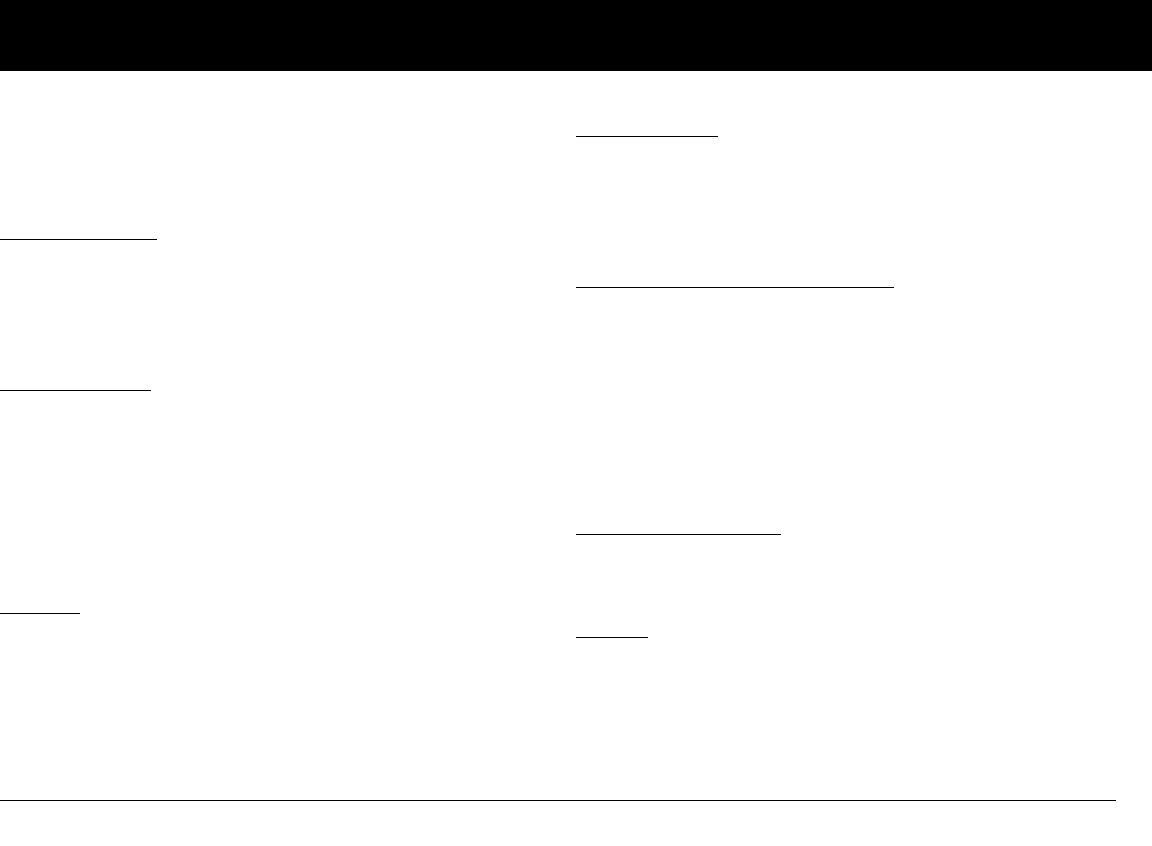
Appendices
161
repairs, or replacement, or lookback (including locating and noti-
fying individuals who have received products that have been
recalled, withdrawn, or are the subject of lookback); or (iv) to con-
duct post-marketing surveillance.
Legal Proceedings: We may disclose your Medical Information in
the course of any judicial or administrative proceeding, in
response to an order of a court or administrative tribunal (to the
extent such disclosure is expressly authorized), in certain
conditions in response to a subpoena, discovery request, or
other lawful process.
Law Enforcement: We may disclose Medical Information, as long
as applicable legal requirements are met, for law enforcement
purposes. These law enforcement purposes include: (i) legal
processes otherwise required by law; (ii) limited information
requests for identification and location purposes; (iii) pertaining
to victims of a crime; (iv) suspicion that death has occurred as a
result of criminal conduct; (v) in the event that a crime occurs on
the premises of the practice; and (vi) medical emergency in
which it is likely that a crime has occurred.
Research: We may disclose your Medical Information to
researchers when their research has been approved by an
institutional review board that has reviewed the research
proposal and established protocols to ensure the privacy of your
Medical Information.
Criminal Activity: Consistent with applicable federal and state
laws, we may disclose your Medical Information if we believe the
use or disclosure is necessary to prevent or lessen a serious and
imminent threat to the health or safety of a person or the public.
We may also disclose Medical Information if it is necessary for law
enforcement authorities to identify or apprehend an individual.
Military Activity and National Security: When the appropriate
conditions apply, we may use or disclose Medical Information of
individuals who are Armed Forces personnel: (i) for activities
deemed necessary by appropriate military command
authorities; (ii) for the purpose of a determination by the
Department of Veterans Affairs of your eligibility for benefits; or
(iii) to foreign military authority if you are a member of that
foreign military service. We may also disclose your Medical
Information to authorized federal officials for conducting
national security and intelligence activities.
Workers’ Compensation: We may disclose your Medical
Information as authorized to comply with workers'
compensation laws and other similar, legally established
programs.
Inmates: We may use or disclose your Medical Information if you
are an inmate of a correctional facility and your physician created
or received your Medical Information in the course of providing
care to you.

Appendices
162
Required Uses and Disclosures: Under the law, we must make
disclosures to you when required by the Secretary of the
Department of Health and Human Services to investigate or
determine our compliance with the requirements of HIPAA.
Nonidentifiable Information: We may use or disclose your
Medical Information if we have removed from it any information
that is personally identifiable to you.
You r R igh ts
The following is a statement of your rights with respect to your
Medical Information and a brief description of how you may
exercise these rights.
You Have the Right to Inspect and Copy Your Medical
Information: This means you may inspect and obtain a copy of
Medical Information about you, provided, however, that
applicable law may limit your ability to inspect or copy certain
types of records. In certain circumstances, if we deny your
request to review Medical Information, you may have a right to
have this decision reviewed. If you would like to make a request
to review your Medical Information, please download our
Request Form at
http://www.myomniPod.com/images/upload/
HIPAA_Privacy_Notice_Request_Form.pdf
and follow the directions included on that form.
We will respond to your request in a reasonable amount of time.
If your request is honored, we may charge a nominal fee for
photocopying expenses. Please contact our Privacy Officer if you
have questions about access to your Medical Information.
You May Have the Right to Amend Your Medical Information:
If you believe that the Medical Information we have about you is
incorrect or incomplete, you may ask us to make an amendment
to your Medical Information. You may request an amendment as
long as the Medical Information is still maintained in our records.
If you would like to make a request to review your Medical
Information, please download our Request Form at
http://www.myomniPod.com/images/upload/
HIPAA_Privacy_Notice_Request_Form.pdf
and follow the directions included on that form.
We will respond to your request in a reasonable amount of time.
Please contact our Privacy Officer if you have questions about
requesting an amendment to your Medical Information
You Have the Right to Request a Restriction of Your Medical
Information: You may ask us not to use or disclose any part of
your Medical Information for the purposes of treatment,
payment, or healthcare operations. You may also request that
any part of your Medical Information not be disclosed to family
members or friends who may be involved in your care or for
notification purposes as described in this HIPAA Privacy Notice.

Appendices
163
Your request must state the specific restriction requested and to
whom you want the restriction to apply. We are not required to
agree to a restriction that you may request, but if we do agree to
the requested restriction, we may not use or disclose your Medi-
cal Information in violation of that restriction unless it is needed
to provide emergency treatment. If you would like to request a
restriction of the use of your Medical Information, please down-
load our Request Form at
http://www.myomniPod.com/images/upload/
HIPAA_Privacy_Notice_Request_Form.pdf
and follow the directions included on that form.
We will respond to your request in a reasonable amount of time.
Please contact our Privacy Officer if you have questions about
requesting a restriction of the use of your Medical Information.
You Have the Right to Request to Receive Confidential
Communications from Us by Alternative Means or at an
Alternative Location: We will accommodate reasonable requests
to receive confidential communications from us by alternate
means or at an alternative location. We may also limit this
accommodation by asking you for information as to how
payment will be handled or specification of an alternative
address or other method of contact. We will not request an
explanation from you as to the basis for the request. Please make
this request in writing to our Privacy Officer.
You Have the Right to Receive an Accounting of Certain
Disclosures We Have Made, if any, of Your Medical Information:
This right applies to disclosures for purposes other than
treatment, payment, or healthcare operations as described in
this HIPAA Privacy Notice. It excludes disclosures we may have
made to you, for a facility directory, to family members or friends
involved in your care, or for notification purposes. You have the
right to receive specific information regarding these disclosures
that occurred after April 14, 2003, or as otherwise provided for
under applicable law. You may request a shorter time frame. The
right to receive this information is subject to certain exceptions,
restrictions, and limitations. If you would like to request an
accounting of certain disclosure of your Medical Information,
please download our Request Form at
http://www.myomniPod.com/images/upload/
HIPAA_Privacy_Notice_Request_Form.pdf
and follow the directions included on that form.
We will respond to your request in a reasonable amount of time.
Please contact our Privacy Officer if you have questions about
requesting an accounting of the disclosures of your Medical
Information.

Appendices
164
Our Duties
Generally: We are required by law to maintain the privacy and
security of your Medical Information and to provide you with
notice of our privacy practices with respect to Medical
Information.
Revisions and Modifications: We may change our HIPAA Privacy
Notice at any time. Before we make a significant change in our
policies, we will change this HIPAA Privacy Notice and post our
new notice (the “Revised HIPAA Privacy Notice”). We are required
to abide by the terms of this HIPAA Privacy Notice until a Revised
HIPAA Privacy Notice becomes effective. The Revised HIPAA
Privacy Notice will be effective for all Medical Information that
we maintain as of the effective date of the Revised HIPAA Privacy
Notice even if we collected or received the Medical Information
prior to the effective date of the Revised HIPAA
Privacy Notice. The current HIPAA Privacy Notice is posted on our
Web sites at:
Insulet.com
MyOmniPod.com
You can also request a hard copy of the HIPAA Privacy Notice at
any time by contacting our Privacy Officer.
What To Do If You Have a Problem or Question
If you have any questions relating to this HIPAA Privacy Notice or
if you have a problem or complaint, please contact us by writing
to:
Insulet Corporation
Attn: Privacy Officer
9 Oak Park Drive
Bedford, MA 01730
or by e-mailing us at privacy@insulet.com.
Furthermore, if you believe that Insulet has violated your privacy
rights with respect to your Medical Information, you have the
right to file a complaint in writing with our Privacy Officer or with
the Secretary of Health and Human Services at 200 Independence
Avenue, S.W. Washington, D.C. 20201, or by calling 202-619-0257.
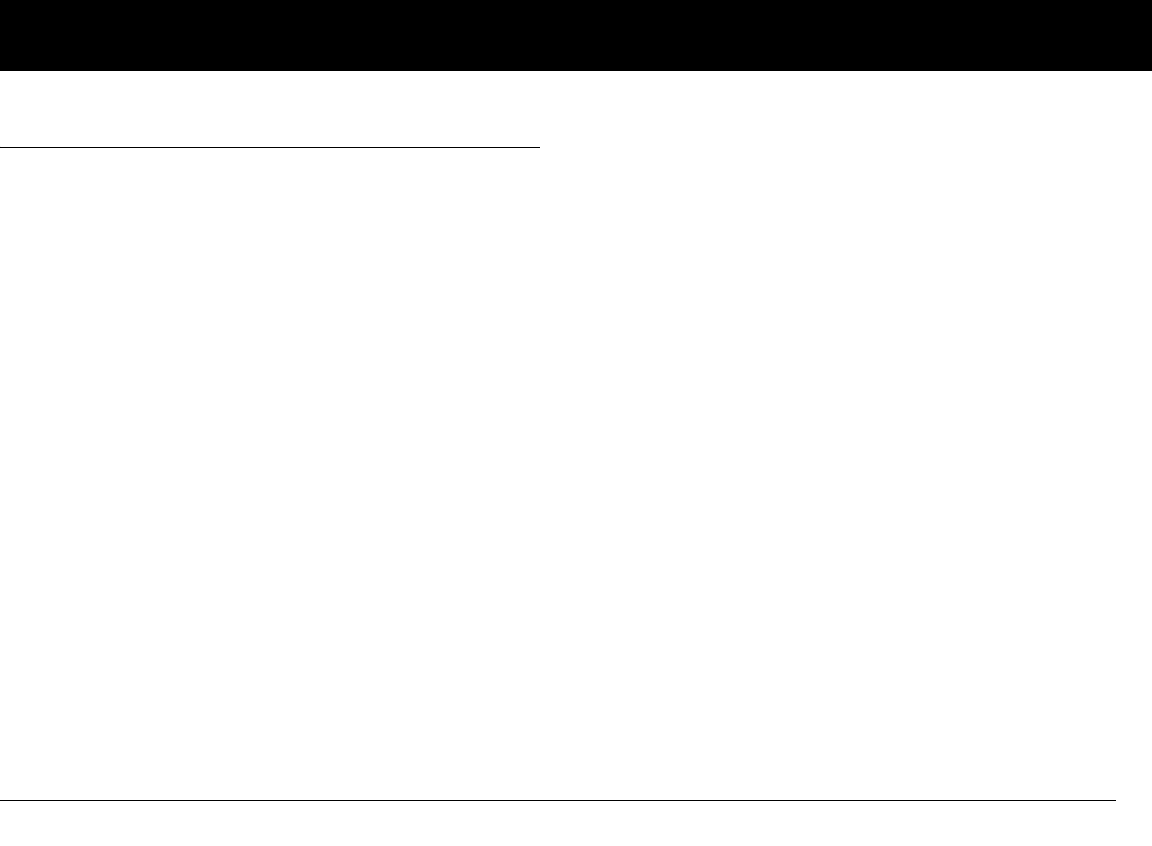
Appendices
165
■ Helpful Resources
American Diabetes Association
1660 Duke Street • Alexandria, VA 22314
800-342-2383
www.diabetes.org
International Association for Medical Assistance to Travelers
List of doctors in foreign countries who speak English and who
received post-graduate education in the US or Great Britain
417 Center Street • Lewiston, NY 14092
716-754-4883
Juvenile Diabetes Research Foundation International
120 Wall Street • New York, NY 10005-4001
800-533-2873
www.jdf.org
Medic Alert Foundation
To order medical ID necklaces and bracelets
PO Box 1009 • Turlock, CA 95381-1009
800-432-5378
www.medicalert.org
National Institute of Diabetes & Digestive & Kidney Disease
(NIDDK)
National Institutes of Health
Building 31, Center Drive, MSC 2560 • Bethesda, MD 20892-2560
www.niddk.nih.gov/health/diabetes/diabetes.htm

166
Glossary
A1c (see Hemoglobin A1c)
Advisory alarm
Notification by the PDM that a serious condition exists.
Aseptic technique
A method for maintaining sterilization and preventing
contamination.
Basal program
One or more basal rates that together cover a 24-hour period
from midnight to midnight.
Basal rate
A small base or background amount of insulin that is delivered, at
a preset rate, continuously for a specified period of time. Basal
rates are measured in units per hour (U/hr).
Basal segment (time segment)
The time period during which a specific basal rate is delivered.
BG goal
A range of blood glucose levels that you are trying to achieve dur-
ing a certain period of the day. For example, you may want one
BG goal before meals, a different BG goal two hours after meals,
and yet another BG goal for bedtime.
Blood glucose (see glucose)
Blood glucose level
The amount of glucose, or sugar, in the blood. In the United
States, blood glucose levels are measured in milligrams per
deciliter (mg/dL).
Blood glucose meter
A device used to check blood glucose content. Typically the
blood glucose results are displayed in mg/dL.
Bolus dose
A dose of insulin taken to correct an elevated blood glucose level
or to cover carbohydrates in a meal or snack.

Glossary
167
Bolus preset
A bolus dose of insulin, in units, that can be assigned a custom
name and preprogrammed into the PDM.
Calorie
A unit of measurement used to express the energy value of food.
Calories come from carbohydrate, protein, fat, and alcohol.
Cannula
A small, thin tube inserted below the skin, which serves to intro-
duce a liquid medication into the body.
Carbohydrate (carb)
One of the three main nutrients found in food. (The other two
are protein and fat.) Foods that contain carbohydrates include
starches, sugars, vegetables, fruits, and dairy products.
Carbohydrate counting
A method of meal planning based on counting the number of
grams of carbohydrate in a given food.
Carb preset
A favorite food item, snack, or entire meal that can be assigned a
custom name and preprogrammed into the PDM. You set the
carbohydrate value (and, optionally, the fat, protein, fiber, and
total calories) for each carb preset.
Complications (of diabetes)
Harmful effects of diabetes such as damage to the eyes, kidney,
heart, blood vessels, nervous system, teeth and gums, feet, and
skin.
Correction bolus
An amount of insulin taken to compensate for high blood glucose
levels. The OmniPod System calculates the correction bolus by
taking the difference between your current blood glucose level
and your target blood glucose value, then dividing the result by
your correction factor.
Correction factor (also known as sensitivity factor)
A value that indicates how much one unit of insulin will lower
your blood glucose. For example, if your correction factor is 50,
one unit of insulin will lower your blood glucose by 50mg/dL.
Correction threshold
The blood glucose level above which you would like to take insu-
lin to reduce an elevated blood glucose.
CSII (continuous subcutaneous insulin infusion)
Delivering insulin continuously under the skin (“subcutaneously”)
on a programmed schedule.
Dawn phenomenon
An early morning rise in blood glucose level caused by the normal
release of hormones that block insulin’s effect.

Glossary
168
Diabetes Control and Complications Trial (DCCT)
A study by the National Institute of Diabetes and Digestive and
Kidney Diseases (NIDDK), conducted from 1983 to 1993 in
people with type 1 diabetes, which showed that good blood
glucose control significantly helped prevent or delay diabetes
complications.
Diabetes, diabetes mellitus
A condition characterized by hyperglycemia (high blood glucose)
resulting from the body’s inability to use blood glucose for energy.
In type 1 diabetes, the pancreas no longer makes insulin and
therefore blood glucose cannot enter the cells to be used for
energy. In type 2 diabetes, either the pancreas does not make
enough insulin or the body is unable to use insulin correctly.
Diabetic ketoacidosis (see Ketoacidosis)
Duration of insulin action
The length of time that certain types of insulin remain active and
available in your body after a bolus. This duration can vary greatly
depending on the type of insulin you take. Only use rapid-acting
insulin with the OmniPod Insulin Management System.
Extended bolus
A feature of the OmniPod System that allows a meal bolus dose to
be given over an extended period of time.
Fat
One of the three main energy sources in food (the other two are
carbohydrate and protein). Fat is a concentrated source of energy,
providing 9 calories per gram. Foods high in fat include oils, mar-
garine, salad dressings, red meat, and whole-milk dairy foods.
Fiber
The indigestible part of plant foods. Foods that are high in fiber
include broccoli, beans, raspberries, squash, whole grain bread,
and bran cereal. Fiber is a type of carbohydrate but does not raise
blood glucose levels as other carbohydrates do.
Glucose
A simple sugar (also known as dextrose) used by the body for
energy. Without insulin, the body cannot use glucose for energy.
Hazard alarm
Notification by the PDM that a dangerous condition exists.
Healthcare provider
A professional who practices medicine or teaches people how to
manage their health. All healthcare providers are a resource for
valuable diabetes management information.

Glossary
169
Hemoglobin A1c (HbA1c)
A test that measures a person’s average blood glucose level over
the past 2 to 3 months. Also called glycosylated hemoglobin, the
test shows the amount of glucose that sticks to the red blood cell,
which is proportional to the amount of glucose in the blood.
Hyperglycemia (high blood glucose)
A higher-than-normal level of glucose in the blood; generally
180mg/dL or higher.
Hypoglycemia (low blood glucose)
A lower-than-normal level of glucose in the blood; generally
70mg/dL or lower.
Hypoglycemia unawareness
A condition in which a person does not feel or recognize the
symptoms of hypoglycemia.
Infusing
Introducing a liquid substance under the skin into the body.
Infusion site
Place on the body where an infusion set or Pod is placed and
cannula is inserted.
Insulin
A hormone that helps the body use glucose for energy. The beta
cells of a healthy pancreas make insulin.
Insulin on board (active insulin)
The amount of insulin that is still “active” in the body from a previ-
ous bolus dose. In the OmniPod System, insulin on board (IOB) is
considered in two parts: the IOB from a previous correction bolus
and the IOB from a previous meal bolus.
The amount of time insulin remains “on board” or “active”
depends on each individual’s duration of insulin action. Talk with
your healthcare provider to determine your duration of insulin
action.
The OmniPod System continually calculates the IOB to help pre-
vent “stacking” of correction bolus doses, which is a major cause
of hypoglycemia.
Insulin reaction (see hypoglycemia)
Insulin-to-carbohydrate ratio
Number of grams of carbohydrate covered by one unit of insulin.
For example, if your insulin-to-carbohydrate ratio is 1:15, then
you need to deliver one unit of insulin to cover every fifteen
grams of carbohydrate you eat.
In vitro
Literally, “in glass.” Refers to a biological function taking place in a
laboratory dish rather than in a living organism.
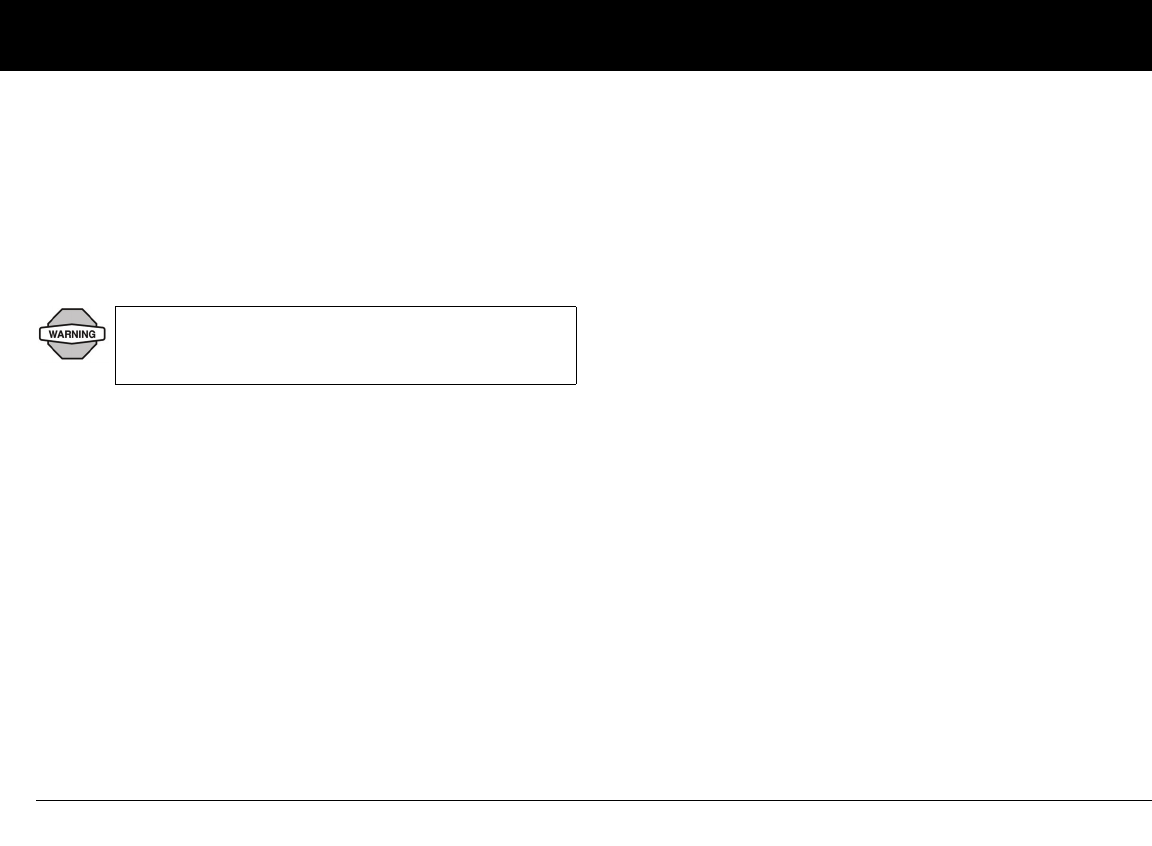
Glossary
170
Ketoacidosis (diabetic ketoacidosis or DKA)
A very serious condition in which extremely high blood glucose
levels and a severe lack of insulin cause the body to break down
fat for energy. The breakdown of fat releases ketones into the
blood and urine. DKA can take hours or days to develop, with
symptoms that include stomach pain, nausea, vomiting, fruity
breath odor, and rapid breathing.
Ketones
Acidic by-products that result from the breakdown of fat for
energy. The presence of ketones indicates that the body is using
stored fat and muscle (instead of glucose) for energy.
Meal bolus (also known as carbohydrate bolus)
An amount of insulin administered before a meal or snack to
ensure that blood glucose levels stay within the desired BG goal
after a meal. The OmniPod System calculates a meal bolus by
dividing the grams of carbohydrates you are about to eat by your
insulin-to-carbohydrate ratio.
Multiple daily injections (MDIs)
Introducing insulin into the body with a syringe several times a
day.
Occlusion
A blockage or interruption in insulin delivery.
Prime bolus
An amount of insulin used to fill the cannula, preparing it to
begin delivering insulin under your skin.
Protein
One of the three main energy sources in food (the other two are
carbohydrate and fat). Protein is necessary for the growth, main-
tenance, and repair of body cells and tissues. Protein contains 4
calories per gram. Foods high in protein include meat, poultry,
fish, legumes, and dairy products.
Reverse correction (negative correction)
Using an individual’s correction factor (sensitivity factor), the
reverse correction is a calculation that reduces a portion of a
meal bolus dose when the patient’s blood glucose level is below
their blood glucose target. This feature is an option in the
OmniPod Insulin Management System, which should be turned
on or off according to the advice of a healthcare provider.
Sensitivity factor (see correction factor)
It is important to rule out ketoacidosis when you
experience symptoms that might otherwise indicate
the flu.

Glossary
171
Sharps
Any medical item that may cause punctures or cuts to those
handling them. Sharps include needles, syringes, scalpel blades,
disposable razors, and broken medical glassware. Dispose of
used sharps according to local waste disposal regulations.
Sharps container
A puncture-proof container used for storage and disposal of
used sharps.
Soft key
A button on the PDM whose label or function appears on the
screen directly above the button. The label changes depending
on the task you are performing.
Subcutaneous
Under the skin.
Suggested bolus calculator
A feature that calculates bolus doses with user-specific settings
and inputs. The settings used to calculate a suggested bolus are
target BG, insulin-to-carbohydrate (IC) ratio, correction factor (CF),
and duration of insulin action. The inputs used to calculate a sug-
gested bolus are current BG, carbs entered, and insulin on board.
The bolus calculator can be turned Off or On in the PDM.
Target blood glucose level
The ideal number at which you would like your blood glucose
level to be. The OmniPod System uses this number in calculating
bolus doses.
Temp basal
A basal rate that is used to cover predictable, short-term changes
in basal insulin need. Temporary rates are often used during exer-
cise and for sick-day insulin adjustments.
Temporary basal preset
An adjustment in a basal rate, in either % or U/hr, that can be
assigned a custom name and preprogrammed into the PDM.
Time segment (see basal segment)

172
Index
A
activate a new OmniPod . . . . . . . . . . 44–58
active insulin . . . . . . . . . See insulin on board
add
basal segment or rate. . . . . . . . . . 18–22
bolus reminder . . . . . . . . . . . . . . . . . . . . 69
custom alerts . . . . . . . . . . . . . . . . . . . . . . 69
user information . . . . . . . . . . . . . . . . . .106
adhesive. . . . . . . . . . . . . . . . . . . . . . . . . . . . .4, 52
remover. . . . . . . . . . . . . . . . . . . . . . . . . . . . 46
advisory alarms. . . . . . . . . . . . .126–127, 166
airport security . . . . . . . . . . . . . . . . . . . . . . .111
alarms . . . . . . . . . . . . . . . . . . . . . . . . 8, 126–131
acknowledge . . . . . . . . . . . . . . . . . . . . .130
advisory. . . . . . . . . . . . . . . . . . . . . 126–127
hazard . . . . . . . . . . . . . . . . . . . . . . 128–131
history records. . . . . . . . . . .99, 102–105
alert escalation . . . . . . . . . . . . . . . . . . . . . . .128
alerts and reminders . . . . . . . . . . . . 8, 67–70
auto-off. . . . . . . . . . . . . . . . . . . . . . . . . . . . 67
BG reminder . . . . . . . . . . . . . . . . . . . . . . . 67
confidence alerts . . . . . . . . . . . . . . . . . . 68
custom alerts . . . . . . . . . . . . . . . . . . . . . . 68
low reservoir. . . . . . . . . . . . . . . . . . . .15, 67
missed bolus . . . . . . . . . . . . . . . . . . . . . . 67
pod expiration. . . . . . . . . . . . . . . . . . . . . 67
American Diabetes Association . . . . . . 165
aseptic technique . . . . . . . . . . . . .44, 57, 166
automated cannula insertion . . . . . . . 2, 53
B
backlight time-out . . . . . . . . . . . . . . . . . . . . 72
set . . . . . . . . . . . . . . . . . . . . . . . . . . . . . . . . . 73
basal
total daily. . . . . . . . . . . . . . . . . . . . . . . . . . 20
basal history . . . . . . . . . . . . . . . . . . . . . . . . . 100
basal program . . . . . . . . . . . . 12, 17–23, 166
add segment or rate. . . . . . . . . . . . . . . 22
copy. . . . . . . . . . . . . . . . . . . . . . . . . . . . . . . 23
create . . . . . . . . . . . . . . . . . . . . . . . . . . . . . 18
delete . . . . . . . . . . . . . . . . . . . . . . . . . . . . . 23
edit segment or rate. . . . . . . . . . . . . . . 22
enable. . . . . . . . . . . . . . . . . . . . . . . . . . . . . 20
rename. . . . . . . . . . . . . . . . . . . . . . . . . . . . 23
basal rate . . . . . . . . . . . . . . .1, 12, 17–28, 166
maximum . . . . . . . . . . . . . . . . . . . . . . . . . 28
temporary. . . . . . . . . . . . . . . . . . . . . . . . . 23
basal segment . . . . . . . . . . . . . . . . . . . . .12, 17
basal settings . . . . . . . . . . . . . . . . . . . . . . . . . 12
batteries . . . . . . . . . . . . . . . . . . . . . . 10, 99, 140
BG tag . . . . . . . . . . . . . . . . . . .See tag a BG result
blood glucose
BG goal. . . . . . . . . . . . . . . . . . . . 12, 70, 166

Index
173
BG reminder. . . . . . . . . . . . . . . . . . . . . . . 67
checking . . . . . . . . . . . . . . . . . . . . x, 77–98
code. . . . . . . . . . . . . . . . . . . . . . . . . . . .81, 88
history. . . . . . . . . . . . . . . . . . . . . . . . . . . . 102
level . . . . . . . . . . . . . . . . . . . . . . . . . . .29, 166
limit goal . . . . . . . . . . . . . . . . . . . . . . . . . . 70
monitoring . . . . . . . . . . . . . . . . . . . . . . . xi, 2
sound . . . . . . . . . . . . . . . . . . . . . . . . . .12, 70
test sites. . . . . . . . . . . . . . . . . . . . 77, 89–91
test strip. . . . . . . . . . . . . . . . . . . . . . . . . . . 87
blood glucose meter. . . . . . . 2, 77–98, 166
error messages . . . . . . . . . . . . . . 123–125
readings. . . . . . . . . . . . . . . . . . . . . . . . . 3, 92
settings. . . . . . . . . . . . . . . . . . . . . . . . . . . . 70
specifications. . . . . . . . . . . . . . . . . . . . . 149
blood glucose readings
enter manually . . . . . . . . . . . . . . . . . . . . 95
low and high . . . . . . . . . . . . . . . . . . . . . . 97
bolus. . . . . . . . . . . . . . . . . . . . . . . . . . 1, 3, 29–43
cancel . . . . . . . . . . . . . . . . . . . . . . . . . . . . . 36
dose. . . . . . . . . . . . . . . . . . . . . . . . . . .29, 166
extended. . . . . . . . . . . . . . . . . . . . . . . 30, 34
history. . . . . . . . . . . . . . . . . . . . . . . . . . . . 101
manual delivery. . . . . . . . . . . . . . . . . . . .34
normal . . . . . . . . . . . . . . . . . . . . . . . . . 30, 31
presets . . . . . . . . . . . . . . . . . . . . 38–40, 167
ratios/factors/targets. . . . . . . . . . . . . . .65
reminders . . . . . . . . . . . . . . . . . . . . . . 67, 69
settings . . . . . . . . . . . . . . . . . . . . . . . . . . . .63
suggested bolus calculator. . . . 30–34,
143–146
bolus presets . . . . . . . . . . . . . . . . . 38–40, 167
cancel . . . . . . . . . . . . . . . . . . . . . . . . . . . . . .40
change. . . . . . . . . . . . . . . . . . . . . . . . . . . . .39
create . . . . . . . . . . . . . . . . . . . . . . . . . . . . . .38
delete . . . . . . . . . . . . . . . . . . . . . . . . . . . . . .40
enable . . . . . . . . . . . . . . . . . . . . . . . . . . . . .39
rename. . . . . . . . . . . . . . . . . . . . . . . . . . . . .40
Bolus/basal/calcs menu. . . . . . . . . . . . . . . .62
buttons
Home/Power. . . . . . . . . . . . . . . . . . . . . . . . 5
Up/Down Controller . . . . . . . . . . . . . . . . 5
User Info/Support. . . . . . . . . . . . . . . . . . . 5
C
calorie . . . . . . . . . . . . . . . . . . . . . . . . . . . . . . . 167
cancel
bolus. . . . . . . . . . . . . . . . . . . . . . . . . . . . . . . 36
bolus preset . . . . . . . . . . . . . . . . . . . . . . . 40
one-time temporary basal rate . . . . 25
temporary basal presets . . . . . . . . . . . 27
cannula. . . . . . . . . . . . . . . . . . . . . . . . . . . . 2, 167
automated insertion . . . . . . . . . . . . .8, 53
carb preset
change category. . . . . . . . . . . . . . . . . . . 42
create. . . . . . . . . . . . . . . . . . . . . . . . . . . . . . 40
delete. . . . . . . . . . . . . . . . . . . . . . . . . . . . . . 42
edit . . . . . . . . . . . . . . . . . . . . . . . . . . . . . . . . 42
rename . . . . . . . . . . . . . . . . . . . . . . . . . . . . 42
carb presets . . . . . . . . . . . . . . . . 3, 40–42, 167
carbohydrate . . . . . . . . . . . . . . . . . . . . . . 1, 167
counting. . . . . . . . . . . . . . . . . . . . . . . 3, 167
history . . . . . . . . . . . . . . . . . . . . . . . . . . . .104
carbohydrate bolus . . . . . . . See meal bolus
care and maintenance. . . . . . . . . . . . . . . .139
cellular phones . . . . . . . . . . . . . . . . . . . . . . .122
change
basal programs . . . . . . . . . . . . . . . . . . . . 21
basal settings . . . . . . . . . . . . . . . . . . . . . . 62
bolus presets . . . . . . . . . . . . . . . . . . . . . . 39

Index
174
bolus settings. . . . . . . . . . . . . . . . . . . . . . 62
carb presets. . . . . . . . . . . . . . . . . . . . . . . . 41
temporary basal presets . . . . . . . . . . . 27
user information . . . . . . . . . . . . . . . . . .106
check alarms . . . . . . . . . . . . . . . . . . . . . . . . . . 73
check blood glucose . . . . . . . . . . . . . . 77–98
cleaning . . . . . . . . . . . . . . . . . . . . . . . . . . . . . .139
clock
12-hour or 24-hour . . . . . . . . . . . . . . . . 62
code number, test strip vial. . . . . . . . 82, 89
communication
distance to Pod . . . . . . . . . . . . . . . . . . .149
distance to pod . . . . . . . . . . . . . . . . . . . . 75
interruption. . . . . . . . . . . . . . . . . . . 76, 132
communication failure . . . . . . . . . 132–138
bolus cancellation . . . . . . . . . . . . . . . .136
hazard alarm. . . . . . . . . . . . . . . . . . . . . .138
pod activation . . . . . . . . . . . . . . . . . . . .132
pod deactivation. . . . . . . . . . . . . . . . . .134
pod operation . . . . . . . . . . . . . . . . . . . .132
request for status . . . . . . . . . . . . . . . . .135
complications, diabetes-related . . . 1, 167
confidence alerts . . . . . . . . . . . . . . . . . . . . . . 68
contact information. . . . . . . . . . . . . . . . . . 105
continuous subcutaneous insulin
infusion . . . . . . . . . . . . . . . . . . . . . . . . . .167
control solution . . . . . . . . . . . . . . . . . . . . . . . 79
expiration. . . . . . . . . . . . . . . . . . . . . . . . . . 79
results . . . . . . . . . . . . . . . . . . . . . . . . . . . . . 79
test . . . . . . . . . . . . . . . . . . . . . . . . . . . . 81–84
copy basal program . . . . . . . . . . . . . . . . . . . 23
correct-above value . . . . . . . . See correction
threshold
correction bolus. . . . . . . . . . . . . 31, 143, 167
correction factor . . . . . . 14, 29, 64, 66, 167
correction IOB. . . . . . . . . . . . . . . . . . . . . . . . 143
correction threshold . . . . . . 29, 63, 65, 167
create
basal program . . . . . . . . . . . . . . . . . . . . . 18
bolus preset . . . . . . . . . . . . . . . . . . . . . . . 38
carb preset . . . . . . . . . . . . . . . . . . . . . . . . 40
temporary basal presets . . . . . . . . . . . 25
CSII . . . . . . . . .See continuous subcutaneous
insulin infusion
CT scans. . . . . . . . . . . . . . . . . . . . . . . . . . . . . . 122
custom alerts. . . . . . . . . . . . . . . . . . . . . . .68, 69
Customer Support
fax number. . . . . . . . . . . . . . . . . . . . . . . . . . x
phone number . . . . . . . . . . . . . . . . . . . ix, x
Web site . . . . . . . . . . . . . . . . . . . . . . . . . . . 16
customize PDM . . . . . . . . . . . . . . . . . . . . . . . 72
D
date and time . . . . . . . . . . . . . . . . . . . . . . 11, 61
dawn phenomenon. . . . . . . . . . . . . . . . . . 167
deactivation . .See OmniPod deactivating
dehydration. . . . . . . . . . . . . . . . . . . . . . . . . . . 98
delete
basal program. . . . . . . . . . . . . . . . . . . . . 23
bolus presets . . . . . . . . . . . . . . . . . . . . . . 40
bolus reminder . . . . . . . . . . . . . . . . . . . . 69
carb preset . . . . . . . . . . . . . . . . . . . . . . . . 42
custom alerts. . . . . . . . . . . . . . . . . . . . . . 69
temporary basal presets. . . . . . . . . . . 28
depth settings, lancing device . . . . . . . . 87
diabetes. . . . . . . . . . . . . . . . . . . . . . . . . . . . . . 168
Diabetes Control and Complications Trial
(DCCT) . . . . . . . . . . . . . . . . . . . . . . . . . . . 168
diabetes emergency kit . . . . . . . . . . . . . . 109
diabetes mellitus. . . . . . . . . . . . . . . . . . . . . . . ix

Index
175
diabetic ketoacidosis . . . . . . . . . . . . . . See DKA
diagnostic functions . . . . . . . . . . . . . . . . . . 73
check alarms . . . . . . . . . . . . . . . . . . . . . . 73
reset PDM . . . . . . . . . . . . . . . . . . . . . . . . . 74
DKA. . . . . . . . . . . . . . . . . . . . . . . . . . . . . . . . . . 170
avoiding. . . . . . . . . . . . . . . . . . . . . . . . . . 120
symptoms. . . . . . . . . . . . . . . . . . . . . . . . 120
treating. . . . . . . . . . . . . . . . . . . . . . . . . . . 120
duration of insulin action . . . . . . . x, 15, 31,
143–144, 168
E
edit
basal segment or rate . . . . . . . . . . . . . 22
bolus reminder. . . . . . . . . . . . . . . . . . . . 69
carb preset . . . . . . . . . . . . . . . . . . . . . . . . 42
electrical interference . . . . . . . . . . . . . . . . . 76
electrical safety . . . . . . . . . . . . . . . . . 152–155
electromagnetic compatibility . . 152–155
electromagnetic fields . . . . . . . . . . . . . . . . 76
emergency kit . . . . . . . . . . . . . 107, 109, 110
empty reservoir hazard alarm. . . . . . . . 129
enable
basal program. . . . . . . . . . . . . . . . . . . . . 20
bolus preset. . . . . . . . . . . . . . . . . . . . . . . .39
one-time temporary basal rate. . . . .24
temporary basal presets . . . . . . . . . . .26
enter tags. . . . . . . . . . . . . . . . . . . . . . . . . . . . . .93
error messages, BG meter. . . . . . . 123–125
exercise. . . . . . . . . . . . . . . . . . . . . . . . . 116, 121
expiration
control solution . . . . . . . . . . . . . . . . . . . .79
pod . . . . . . . . . . . . . . . . . . . . . . . . . . . . . . . .67
test strips. . . . . . . . . . . . . . . . . . . . . . . . . . .78
expiration alert . . . . . . . . . . . . . . . . . . . . . . . .67
extended bolus . . . . . . . .15, 30, 34–35, 168
Extended option. . . . . . . . . . . . . . . . . . . . . . .66
extreme temperatures. . . . . . . . . . . . . . . . .76
F
failure . . . . . . . . . See communication failure
fat. . . . . . . . . . . . . . . . . . . . . . . . . . . . . . . . . . . . 168
FCC notice . . . . . . . . . . . . . . . . . . . . . . . . . . . 151
fiber . . . . . . . . . . . . . . . . . . . . . . . . . . . . . .41, 168
fill syringe. . . . . . . . . . . . . . . . . . . . . . . . . . 47–49
food library . . . . .See reference food library
foundations. . . . . . . . . . . . . . . . . . . . . . . . . . 165
G
glucagon . . . . . . . . . . . . . . . . . . . . . . . . . . . . .110
glucose. . . . . . . . . . . . . . . . . . . . . . . . . . . . ix, 168
H
hard work . . . . . . . . . . . . . . . . . . . . . . . . . . . .121
hazard alarms . . . . . . . . . . . . . .128–131, 168
shut off manually . . . . . . . . . . . . . . . . .128
healthcare provider . . . . . . . . . . . . . . . x, 168
hemoglobin A1c (HbA1c) . . . . . . . . . . . .169
high blood glucose . . See hyperglycemia
HIPAA privacy notice . . . . . . . . . . . 159–164
history
alarms . . . . . . . . . . . . . . . . . . . . . . . . . . . .104
all . . . . . . . . . . . . . . . . . . . . . . . . . . . . . . . . .105
basal . . . . . . . . . . . . . . . . . . . . . . . . . . . . . .100
blood glucose . . . . . . . . . . . . . . . . . . . .102
bolus. . . . . . . . . . . . . . . . . . . . . . . . . . . . . .101
carbohydrates . . . . . . . . . . . . . . . . . . . .104
insulin delivery. . . . . . . . . . . . . . . . 99, 100
Home screen . . . . . . . . . . . . . . . . . . . . . . . . .6–7
Home/Power button . . . . . . . . . . . . . . . . . . . 5
hospitalization. . . . . . . . . . . . . . . . . . . . . . . .122

Index
176
hyperglycemia . . . . 98, 107, 116–119, 169
avoiding . . . . . . . . . . . . . . . . . . . . . . . . . .117
causes . . . . . . . . . . . . . . . . . . . . . . . . . . . .118
symptoms . . . . . . . . . . . . . . . . . . . . . . . .116
treating . . . . . . . . . . . . . . . . . . . . . . . . . . .117
hypoglycemia . . .3, 98, 107, 112–116, 169
avoiding . . . . . . . . . . . . . . . . . . . . . . . . . .113
causes . . . . . . . . . . . . . . . . . . . . . . . . . . . .115
symptoms . . . . . . . . . . . . . . . . . . . . 77, 112
treating . . . . . . . . . . . . . . . . . . . . . . . . . . .113
hypoglycemia unawareness3, 77, 113, 169
I
icons. . . . . . . . . . . . . . . . . . . . . . . . . . . . . . . . . .150
insulin gauge . . . . . . . . . . . . . . . . . . . . . . 60
illness. . . . . . . . . . . . . . . . . . . . . . . . . . . . . . . . .121
infection. . . . . . . . . . . . . . . . . . . . . . . . . . 57, 108
infusion set, automated insertion . . . . . . 2
infusion site . . . . . . . . . . . . . 50, 57, 108, 169
infusion site, inspection . . . . . . . . . . . . . .108
insulin17, 29, 44, 47, 48, 109, 111, 142, 169
insulin action . . . . . .See duration of insulin
action
insulin delivery
resume . . . . . . . . . . . . . . . . . . . . . . . . . . . . 57
suspend . . . . . . . . . . . . . . . . . . . . . . . . . . . 56
insulin delivery records. . . . . . . . . . . 99–101
insulin delivery, continuous . . . . . . . . . . . . 1
insulin gauge icon. . . . . . . . . . . . . . . . . . . . . 60
insulin on board (IOB)29, 31, 143–146, 169
insulin reservoir . . . . . . . . . . . . . . . . . . . . . . . 60
insulin, rapid-acting vs. long-acting . . 120
insulin-to-carb (IC) ratio . .x, 13, 29, 64, 65,
169
interference . . . . . . . . . . . . . . . . . . . . . . . . . . 151
International Association for Medical
Assistance to Travelers. . . . . . . . . . . . 165
interruption in communication . . . . . . . 76
IV Prep wipes. . . . . . . . . . . . . . . . . . . . . 76, 140
J
Juvenile Diabetes Research Foundation
International. . . . . . . . . . . . . . . . . . . . . . 165
K
ketoacidosis . . . . . . . . . . . . . . . . . . . . . . . . See DKA
ketones . . . . . . . . . . . . . . . . . . . . . 97, 120, 170
L
lancet . . . . . . . . . . . . . . . . . . . . . . . . . . . . . . . . . 86
lancing
finger. . . . . . . . . . . . . . . . . . . . . . . . . . . . . . 89
other locations . . . . . . . . . . . . . . . . . . . . 90
lancing device . . . . . . . . . . . . . . . . . . . . .85–91
long-acting insulin . . . . . . . . . . . . . . . . . . . 120
low battery alert . . . . . . . . . . . . . . . . . . . . . 140
low blood glucose . . . . . See hypoglycemia
low reservoir alert. . . . . . . . . . . . . 15, 67, 129
lows, highs, and DKA, avoid . . . . . . . . . . 112
M
maximum basal rate . . . . . . . . . . . . . . .28, 66
maximum bolus . . . . . . . . . . . . . . . . . . . 15, 66
meal bolus . . . . . . . . . . . . . 31, 143–146, 170
meal IOB . . . . . . . . . . . . . . . . . . . . . . . . . . . . . 144
Medic Alert Foundation. . . . . . . . . . . . . . 165
Medic Alert tag . . . . . . . . . . . . . . . . . . . . . . 122
medical electrical equipment . . . 152–155
menu
More actions . . . . . . . . . . . . . . . . . . . . . . 32
menus

Index
177
Bolus/basal/calcs . . . . . . . . . . . . . . . . . . 62
More actions . . . . . . . . . . . . . . . . . . . . . . . .7
My records . . . . . . . . . . . . . . . . . . . . . . . . . .7
Settings . . . . . . . . . . . . . . . . . . . . . . . . . . . . .7
Suspend/resume . . . . . . . . . . . . . . . . . . . .7
System setup. . . . . . . . . . . . . . . . . . . . . . 61
Temp basal . . . . . . . . . . . . . . . . . . . . . . . . . .7
microwave ovens . . . . . . . . . . . . . . . . . . . . . 76
Min BG for calcs . . . . . . . . . . . . . . . . 13, 63, 65
missed bolus reminder. . . . . . . . . . . . .67–69
More actions menu . . . . . . . . . . . . . . . . . . . 32
MRIs . . . . . . . . . . . . . . . . . . . . . . . . . . . . . . . . . 122
multiple daily injections (MDIs) . . . . . . 170
multiple-day trends, BG history . . . . . . 103
N
National Institute of Diabetes & Digestive
& Kidney Disease (NIDDK) . . . . . . . . 165
normal bolus. . . . . . . . . . . . . . . . . . . . . . . 30, 31
O
occlusion. . . . . . . . . . . . . . . . . . . . . . 8, 120, 170
occlusion detected hazard alarm . . . . 129
OmniPod. . . . . . . . . . . . . . . . . . . . . . 2, 4, 44–58
applying . . . . . . . . . . . . . . . . . . . . . . . . . . .52
change process . . . . . . . . . . . . . . . . . . . .44
check status. . . . . . . . . . . . . . . . . . . . . . . .55
cleaning. . . . . . . . . . . . . . . . . . . . . . . . . . 139
deactivating. . . . . . . . . . . . . . . . . . . . . . . .45
filling. . . . . . . . . . . . . . . . . . . . . . . . . . . . . . .47
in water . . . . . . . . . . . . . . . . . . . . . . . . . . . .58
inserting cannula . . . . . . . . . . . . . . . . . .53
label symbols . . . . . . . . . . . . . . . . . . . . 150
options and settings . . . . . . . . . . . . . 147
priming . . . . . . . . . . . . . . . . . . . . . . . . . . . .49
safety checks. . . . . . . . . . . . . . . . . . . . . . .49
specifications . . . . . . . . . . . . . . . . . . . . 148
storage. . . . . . . . . . . . . . . . . . . . . . . .58, 139
OmniPod Setup Wizard. . . . . . . . . . . . . . . .11
OmniPod Starter Kit . . . . . . . . . . . . . . . . . . . . 9
OmniPod Web site. . . . . . . . . . . . . . . . . . . . . . x
one-time temporary basal rate . . . . . . . .24
cancel . . . . . . . . . . . . . . . . . . . . . . . . . . . . . .25
enable . . . . . . . . . . . . . . . . . . . . . . . . . . . . .24
operating temperatures . . . . . 76, 148, 149
options
Bolus calcs . . . . . . . . . . . . . . . . . . . . . . . . .63
Extended . . . . . . . . . . . . . . . . . . . . . . . . . . 66
Max basal rate . . . . . . . . . . . . . . . . . . . . . 66
Max bolus. . . . . . . . . . . . . . . . . . . . . . . . . . 66
Ratios/factors/targets . . . . . . . . . . . . . . 65
Temp basal . . . . . . . . . . . . . . . . . . . . . . . . 66
order supplies . . . . . . . . . . . . . . . . . . . . . . . .142
P
PDM. . . . . . . . . . . . . . . . . . . . . . . . . . . . .4, 59–76
backlight time-out. . . . . . . . . . . . . . . . . 72
batteries . . . . . . . . . . . . . . . . . . . . . . 10, 140
BG goal . . . . . . . . . . . . . . . . . . . . . . . . . . . . 70
blood glucose sound . . . . . . . . . . . . . . 70
cleaning . . . . . . . . . . . . . . . . . . . . . . . . . .140
communication with OmniPod . . . . . . .
132–138
customize. . . . . . . . . . . . . . . . . . . . . . 72–73
dropped . . . . . . . . . . . . . . . . . . . . . . . . . .142
icons . . . . . . . . . . . . . . . . . . . . . . . . . . . . . .150
PDM lock . . . . . . . . . . . . . . . . . . . . . . 72–73
repair or replacement. . . . . . . . . . . . .130
screen time-out. . . . . . . . . . . . . . . . . . . . 72
settings . . . . . . . . . . . . . . . . . . . . . . . . . . . . 60
setup . . . . . . . . . . . . . . . . . . . . . . . . . . . . . . 10

Index
178
specifications . . . . . . . . . . . . . . . . . . . . .149
storage. . . . . . . . . . . . . . . . . . . . . . . . . . . .139
submerged in water . . . . . . . . . . . . . . . 75
version. . . . . . . . . . . . . . . . . . . . . . . . . . . . . .ix
PDM error hazard alarm . . . . . . . . 128–130
PDM lock . . . . . . . . . . . . . . . . . . . . . . . . . 72, 139
set . . . . . . . . . . . . . . . . . . . . . . . . . . . . . . . . . 73
PDM options, System setup . . . . . . . . . . . 72
personal contact information. . . . . . . . .105
Personal Diabetes Manager . . . . . See PDM
physical exertion . . . . . . . . . . . . . . . . . . . . .121
playing sports . . . . . . . . . . . . . . . . . . . . . . . .121
pod . . . . . . . . . . . . . . . . . . . . . . . . . . . . See OmniPod
pod error hazard alarm . . . . . . . . . . . . . . .129
pod expiration. . . . . . . . . . . . . . . . . . . . . . . . . 67
pod expiration advisory . . . . . . . . . . . . . .126
pod expiration alert . . . . . . . . . . . . . . . . . .126
pod expired hazard alarm . . . . . . . . . . . .129
pod occlusion hazard alarm . . . . . . . . . .129
prescriptions . . . . . . . . . . . . . . . . . . . . . . . . .111
for travel . . . . . . . . . . . . . . . . . . . . . . . . . .110
prime bolus . . . . . . . . . . . . . . . . . . . . . . 54, 170
priming, automatic . . . . . . . . . . . . . . . . . . . . . 8
product information . . . . . . . . . . . . . . . . . 105
program alerts . . . . . . . . See reminder alerts
program-in-process reminders . . . . . . . . 67
protein . . . . . . . . . . . . . . . . . . . . . . . . . . . . . . . 170
R
radio interference . . . . . . . . . . . . . . . . . . . . . 76
rapid-acting insulin. . . . . . . . . . . . . . . . . . . 120
Ratios/factors/targets option. . . . . . 65–66
record keeping . . . . . . . . . . . . . . . . .3, 99–106
record screens. . . . . . . . . . . . . . . . . . . . 99–106
alarms . . . . . . . . . . . . . . . . . . . . . . . . . . . . 104
all. . . . . . . . . . . . . . . . . . . . . . . . . . . . . . . . .105
blood glucose . . . . . . . . . . . . . . . . . . . . 102
carbohydrates . . . . . . . . . . . . . . . . . . . . 104
combined records . . . . . . . . . . . . . . . .105
insulin delivery . . . . . . . . . . . . . . . . . . . 100
personal contact information. . . . . 105
special symbols. . . . . . . . . . . . . . . . . . . 103
User Info/Support . . . . . . . . . . . . . . . . 105
reference food library . . . . . . . . . . . . . . . 3, 43
reminder alerts. . . . . . . . . . . . . . . . . . . . . . . . 67
remove an OmniPod . . . . . . . . . 45–46, 122
rename
basal program. . . . . . . . . . . . . . . . . . . . . 23
bolus presets . . . . . . . . . . . . . . . . . . . . . . 40
custom alerts. . . . . . . . . . . . . . . . . . . . . . 69
temporary basal presets. . . . . . . . . . . 28
replace batteries . . . . . . . . . . . . . . . . . . . . . 141
reset
date . . . . . . . . . . . . . . . . . . . . . . . . . . . . . . . 62
PDM. . . . . . . . . . . . . . . . . . . . . . . . . . . . . . . 74
time . . . . . . . . . . . . . . . . . . . . . . . . . . . . . . . 61
resources. . . . . . . . . . . . . . . . . . . . . . . . . . . . . 165
American Diabetes Association . . 165
International Association for Medical
Assistance to Travelers . . . . . . . . 165
Juvenile Diabetes Research Founda-
tion International . . . . . . . . . . . . . 165
Medic Alert Foundation . . . . . . . . . . 165
National Institute of Diabetes & Diges-
tive & Kidney Disease (NIDDK) 165
resume insulin delivery . . . . . . . . . . . . . . . 57
reverse correction. 14, 33, 64, 66, 143, 170
S
safety . . . . . . . . . . . . . . . . . . . . . . . . . . . . . .8, 107
alerts and alarms . . . . . . . . . . . . . . . . . . . .8

Index
179
automatic priming . . . . . . . . . . . . . . . . . .8
automatic safety checks . . . . . . . . . . . . .8
electrical . . . . . . . . . . . . . . . . . . . . 152–155
occlusion detection . . . . . . . . . . . . . . . . .8
safety checks. . . . . . . . . . . . . . . . . . . . . . . . . 123
screen time-out. . . . . . . . . . . . . . . . . . . . . . . 72
set. . . . . . . . . . . . . . . . . . . . . . . . . . . . . . . . . 73
sensitivity factor . . . . See correction factor
set
backlight time-out . . . . . . . . . . . . . . . . 73
PDM lock . . . . . . . . . . . . . . . . . . . . . . . . . . 73
screen time-out . . . . . . . . . . . . . . . . . . . 73
settings, BG meter . . . . . . . . . . . . . . . . . . . . 70
Setup Wizard. . . . . . . . . . . . . . . . . . . . . . . . . . 11
sharps. . . . . . . . . . . . . . . . . . . . . . . . . . . . . . . . 171
sharps container . . . . . . . . . . . . . . . . . . . . . 171
shock . . . . . . . . . . . . . . . . . . . . . . . . . . . . . . . . . 44
sick days . . . . . . . . . . . . . . . . . . . . . . . . . . . . . 121
soap, solvent. . . . . . . . . . . . . . . . . . . . . .76, 139
soft keys . . . . . . . . . . . . . . . . . . . . . . . .xii, 5, 171
soft reset . . . . . . . . . . . . . . . . . . . . .See reset PDM
special symbols in record screens . . . . . 99
specifications
BG meter. . . . . . . . . . . . . . . . . . . . . . . . . 149
OmniPod. . . . . . . . . . . . . . . . . . . . . . . . . 148
PDM. . . . . . . . . . . . . . . . . . . . . . . . . . . . . . 149
sports. . . . . . . . . . . . . . . . . . . . . . . . . . . . . . . . 121
Starter Kit . . . . . . . . . . . . . . . . . . . . . . . . . . . . . . . 9
Status screen . . . . . . . . . . . . . . . . . . . . . . . . 6–7
Status screens . . . . . . . . . . . . . . . . . . . . . 59–60
Status support screen. . . . . . . . . . . . . . . . . . . 7
storage temperature. . . . . . . . . . . . . . . . . 148
stuck key advisory . . . . . . . . . . . . . . . . . . . 127
suggested bolus calculator . 3, 12, 30–34,
94, 171
examples. . . . . . . . . . . . . . . . . . . . 143–145
guidelines. . . . . . . . . . . . . . . . . . . . . . . . 145
supplies
ordering. . . . . . . . . . . . . . . . . . . . . . . . . . 142
packing for travel . . . . . . . . . . . . . . . . 110
surgery . . . . . . . . . . . . . . . . . . . . . . . . . . . . . . 122
suspend insulin delivery . . . . . . . . . . . . . . .56
symbols
in history records. . . . . . . . . . . . . . . . . . .99
on screen . . . . . . . . . . . . . . . . . . . . . . . . 150
System labels . . . . . . . . . . . . . . . . . . . . 150
symptoms
DKA. . . . . . . . . . . . . . . . . . . . . . . . . . . . . . .120
hyperglycemia. . . . . . . . . . . . . . . . . . . .116
hypoglycemia . . . . . . . . . . . . . . . . 77, 112
System error hazard alarm. . . . . . .128, 130
System options and settings . . . . . . . . .147
System setup menu . . . . . . . . . . . . . . . . . . . 61
T
tag a BG test result. . . . . . . . . . . . . . . . . . . . . 83
tags
enter. . . . . . . . . . . . . . . . . . . . . . . . . . . . . . . 93
target BG . . . . . . . . . . . . . . . . . .29, 63, 65, 171
target blood glucose value . . . . . . . . . . . . 13
temperatures
extreme. . . . . . . . . . . . . . . . . . . . . . . . . . . . 76
operating . . . . . . . . . . . . . . . . 76, 148, 149
storage . . . . . . . . . . . . . . . . . . . . . . . . . . .148
temporary basal . . . . . . . . . . . . . . . . . . . 12, 66
temporary basal presets. . . . . . 25–28, 171
cancel. . . . . . . . . . . . . . . . . . . . . . . . . . . . . . 27
change. . . . . . . . . . . . . . . . . . . . . . . . . . . . . 27
create. . . . . . . . . . . . . . . . . . . . . . . . . . . . . . 25
delete. . . . . . . . . . . . . . . . . . . . . . . . . . . . . . 28

Index
180
enable . . . . . . . . . . . . . . . . . . . . . . . . . . . . . 26
rename . . . . . . . . . . . . . . . . . . . . . . . . . . . . 28
temporary basal rate . . . . . . . . . 23–28, 171
temporary basal rate, one-time. . . . . . . . 24
test strips . . . . . . . . . . . . . . . . .2, 77, 78, 80, 87
code . . . . . . . . . . . . . . . . . . . . . . . . . . . . . . . 88
expiration. . . . . . . . . . . . . . . . . . . . . . . . . . 78
text, entering and changing18, 23, 25, 28,
39, 40
time . . . . . . . . . . . . . . . . . . . . . . . . . . . . . . . 11, 61
time format . . . . . . . . . . . . . . . . . . . . . . . .See clock
time segment . . . . . . . . . . See basal segment
time zones. . . . . . . . . . . . . . . . . . . . . . . . . . . .110
total daily basal. . . . . . . . . . . . . . . . . . . . . . . . 20
training. . . . . . . . . . . . . . . . . . . . . . . . . . . . . . . . . 9
travel concerns . . . . . . . . . . . . . . . . . . . . . . .110
U
Up/Down Controller buttons . . . . . . . . 5, xii
User Info/Support
button . . . . . . . . . . . . . . . . . . . . . . . . . 5, 105
icon . . . . . . . . . . . . . . . . . . . . . . . . . . . . . . . . . 5
screen. . . . . . . . . . . . . . . . . . . . . . . . . . . . .106
V
vacation. . . . . . . . . . . . . . . . . . . . . . . . . . . . . . 110
W
warranty . . . . . . . . . . . . . . . . . . . . . . . . . . . . . 158
water. . . . . . . . . . . . . . . . . . . . . . . . 75, 109, 141
Web site. . . . . . . . . . . . . . . . . . . . . . . . . . . . . . . . .x
wireless communication technology. . 76
X
X-rays . . . . . . . . . . . . . . . . . . . . . . . . . . . 111, 122

My Notes
181
_______________________________________________________________________________________________________
_______________________________________________________________________________________________________
_______________________________________________________________________________________________________
_______________________________________________________________________________________________________
_______________________________________________________________________________________________________
_______________________________________________________________________________________________________
_______________________________________________________________________________________________________
_______________________________________________________________________________________________________
_______________________________________________________________________________________________________
_______________________________________________________________________________________________________
_______________________________________________________________________________________________________
_______________________________________________________________________________________________________
_______________________________________________________________________________________________________
_______________________________________________________________________________________________________
_______________________________________________________________________________________________________
_______________________________________________________________________________________________________
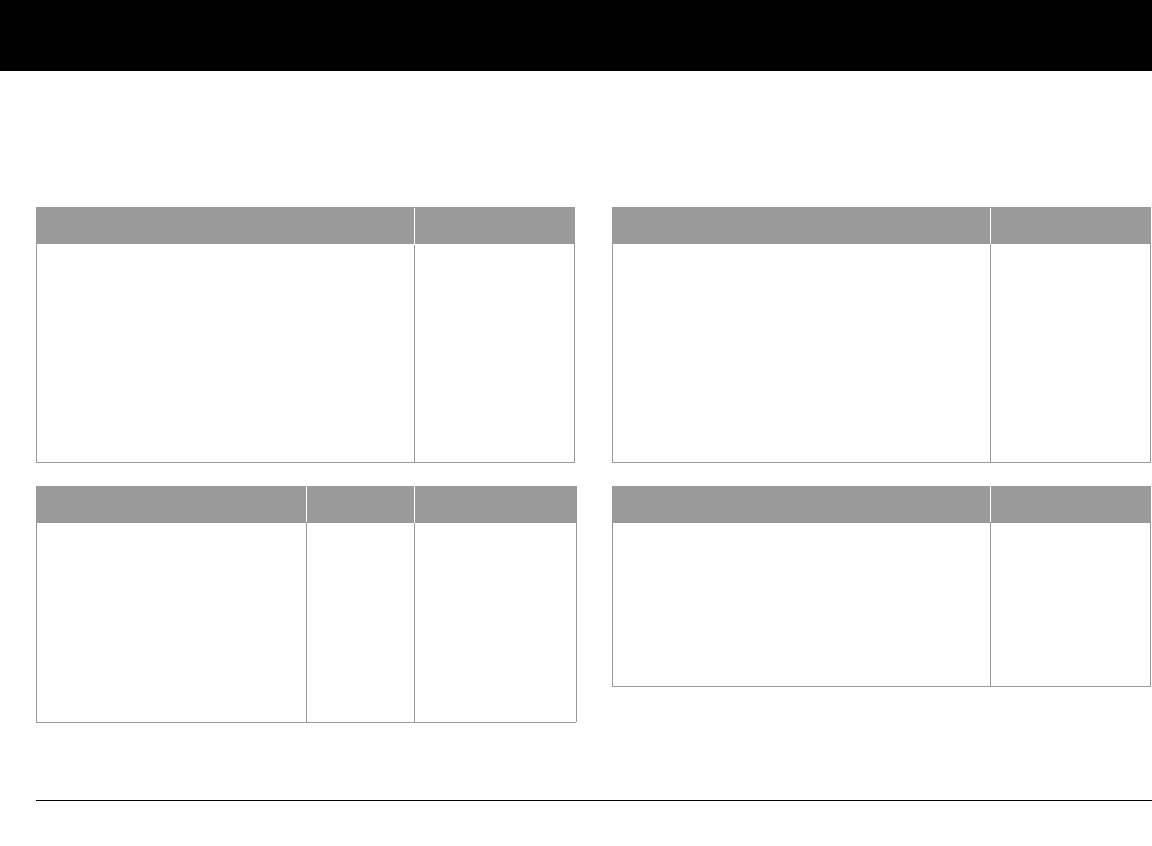
My PDM Settings
Basal Program 1
Name _________________________________
12:00 AM to ________
________ to ________
________ to ________
________ to ________
________ to ________
________ to ________
________ to ________
Rate
___________ U/hr
___________ U/hr
___________ U/hr
___________ U/hr
___________ U/hr
___________ U/hr
___________ U/hr
Target BG
Target BG (“correct to” values) for
each time segment defined, starting
at midnight. These values are used
by the suggested bolus calculator.
12:00 AM to ________
________ to ________
________ to ________
________ to ________
Target BG
_________
_________
_________
_________
Suggest correction
when BG is above
___________ mg/dL
___________ mg/dL
___________ mg/dL
___________ mg/dL
Basal Program 2
Name _________________________________
12:00 AM to ________
________ to ________
________ to ________
________ to ________
________ to ________
________ to ________
________ to ________
Rate
___________ U/hr
___________ U/hr
___________ U/hr
___________ U/hr
___________ U/hr
___________ U/hr
___________ U/hr
Insulin-to-Carbohydrate Ratio
Insulin-to-carbohydrate ratio for each time
segment defined, starting at midnight.
12:00 AM to ________
________ to ________
________ to ________
________ to ________
1 unit of insulin
covers
__________ g carb
__________ g carb
__________ g carb
__________ g carb
Use this form to keep track of your important PDM settings. Remember to update your information as you change or add settings.
This form, along with other resources, is available on the Insulet Corporation Web site, MyOmniPod.com/support/resources.
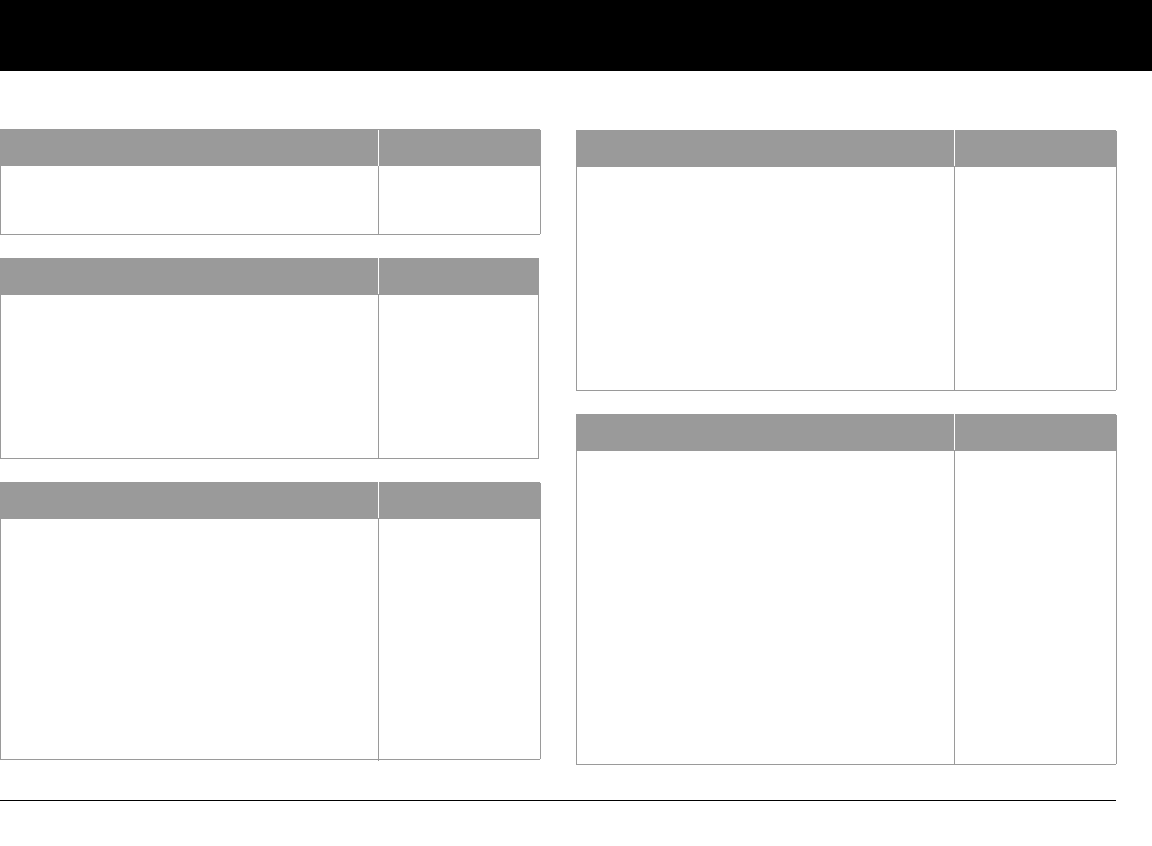
My PDM Settings
Duration of Insulin Action
Time that insulin will remain “active” in the body
from a previous correction bolus. ___________ hrs
Correction Factor
Correction factor for each time segment defined,
starting at midnight.
12:00 AM to ________
________ to ________
________ to ________
________ to ________
1 unit of insulin
decreases BG by
__________ mg/dL
__________ mg/dL
__________ mg/dL
__________ mg/dL
Temp Basal Presets
Name
________________________________________
________________________________________
________________________________________
________________________________________
________________________________________
________________________________________
________________________________________
Rate (circle
measurement)
________ U/hr or %
________ U/hr or %
________ U/hr or %
________ U/hr or %
________ U/hr or %
________ U/hr or %
________ U/hr or %
Bolus Presets
Name
________________________________________
________________________________________
________________________________________
________________________________________
________________________________________
________________________________________
________________________________________
Units
_____________ U
_____________ U
_____________ U
_____________ U
_____________ U
_____________ U
_____________ U
Carb Presets
Name
________________________________________
________________________________________
________________________________________
________________________________________
________________________________________
________________________________________
________________________________________
________________________________________
________________________________________
________________________________________
Grams of
carbohydrate
__________ g carb
__________ g carb
__________ g carb
__________ g carb
__________ g carb
__________ g carb
__________ g carb
__________ g carb
__________ g carb
__________ g carb